
The Cost of Travel in Australia: My 2024 Budget Breakdown
Australia? Let’s just say that it’s not exactly an inexpensive country to visit.
In fact, out of the 100-odd countries that I’ve had the pleasure of travelling to, it actually ranks as one of my least affordable.
Let’s face it: it’s expensive to get to, expensive to travel around, and expensive to live here.
You can trust me on this: after spending a full decade visiting this Land Down Under on an annual basis, I made the big decision to apply for Australian permanent residency. Yes, in 2021, I settled down in beautiful Melbourne with my partner and set about building a life for myself.
So not only do I now call this country home, but I’ve also spent a significant amount of time exploring its other-worldly landscapes.
There was the lengthy road trip I ventured on down the east coast from Brisbane to Melbourne, the two weeks I spent hiking in Tasmania, the week I dedicated to swimming alongside the Great Barrier Reef, and even the five times I’ve cruised alongside the Great Ocean Road (what can I say? I love it!). I’ve fed kangaroos out of the palm of my hand, stroked a koala, swam with sharks, and taken selfies with quokkas.
Needless to say, I’ve seen a hell of a lot of this country over the years, perhaps even more so now that I’m based here.
Most importantly, I’ve travelled Australia on every budget you can conceive of: from a grungy backpacker living off of Vegemite sandwiches to a solo traveller in her thirties on a mid-range budget. I’ve jumped on a month-long family road trip to show my parents around my new home, spent weeks in a resort with my young nephews on a summer adventure, and hit up a remote island paradise as part of a couple on a romantic high-end vacation.
In other words, I’m perfectly placed to share exactly how much you can expect to spend on a trip to Australia.
Whether you’ll be living the Working Holiday dream and driving a beaten-up campervan along the East Coast, taking that once-in-a-lifetime trip to Oz post-retirement, or simply desperate to make the most of your two-week vacation to Australia, I have you covered.
But in short, yes, this country is expensive.
And it’s particularly expensive in 2024 — although, isn’t everywhere?
Unfortunately, Australia hasn’t been spared from the cost-of-living crisis that is currently rampaging around the globe and prices have been skyrocketing in response. If you’re from Western Europe or North America (as most of my readers are), you can expect travel in Australia to cost around 10-30% more than it does in your homeland.
But that doesn’t mean that Australia offers bad value for money.
In fact, I think that Australia offers fantastic value for money! Yes, you need to spend a lot of money to visit this country, but you’ll be receiving so much in exchange. for it You’ll be visiting some of the most iconic destinations in the world, making your way from world-class beaches to red-sand deserts, diving the Great Barrier Reef and watching the sunset over Uluru. These experiences are expensive for a reason: you can’t do them anywhere else in the world!
Today, I’m going to be sharing exactly how much you can expect to spend on a trip to Australia. Let’s start by looking at how you can save money on accommodation.
The Cost of Accommodation in Australia
You can visit Australia on any budget, from a $40 a night hostel in Cairns that’s highly-rated on Booking to the spectacular $500-a-night Four Seasons Sydney , which offers up the best views of the Sydney Opera House in the city.
And so, visiting Australia, doesn’t have to mean spending your life savings on hotel. I’ll start this section by focusing on the budget accommodation options in the country, then move on to the mid-range hotels, and finish with the higher-end properties.
I first want to mention that if you’ll be travelling on the tightest of budgets, there are several options that’ll land you with free accommodation while you’re in the country. Courchsurfing helps you to connect with locals by sleeping on spare sofas in their homes. No, it isn’t particularly comfortable! It doesn’t cost a cent to do so, however, and provides a fantastic way to gain an insight into Australian daily life away from the tourists. There are over 300,000 hosts in Australia, so you shouldn’t find it too difficult to connect with somebody likeminded.
Housesitting is a more upmarket way to avoid paying for accommodation, as it’s aimed at mid-range and luxury travellers. You’ll be looking after homes (and usually pets) while their owners are on holiday, and the houses can be extremely luxurious (I’ve had friends housesit a castle before!). This option works best if you don’t have fixed travel plans, as you’ll be agreeing to dates that the owners set. It’s always worth taking a look at the current listings for Australia , though, just in case somebody’s vacation dates happen to coincide with yours; there’s usually several hundred housesits to browse through in Australia at any one time.
Finally, when it comes to free accommodation, you could also take a look at WorldPackers in Australia , where you’ll be able to volunteer for locals in exchange for food and board. There are some seriously cool options available on the site right now, from helping out at a local surf school to lending a hand at building an eco-sanctuary in the rainforest. Readers of this site get a $10 discount for WorldPackers with the promo code neverendingfootsteps .
If none of that appeals, then you’ll be getting down with hostel living.
A Guide to Hostel Costs in Australia
One of the most affordable ways to explore Australia is by staying in a hostel.
During my first visits to Australia, I was in my early twenties and living the backpacker dream; attempting to save as much money as possible. I was impressed by the quality of the hostels in Australia, as well as how many there were to choose from. This country is practically a mandatory stop on backpackers’ round-the-world trips, so there’s cheap accommodation aplenty in every tourist destination.
Here’s some of my favourite spots in the country:
- My favourite hostel in Sydney is easily the epic Sydney Harbour YHA — just wait until you see the views of the Sydney Opera House from the rooftop terrace! It’s in a perfect location for exploring the city, the staff are amazing, and breakfast is included. You’ll pay $70 per night for a dorm bed, or $200 a night for a private room with en-suite.
- In Melbourne , you can’t get better than the Space Hotel — I recommend my friends here whenever they come to visit! Here, dorm rooms are priced at just $65 a night and private rooms are $160 per night . In a town where most hostels are rated poorly, this well-reviewed spot is a no-brainer.
- You’ll likely be heading to Brisbane while you’re in Australia, and if so, I recommend Breeze Lodge , which has dorm rooms for $55 night . The staff here are wonderful and really helped me make the most of my time in town. The rooms were spotless, the vibes immaculate, and the beds comfortable. You can’t ask for more than that!
- The Gold Coast is home to the Surf Inn , which is one of my favourite spots in the country. Here, dorms are priced at $65 a night . No wonder it’s the best-rated budget accommodation in town. What I loved most about this place is its lovely swimming pool, the fantastic free breakfast, and its close proximity to the beach. Truly, this is one of the best value spots in all of Australia.
- I’m a massive fan of Perth . I chose to stay in Spinners Hostel during my most recent visit and came away so impressed with the rooms. Not only is it inexpensive at $50 a night for a dorm, but the beds are comfortable, the rooms modern and spacious, and the location incredible (I love the Northbridge neighbourhood so much!)
Overall, then, you can see that you can expect to spend around $60 a night for dorms in Australia, and around $160 a night for a private double room in a hostel. See what I mean about Australia being a little bit pricey?
Well, now it’s time to move on to the cost of hotels in Australia. Because what if you’re not a budget traveller and just want to stay in a lovely, well-reviewed hotel or guesthouse that’s good value for money and has all the things you need from a place to lay your head? I’ve got you!
My 2024 Recommendations for Hotels in Australia
It’s time to start looking at hotels.
In this section of my budget breakdowns, I always like to share my personal recommendations for accommodation within a country. That way, you get to browse through my favourite properties in order to make your trip planning easier, while also gaining an insight into how much you can expect to spend. And trust me: I spend hours researching each and every hotel that I stay in; I know which places offer the best value in Australia.
My biggest tip? When you head to Booking.com to find a hotel, ignore the default results that are shown whenever you search for properties in a destination. That initial list is simply a rundown of all of the hotels that pay Booking the highest commission[!], some of which have some pretty poor write-ups. Instead, click the “sort by” dropdown menu above the search results and choose to sort the properties by “Top Reviewed”. That way, you’ll be able to see which hotels are actually the best option for you.
All that to say, as I’ve been roaming around Australia, I’ve been making a note of the best accommodation in every city, putting in the hard work so you don’t have to. Here’s where I recommend staying (these are predominantly mid-range budget options, in excellent locations with the best reviews). Again, all prices are in AUD:
Sydney: Medusa Hotel ( $230 per night ) — Located in one of my favourite Sydney neighbourhoods — the eclectic Darlinghurst — Medusa hotel is close to so many of the best restaurants and cafes in the city’s inner east. You’re a 30 minutes walk from the CBD (and many of the tourist attractions) so you’ll pay a little less for accommodation than you would if you were right in the heart of the city; an added bonus. On top of that, the property itself is super-quiet and peaceful, tastefully decorated, and with a lovely courtyard. I stay here every time I visit Sydney.
Melbourne: ZaGame’s House ( $260 a night ) — Fun fact! When the pandemic struck, I was in Melbourne as the city went into lockdown. Without a home, I spent nine months living out of hotels and Airbnb apartments, trying so many different Melburnian neighbourhoods on for size. In other words, I know this city, and I know the best places to stay. I love ZaGame’s House for its location — right in the heart of the incredible Carlton neighbourhood, where you’ll find the Queen Vic Market (my favourite food market in the world!) and still be within walking distance of the main attractions in town. You’ve got beautifully designed rooms, amazing staff, a well-equipped gym, and one of the most comfortable beds ever. This is one of my favourite places in Melbourne.
Brisbane: The Inchcolm by Ovolo ( $275 a night ) — Take a look at the photos of the Inchcolm and tell me you don’t want to immediately book a stay there! The decorations and artwork are gorgeous, and the rooms are clean, spacious, and so comfortable. For me, though, the main reason to stay at the Inchcolm is the phenomenal staff members! No matter whether you’re looking for travel advice or a cocktail recommendation in the bar, they’re only too happy to drop everything and help you out. Throw in free access to the Fitness First gym across the street and you’ve got yourself everything you need for your time in Brisbane!
Gold Coast: Meriton Suites Surfers Paradise ( $235 a night ) — To me, staying on the Gold Coast is synonymous with being in a high-rise hotel, gazing down on a stretch of pristine white sand that seems to go on forever. Well the Meriton Suites in Surfers Paradise offers exactly that and I couldn’t stop swooning over its views. You’re located just steps away from the beach, the rooms are clean and spacious, with fully-equipped kitchens, and you’ve got access to an indoor and outdoor pool, jacuzzi, sauna, gym… the list goes on. This place is an absolute gem!
Cairns: Travellers Oasis ( $130 a night ) — A cheaper option for Cairns, but when the accommodation is so great, staying here is a no-brainer. Travellers Oasis has the best outdoor area, with a jungle-esque garden area, access to a BBQ, and a refreshing swimming pool (100% needed in the sweltering humidity of Cairns!) Rooms are well-cleaned and comfortable, with air conditioning to help keep you cool. It offers up a relaxed vibe to travellers, thanks to the warm and welcoming owners. As an added bonus, it’s only a five-minute walk from all of the best restaurants in town.
Perth: Alex Hotel ( $230 a night ) — There’s no getting around it: Perth is one of the most expensive cities in Australia for tourists, but that doesn’t mean there aren’t bargains to be found. In particular, I’m a huge fan of Alex Hotel, in the city’s CBD. Not only is it only a 15-minute walk from my favourite restaurant in the city (Ramen Keisuke Tonkotsu King: if you’re a ramen fan, you have to go!), but the interior is beautifully decorated, the breakfasts are impressive, and the rooftop terrace offers up some great city views.
Hobart: The Lodge on Elizabeth Boutique Hotel ( $196 a night ) — The Lodge is a wonderful historic home (one of the oldest buildings in Hobart!) that’s located just a 10-minute walk into the centre of the city. What I loved about it was how homely it feels. It’s like coming back to a cosy home at the end of a long day of exploring — and there’s no better feeling than that! You can expect free parking, tons of travel advice from the owners, delicious breakfasts, and even free glasses of port in the communal lounge. Enjoy!
The Cost of Transportation in Australia
One thing to keep in mind is the sheer size of this country! It’s around the same size as the continental U.S., so if you wouldn’t expect to be able to see the entirety of the United States in two weeks, it’s unrealistic to hope to do the same in Australia.
With the vast majority of Australia’s attractions scattered along its coastline, driving distances can therefore be huge. My road trip from Brisbane to Melbourne involved driving well over 1,000 miles (1600 km), while Sydney and Perth are separated by a whopping 2,500 miles (4,000 km). To drive from Brisbane to Cairns, you’ll spend 19 hours behind the wheel and still be in Queensland.
Because of this, it’s often easier, definitely faster, and usually cheaper, to fly between Australian cities. Still, don’t expect flights to always be speedy: it takes a whopping five hours to fly from Sydney to Perth!
If you’re short on time, though, it’s well worth taking a look at the offerings from the local airlines, as flights within Australia can sometimes even cost less than taking a bus. As an example, I paid just A$40 for a Jetstar flight from Cairns to Melbourne, skipping the 31 hour[!] drive time. You’ll most likely be flying with Qantas, Jetstar, or Virgin Australia; Qantas has the nicest planes; Jetstar is usually cheapest. I recommend using the flight comparison tool, Skyscanner , to find the best deals.
One of my top tips for saving money in Australia is to check the prices of flights for smaller airports that are located on a city’s outskirts. For example, Avalon Airport is just 15 miles from Melbourne’s main airport of Tullamarine, but usually offers cheaper flights. It’s nearly always less expensive to fly into the Gold Coast instead of Brisbane; two cities that are less than 50 miles apart.
One final thing: last year, the budget airline Bonza launched in Australia, offering very cheap flights for a limited number of destinations in the country (they have neither SA or WA flights nor Sydney yet). The catch? The only way to see their prices of flights is to download the “Fly Bonza” app. Yeah, it’s kind of a pain in the ass. Still, if you’re looking for a bargain, it might be worth the added annoyance for you to take a quick look; their prices are often half what the major carriers are charging. (Melbourne to Alice Springs is $169 direct, for example, in comparison to Jetstar/Virgin’s $350 with a layover in Adelaide).
With all that being said, there’s nothing quite like overlanding across Australia, and this country is well set-up for a road-trip. I’ve road-tripped four times throughout the country, from the Great Ocean Road to the entire East Coast.
If you’re on a tight budget, the easiest way to see the country is to buy a campervan when you touch down in Australia — this is how backpackers have been exploring Australia for decades . Then, when you’ve finished your road trip, you simply sell your campervan to a brand new arrival in the country. It works out to be a lot cheaper than renting (as long as you don’t total the car!) as you’ll make most of your money back at the end of the trip. Some people even manage to sell their campervan for more than they paid for it, completely eliminating all transportation costs from their trip!
You can find campervans for sale on Gumtree and Facebook (try the groups Backpacker Campervans for Sale and Campervan Sales Australia ). In general, there’ll always be a cheap and cheerful option for 10,000 AUD (6,500 USD/EUR or £5,300) available. For something with lower mileage and a more comfortable set-up, you’ll be looking at around 25,000 AUD , although obviously the sky’s the limit! If you want a bougie, Instagrammable, #vanlife set-up, you’ll be looking at as much as 70,000 AUD for your camper.
If buying isn’t for you, then renting is still a great option, whether it’s a campervan to road trip around the country, or settling on an economy car to save money. Personally, I’ve always nearly always rented a car while road-tripping Australia, so that I could stay in hotels along the way.
Regardless of which method best suits you, car rental prices can range from $50 a day for an economy car, all the way up to $150 — I always book through RentalCars.com when hiring a car. For campervans, it’s best to go with Jucy or Travellers Autobarn — both companies have a range of vehicles, including brand new ones, that are competitively priced. You’ll expect to pay between $120 and $230 a day , depending on how high-end the vehicle is.
Public buses are a great way to get around the country — in my option, the best way if you’re on a tight budget — and they’re seriously cheap if you’re going to be traversing the entire country. Greyhound is your best bet here, as they cover most of Australia and at very reasonable rates. If you book far enough in advance, you can sometimes grab a ride for just $1 !
Take a look at Greyhound’s Whimit passes, too, if you plan on travelling predominantly by bus. These are easily the cheapest way to travel across Australia. The Whimit passes give you unlimited travel across Australia; you can undertake any bus route of any length at any time over any travel period. Prices are as follows:
$665 for 90 days of travel works out to just $7.39 per day , which is so much cheaper than renting your own car and paying for petrol!
I’ll briefly mention interstate trains here, as there are a few of them in Australia, but they make for a pretty expensive option. It’s usually way cheaper to take the bus or fly between stops than to take the train. For example, the famous Ghan train, which runs between Adelaide and Darwin, takes you across the heart of Australia over three days, living in luxury and gazing out at that iconic Outback scenery. This isn’t a trip for the budget travellers, however: a three-day trip on the Ghan comes in at a whopping $3000 . Per person . Yikes!
I do want to give a specific shout-out to the cost of trains within the state of Victoria, however! They’re incredibly affordable here. In fact, you’ll never pay more than $9.20 for any train ride, even if its a multi-hour journey, taking you from one side of the state to the other! It makes day-tripping cheap and feasible for those of you who don’t want to drive.
Within the cities themselves, you’ll find that public transport is reasonably priced. Unsurprisingly, Sydney and Melbourne have the best public transport accessibility in Australia, followed by Perth and Brisbane.
Buses, trains, and ferries operate in the vast majority of Australian cities, and you’ve also got trams in Melbourne and light railways in Sydney, Adelaide, Canberra, and the Gold Coast. There’s even a metro system in Sydney and Adelaide! We do also have Uber here in Australia, which makes getting around a breeze. I generally pay around $50 for a 30 minute drive.
Needless to say, there’s lots of ways to get around if you won’t have a car. To give some examples of prices:
In Sydney, you’ll pay (depending on time of day and distance travelled) $4-6 for a bus, $2-11 for a train, $7-10 for a ferry, or $4-5 for a light-rail journey.
In Melbourne, public transport fares start at $3.30 , and there’s a $10 cap on daily public transport fares, so you’ll never pay more than that per day, no matter how many trains, trams, or buses you take. There’s also a free tram zone in the heart of the city, where you won’t pay anything at all!
In Brisbane and the Gold Coast, transportation fares range between $3 and $22 , based on distance, although you’re unlikely to pay as much as $22 , as that’s the cost of travelling 170 km to Gympie (something a tourist is unlikely to do!).
The Cost of Food in Australia
When you ask me about the food in Australia, there’s one thing that comes to mind: brunch.
Australian breakfasts are the absolute best in the entire world, with Melbourne offering up the tastiest versions . From Vegemite on toast to avocado on toast (called smashed avo), Australia is all about bringing new breakfast dishes to the world. But the brunches are on a whole different level, with a multitude of elaborate ingredients and flavours. If I was only able to eat out for one mealtime in Australia? It would definitely be for breakfast.
Like absolutely everything in Australia, food is relatively expensive — particularly eating out in restaurants. I can easily spend $20-30 on every single meal, so if you’re hitting up cafes and restaurants for all three meals, you can easily find yourself spending $100 a day just on food. The food is fantastic, though, so if you have the cash, it’s absolutely worth digging into Australia’s food scene.
“Throw a shrimp on the barbie!” This iconic line is what most visitors to Australia think of when it comes to food, but fun fact: I’ve never once seen — let alone eaten! — a shrimp on the barbecue! Still, BBQing is a huge deal in Australia, and it’s a great way to keep your costs down. Once of my favourite things about Australia is that many of the parks are home to free public barbecues! It makes for such a cheap meal: hit up the local supermarket for some meat, then head to the park to cook for yourself. You’ll nab yourself a meal for less than $10 and have a cultural experience while you’re at it!
Kangaroo? Absolutely! You can buy kangaroo meat from supermarkets (I like kangaroo sausages) and order kangaroo from many restaurants. It’s not a particularly exciting meat to eat, as it just tastes like a cross between beef and venison, but hey, if you eat meat and want to try something new, it’s definitely worth a sample. While you’re trying new meats, I recommend hitting up a fish and chip shop while you’re travelling Australia’s coastline: while you’re there, make sure to order flake: it’s shark!
While eating out in Australia can be expensive, it’s not too pricey to buy from supermarkets. If you’re backpacking or looking to save money, then, aim to have your breakfasts and lunches from the supermarkets: you’ll pay $1 for a 500g of pasta and $2 for some pasta sauce, for example, or $1 for a loaf of bread and $1 for some butter. Not very exciting or nutritious, no, but if you’re prioritising seeing as much as possible, you can see how it’s easy to keep costs low.
Australia is a drinking society, offering up booze from the infamous goon (boxed wine that’s $10 for 5 litres) to a high-end wine from the Adelaide wine region (easily $50). A beer in a restaurant can cost around $8, and a cocktail in a fancy bar can easily come in at $18. When it comes to alcoholic options, coffee comes in at $3-4, and even a can of soda works out to be $3!
The Cost of Activities and Entrance Fees in Australia
When it comes to travel in Australia, there are so many famous activities and attractions to add to your itinerary. The only downside of this, of course, is that — yet again! — they come at a price.
The greatest attraction in Australia is the magnificent Uluru: that gigantic red rock in the centre of the country. I highly recommend checking it out while you’re in Oz, but it’s important to keep in mind that its location can make for a lengthy and expensive trip. The first expense is getting there: if you have your own wheels, it’s well worth making the drive through the Outback, but if that sounds like an intimidating journey, you’ll be flying into Alice Springs instead. Flights are typically between $300 and $400 for a one-way ticket; $500 to $800 for a return ticket. On top of that, you’ve got the entrance fee ( $38 for three days), the cost of a tour (around $300 for day trip), and any special experiences ( $200 for a 25-minute helicopter ride ; $180 for a base walk, full day in the park, and sunset BBQ ).
Speaking of expensive experiences, I absolutely loved the time I spent out on the Great Barrier Reef. It was incredible! But the main thing to know is that if you want to see healthy, live coral, you need to jump on a liveaboard, which means you need to spend at least one night out on the water. This additional time allows you to travel away from the day-trippers, who spend their days observing dead, bleached coral. It is pricey, but this was one of the best experiences I’ve had in Australia (and I went in with low expectations!). We went with Reef Encounter (the best company in Cairns) and paid $1,600 for two nights on board. It was truly, truly incredible and I can’t recommend it highly enough.
I also took a scenic flight over the Great Barrier Reef with GLS Aviation and paid $300 for two people to take a 40-minute flight. I wrote about this experience in-depth on my site — it was amazing! And so valuable to be able to see the reef from above. It really helped to put its size into perspective for me.
Don’t You Dare Forget About Travel Insurance!
Travel insurance : If you’ve read any other posts on Never Ending Footsteps, you’ll know that I’m a great believer in travelling with travel insurance. I’ve seen far too many Go Fund Me campaigns from destitute backpackers that are unexpectedly stranded in a foreign country after a scooter accident/being attacked/breaking a leg with no way of getting home or paying for their healthcare. In short, if you can’t afford travel insurance, you can’t afford to travel. These costs can quickly land you with a six-figure bill to pay at the end of it.
Travel insurance will cover you if your flight is cancelled and you need to book a new one, if your luggage gets lost and you need to replace your belongings, if you suddenly get struck down by appendicitis and have to be hospitalised, or discover a family member has died and you need to get home immediately. If you fall seriously ill, your insurance will cover the costs to fly you home to receive medical treatment.
I use SafetyWing as my travel insurance provider, and recommend them for trips to Australia. Firstly, they’re one of the few companies out there who will actually cover you if you contract COVID-19. On top of that, they provide worldwide coverage, don’t require you to have a return ticket, and even allow you to buy coverage after you’ve left home. If you’re on a long-term trip, you can pay monthly instead of up-front, and can cancel at any time. Finally, they’re way cheaper than the competition, and have a clear, easy-to-understand pricing structure, which is always appreciated.
With SafetyWing, you’ll pay $1.50 a day for travel insurance.
How Much Does it Cost to Travel in Australia?
With all of that being said, it’s time to tally up all of my travel expenses in Australia, in order to give you an idea of how much you can expect to spend while travelling in this wonderful country:
The cost of travel in Australia for backpackers
Accommodation: A$30 per day Transportation: A$20 per day Food: A$25 per day Activities: A$10 per day
Total cost of travel: $A85 per day (58 USD per day)
The cost of travel in Australia for couples on a mid-range budget
Accommodation: A$50 per day Transportation: A$30 per day Food: A$40 per day Activities: A$12 per day Total amount spent per day: A$132 per day
ARE YOU PLANNING A TRIP TO AUSTRALIA? HAVE ANY QUESTIONS? LET ME KNOW IN THE COMMENTS BELOW!
Related Articles on Australia 🇦🇺 30 Incredible Things to Do in Melbourne, Australia 🐠 Nerves and Nausea Over the Great Barrier Reef 🥑 Fitzroy is Home to the Best Brunches Ever 🦘 Tasmania Is Incredible And You Should Go There Now
Lauren Juliff
Lauren Juliff is a published author and travel expert who founded Never Ending Footsteps in 2011. She has spent over 12 years travelling the world, sharing in-depth advice from more than 100 countries across six continents. Lauren's travel advice has been featured in publications like the BBC, Wall Street Journal, USA Today, and Cosmopolitan, and her work is read by 200,000 readers each month. Her travel memoir can be found in bookstores across the planet.
Related Posts
The Cost of Travel in Mauritius: My Detailed Budget Breakdown
The Cost of Travel in Thailand: My Detailed Budget Breakdown
30 Incredible Things to Do in Melbourne, Australia (By a Local!)
The 10 Best Brunches in Fitzroy in 2024 (By a Local!)
2023: My Travels in Review
The Cost of Travel in South Korea: My 2024 Budget Breakdown
24 comments.
I’m not much of a hiker either but I do get that sudden burst of pride that I can take it all in my stride like there’s no stitch, no shortness of breath & definitely no sweat pouring into my eyes. The feeling of making it to the top is incredible, the feeling of sitting down & filling your mouth with cold water – even better :)
Agreed! I think I may now be a hiking convert — the feeling of pride afterwards was amazing!
Hiking in flip flops?! Are you crazy! Haha! I’m going to hike up Adams peak in Sri Lanka tomorrow night, soon I will have cobra calves like you!
Hahaha! I’d lived in flip flops for the past year so assumed I’d be fine. I probably should have bought some hiking boots….
Good luck with the hike! Cobra calves are sexy :)
good choice seeing the blue mountains. it really is underrated imo.
you heard the story about the first convicts in Australia? not knowing where they were, they thought China was on the other side of the blue mountains…
Thanks! And nope, I hadn’t heard that before — too funny!
I was horrified too when I realised just how big Australia is, but after a while it became second nature to spend a whole day travelling from one place to the next. The Blue Mountains is one of the places in Australia I really wish I had visited, it looks so, so beautiful.
Aren’t the distances crazy. If I drove for the amount of time I did in Australia I’d end up in the ocean!
The Blue Mountains was probably the highlight of my entire time in Australia so hopefully you’ll make it there one day! :)
Wow it looks amazing! Impressive doing it in flipflops as well. Although I would recommend buying something slightly more comfortable to wear for all the New Zealand hiking I’m sure you will be doing. I did the famous Tongariro Crossing in Converse. Something I do not recommend…took me three days for my feet to recover after that…
Yep, I bought a pair of excellent hiking shoes a few days after my time in Blue Mountains and love them!
I can’t imagine doing the Tongariro in Converses would have been particularly easy! :)
Wow stunning photos for such a stunning place! I’m ashamed to admit I’ve never heard of this place at all! However, I’m glad I saw your tweet, because now I can add this to my list of a biz-zillion things I want to do before I die.
It’s ok, Bryan… I didn’t know its name before I arrived :-) Glad you’ve added it to your list, it definitely deserves a place there!
Knew there was a reason the Blue Mountains were on my Aussie bucket list :D I’m not a hiker and already know I’m going to bitch and moan all the way up but looking at your photos, it’s definitely going to be worth it and I can’t wait :D
Yay! I’m so glad you’re going to be heading here — it’s been my favourite place in Australia! :-) And, really, if I made it in flip flops then you *definitely* can handle it!
I literally just got to Sydney this morning and was planning a trip to the Blue Mountains when I realized I hadn’t checked your blog in a while. Thankfully I did! Great tips and photos as always! My travel companions are also super excited since they share your enthusiasm for hour long sunset photo shoots haha
Awesome, I’m so glad it could help! You’ll love it there, it’s SO beautiful!
Those are such gorgeous photos! It really is such a dramatic landscape. I did the same hike as you last year and loved it! I took that tram back up, the steepest one in the world I think it is. So sure I was going to slip out! Really great blog :)
Thanks, Veronica!
I didn’t get a chance to take the tram but it looked pretty daunting… I would have probably spent the entire journey hyperventilating!
Haha, I’m enjoying reading about your progress towards becoming “A Hiker.” Looks like a gorgeous hike for sure!
Though, I hate to tell you this… but I feel like Dave might be onto your nose-breathing secret after reading this post… ;)
Wait until you hear about the stuff I get up to in New Zealand! I go a bit crazy and almost break myself :)
*Cue Mouth Drop* These photos are stunning! This is intense. Everytime I come on here now it’s featuring some sort of awesome bike trip (or a gnarly fall) or an amazing hike. I love it!
Awww, thanks Ryan, glad you like the photos!
Haha, I’ve done a few hikes in flip flops too! Sometimes not the best choice, but I just love them so much it makes it hard to put on real shoes :) Good choice on picking the Blue Mountains! They look stunning!
I know! After about a year in Southeast Asia, I threw out all of my other shoes and lived in flip flops… I love them so much!
Cost of a Trip to Australia & the Cheapest Time to Visit Australia
The average price of a 7-day trip to Australia is $1,955 for a solo traveler, $3,357 for a couple, and $1,725 for a family of 4 . Australia hotels range from $55 to $238 per night with an average of $92, while most vacation rentals will cost $180 to $510 per night for the entire home. Average worldwide flight costs to Australia (from all airports) are between $1,112 and $2,134 per person for economy flights and $3,492 to $6,701 for first class. Depending on activities, we recommend budgeting $42 to $86 per person per day for transportation and enjoying local restaurants.
See below for average , budget , and luxury trip costs. You can also look up flight costs from your airport for more tailored flight pricing.
The Cheapest Times to Visit Australia
On average, these will be the cheapest dates to fly to Australia and stay in a Australia hotel:
- January 29th to March 25th
- April 9th to May 6th
- July 30th to December 2nd (except the week of October 8th)
The absolute cheapest time to take a vacation in Australia is usually late August to early September .
Average Australia Trip Costs
Average solo traveler.
The average cost for one person to visit Australia for a week is $1,329-$3,211 ($190-$459 per day)
Food, Travel, and Sightseeing : $42 to $86 per day for one person’s daily expenses
Flights : $621 to $1,817 for economy
Lodging : $69 to $87 per night for one 2 or 3-star hotel room
or $108 to $132 per night for a 1-bed vacation rental
Average Couple’s Trip
The average cost for a couple to visit Australia for a week is $2,244-$5,629 ($321-$804 per day)
Food, Travel, and Sightseeing : $84 to $172 per day for two people’s daily expenses
Flights : $1,242 to $3,633 for economy
Average Family Vacation
The average cost for 4 people to visit Australia for a week is $4,483-$10,863 ($640-$1,552 per day)
Food, Travel, and Sightseeing : $168 to $345 per day for four people’s daily expenses
Flights : $2,485 to $7,266 for economy
Lodging : $137 to $175 per night for two 2 or 3-star hotel rooms
or $162 to $197 per night for a 2-bed vacation rental
Traveling Cheap to Australia
How cheap can you make a vacation to Australia? The cheapest trip to Australia is about $150 per person per day for travelers willing to take standby flights, deal with inconvenience, and otherwise limit travel expenses. About 1% of rentals are available in the $0 to $100 range for an entire place, and vacation rentals can be booked for as low as $20 per night. These inexpensive rentals must be booked as early as possible and may not be in the most desirable areas. 1-star hotels are more likely to be available, with rooms starting at around $47.
Even cheaper trips are possible depending on where you live and whether you can drive. Check the cheapest times to fly for more saving ideas.
Budget Solo Traveler
The lowest cost for one person to visit Australia for a week is $1,050-$2,975 ($150-$425 per day)
Food, Travel, and Sightseeing : $21 to $42 per day for one person’s daily expenses
Lodging : $47 to $55 per night for one 1-star hotel room
or $114 to $144 per night for a 1-bed vacation rental
Budget Couple’s Trip
The lowest cost for a couple to visit Australia for a week is $1,818-$5,085 ($260-$726 per day)
Food, Travel, and Sightseeing : $42 to $84 per day for two people’s daily expenses
Budget Family Vacation
The lowest cost for 4 people to visit Australia for a week is $3,631-$9,738 ($519-$1,391 per day)
Food, Travel, and Sightseeing : $84 to $168 per day for four people’s daily expenses
Lodging : $93 to $110 per night for two 1-star hotel rooms
or $171 to $216 per night for a 2-bed vacation rental
Overall it is very possible to travel to Australia cheaply.
The Cost of a Luxury Australia Trip
There is no true ceiling on the cost of a luxury trip, so our estimates are based on what most people do in Australia.
Luxury Solo Traveler
The high-end price for one person to visit Australia for a week is $2,837-$11,702 ($405-$1,672 per day)
Food, Travel, and Sightseeing : $84 to $173 per day for one person’s daily expenses
Flights : $1,553 to $4,539 for first class
Lodging : $116 to $238 per night for one 4 or 5-star hotel room
or $496 to $992 per night for a preferred vacation rental
Luxury Couple’s Trip
The high-end price for a couple to visit Australia for a week is $4,978-$17,452 ($711-$2,493 per day)
Food, Travel, and Sightseeing : $168 to $346 per day for two people’s daily expenses
Flights : $3,106 to $9,078 for first class
Luxury Family Vacation
The high-end price for 4 people to visit Australia for a week is $9,963-$31,927 ($1,423-$4,561 per day)
Food, Travel, and Sightseeing : $336 to $692 per day for four people’s daily expenses
Flights : $6,213 to $18,155 for first class
Lodging : $233 to $476 per night for two 4 or 5-star hotel rooms
or $744 to $1,488 per night for a preferred vacation rental
Australia Hotel Prices
The cost of staying in Australia is slightly lower than the average city. On average hotels are less expensive than vacation rentals. Luxury vacation rentals are more expensive in Australia due to very high property costs. The graphs below show how much cost can vary depending on the type of experience you’re looking for.
Australia Lodging Cost by Star Status
The average price for the class of hotel is on the (y) axis. The hotel class (out of 5 stars) is on the (x) axis.
Prices are based on Australia hotel averages and may not reflect current prices. In some cases, we extrapolate prices to estimate costs, and hotels with your desired star rating may not be available.
Vacation Rental Prices
The percent of vacation rentals in the price range is on the left (y) axis. Price range is on the bottom (x) axis.
There are a healthy amount of vacation rentals serving all budgets in Australia.
Flight Costs to Australia
Averaging flights around the world, prices go from a high of $2,134 average in late December to a low of $1,112 in late August to early September. Median flight price is $1,403. These prices are based on millions of flights. For Australia our data includes thousands of originating airports, and hundreds of airlines. The area has more variance in price compared with other locations.
Average Flight Cost by Season
Average flight cost by day of week.
The cheapest day to fly in is typically Tuesday, and the cheapest day to fly back is usually Tuesday. Click here to see data for the cost of flights from your airport. In Australia, the difference between the cheapest and the most expensive week is about $1,022, so you can easily save about 92% simply by using our free flight guides and booking in advance.
Daily Expenses Budget
Daily vacation expenses vary more based on what you’re interested in doing. A fine dining restaurant with drinks around Australia can easily cost $315 per person or more, while a standard nice meal might be about $21 per person. Private tours can cost $630 per day, but self-guided tours to see the outdoor sights can be free. Costs vary wildly, so recommendations are made based on the cost of living and averages we see for this type of vacation.
Other Australia Guides
Travel costs nearby.
- New South Wales Outback, NW, AU
- Murray-Darling Basin, Australia
- Mungo, NW, AU
- Broken Hill, NW, AU
- Buronga, NW, AU
- Wentworth, NW, AU
- Euston, NW, AU
- Gol Gol, NW, AU
Travel Costs in Popular Places
- Moscow, Russia
- Kuta, Indonesia
- Houston, TX, US
- Meet the Team
- Our Manifesto
- Work with Us
- Budget Travel
- Personal Development
- Work & Travel
- United Kingdom
- More of Europe
- Philippines
- More of Southeast Asia
- More of South America
- More of Central America
- South Korea
- More of Asia
- More of North America
- New Zealand
- Pacific Islands
- More of Oceania
- South Africa
- More of Africa
- More of the Middle East
- Travel Essentials
- Travel Gear
Home » Oceania » Australia » Is Australia Expensive? (Insider’s Guide for 2024)
Is Australia Expensive? (Insider’s Guide for 2024)
Australia is a destination that everyone should make sure to visit in their lifetime. It’s where many backpackers decide to explore for a year, and then end up staying forever. There’s a reason for this; the country has it all .
With miles and miles of gorgeous beaches, an expansive outback, untamed national parks and wetlands, sprawling metropolis cities, good food, warm locals and amazing wildlife – what more could you want from a holiday destination?
But while we all know that Australia is a popular place to visit, the question remains: Is Australia expensive? The funny thing is, the answer often varies depending on who you ask.
The cost of a trip to Australia largely depends on your level of luxury and how much you want to do. Diving for example, is an expensive activity, while the beaches are free.
If you’re thinking of visiting Australia and need help putting together your travel budget, then I’m here to help. This guide has everything you need to know for how much it will cost to travel to Australia, as well as provide some tips on how to save money…

Do You Want to Travel FOREVER??
Pop your email in below to get a FREE copy of ‘How to Travel the World on $10 a Day!’.
So, How Much Does a Trip to Australia Cost on Average?
Cost of flights to australia , price of accommodation in australia , cost of transport in australia , cost of food in australia , price of alcohol in australia , cost of attractions in australia , additional costs of travel in australia , some final tips for saving money in australia , so is australia expensive, in fact.
- Buy Us a Coffee!
The cost of a trip to Australia is going to vary from person to person. The first thing you need to do is to figure out how much you have to spend.
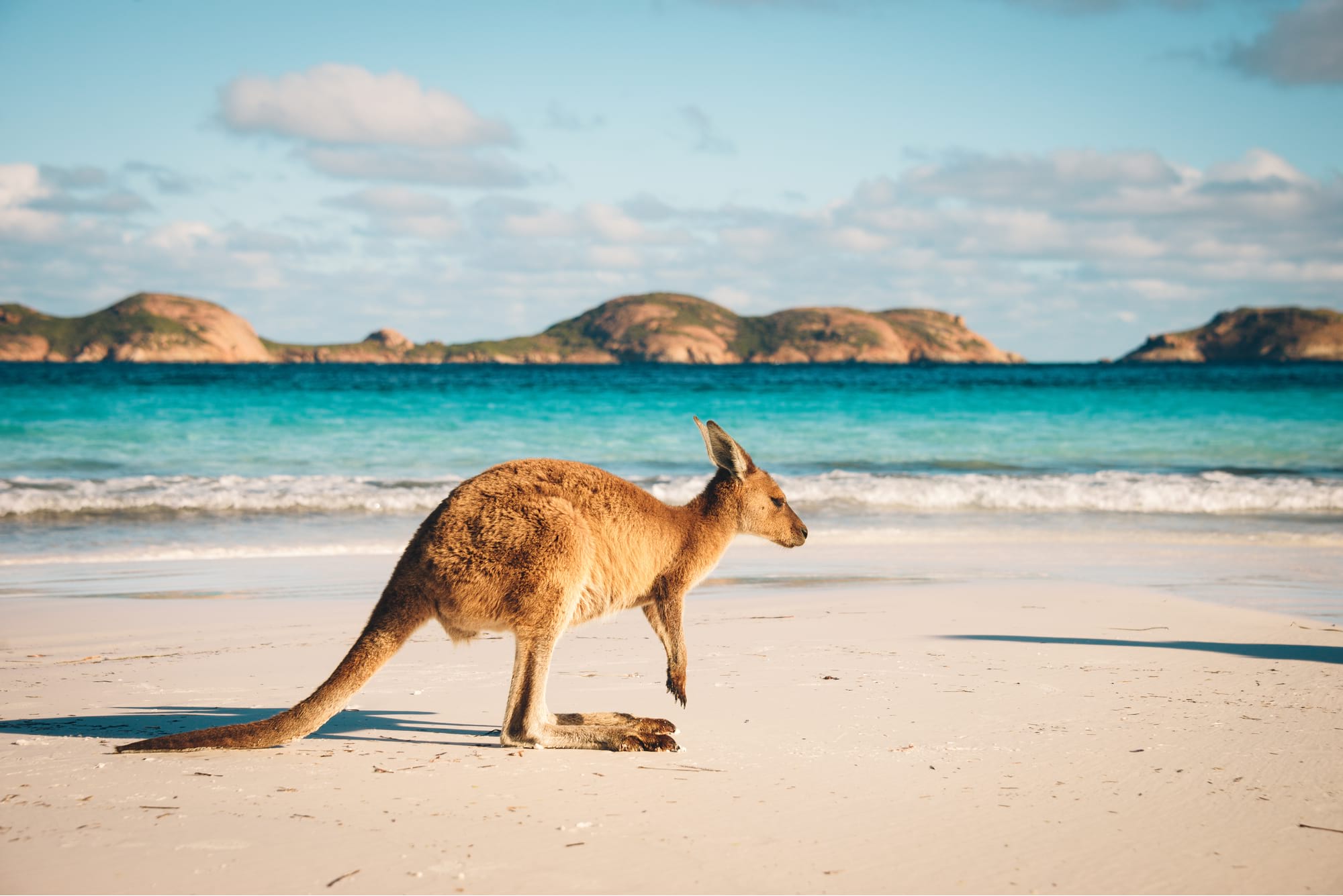
The Broke Backpacker is supported by you . Clicking through our links may earn us a small affiliate commission, and that's what allows us to keep producing free content 🙂 Learn more .
Getting a rough idea of your trip budget will help you work out what you can spend on essentials like accommodation and transport. You’ll also need to factor in the price of things such as food, activities and souvenirs, too.
All the travel costs listed in this guide are estimates and are subject to change. Prices are listed in US Dollars.
Australia uses the Australian Dollar (AUD). Find out how much your money is worth today by using the up-to-date converter below.
2 Weeks in Australia Travel Costs
To help you out with an outline of the prices, you’ll find a summary of the average costs of a two-week trip to Australia below.
ESTIMATED EXPENSE : $146 – $1,199 USD for a roundtrip ticket.
So is Australia expensive to fly to? Well, that really depends on where in the world you’re based. It’s true that airfares to Australia can be pricey, as the country is fairly far away from a lot of places. If you’re travelling from Europe or the U.S., you can expect to pay at least a few hundred dollars for your ticket.
But don’t let that put you off your trip. There are some ways you can get cheaper flights to Australia, it just takes a little time and being open-minded when it comes to times and dates. For example, tickets to Australia tend to be more expensive between the months of December to February when the nation is basking in warm summers.
Travelling to Australia in the shoulder seasons of autumn or spring can save you some serious cash when it comes to booking flights. Prices can creep up again in July and August when much of Europe takes its summer break.
If you’re heading to Aus, it’s likely that you’ll fly into Sydney Airport (SYD). The city’s main airport is located eight kilometres (around five miles) from the centre of town. It takes only around 30 minutes to drive into the city from the airport. The price of the transport from the airport should also be something you budget for, but more on that later.
Here are the average costs of a flight to Australia from a range of international air travel hubs:
- New York to Sydney Airport: $678 – $1,199 USD
- London to Sydney Airport: £685 – £986 GBP
- Dubai to Sydney Airport: 539 – 939 AED
- Vancouver to Sydney Airport: $601 – $1,119 CAD
Those of you flying from international travel hubs will see that the cost of flights isn’t particularly cheap. This is a long-haul flight, so you have to spend a lot for the privilege. Some good deals can be found, however, and you can make a trip to the land down under on a budget.
Make sure to put some time into searching on price comparison websites like Skyscanner. Be flexible with your dates and flight times and you’ll be shown a range of different flights at various costs. For the cheapest flight, you may have to break the trip up into different legs, but overall it can save you a good amount of money.
Want to save money on accommodation?

We got you. For reals.
ESTIMATED EXPENSE: $18 – $200 per night
After you’ve sorted the flights, the next cost to consider is the price of accommodation in Australia. This is going to take up another chunk of your travel budget , but don’t worry too much.
Australia is a big country with a huge choice when it comes to budget-friendly places to stay, from its easy-going hostels to budget hotels and affordable Airbnbs. You won’t have to spend a stack of cash on expensive hotels.
The price you pay for a hotel room or hostel bed will fluctuate depending on the time of year you visit. Accommodation costs can skyrocket during the school holidays in the peak season. For example, a beach break in the Australian summer could cost more for the same beach-side Airbnb or hotel than in the winter. Accommodation prices also peak on weekends.
Another factor to consider is where you stay in Australia . Accommodation in the centre of the city tends to be more expensive, so look for neighborhoods further out and travel in. Likewise when visiting beach towns. You can find cheaper accommodation the further away from the ocean you are.
Let’s take a closer look at the range of accommodation that Australia has to offer…
Hostels in Australia
Australia has long had a culture of backpacking. Well-known as global travellers, Australians themselves love to get out and explore, as well as all the thousands of global backpackers who visit here. All of that adds up to a thriving hostel scene, one which is well-trusted, affordable, and a whole lot of fun.
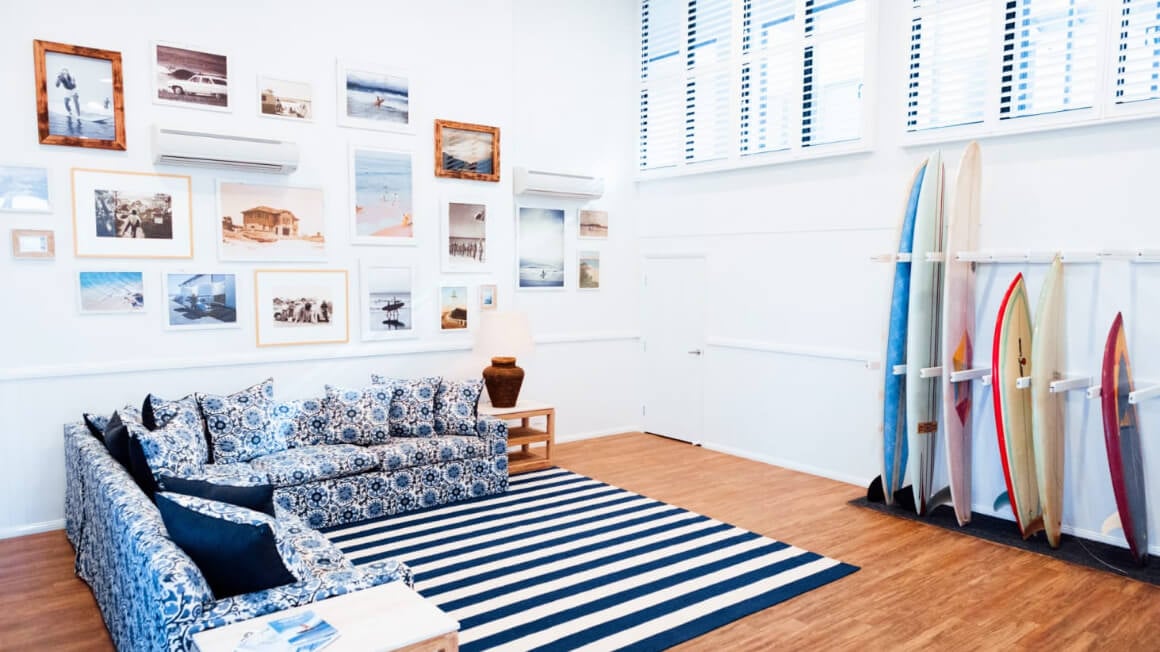
The cheapest hostels in Australia start at around $18 per night.
You won’t just find one type of hostel in Australia though. Head to a city and you can enjoy the shiny urban hostels complete with cafes and social lounges, while at the beach there are laid-back surfer vibes and BBQs, and then there are the happening party hostels.
Take a look at these top hostels the nation has to offer and get a better feel for the kind of affordable digs you could be staying in during your trip:
- Wake Up! Sydney Central – This award-winning Sydney hostel is conveniently located close to the city’s Central Station. A vibrant backpacker hub, it’s a great place to meet other travellers and get a good night’s sleep for a low price.
- The Mansion Melbourne – This chilled-out hostel inside a heritage building has recently had a facelift. Featuring new beds, a cafe, and a co-working space, it’s ideally located in Melbourne’s CBD.
- The Surf House – Get your surf on at this chilled-out hostel right near the Main Beach in Byron Town. There’s the option to book into a dorm or choose a private room complete with your very own balcony. Amenities at the hostel include a funky rooftop bar: the perfect spot for a few sundowners.
Airbnbs in Australia
Australia has tens of thousands of properties listed on Airbnb. From compact city condos all the way to palatial beach houses , all of these choices mean that the chances of you finding a reasonably priced place to stay are pretty high. Airbnb is a popular option for many as it means you can relax in a home away from home during a trip.
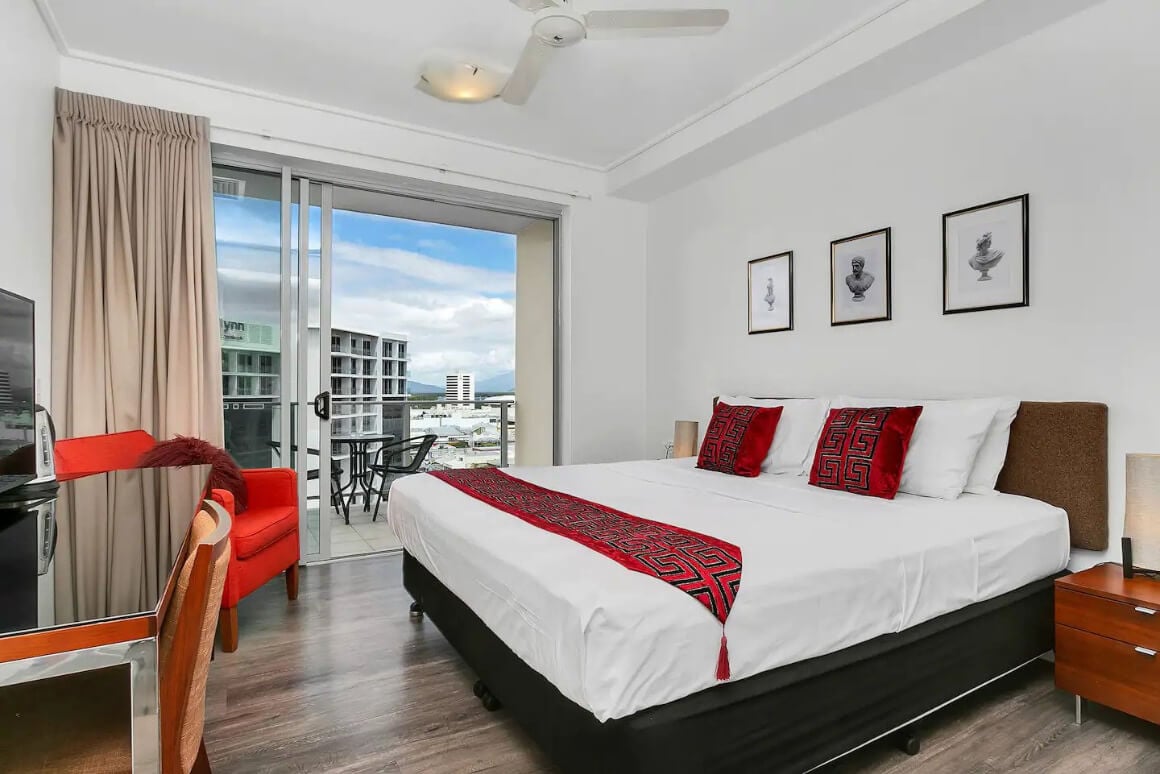
The price of an Airbnb in Australia does vary quite dramatically depending on the location. Sydney’s Airbnbs are usually a lot more expensive when compared to the country’s smaller cities. You should expect to pay upwards of $90 a night for an entire property. For a low-cost stay, a good option is to simply book just a room in a house on Airbnb.
But it’s not just about finding somewhere to grab a few hours of sleep. You want to stay somewhere that you can enjoy your trip, and that means cool apartments overlooking cityscapes, or tiny houses on the Gold Coast. Airbnbs offer the chance to see some amazing destinations and really helps to open up Australia to overseas visitors.
Opting for this style of self-catering accommodation can also help to ease the burden on your wallet. Whipping up a few meals and starting your day with a homemade breakfast will really take the edge off your travel budget (more on that later).
If you still think that Australia is expensive, take a quick peek at these affordable Airbnbs…
- Modern Design Suite Melbourne – This bright and modern apartment is located in Melbourne’s CBD. Boasting a queen-sized bed, pared-back interiors, and a fully equipped kitchen, it’s an ideal base for exploring what the city has to offer.
- Central Sydney Apartment – Offering up stunning views of Hyde Park and the cityscape, this affordable Sydney apartment is located close to all of the area’s cool cafes and green spaces in Darlinghurst and Surry Hills. It’s also within walking distance to iconic sights such as the Opera House and Sydney Harbor Bridge.
- Cairns City Apartment – Stay in style at this polished penthouse apartment in Cairns. Located on the 12th floor, you can soak up the amazing ocean views from a luxurious king-sized bed. There’s also a balcony and access to a pool, BBQ area, and gym.
Hotels in Australia
Hotels are usually the most expensive accommodation option and you can end up paying a whole lot of money for a simple room for the night. But Australia has a lot of different types of hotels to choose from, and you can find budget chain hotels and cool local hotels for low prices.
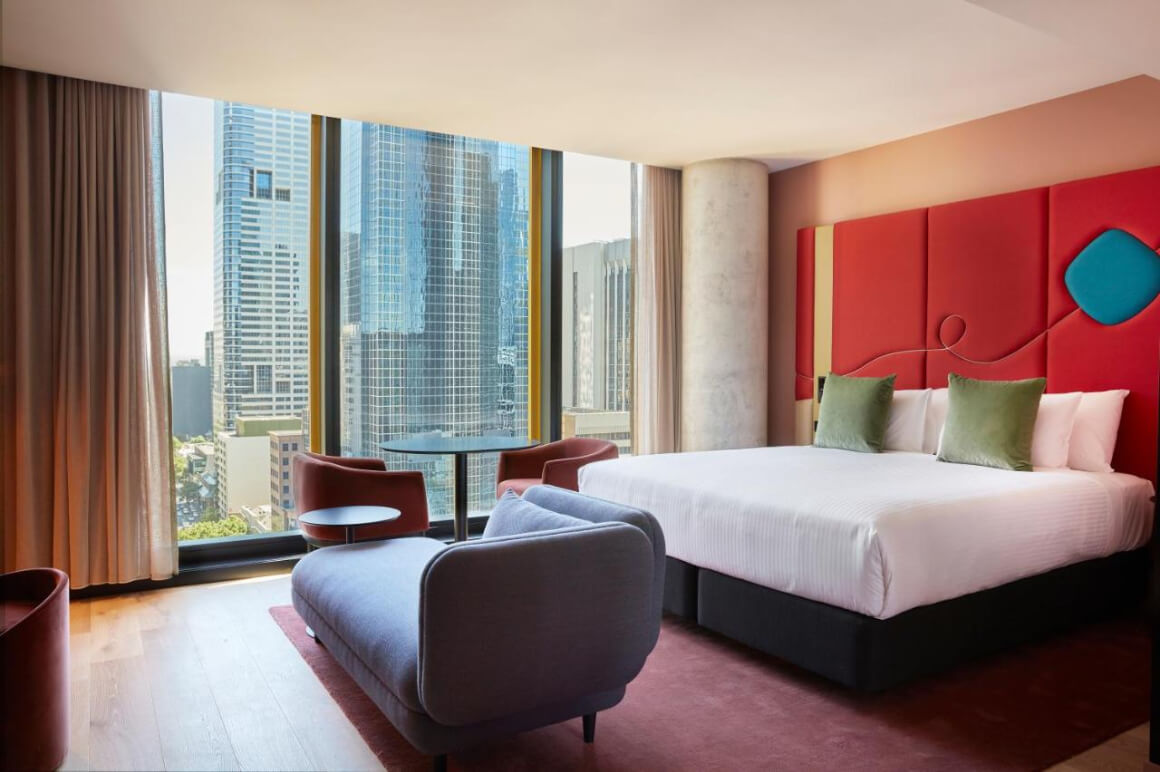
Most cities have budget-friendly hotels which cost around $70 a night. The room rates usually reflect the part of the city the hotel is located in. A good tip is to look for accommodation in student areas, or parts of the city that are backpacker hubs. Outside of peak tourist season, the price of hotels also drops.
They might be a little more expensive, but there’s no denying the perks of staying in a hotel. For one thing, you get a big comfy bed, room service, and other bonuses like on-site restaurants and gyms to use. Hotels are usually in easy-to-reach locations, close to public transport, which can also save you some cash.
Just to help you get started with your search for hotels in Australia, here’s a small sample of some affordable options:
- Quincy Hotel Melbourne – This modern hotel in Melbourne comes with a long list of amenities from the sunny outdoor terrace to the swimming pool and fitness centre. There’s also a restaurant and cafe to enjoy while polished rooms feature big comfy beds.
- Haven Glebe – This four-star Sydney hotel is perfectly located in cosmopolitan Glebe, close to public transport. Stylish rooms come with modern furnishings and a relaxing outdoor terrace.
- Cairns Colonial Club Resort – This family-friendly resort is set across 11 acres of tropical gardens. Located just a 10-minute drive from the city centre, it may be affordable but it comes with the use of facilities such as swimming pools and a restaurant and bar.

We’ve tested countless backpacks over the years, but there’s one that has always been the best and remains the best buy for adventurers: the broke backpacker-approved Osprey Aether and Ariel series.
Want more deetz on why these packs are so damn perfect? Then read our comprehensive review for the inside scoop!
ESTIMATED EXPENSE : $0 – $40 per day
Working out how to get around Australia can be pretty daunting at first. This is the sixth largest country in the world, after all. Taking up over 7,617,000 square kilometres and with a coastline that stretches for more than 34,000 kilometres, this is one big nation. Needless to say, planning where to go and how to get there could be a challenge.
Luckily, there’s a good selection of reliable ways to travel around Australia meaning getting from place to place isn’t too much of a headache. With over 300 airports and domestic airlines connecting all of the major cities and popular tourist sites, flying is a good option for those who are short on time.
For something a little more affordable, trains are a very popular way to travel in Australia. Most of the big cities have a railway network and there are some truly amazing railway journeys that travel through beautiful landscapes. Travelling by rail can be affordable, too, with a range of different train passes available for travellers.
But when it comes to budget travel in Australia, the bus reigns supreme. Getting from place to place in the country is made easy by the well-trodden backpacker routes that are plied by buses. There’s a choice of different bus companies to use and some low-cost bus tickets making it even more affordable.
For travellers who want to see a large portion of the country, one of the best and most popular ways to get around is by car. After all, Australia has the second-highest level of car ownership in the world. Most people choose to hire a car to do road trips during their down under adventures , but buying a car just for the trip can also be pretty cost-effective.
Let’s take a closer look at transport to work out if Australia is expensive to travel around.
Train Travel in Australia
There are some truly epic railway journeys across Australia’s stunning landscapes. That being said, taking the train isn’t always the cheapest or most convenient way to get around. Train journeys in Australia are more about the experience rather than practicality. Trains in Australia are run by a selection of government and private companies.
Some of the best railway journeys include The Ghan, the famous train that connects Adelaide through the Red Centre to Alice Springs and to Darwin. Then there’s the Indian Pacific route which takes three days to cross the great Nullarbor Plain between Sydney and Perth. The Great Southern links Brisbane and Adelaide, and the Overland runs to Melbourne from Adelaide.
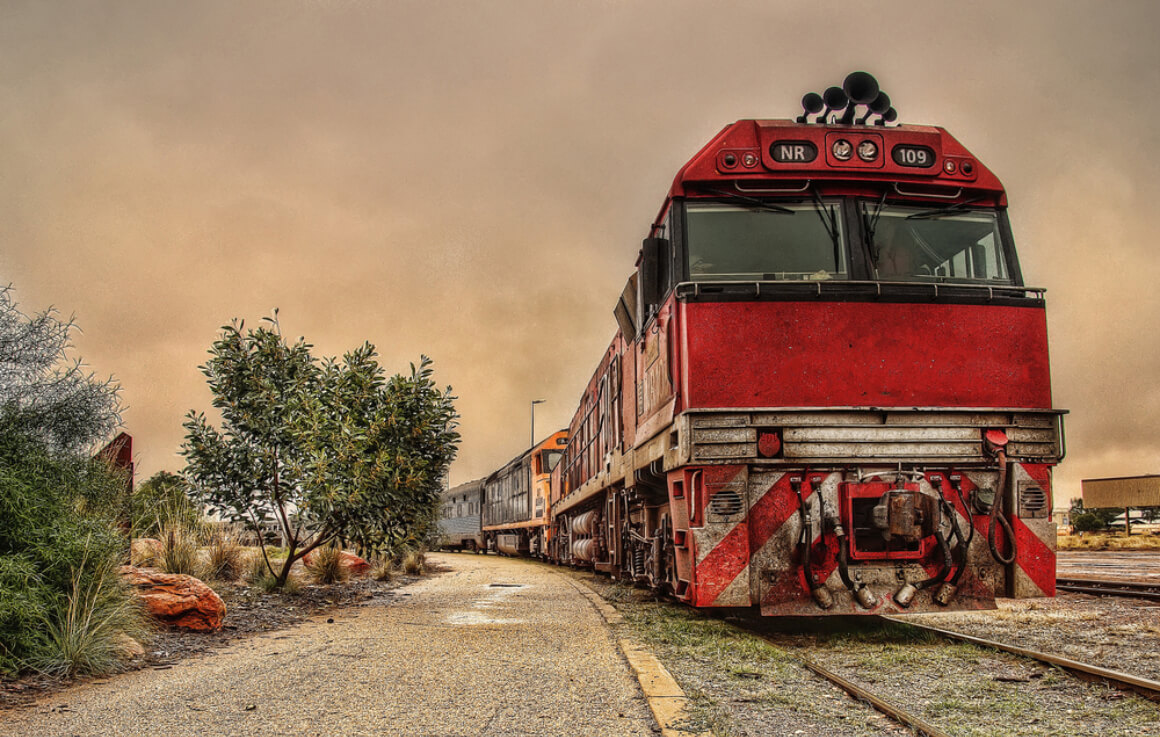
There are no high-speed trains in Australia, although plans to build high-speed routes have been in the works for some years. If you do want to take advantage of the sightseeing and the sense of adventure on offer from Australia’s railways then make sure to book in advance.
Booking at least six months in advance will give you over 10% discount on certain routes; sometimes you can save up to $25. Families will be pleased to learn that children under the age of four travel free. Rail passes can help to make the price of a train trip much cheaper with a variety of different routes and passes on sale.
Here’s a look at just some of the railway passes on offer in Australia.
- Discovery Pass – 14 days $160: unlimited travel in New South Wales, as well as on routes to Brisbane and Melbourne on NSW TrainLink.
- Queensland Explorer Pass – 1 month $206: unlimited travel on most train services in Queensland.
- Queensland Coastal Pass – 1 month $100 : allows travel one-way between Brisbane and Cairns with unlimited stops.
Hopping aboard air-conditioned trains that connect Sydney with Melbourne, Brisbane and Canberra cut out the need to pay for expensive airfares. The routes are run by NSW TrainLink, which runs daily XPT trains between Sydney to Melbourne. There’s also an overnight train so you can save time and on the cost of accommodation by bedding down on the train.
The choice of month-long passes is an ideal choice for those who are thinking about travelling long-term in Australia, or in a certain region. Most of the passes offer a choice of days, weeks, or months, so all you have to do is choose the option that suits you and get travelling.
Bus Travel in Australia
Australia has a sizable bus network which makes getting between destinations straightforward. The buses are well-used by travellers for getting around, as they ply the most popular destinations and big tourist spots. It might not be as exciting as a flight or even a train journey, but bus trips in Australia are a whole lot more affordable
The only downside of grabbing a seat on a bus is that the distances are long . You should know that routes often take multiple hours to drive and night buses are not uncommon. On the bright side, the buses are clean, and modern, and have that much-needed aircon. Overall the services are reliable and there are even toilets and wi-fi on board.
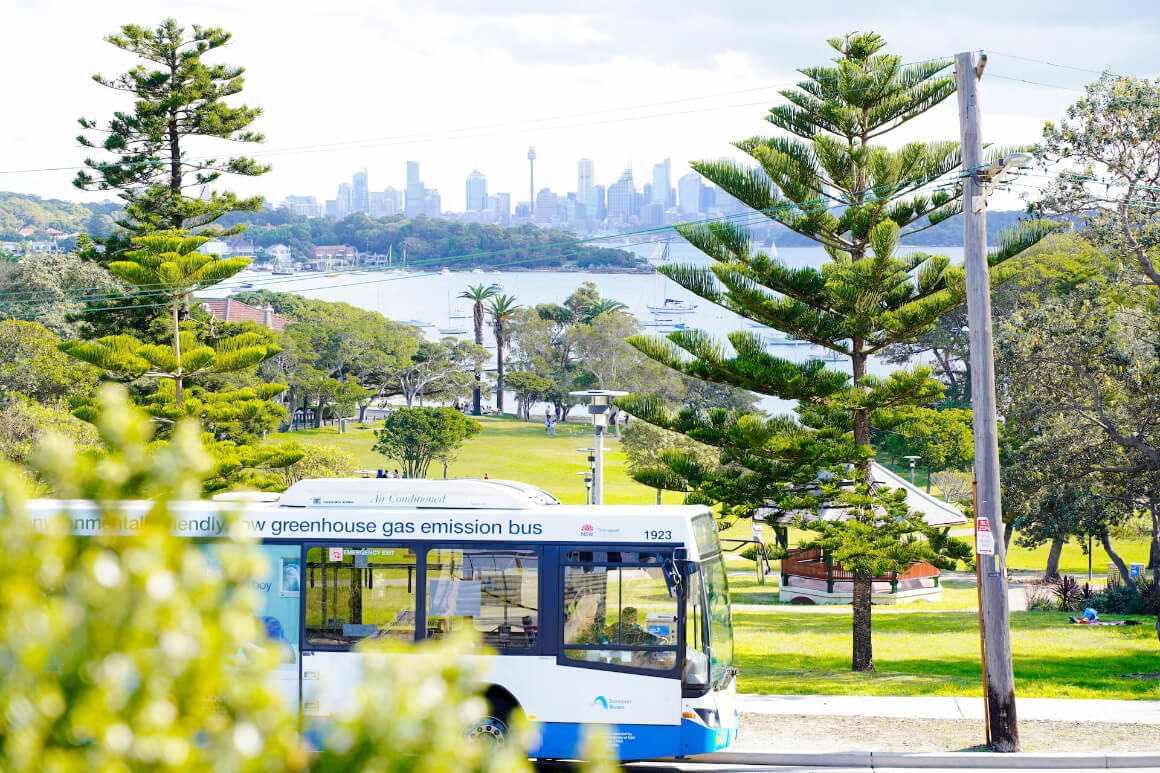
The main bus companies are Greyhound, Intercity Coach Lines, and Firefly Express. Tickets are easy to purchase online ahead of time and you can even buy hop-on and hop-off fares, which really adds a lot of flexibility to your trip.
Fares will vary depending on the length of the trip and the destination, but overall bus travel in Australia is really good value, especially if you use the Greyhouse Bus passes .
One example is the Greyhound East Coast Australia Bus Pass, which can be used on the route up the East Coast and costs $172.
Possibly one of the best options when it comes to affordable transport in Australia is the Greyhouse Whimit Bus Pass. The flexible pass gives you unlimited travel on the Greyhound network in a specific block of time – for example, costs are 30 days, $289; 90 days, $413; and 115 days $234.
Overnight buses in Australia also can help to save you some money on accommodation so you can turn up at your destination and get exploring.
Flying in Australia
Being such a huge country, one of the most popular ways to travel around is by catching a flight. If you don’t have much time and want to see some particular sites in Australia, the best way to get around is by flying. Driving and train travel can take days so the only option to get around quickly is to catch a plane.
In recent years, there have been more budget operators flying interstate routes in Australia, but prices can still be expensive. One-way flights from Perth to Darwin cost around $250; Sydney to Melbourne cost around $100.
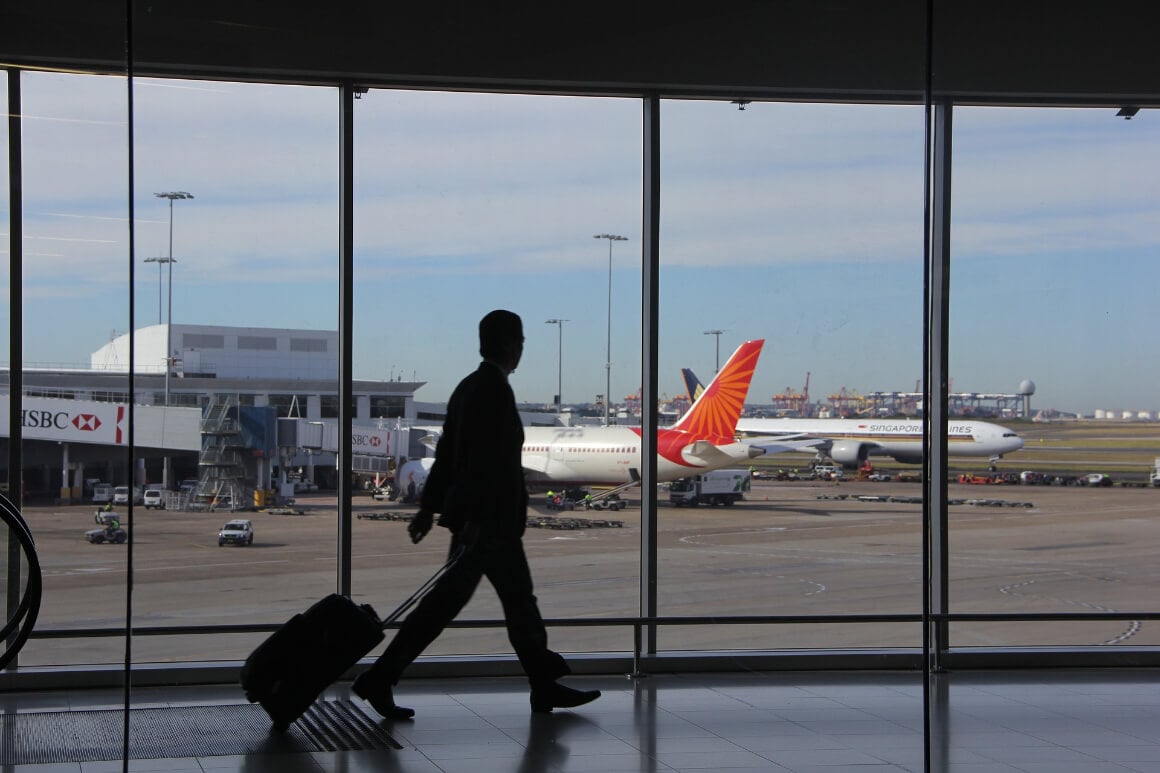
There are some discounted tickets sold by various airlines in Australia. One option is the Walkabout Air Pass which will give you three discounted flights within the country, but this must be booked when you book your international flight to Australia.
The best way to secure deals on flights in Australia is to book in advance and try to be flexible when it comes to times. Otherwise, if you really need to schedule a flight for your trip, you’ll just have to budget for it accordingly.
Getting Around Cities in Australia
Once you’re on the ground in Australia, you’re going to want to explore all of the sights and fun local neighbourhoods in its towns and cities. Luckily, Australia’s cities have some easy-to-use public transport networks so you can leave the car behind and take the train or bus instead.
The Australian cities of Sydney, Melbourne, Brisbane, Perth, and Adelaide all have extensive rail networks, but only Sydney has a metro network. However, Melbourne, Brisbane, and Perth all have city-centre commuter trains that work pretty much the same as a metro.
Sydney can be a bit daunting at first, but you’ll be able to rely on cheap public transport to get around. One of the best ways to see the city is by taking one of its ferries. That way you can see the sights and get around quickly and cheaply, too.
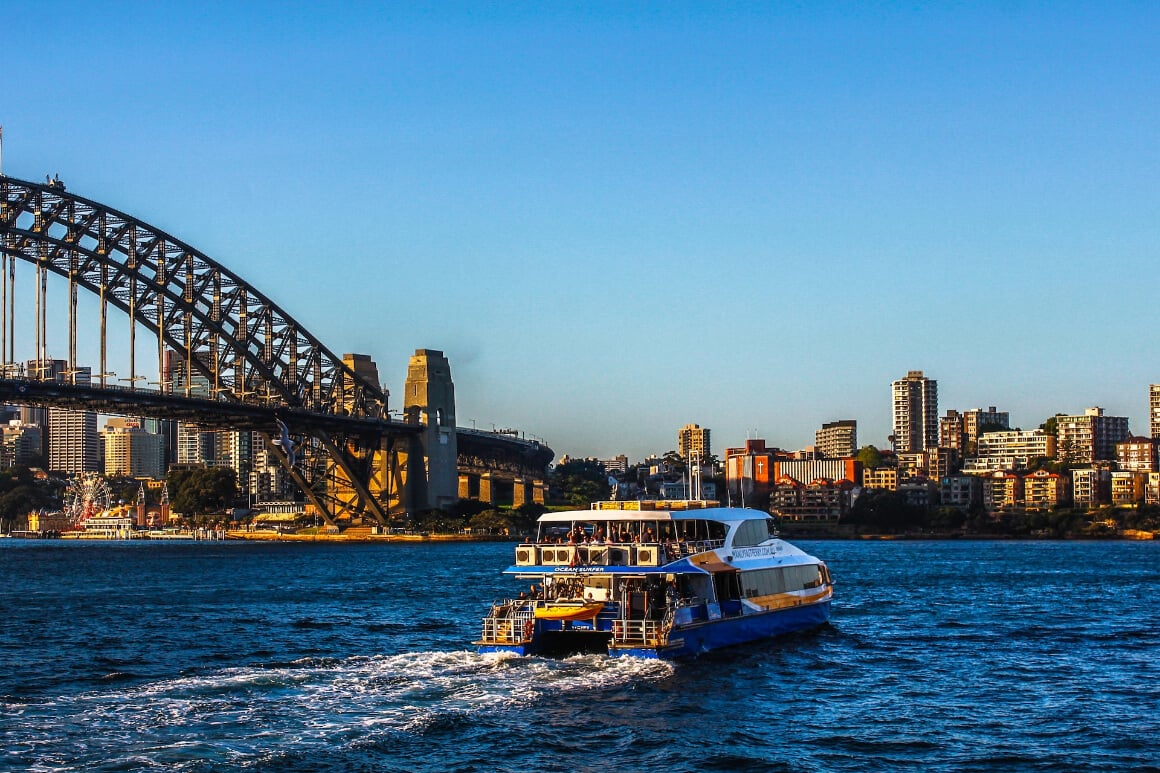
You can also get buses around the city. The network is run by Transport NSW which operates buses from 4:30am to 12.00pm as well as night buses. Big city bus hubs can be found at Circular Quay, Wynyard station, Central Station, and Town Hall Station.
Sydney has an electric ticket called the Opal card . You can order one online before your trip or simply pick one up at the newsagents and convenience stores in the city. The minimum credit is $10, but if you pick one up at the airport you will be charged $35 which is the fee to catch the train into the city centre.
For those of you who like to cycle in cities, it’s best to stick to the metro. Sydney isn’t well known when it comes to great cycle routes; there are a whole lot of hills to tackle and the infrastructure isn’t well-laid out for cyclists.
If you want to get around quickly and it’s not rush hour then you can always hop in a taxi. Reliable and affordable for short tips, just make sure to avoid them at busy times.
Renting a Car in Australia
Australia is an amazing place to take a road trip . Getting behind the wheel and hitting the road in Aus is what dreams are made of. This absolutely enormous country has some epic roads that make taking a trip by car always a good idea. You can breeze through the desert and stop off at far-flung towns to have the most memorable trip ever.
Choosing which route to take or how long you have to spare can be hard to work out though. There’s a selection of different vehicles to select from depending on the journey you’re going to be embarking on. For shorter trips, a normal car should be totally fine just as long as it’s a new and well-maintained vehicle.
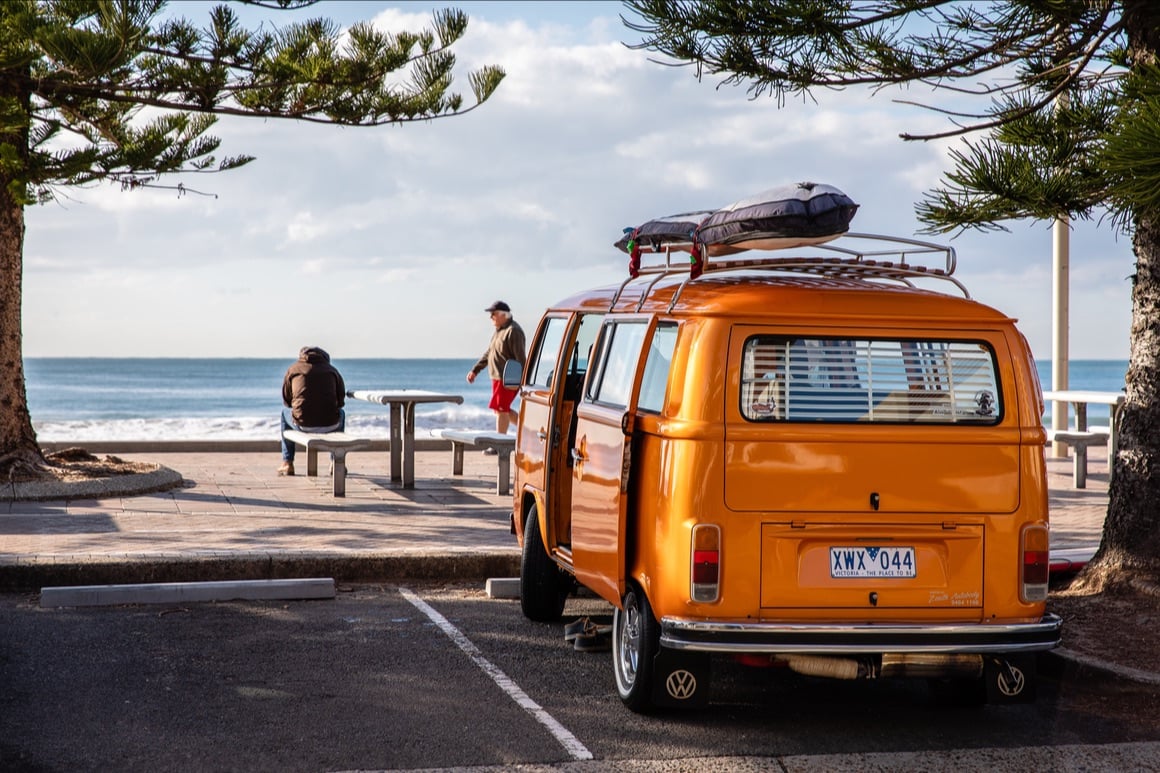
For a longer trip, you may want to consider hiring a larger car or even a campervan to travel around in. Campervans are a good idea if you’re travelling as a group or as a couple.
You can save a lot of money when it comes to accommodation costs but will need to pay to camp overnight at campsites, though there are places you can camp free of charge which can save you some cash.
The average cost of car rental in Australia is $1,903 per month, which is around $63 per day. This price will vary depending on the size of the car and the time of year. You can find a long list of international firms in big cities and at airports, as well as smaller local companies in local communities.
It’s a good idea to check that Collision Damage Waiver (CDW) is part of the rental price being quoted, and you should also take note of the additional insurance which can cost upwards of $9 per day. Parking can also cost $15 or more a day depending on the location.
One more cost that you will want to factor into road trips is the price of toll roads. Some of Australia’s roads are privately owned and the cost of tolls can quickly add up. Fuel in Australia is currently priced at around $1.16 per litre.
Want to save some cash and explore Australia by rental car? Use rentalcar.com to find the best deal possible. There are some great prices on the site and they aren’t difficult to find.
ESTIMATED EXPENSE: $10 – $50 USD per day
Australia is well known for one type of food: Barbecue. This is the nation’s famous al fresco cook-up which takes place in backyards, on beaches, and at campsites. The food culture of Australia has a lot of its roots in British dishes, but over the years has developed its own sense of identity and style
Australia is lucky to have a ton of fresh ingredients grown around the nation as well as enough coastline which means a supply of fresh seafood is never too far away. International influences and exciting flavours help to add unique twists to classic dishes.
Here’s some food you should look out for when in Aus.
- Fish and chips – Like the British, the Australians love their fish and chips. Think freshly caught fish fried in a golden batter and served up with some sizzling chips. Make sure to always eat where it is best, right by the sea when it’s wrapped in paper.
- BBQ – If you’re from the US, this isn’t the kind of barbeque you know and love. Australians use their grills to cook meaty feats of sausages, burgers, and seafood. The cooked food is then served up with bread, salads, and sauces. A few beers to wash it down is a must.
- Kangaroo – Yes, you might think these cute guys are the icon of the nation, but the truth is they taste pretty good, too. It’s not unusual to see ‘roo meat on sale in supermarkets and on restaurant menus in the form of burgers and steaks. It’s delicious and lean as well.
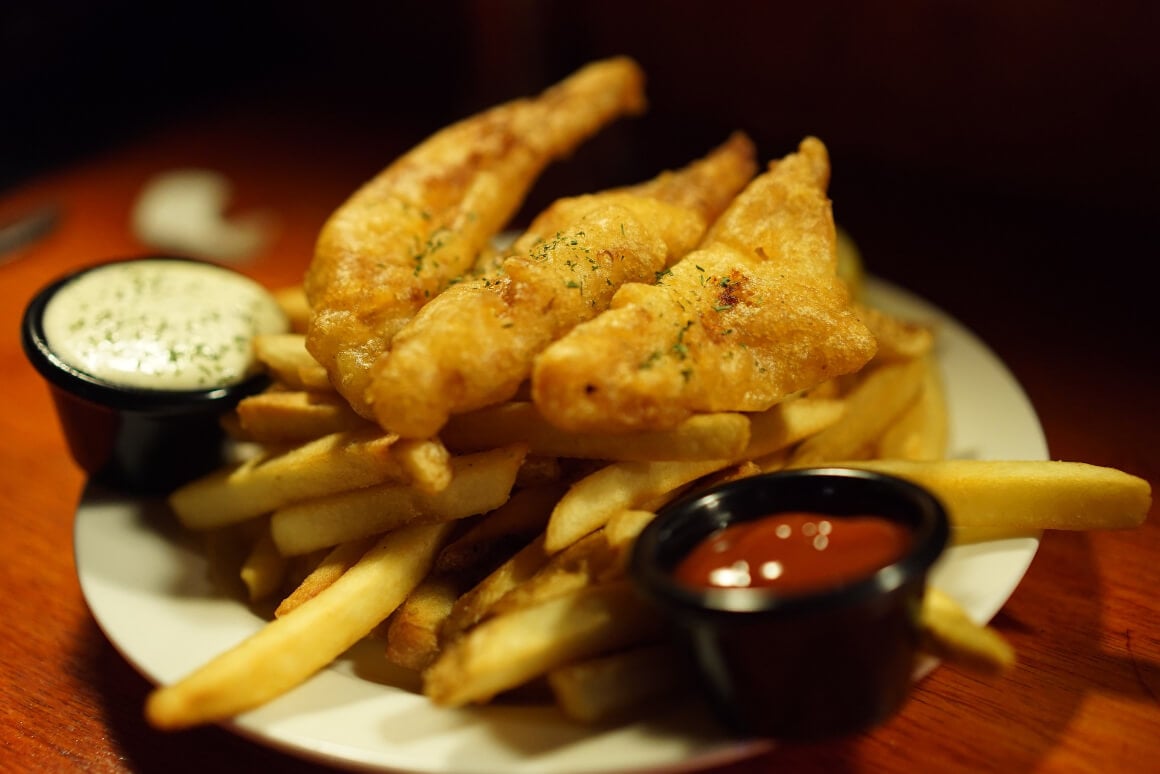
Is Australia expensive for food? Well, depending on where you eat, it really can be. Here are a couple of handy tips to help you enjoy some good food in Australia that doesn’t break the bank.
- Look for apps with deals – Download some of Australia’s apps that show you free tables at local restaurants and which will entice you in with cheap last-minute deals, too. Options to try to include EatClub, which can get you up to 50% off meals, and Liven.
- Look for lunchtime deals – Throughout the week you’ll find that lots of pubs and restaurants have great lunch meal deals. All you have to do is turn up and fill up on your lunch for a whole lot cheaper than the price of a normal meal at the same place.
- Get onboard with Cheap-arse Tuesdays – Yes, you guessed it. Tuesday is the day of the week when eateries, cinemas and bars slash their prices in order to get customers through the door. You can get some really cheap deals on Tuesdays so make sure you don’t miss out
Where to Eat Cheaply in Australia
Depending on what part of town or city you are staying in Australia can be expensive for food and drink. But there are some ways you can stick to your daily travel budget and still enjoy a whole lot of tasty food. Here are a couple of helpful tips…
- Return Servicemen Leagues (RSLs) – These long-established Australian institutes were set up to provide support to soldiers returning home after WWI. Now, these networks of clubs are pillars of the local communities and serve some pretty fantastic value meals; the Bondi iteration sells steaks for $10 on Wednesdays.
- Bakeries – Bakeries in Aus are in a league of their own. A community staple, stop by to pick up a warm sausage roll or meat pie for less than $5. The cakes are awesome, too. There are also Vietnamese bakeries that sell banh mi for between $5-7.
- Go for Thai – Thai food has made a big impact on Australian cuisine over the past few decades. You can find Thai eateries in all sorts of neighbourhoods and they’re a great place for a casual meal. Meals usually cost around $12 with lunch special around $10, you can even get cheap drinks, too.
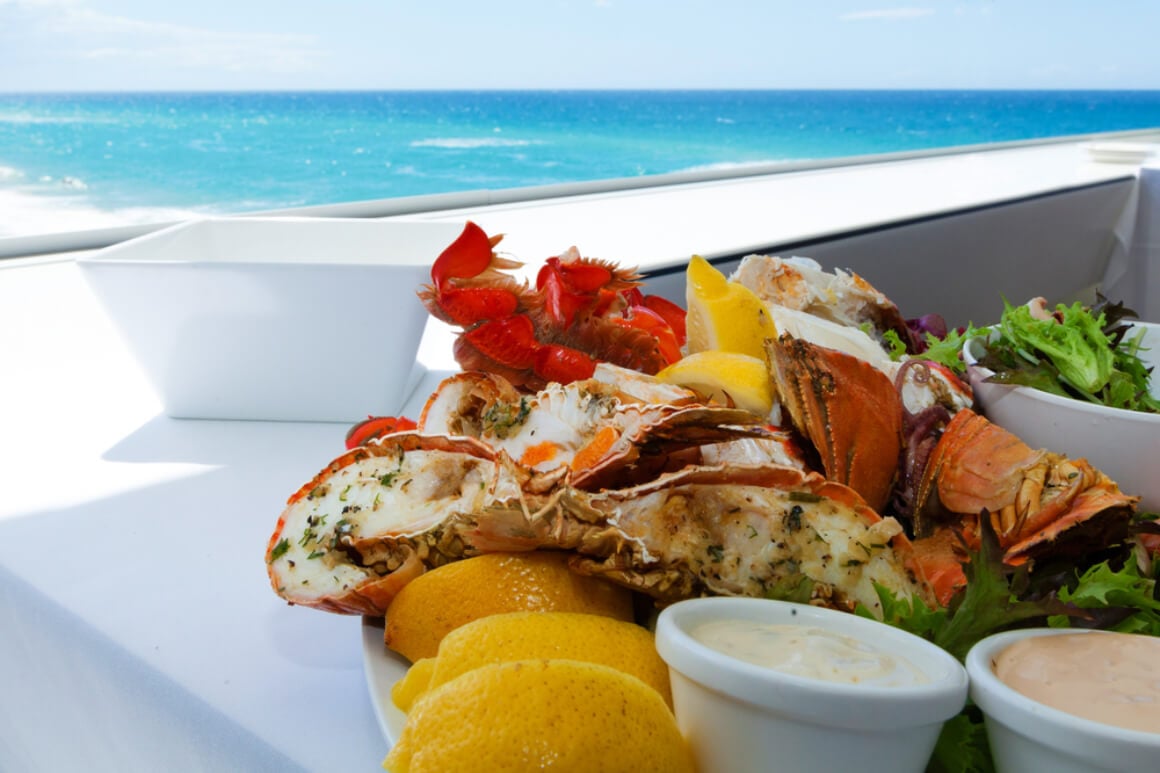
But when you’re on a big trip and trying to stick to a budget, you can’t eat out all the time. There will be meals where you have to cut back a bit on the cost and simply cook for yourself.
Thankfully, Australia has a good selection of cheap supermarket chains that are reliable places for buying low-cost ingredients.
- Aldi – With some of the lowest prices around, Aldi is a favourite of budget shoppers in Australia. Shoppers can purchase a range of global products as well as fresh fruit and vegetables. Some shops have their own bakeries.
- Woolworths – While it may not be the absolute cheapest, Woolworths can be found up and down the country and sells a selection of fresh produce and locally sourced ingredients. It’s reliable and you can find some pretty good deals.
ESTIMATED EXPENSE: $0 – $38 per day
Whether it’s having a few drinks, a few cold ones with mates, kicking back with a glass of wine after work, or a stubbie with a BBQ, Australians love a drink. The nation has a strong culture of drinking and you don’t have to go far to find a bar or shop that sells alcohol.
The culture around drinking is fairly relaxed, it’s often a part of social situations and it’s pretty normal to see people grabbing a few drinks after work or with their friends and families. But the price of alcohol in Australia can be surprisingly expensive. In 2018 the minimum price for alcohol was set at $1.30 per drink.
Pub culture is also a big part of drinking in Australia. Wherever you are in the country, chances are you’ll be able to find a local pub in the town. These social hubs are where you will find locals drinking but they can also be frequented by families and students in certain areas.
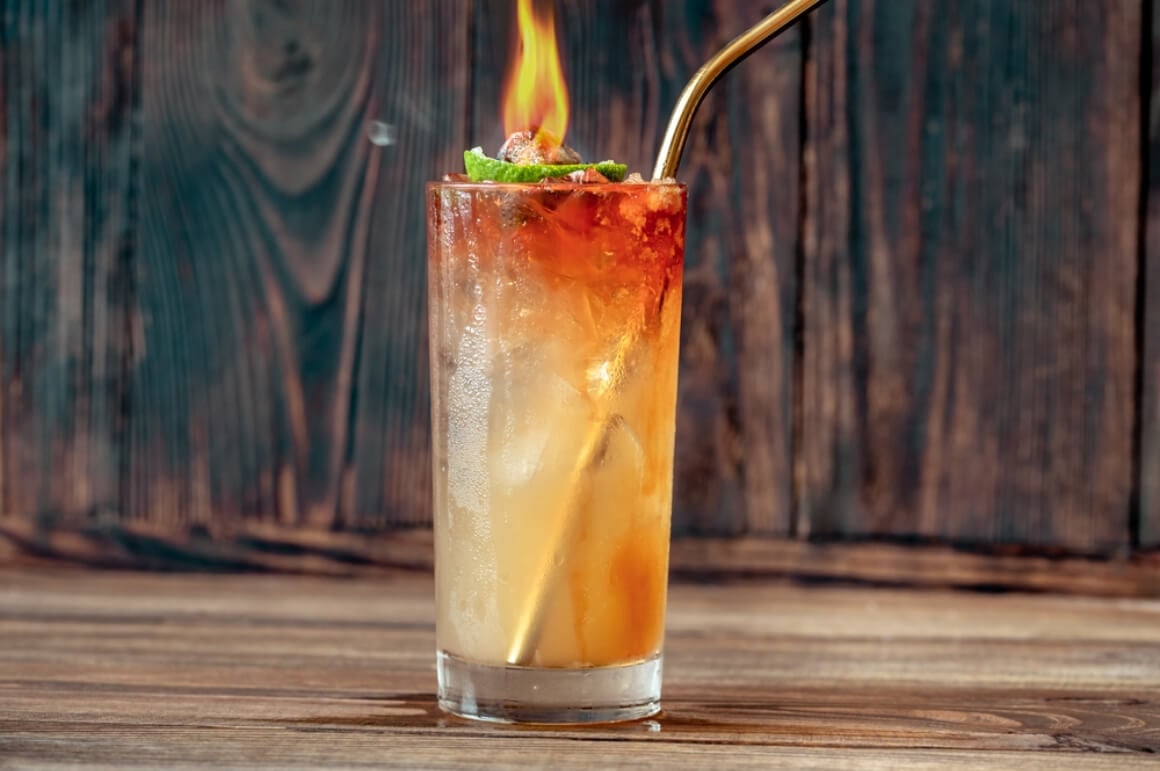
The cheapest places to drink in Australia can usually be found around areas that are popular with backpackers or students. Bars in these parts of town will advertise cheap drinks deals and happy hours to entice budget-minded party-goers through the doors.
Beer is available all over Australia and is typically sold in a 425ml glass called a schooner or a 570ml pint. Costs range from $6 for a schooner, or upwards of $10 for a pint.
Wine is also a very popular drink in Australia. After all, the nation produces some fantastic home-grown wine. Glasses of wine in a bar will cost around $6-$8, while a bottle of wine is usually priced anywhere between $14 and $20 (at the lower end).
Cocktails at a nice Melbourne restaurant or in a swanky bar in Sydney will usually cost you somewhere between $10 and $15.
Read on to find out what regional specialty drinks you should make sure to try on your trip:
- Lemon Lime and Bitters – This refreshing cocktail has become a national favourite. Made with a mix of lemonade, lime juice cordial, and Angostura bitters, the low alcohol content means that it’s sippable throughout the day.
- Shiraz – You can’t leave Aus without enjoying a delicious glass of home-grown shiraz. Prices vary but you can pick up a great bottle from a supermarket for around $20 and spend the evening savouring the flavour.
For when you really want to party, make sure not to miss out on the happy hours. If you want to have a few drinks and not break the bank, happy hours are for you. Just keep an eye out for adverts in bar windows and check out good happy hours near you online. The best part is that food is often included in the deal too!
ESTIMATED EXPENSE : $0 – $35 USD per day
Australia offers up a whole world of fantastic attractions that are bound to keep you busy during your trip. This might not be a visit to Rome with all of its history, or even a break in Paris, but what Australia does offer is modern cities, wonderful beaches, and a stunning selection of national parks.
This country is definitely one for those who love the great outdoors. Aus is awash with activities that will get your adrenaline racing or simply chill you out along the coast. You’ll be able to choose from epic water sports like surfing and diving or spend the day sunning yourself at the beach.
The costs of popular activities can be expensive. Taking a tour of a winery in the Yarra Valley costs approximately $50 per person, whereas if you want to spend the day diving you should put aside about $250 for the trip.
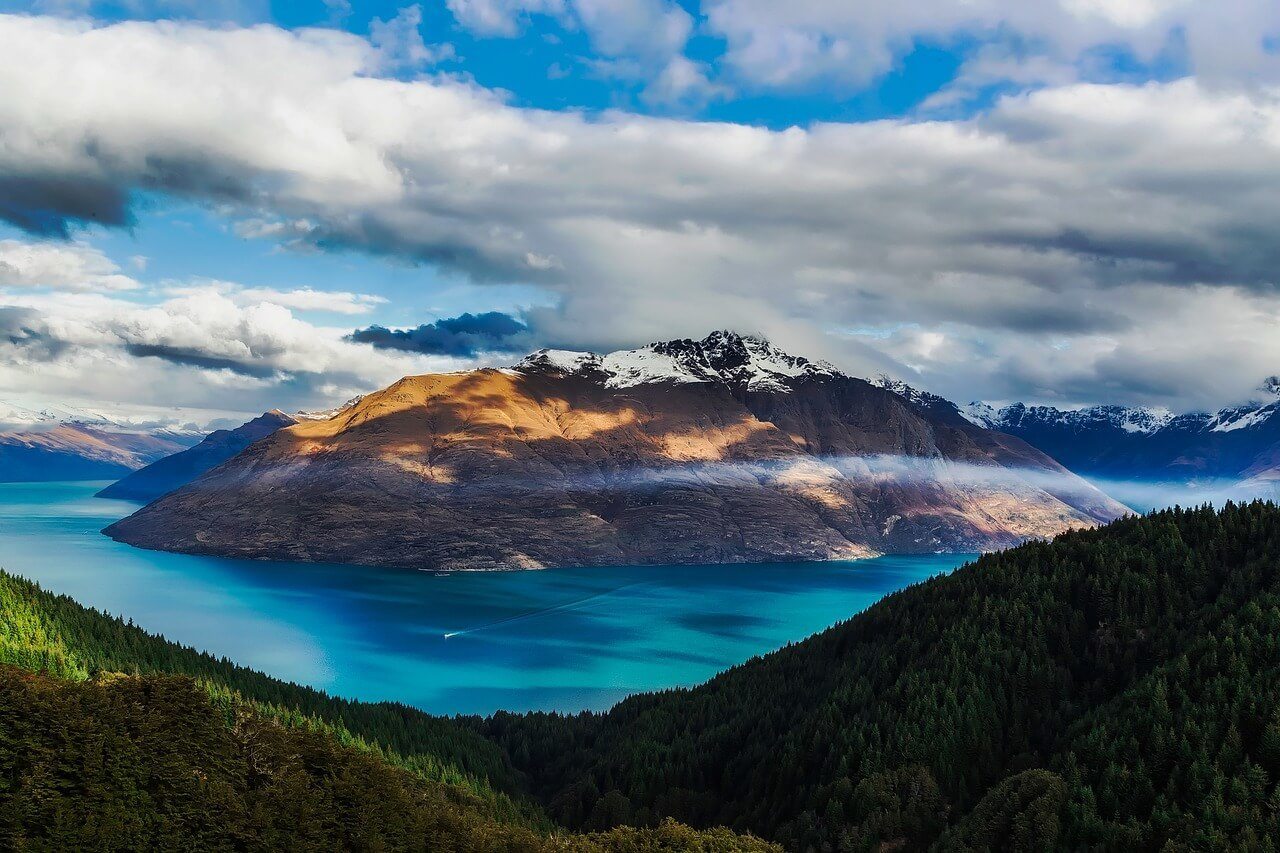
Australia’s national parks are great places to get stuck into the natural scenery for a small price. A lot of the parks don’t charge entrance fees, while some only charge a small amount. They often have camping facilities and other amenities for visitors to use.
If you want to make full use of the parks, it’s a good idea to purchase an affordable National Park Pass which can make longer visits much cheaper. You can spend days hiking in the wonderful scenery and spend hardly any money at all.
When you’re in a town or city and want to spend the day at a museum or gallery, make sure to budget around $10-$20 for the ticket. Some places do have free entry days or offer discount prices to students. Cities like Sydney have passes for tourists which include skip-the-line entrance.
To help you save money on attractions in Australia, here are some pointers to take into consideration:
- Take a walk – One of the best ways to get to grips with a new city is to hit the streets. Sydney is a fantastic place to have a stroll, especially around the harbour. Walk across the bridge, meander the parks and soak up the history – all for free. Better yet, take the Free City Walking Tour which departs daily from Sydney Town Hall.
- Hit up Darling Harbour on Saturday night – this vibrant hub for food and culture is the perfect place to catch the free Darling Harbour Fireworks. Simply kick back and enjoy and then wander around the neighbourhood soaking up the weekend ambience.

A new country, a new contract, a new piece of plastic – booooring. Instead, buy an eSIM!
An eSIM works just like an app: you buy it, you download it, and BOOM! You’re connected the minute you land. It’s that easy.
Is your phone eSIM ready? Read about how e-Sims work or click below to see one of the top eSIM providers on the market and ditch the plastic .
By now, you should hopefully have a pretty good idea of your Australia travel budget. I’ve outlined the cost of food, flights, accommodation, and activities. There are a few more things that you will need to factor into your daily budget, however.
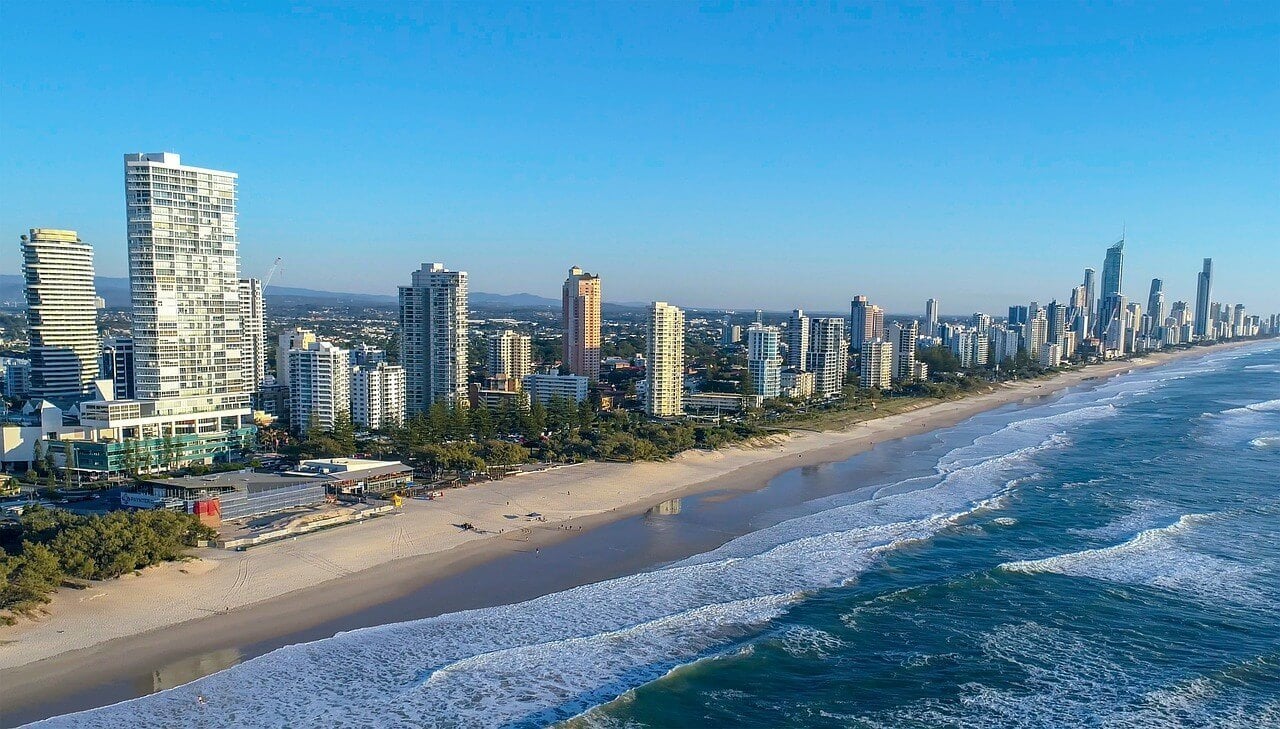
Hidden daily costs can be hard to plan for in advance, but can quickly add up when you’re out and about on a trip. You could see some nice gifts you want to pick up for your family and friends, or you might even want to buy yourself some souvenirs to remember your trip.
Other costs that you might not foresee include paying for laundry at hostels, storing your luggage at a station, or buying a coffee every morning. All of these small costs will add up and can really make a dent in the cost of your trip.
It’s a good plan to put aside around 10% of your trip budget for these one-off purchases so the costs don’t creep up on you.
Tipping in Australia
As with most places in the world, tipping is a voluntary action and not something you have to do in Australia. That being said, you should try to leave a token of your gratitude for the waitstaff after a good meal or if you have received particularly good service.
It’s normal to leave a tip in restaurants in Australia, around 10% is the normal amount that is left. Sometimes gratuity is already included on the bill at the end of the meal; if that’s the case, you don’t have to leave a tip. But you don’t actually have to pay the gratuity if you don’t think the service was up to scratch.
If you’re at a cafe and have enjoyed a nice coffee or lunch, then you could opt to leave a few dollars for the staff. In this case, around 5% or simply rounding up the bill is a good idea. Some people might just put a few dollars in the tip jar on the counter.
When you’re on a tour or are taking part in an activity like scuba diving and you have really enjoyed your experience, it’s a nice gesture to tip the tour leader a few dollars at the end of the day. This is also very much appreciated if you’re taking advantage of a free walking tour in a city like Sydney.
For services such as hairdressers and drivers, you don’t need to tip, but if you have been pleased with the level of service then a few dollars (or rounding up) is a nice amount to leave. The tip is not expected, however.
At high-end hotels sometimes tipping is par for the course. Usually, guests would leave a couple of dollars for the concierge or the bellhop. It’s also fairly common to leave a token of appreciation for the housekeeping team to show them your thanks.
Overall, Australians in the service industry are paid a good living wage and do not usually have to supplement their paycheck with tips. You don’t have to tip in Australia, but it’s always nice to tip for good service.
Get Travel Insurance for Australia
Before you jet off on your big Australia getaway, there’s one thing you should take a moment to consider. And no, it’s not if you should pack a few more pairs of pants.
Life can throw all sorts of things in the way of a good time, so you might want to check out travel insurance before your tip. Being covered by travel insurance can help if things go wrong or can simply cover you for delayed flights or lost luggage.
ALWAYS sort out your backpacker insurance before your trip. There’s plenty to choose from in that department, but a good place to start is Safety Wing .
They offer month-to-month payments, no lock-in contracts, and require absolutely no itineraries: that’s the exact kind of insurance long-term travellers and digital nomads need.

SafetyWing is cheap, easy, and admin-free: just sign up lickety-split so you can get back to it!
Click the button below to learn more about SafetyWing’s setup or read our insider review for the full tasty scoop.
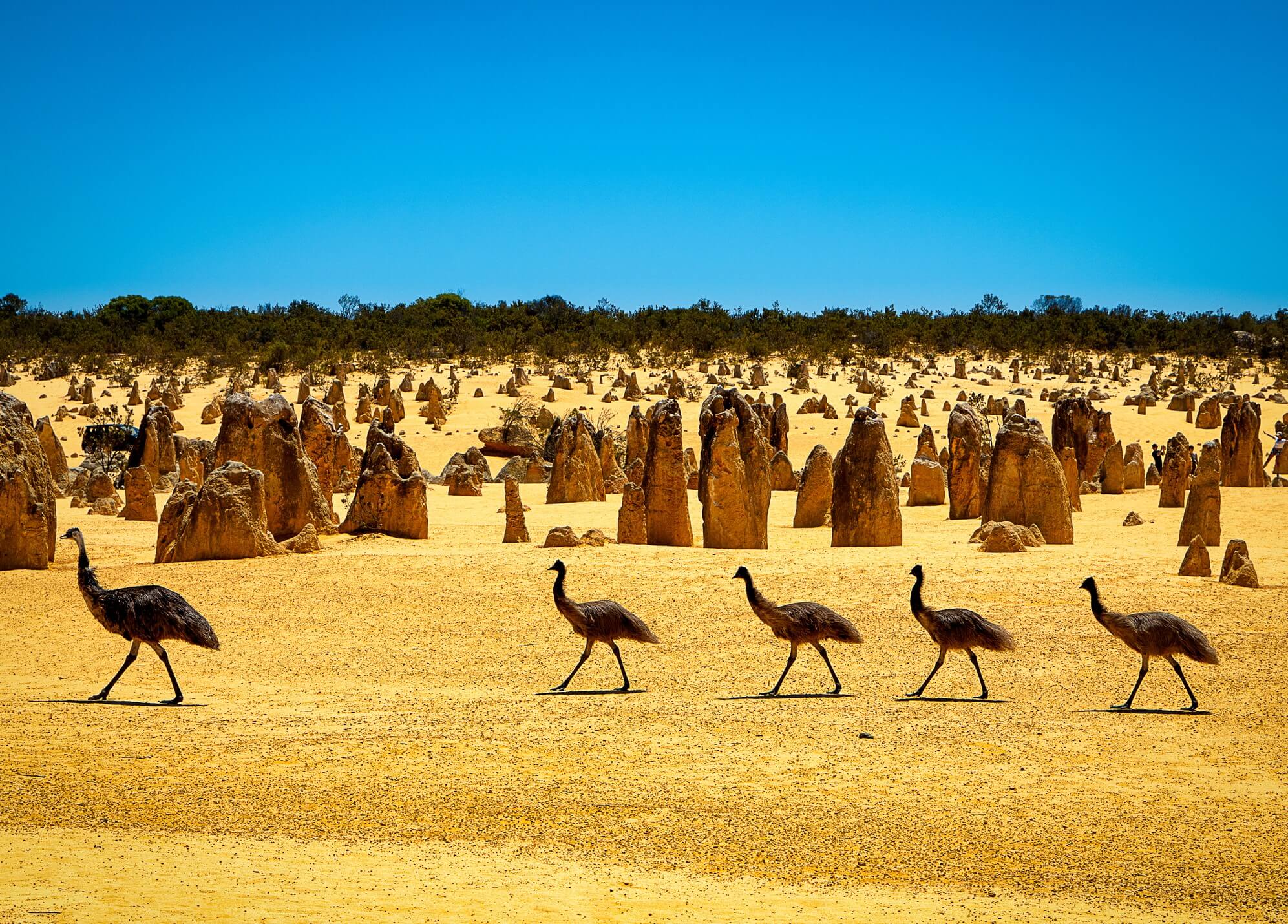
Ok, I’ve gone over pretty much all the big costs and hopefully helped to answer the question of ‘Is Australia expensive?’ So before we all head off into the sunshine, here are some final pieces of money-saving advice…
- Try not to rush it – Australia is one big country and it’s best seen at a slow pace. If you want to see everything in a short amount of time you are going to quickly burn through your budget by spending over the odds on accommodation and flights. Take it slowly and enjoy.
- Hit up the hostels – Hostels are where it’s at for budget travel in Aus. Not only are they good places for a cheap sleep, but they also have great social scenes and a list of free activities that guests can get involved with.
- Have a water bottle : Don’t waste money on plastic, bottled waters; carry your own and refill it in the fountains and the tap. If you’re worried about potable water, get a filtered bottle, like the GRAYL, which filters out 99% of viruses and bacteria
- Don’t be fixed to one date – If you really want to save money on your trip then you need to be flexible with when you fly. Costs of flights can fluctuate from week to week meaning you could save hundreds of dollars just by booking your trip for a week or two later.
- Book transport in advance – Trains and buses are the cheapest way to get around but to really secure good prices you need to book trains well in advance and buses are cheapest if you purchase a bus pass before you travel.
- Earn money while you travel: Teaching English while traveling is a great way to make ends meet! If you find a sweet gig, you may even end up living in Australia.
- Look for deals – There are so many deals to be had in Australia, from happy hours to bargain dinners in pubs. Just keep your eye out for cheap eats and activities. Join groups on social media, download apps, and sign up for mailers so you don’t miss out.
- Become a volunteer with Worldpackers : Give back to the local community and, in exchange, you’re room and board will often be covered. It’s not always free, but it’s still a cheap way to travel in Australia.
- Don’t try to do everything – Sometimes we simply try to fit too much into a trip. You might be better off just sticking to one portion of the country and seeing how it goes. In the long run, you could actually end up enjoying your trip a lot more and saving money on long-distance travel, too.

Our GREATEST Travel Secrets…
Pop your email here & get the original Broke Backpacker Bible for FREE.
I’ve said it before and I’ll say it again, Australia isn’t that expensive. This far-flung destination has a rich array of wild natural scenery, super friendly people, and an easy-going beach scene. It’s true that it can be expensive – if you stay in expensive hotels and eat out every night.
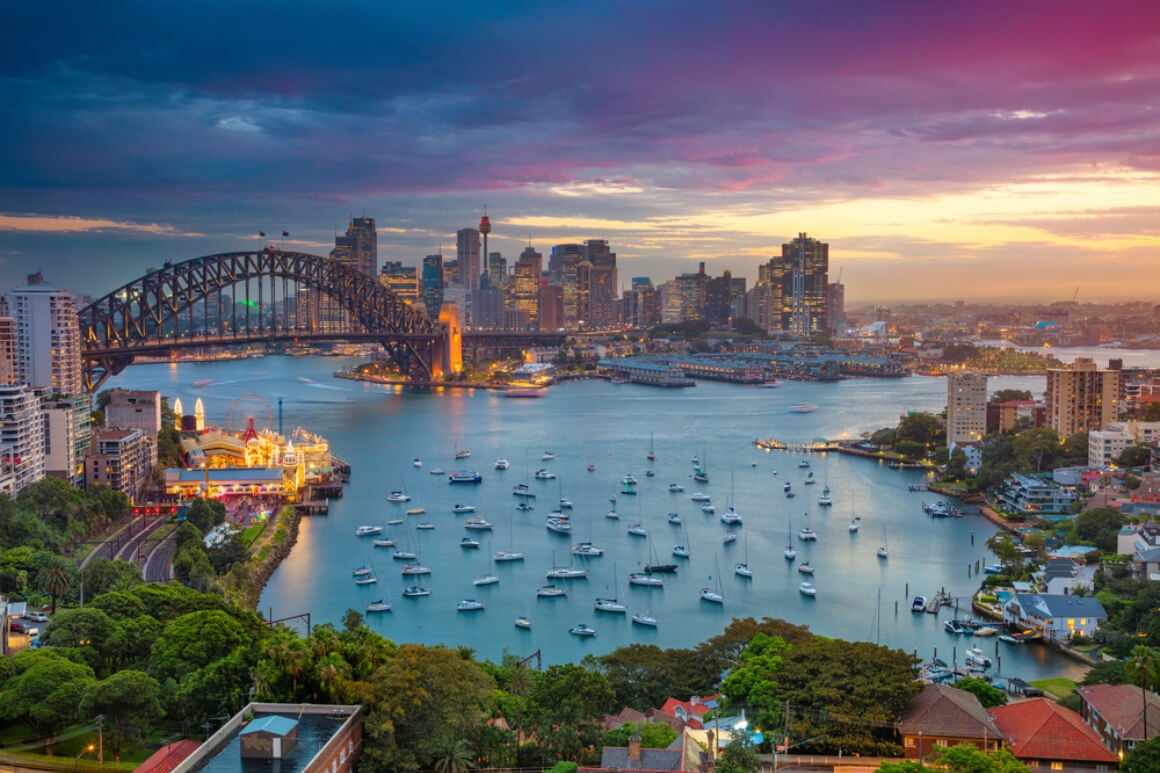
But your trip doesn’t need to break the bank. Australia is well used to budget travellers and has got a great choice of cheap accommodation, backpacker bars, and affordable transport for you to take full advantage of.
What we think the average daily budget for Australia should be:
So, as long as you don’t try to do everything, a reasonable budget per day for Australia is around $45.
Buy Us a Coffee !
A couple of you lovely readers suggested we set up a tip jar for direct support as an alternative to booking through our links. So we created one!
You can now buy The Broke Backpacker a coffee . If you like and use our content to plan your trips, it’s a much appreciated way to show appreciation 🙂

Alexandria Zboyovski
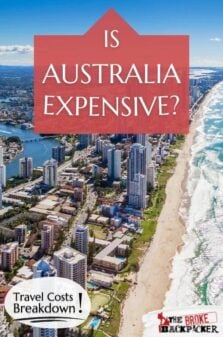
Share or save this post

Leave a Reply Cancel reply
Your email address will not be published. Required fields are marked *
Save my name, email, and website in this browser for the next time I comment.
Notify me of followup comments via e-mail.
- Travel Planning Guide
How much does a trip to Australia Cost?

How much money should you budget for your trip to Australia?
- How much does a one-week trip to Australia cost?
- How much does a two-week trip to Australia cost?
- How much does a one-month trip to Australia cost?
- Hostel Prices
- Hotel Prices
The Cost of a Trip to Australia
Visitors to Australia usually spend between $64 and $448 per day on average for one person and $128 to $896 for two people. While this is a wide range, the average daily cost averages $166 (AU$250) per person. This average includes sightseeing, hotel, food, and local transportation expenses from other travelers. Your individual travel expenses may vary based on travel style and the locations visited, but if you plan wisely while visiting the most popular destinations, such as Sydney, Melbourne, and Cairns, then you'll likely spend somewhere in this price range while on your trip. Further down we have a breakdown of expenses by category, as well as a comparison of independent travel versus guided tour prices.
If you're planning an Independent trip to Australia, budget travelers should plan to spend around $64 (AU$96) per day for their trip. This average includes hostels and budget hotels, affordable meal options, local transportation, and activities. If you're on a mid-range budget, plan for around $166 (AU$250) a day which covers the cost of typical hotels, normal restaurants, and a variety of popular attractions. Luxury travelers should allow for $448 (AU$671) a day, which would cover higher-end hotels, nicer restaurants, and more private tour options. All of these price ranges are based on our extensive travel cost data for Australia from other travelers, along with hotel and tour data from travel companies.
How much does a one week trip to Australia cost?
Most visitors spend between $448 and $3,135 for a one week trip to Australia, with the average being $1,165. This includes sightseeing, local transportation, food, and hotels. One week is enough time to visit one, two, or maybe three locations in Australia, depending on how in-depth you want to make your visit. Some of the most popular places to visit are Sydney , Melbourne , and Cairns .
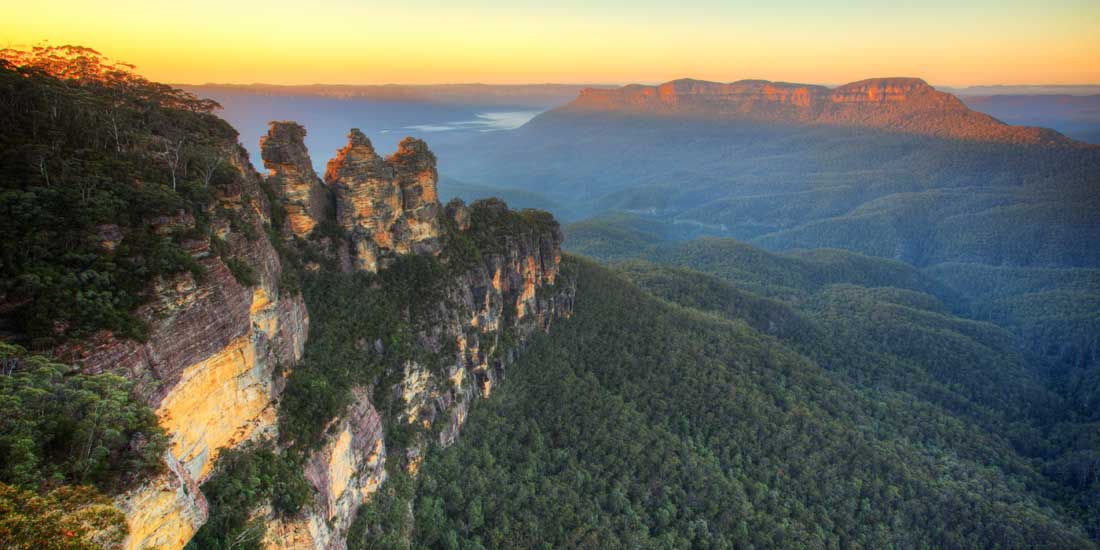
How much does a two week trip to Australia cost?
With two weeks, you should budget between $895 and $6,270 for your trip to Australia. The average price for a two week trip is $2,331. Two weeks will allow you enough time to visit between three and five places. If you're on a budget, you might want to consider some of the more affordable places such as Torquay, Alice Springs, and Cairns.
How much does a one month trip to Australia cost?
When embarking on a month-long trip to Australia, expenses can range from $1,918 to $13,436, with an average cost falling around $4,995. For those fortunate enough to have a full month, considering a vacation rental with a kitchen for at least a portion of your stay can help save money with meals. Backpackers often opt for hostels due to their affordability and the added benefit of a social vibe.
Hostel Prices in Australia
With more than 220 hostels in Australia, the average price is $25 per night for a dorm bed. Hostels are a terrific option for younger independent travelers looking to save money while staying social during their trip. With many types of hostels, it can be overwhelming to sort out the best places, though. Our analysis of the hostels in Australia not only found the average price, but also uncovered some surprises about the overall quality, amenities, and atmosphere of hostels in the region. You can see more details from our analysis about typical hostel prices in Australia here .
Here are a few sample prices from popular hostels in Australia.
- $29 for a dorm bed at Wake Up! Sydney Central in Sydney more details
- $22 for a dorm bed at Flinders Backpackers Melbourne in Melbourne more details
- $13 for a dorm bed at Gilligan's Backpacker Hotel & Resort Cairns in Cairns more details
Hotel Prices in Australia
You'll find a wide range of hotel options across Australia. Below are prices for some of the destinations, and for more details see our analysis of hotel costs in Australia .
Cambridge Cottages
Valentine on george.
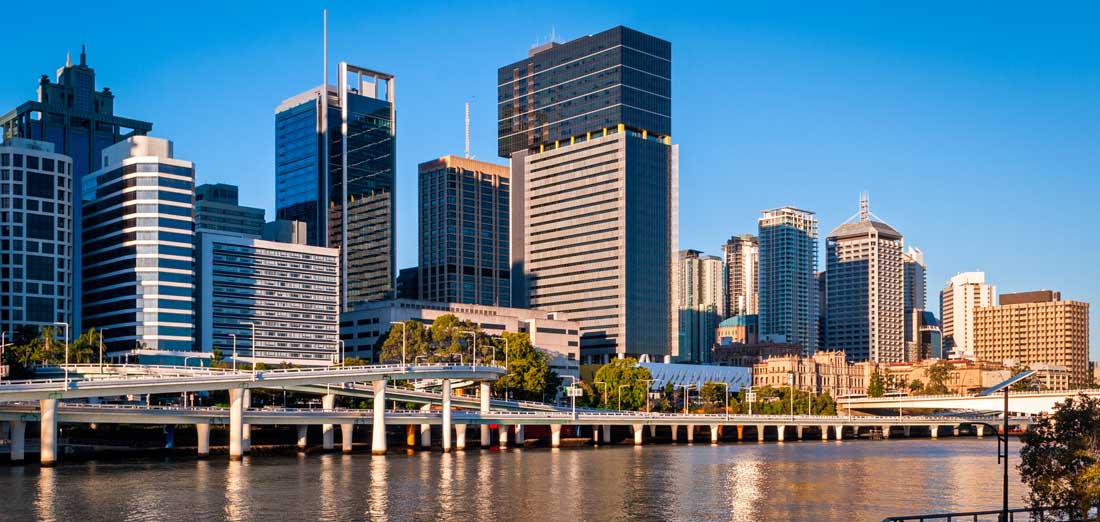
Should you do an organized tour or travel independently in Australia?
Organized tours are an easy and convenient way to visit Australia. All of the details are handled by travel experts, and during the trip you'll benefit from the knowledge of an expert guide.
Traveling independently offers freedom and flexibility that is hard to find on an organized tour.
Many travelers appreciate the convenience and ease that an organized tour offers. Many tours provide transportation and expert guides that help you enjoy your trip.
Alternatively, you'll enjoy freedom and flexibility with independent travel that is difficult to find with an organized tour.
Comparing Trip Costs in Australia
When we compare the prices of organized tours to the average costs of independent travelers, we can see that sometimes the prices are fairly even.
Tours vs. independent Travel: Pros & Cons
Organized tours.
- An expert guide familiar with the culture
- Convenient transportation
- Fellow travelers to socialize with
- Well researched activities
- Efficient and thought out itinerary
- The security of have a trip leader if something goes wrong
- Limited options
- Usually not customizable
- The fast pace often means you can’t visit one place in depth
- Usually more expensive than independent travel
- There may be limited time to interact with the local culture and community
Independent Travel
- Completely customizable
- Opportunity to visit off-the-beaten-path destinations
- Can fully immerse yourself in the local culture
- Freedom to move at your own pace
- Flexibility to change your itinerary at any time
- More affordable
- Challenging to plan an efficient itinerary
- Transportation may be challenging or inefficient
- Booking and trip planning can be a hassle
- Popular sights may sell out well in advance
- If something goes wrong, you're on your own
Are organized tours more expensive than independent travel in Australia?
Organized tours typically average around $293 per day and provide the convenience of an all-inclusive package with one comprehensive payment. On the other hand, independent trips usually average around $166 (AU$250) per day and involve individual payments for accommodations, local transportation, meals, and sightseeing. Both organized tours and independent trips have their own unique challenges and benefits, so it's crucial to thoroughly understand the aspects of each to make a fair comparison. For a detailed analysis of tour prices in Australia, check out our comprehensive guide on tour prices in Australia here .
Here are a few sample tours in Australia:
- Oz East Coast + Work 28 days ($2,999) 28 days, 12 destinations more details
- Sydney to Cairns Best Of The East Coast – 17 Day Boutique Comfort Tour ($6,937) 17 days, 20 destinations more details
- Sydney to Cairns - 14 Day Boutique Comfort Tour ($5,329) 14 days, 15 destinations more details
- 3 Day Great Ocean Road and Grampians ($1,517) 3 days, 11 destinations more details
- Untamed Kimberley (11 Days) ($6,855) 11 days, 8 destinations more details
More for Australia
If you're planning a trip to Australia, check out these other informative travel guides.
We've been gathering travel costs from tens of thousands of actual travelers since 2010, and we use the data to calculate average daily travel costs for destinations around the world. We also systematically analyze the prices of hotels, hostels, and tours from travel providers such as Kayak, HostelWorld, TourRadar, Viator, and others. This combination of expenses from actual travelers, combined with pricing data from major travel companies, gives us a uniqe insight into the overall cost of travel for thousands of cities in countries around the world. You can see more here: How it Works .
Subscribe to our Newsletter
Coupons and discounts! Travel tips!
1 Categories averaged on a per-item basis. 2 Categories averaged on a per-day basis. For example, the Food 2 daily average is for all meals for an entire day, while Entertainment 1 is for each individual purchase. Thus, the overall daily average cost is not a summation of the individual categories.
- You are welcome to reference or display our travel costs on your website as long as you provide a link back to this page .
- For a basic link, you can copy and paste the HTML link code, or this page's address. Address Link HTML Australia Travel Costs " disabled />

Some of the links on this website are sponsored or affiliate links which help to financially support this site. By clicking the link and making a purchase, we may receive a small commission, but this does not affect the price of your purchase.
- Privacy / Terms of Use
- Activities, Day Trips, Things To Do, and Excursions
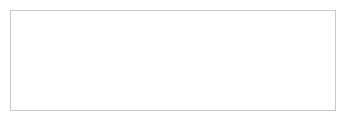
How Much Does It Cost To Travel Australia? A FULL Budget Breakdown (2023)
Trying to figure out how much it costs to travel Australia? Well here’s a full Australia budget breakdown – inc accomodaiton, tours, transport and more!
Planning a trip to Australia ? Trying to figure out how much does it cost to travel Australia?

No worries – I’ve got you covered!
I’ve lived, worked and travelled in Australia more than any other country I’ve visited since hitting the road back in 2009 – in fact Byron Bay is my second home in terms of total time living there!
I know planning a trip to Oz can be daunting – it’s a long way away, it’s not the most budget friendly place, there’s a lot of ground to cover and sooooooo much to see an do!
So to help you figure out how much your trip to Australia will costs here’s a rundown of all the major things you’ll encounter – including food, drink, transport, tours, accommodation and more…
LAST UPDATED Jan 2023 – a lot of stuff has changed around and increased for travel from 2023 onwards, so I’m doing my best to keep this as updated as possible!
(Just FYI, all prices below are in $AUD)
How Much Does It Cost To Travel Australia In 2023?
Greyhound bus.

Easily the most popular way to travel around Australia the Greyhound Bus network covers the whole of the East Coast as well as the Red Centre, Northern Territory and parts of the West Coast too.
They’ve recently revamped the Greyhound Australia Bus pass range and there are now 2 main options; the WHIMit and the East Coast Passes .
The WHIMit covers the entire Greyhound Australia network, whilst the East Coast is the Melbourne to Cairns Route.
Both included unlimited travel and are only limited by time frame – up to 90 days for the National WHIMit and 30 days for the East Coast WhimiT
- 7 Day Greyhound East Coast Pass = $249
- 15 Day Greyhound East Coast Pass = $319
- 30 Day Greyhound East Coast Pass = $389
- 15 Day Greyhound WHIMIT Pass = $349
- 30 Day Greyhound WHIMIT Pass = $439
- 60 Day Greyhound WHIMIT Pass = $499
- 90 Day Greyhound WHIMIT Pass = $629
Premier Bus
Not as popular as the Greyhound but even more budget friendly, the Premier Bus Passes are a great alternative for those travelling the East Coast and who want to be more budget conscious. Again like Greyhound they’re 3 months, but extendable to 6 if you need longer, however they don’t cover the Sydney to Melbourne section.
- Sydney to Cairns Pass = $330
- Sydney to Cairns Pass (1 Month Pass) = $230
- Brisbane/Byron Bay to Cairns Pass = $242
Check out all the Premier Passes here
Campervan Hire

My favourite way to travel around Australia! Even though campervan hire in Australia isn’t the cheapest it’s certainly the most fun and flexible way to get around, especially if you’re travelling as a couple or small group of friends. The cost of campervanning Australia varies heaps depending on your route, time frame, campervan model and of course the season – so the further in advance you book it the better.
Expect to pay from $60AUD per day though, with rates much higher in the peak, summer season, around $110+ per day
For an epic Campervan deal in Australia click here
Accommodation

The most budget friendly and popular accommodation option for the East coast is shared hostels dorms – varying from super flash packer 4 bed A/C ensuite rooms (such as Byron Bay YHA) right through to super budget 12 bed dorms that are certainly less comfortable, but easier on the wallet!
They vary from $25-65 per night – however this can fluctuate quite a bit depending on the location, season, length of your stay and also any key events.
The best advice I can give you is go with a $40 night average as a ball park figure but also check out the latest rates if you’re aiming for peak season or stuff like xmas/NYE in Sydney as this will massive effect how much it cost to travel Australia.
Some of my favourite hostels include;
- WakeUp! (Sydney and Byron Bay)
- The Surf House (Byron Bay)
- Aquarius Backpackers (Byron Bay)
- Halse Lodge Noosa
- Nomads Airlie Beach
- Nomads Magnetic Island (Magnetic Island)
- Jackaroo Treehouse (Mission Beach)
- Gilligans (Cairns)
If you’re keen on a bit more privacy and comfort, but not wanting to splash out on full on hotels then I also highly recommend the private rooms at YHA hostels.
As you might expect hotels in Australia are definitely a step up budget wise, but there is a HUGE range of styles catering for most budgets. Honestly though I couldn’t put a price on them as you could spend $100 a night to $1,000s – so best to check out somewhere like Booking.com and smash in your personal preferences and budget!
Another popular option now is AirBnB and you can get some real unique and comfortable options all over the coast. It’s great for couples or families (but there’s no restriction) and the perfect way to go if you want to treat yourself during your trip too!
Click here for $37 off your first booking!
Food & Drink
As with pretty much everywhere in the world eating out in Australia will really impact your budget – but there is a huge variety of restaurants and bars you can grab food at, from low cost feeds to award winning dinning.

If you are going to eat out and don’t want to break the bank many bars, restaurants and hostels offer discount meal deals – including backpacker deals too. So if you want to eat on the cheap but don’t fancy cooking check out some of these options;
- Queen Victoria Market (Melbourne)
- Sidebar/WakeUp (Sydney
- Dominoes $5 Pizza
9/10 times cooking is going to be the best option for your budget in Australia and you can slap together everything from 50 cent noodles $4.50 veggie pasta right through to whatever dishes from home you’re missing. Coles , Woolworths and ALDI are dotted all the way across Australia so get your cooking skills on the go!
If there’s one easy way to make the cost of travelling Australia expensive it’s by partying! So how much will booze add to your daily budget?!
- Beer in a bar = $5-8
- Beer from a bottle shop = $5
- Glass of wine = $10+
- Wine from a bottle shop = from $5
- Cocktails = $15+
- Box of goon (cheap boxed wine) = $10-15

There is so much to see and do along the East Coast of Australia, so it would be almost impossible to list it all – however here are some of my top picks for the best trips and tours to do so you can figure out how much it cost to travel Australia with all your plans!
- Sydney Harbour Bridge Climb =from $368
- Spot X Surf Camp = from $279 (2 night package)
- Surf Lesson in Byron Bay = $80
- Dolphin kayaking = $89
- Noosa Everglades Canoe Tour = $150
- Fraser Island Overnight 4×4 Tour = $499
- Fraser Island Day Trip = $180
- Whitsunday Islands Overnight Sailing Adventure = around $499 – $599
- Whitsunday Islands Day Tour = $180
- Magnetic Island Package = $140
- 15,000 foot skydive = around $349
- Barrier Reef Snorkel Tour = $195
- Barrier Reef Intro Dive = $245
- Budget Open Water Dive Course = $799
- Overnight Dive Boat = $575 (2 day/1 night inc 7 dives)
- Melbourne Intro Tour = from $399 (4 day option)
Check out RTW Backpackers for everything you need tour wise in Australia by clicking here
Budget For A Month In Australia
Ok so now for the big reveal! How much does it cost to travel Australia and how much do you need to budget for a month in Australia ?
We based on my calculations and taking into account the main trips, tours and style people travel the East Coast….
A month travelling Australia will be around $4,150
Or $138 per day.
This then includes;
- 30 nights accommodation (shared dorm)
- 30 day Greyhound WHIMit Pass
- Surf lesson
- 3 day/2 night Fraser Island 4×4 Safari
- 2 night Whitsundays Sailing Adventure
- Magnetic Island Package
- Barrier Reef Snorkel Tour
- Around $30 per day for food and drink
Obviously this is just a rough guide – you can easily make it more expensive by staying in hotels, private rooms, partying heaps or adding in loads of extra tours and on the other hand you can also make it cheaper by staying at more budget friendly hostels, cooking budget food and skipping out on bigger trips and tours.
But that $4,150 is a good starting point on what you’ll be looking at spending on a month on the East Coast of Australia.
Have you travelled Australia before?
What was your budget, related posts.

Surf Lakes Yeppoon Wave Pool – What’s It Really Like?

Scuba Diving Byron Bay – Everything You Need To Know (+ Promo Code!)

URBNSURF Wave Pool – Which Wave Option Should You Choose?

URBNSURF Wave Pool Melbourne – Everything You Need To Know
Leave a reply cancel reply.
Your email address will not be published. Required fields are marked *
I am planning to travel to Australia, i will be visiting my friend who moved to live there two years ago and i also want to make it my vacation,i iwll reduce my cost since i will be staying at her house, but now i can estimate other costs. Thanks for sharing
No worries, stoked it’s helped you out and awesome news you’ll be crashing with friends – that will save you heaps!
- Free eBook guide
- Before coming to Australia
- Budget for your Working Holiday
- The Working Holiday Visa
- Which city to arrive
- Packing Guide
- Backpacker Travel Insurance
- Cheap flights to Australia
- What to do on arrival
- Open an bank account
- How to transfer money
- CurrencyFair 5 free transfers
- WISE money transfers
- How to migrate to Australia
- Tourist Visa
- Working Holiday Visa
- Student Visa
- TSS Visa Sponsorship
- Partner Visa
- Travel insurance options
- Australian healthcare system
- Working Holiday Insurance
- Backpacker travel insurance
- Short term travel insurance
- International student insurance
- Travel insurance companies
- Go Walkabout promo code
- Living in Australia
- Accommodation guide
- Phone Plans in Australia
- Driving in Australia
Cost of living in Australia
- Climate and Seasons
- Claim GST on expenses
- How to claim your tax return
- Claim your Superannuation
- New South Wales
- South Australia
- Western Australia
- Northern Territory
- POPULAR SPOTS
- NEW ZEALAND
- ASIA PACIFIC
- Travel Budget
- Climate and seasons
- Customs in Australia
- Itineraries ideas
- Road Trip Complete Guide
- Budget Road Trip
- Where to camp in Australia
- Choose and buy a vehicle
- Tips for everyday life
- News in Australia
- Festivals & events in Australia
- Just for fun
- Best stopovers from Europe
- When to buy your plane ticket
- Rent a cheap campervan in Australia
- Motorhome rental in Australia
- Car rentals in Australia
- How to rent a vehicle in Australia
- Rent a cheap campervan in NZ
- Motorhome hire in New Zealand
- Best Diving spots in Australia
- Great Barrier Tours – Best tours
- Best spots to surf in Australia
- Working in Australia
- Setting yourself up for work
- Writing a resume in Australia
- Wages in Australia
- Typical Backpacker jobs and salaries
- Certificates & training
- Getting your Tax File Number
- How to get an ABN
- How to claim your superannuation
- Housekeeping work
- Hospitality jobs
- How to find a job in hospitality
- Working in a bar
- RSA Certificate
- Coffee Barista course
- Gambling establishments (RSG / RCG)
- Work in construction
- Work as a Traffic Controller
- White Card certificate
- Become an Au Pair in Australia
- Get your Blue Card
- Fruit picking jobs
- Fruit picking map – contacts
- Fruit picking season – calendar
- How to apply for a second year
- How to calculate your 88 days
- Eligible areas for a second year
- Eligibles jobs for a second year
- Volunteering in Australia
- Work as a freelance
- Best Outback jobs
- Work in a road house
- Working in a cattle station
- Become a Hairdresser in Australia
- Find a professional job
- More job experiences
- Study in Australia
- International Student insurance
- Budget to study
- Diploma equivalency
- How to finance your studies
- Universities in Australia
- ANU: Australia’s number one uni
- Medicine studies in Australia
- Top 10 online courses
- Getting ready for your IELTS Test
- Find a student job
- Orientation Week
- Free study advice
- Internship in Australia
- $25 OFF RSA Courses
- $16 OFF White Card Courses
- $25 OFF RSG / RCG Courses
- 5% OFF Travellers Autobarn
- Cheap Campervan rental
- 10% OFF Go Walkabout
- 5 Free transfer with CurrencyFair

- Great Barrier Tours - Best tours
- News in Australia Be up to date. Here you will find all the news from Australia that are relevant for backpackers! All news at a glance!
- Festivals & events in Australia
- Wildlife Discover Australia’s wildlife! Find everything you ever wanted to know about Australia’s animals. Kangaroos, wombats, koalas, wallabies, crocodiles, Tasmanian devil, kookaburras, sharks, wales and many more… Understand Australia s animal kingdom and discover some adorable Aussie animals.
- Just for fun Funny articles about random things happening in Australia: Unusual events, illustrations, competitions and much more. Just for fun is entertaining and funny!

- Certificates & training
- Fruit picking map - contacts
- Fruit picking season - calendar

- More info Australia is a popular destination for both Working Holiday Visas and tourists, however, it is also worth considering Australia as a destination for studying. Better yet, foreign students are in great demand, with many nationalities. Many choose to study in Australia to improve their English skills, travel around Australia and to gain an international degree. Many choose to study in Australia.
- ANU: Australia's number one uni

- Everyday life
- Travel Tips
Cost of travel in Australia in 2024
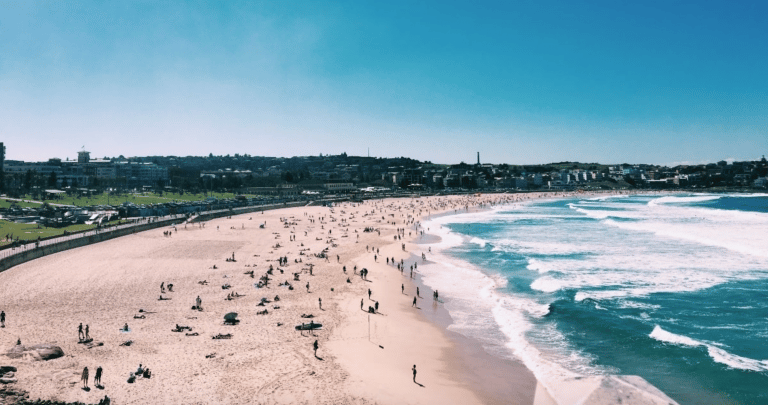
Australia, known for its stunning landscapes, vibrant cities, and unique wildlife, continues to be a dream destination for travelers worldwide. However, understanding the cost of travel in 2024 is essential for planning your trip efficiently. This article will break down the various expenses you can expect while traveling in Australia, including accommodation, transportation, food, activities, and more.
Table of Contents
Budget before coming to Australia
Plane ticket.
Airfare will undoubtedly be one of the biggest expenses before you leave. Tickets prices change constantly during the year. Thus, there are 3 main periods:
- October to February (spring/summer & Australian holidays): ≤ £1200 return (including 1 stopover, good airline and 24h travel time)
- March to June (winter): ≤ £900 return (including 1 stopover, very good airline and 24 hours travel time)
- July to September (winter/autumn & European holidays): ≤ £1100 return (including 1 stopover, good airline and 26h travel time)
Of course, you can find cheaper options if you decide to have a few more stopovers.
Passport and Driver’s licence
To travel outside the European Union, you need a passport . To obtain or renew it, it is necessary to make a request to your town hall with supporting documents. The cost of a passport (1st request or renewal) is £75.50 if you apply for it online in the UK. The application is more expensive if you apply by paper form ( £85 ).
If you already have one, make sure it is valid for at least as long as the duration of your stay.
If your driver’s licence is not in English then you will need to obtain an international licence. The process is free in general but quite lengthy so be sure to make the request well in advance. You can also use a NAATI translator to get your licence translated.
To enter Australia, you will need a valid visa. Here is a list of your visa options for a trip to Australia :
- Tourist Visa (for 3 to 12 months) (eVisitor Visa Subclass 651 / Visitor Visa Subclass 600) : Free or $145 depending on the visa.
- WHV (for 1 year) (Working Holiday Visa / Subclass 417 & 462) : $650 (can be renewed under conditions)
⚠️ Make sure you apply for a visa from the official government website .
Health Insurance
It is important to take out travel insurance in case your credit card or insurance company does not cover costs abroad. Without insurance you risk exposing yourself to the true cost of treatment outside the European zone.
Depending on the length of your stay and your trip (tourist, WHV) you will need to get the proper cover for your stay in Australia.
These insurances will cover you in the event of an accident or infectious disease. Your hospital costs, repatriation costs, accidents during the practice of certain sports (to be checked with the company), or your civil liability will be covered.
Note that some countries have reciprocal health agreement with Australia. Therefore nationals from those countries will benefit from Medicare in Australia (national healthcare system). Make sure to check this point before buying a cover.
10% discount on your insurance policy
Find here all the information you need and get your 10% Go walkabout promo code for any policy .
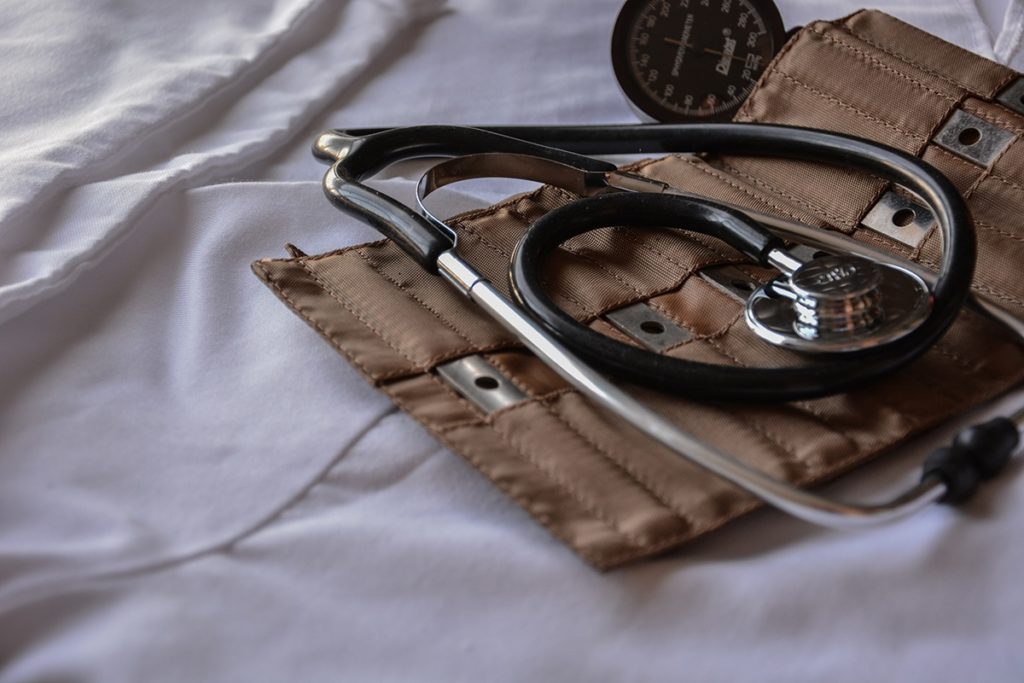
Housing / Accommodation
Depending on your preferences, housing can be one of the most affordable or most expensive expenses. Here are your options:
- Campgrounds : If you are lucky enough to be able to drop anchor in a free camp, then take advantage of it! That’s what adventure is all about, living in the great outdoors in picturesque areas! You also have the possibility to pay for a caravan park which will allow you to enjoy at least hot showers, a laundry and a kitchen corner (about 20$/night and 70$/week).
- In your vehicle : You will have to find an authorized place to spend the night.
- Youth hostels : depending on the city and the period you book, rates can vary from $40/night (dormitory of 10) to $60/night on weekends. In general, a week varies between $120 and $250.
- Wwoofing & HelpX : Great alternatives for those looking to live with locals, with free food, laundry and accommodation in exchange for a few hours of work per week.
- Housesitting : allows you to stay in someone’s home while they are away, taking care of their property and pets. It’s a popular way for travelers to save on accommodation costs while exploring different parts of the country.
- Airbnb: For an entire home/apartment count around AUD 150 – AUD 350 per night. Price will wary based on location and size. For a private room, it will be cheaper (AUD 80 – AUD 150 per night). Staying with hosts, often includes local tips.
- Flat rental : Who wouldn’t dream of a flat overlooking the beach? With a deposit of between $200 and $1000 (depending on the owner), you can expect to pay approximately $350/week in rent (with roommates) to fully enjoy your holiday!
- Hotels : Of course you also have the option of spending your nights in hotels. Budget will vary between 120$ and well up to you… depending on your preferences.
Food and Dining costs
Hello TimTam, canned food, pasta and wraps! Anything that can be kept for a long time and in all kinds of heat (well, almost). Because on a road trip, every day is a new opportunity, a new destination, so we might as well take care of what we buy:
- Weekly Cost: minimum AUD 70 per person. Shopping at supermarkets like Coles or Woolworths.
- Budget Shopping: minimum AUD 50 per person. Buying in bulk and choosing local markets.
- The gourmet budget : for those who love good food, if you wish to garnish your dishes, a minimum of 100$/week should be considered to maintain your ‘joie de vivre’ Down Under.
- Fast Food: AUD 15 – AUD 25 per meal. Quick and cheap options like McDonald’s or local chains.
- Casual Dining: AUD 35 – AUD 50 per meal. Cafes, pubs, and mid-range restaurants.
- Fine Dining: AUD 65 – AUD 150 per meal. High-end restaurants with gourmet cuisine.
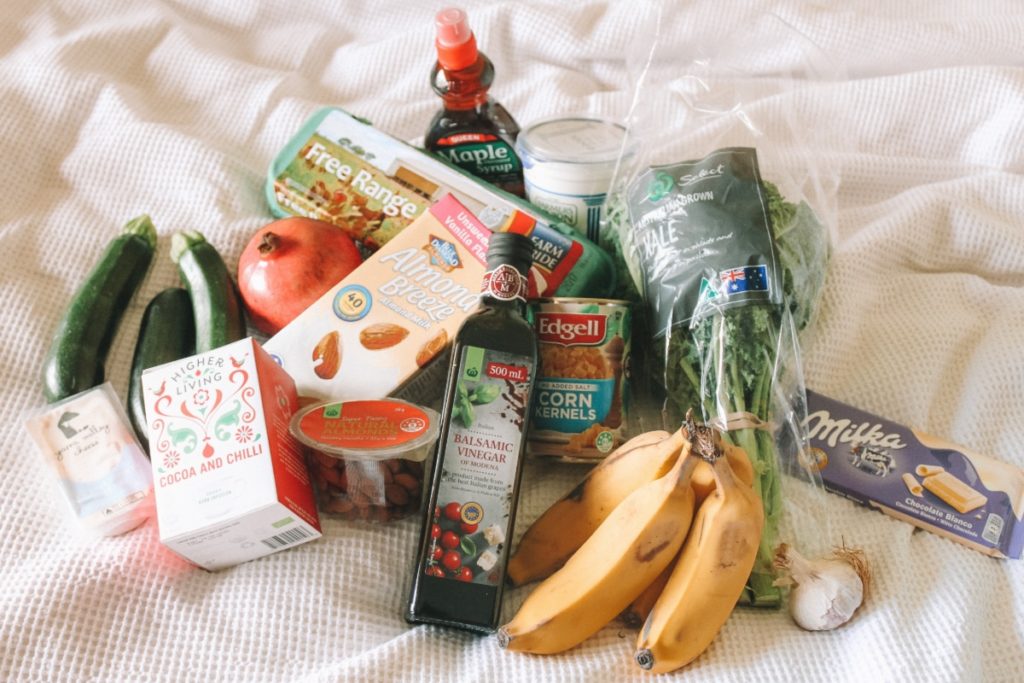
Transportation costs
Australia is a much larger continent than Europe. This means that you need to plan ahead and find the most suitable means of transport. So, here are some ideas to travel through this fabulous country:
Lifts (or carpooling)
This is an almost free way of getting around, where you contribute to the fuel costs and meet many backpackers! Recommended for those thirsty for adventure. To do this, a quick look at the Facebook groups in Australia is welcome
The network is extensive and efficient but often at the same price as the plane and the train. The two main companies are Greyhound and Premier Motor Service. For those who would mainly choose this means of transport, a Greyhound package is worth considering. In addition, here is an order of prices according to the destinations:
In general, the journey time is several hours longer and the fare is the same as that of a bus or plane. That said, it is still much more comfortable for long journeys. And there are some iconic and famous train journeys in Australia like The Indian Pacific (Sydney to Perth), The Ghan (Adelaide to Darwin) or The Overland (from Melbourne to Adelaide).
Motorbike & private vehicle
One of the best adventures you can have is a motorbike trip, but it does have a few drawbacks (exposure to the weather, minimal luggage). This is why a car remains a great option! Whether you have a 4WD, a campervan or a classic car, the road is waiting for you!
Renting a vehicle
Renting a vehicle is probably the most popular way to travel Australia . Car hire generally costs around $30 per day. For a campervan rental, you can expect to pay around $1000 for 10 days. Rates vary depending on the season and the model / equipment of the vehicle etc.
Cheap campervan hire
Find the best deals on Motorhome Republic to rent a cheap van.
Fast and affordable, it allows you to get from one end of the country to the other in a short time. So, we invite you to take a look at airline platforms such as Skycanner, to find the best flight. To get an idea, count approximately: (return ticket)
Sydney – Melbourne: $100 Melbourne – Cairns: $300 Sydney – Perth: $400 Melbourne – Alice Spring: $500 Perth – Darwin: $400
- Average Price: $1.85 – $2.20 per liter. Prices vary by region and distance from major cities.
Activities and entertainment costs
Many activities are free in Australia. Go to the beach, surf, visit cultural centres, explore the streets, markets of cities, or even climb a mountain and discover a waterfall. There are many ways to explore the country and do activities for free or a small fee. But to give you a rough idea about costs here:
- Popular Sites: $20 – $50 entry fee. Examples include Sydney Opera House tours, and Melbourne Aquarium.
- National Parks: $11 to $25 entry fee per vehicle. Fees for entry and camping.
Budget for a road trip in Australia
You want to go on a road trip, and if you have the ability, arrive with the maximum of funds in the Australia! The most important thing about a road trip is your vehicle . So how much does it cost? What should you plan for? First of all, if you want to travel to isolated places, prefer a 4WD rather than a campervan. Il will allow you to access every corner of Australia. The budget for a vehicle will depend on many things, such as the period of purchase, the vehicle you pick, the city where you purchase, its general state etc. Another option is to rent a vehicle for your road trip, it will give you the option to pick it up somewhere and drop it off in another city. It is also a great option if you are only looking for a short road trip in Australia (East coast or West coast for example).
Read also : Road Trip in Australia – Budget
Budget touring in Australia
How about sailing on the Whitsunday Islands? Or skydiving? Of course, depending on what you want and where you are, the prices will differ. Nevertheless, here are some options of tours in Australia and their costs:
- Fraser Island 3 nights & Skydiving: $600
- Seaplane flight: $250
- Whitsunday 1 day & scuba diving: $230.
- To sumarize: Day Tours: Minimum $120 but can go up to $250. Guided tours to places like the Great Barrier Reef or Blue Mountains.
- Multi-Day Tours: minimum $550 up to $1,500 (or more!). Includes accommodation, meals, and activities.
Budget for a WHV in Australia
Here is an estimate for a WHV when traveling on the roads. Expenses will be as follow:
- Purchase of a vehicle : $5000 (at least)
- Fuel : $150/week
- Food : $60/week
- WHV Cost : 650$
- Health Insurance : $400 per year
- Tour : $500 to $1000
- Activities (restaurants, bars, parties…): $150/week
- Plane tickets not counted
So count approximately $20 000 per year (can be higher or lower depending on your life style, activities etc).
Budget for holidaying in Australia
For the lucky ones who are travelling in Australia for 3 weeks just to enjoy the country, here is an idea of the budget to plan:
- Vehicle rental : $100/day
- Fuel : $120/week (depending on kms)
- Tourist visa : $0
- Travel Insurance : $200
- Tours : minimum $1000
- Food & Activities (restaurants, clubs, pubs …): $500/week
- Plane tickets A/R – $2500
Traveling in Australia in 2024 can be as affordable or luxurious as you choose. By planning ahead, understanding the typical costs, and making smart choices, you can enjoy all that this stunning country has to offer without breaking the bank. Whether you’re exploring the outback, lounging on pristine beaches, or diving into vibrant city life, Australia promises an unforgettable adventure.
See you soon on the roads!
RELATED ARTICLES MORE FROM AUTHOR
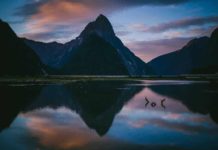
Traveling with children in New Zealand

Phone plans in Australia: Prepaid, Packages, Contracts
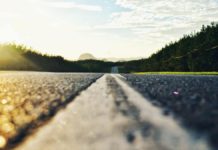
Budget a Road Trip in Australia – The East Coast in a Month
Leave a reply cancel reply.
Save my name, email, and website in this browser for the next time I comment.

Motorhome rental prices in Australia

The Coral Coast – Western Australia

- Terms of Use
- GDPR – Privacy Policy


Australia Recommends 2024

Travel Inspiration

G'day, the short film

Discover your Australia

Travel videos

Deals and offers

Australian Capital Territory

New South Wales

Northern Territory

South Australia

Western Australia

External Territories

The Whitsundays

Mornington Peninsula

Port Douglas

Ningaloo Reef

Airlie Beach

Kangaroo Island

Rottnest Island

Hamilton Island

Lord Howe Island

Tiwi Islands

Phillip Island

Bruny Island

Margaret River

Barossa Valley

The Grampians

Hunter Valley

Yarra Valley

McLaren Vale

Glass House Mountains

Alice Springs

Uluru and Kata Tjuta

The Kimberley

Flinders Ranges

Kakadu National Park

Eyre Peninsula

Karijini National Park

Great Barrier Reef

Blue Mountains

Daintree Rainforest

Great Ocean Road

Purnululu National Park

Cradle Mountain-Lake St Clair National Park

Litchfield National Park

Aboriginal experiences

Arts and culture

Festivals and events

Food and drink

Adventure and sports

Walks and hikes

Road trips and drives

Beaches and islands

Nature and national parks

Eco-friendly travel

Health and wellness

Family travel

Family destinations

Family road trips

Backpacking

Work and holiday

Beginner's guide

Accessible travel

Planning tips

Trip planner

Australian budget guide

Itinerary planner

Find a travel agent

Find accommodation

Find transport

Visitor information centres
Deals and travel packages

Visa and entry requirements FAQ

COVID-19 travel and entry advice

Customs and biosecurity

Working Holiday Maker visas

Facts about Australia

Experiences that will make you feel like an Aussie

People and culture

Health and safety FAQ

Cities, states & territories

Iconic places and attractions

When is the best time to visit Australia?

Seasonal travel

Events and festivals

School holidays

Public holidays
How to get to Australia's most iconic cities

How long do I need for my trip to Australia?

How to travel around Australia

Guide to driving in Australia

How to hire a car or campervan

How to plan a family road trip

How to plan an outback road trip

Cape Tribulation, Tropical North Queensland, Queensland © Tourism Australia
Australian Budget Guide
Manage your budget and get the most out of your trip to Australia with a bit of clever planning. Read on to learn how to calculate the cost of a trip Down Under.
Understanding how much money you need to holiday in Australia depends on a number of factors. While you can certainly live life to the luxe here, you can also enjoy a budget-friendly holiday. From finding bargain flights to making the most of free attractions, here’s everything you need to know about how much it costs to eat, sleep and stay here. And how to save a bit of money along the way!
When to book your flight

Aerial View of Sydney Harbour, New South Wales © Destination NSW
So, you’ve decided to visit Australia? Great choice! Your next decision will be picking the right time of year to book your flights. Keep in mind, Australia is on the opposite side of the world to the Northern Hemisphere, so our travel periods are the opposite as well.
Flights are going to be most expensive if you’re visiting in summer (December to February) – when the sun is shining and the summer school holidays are in full swing. If you’re travelling at this time, it’s best to book flights 10 to 12 months ahead – before planes fill up and prices climb.
If you’re planning to visit Australia outside peak periods, you’ll still want to book seven to 10 months in advance. You’ll still find plenty of sunny days in shoulder seasons and off-peak periods, and the flights can be a few hundred (Australian) dollars cheaper.
Generally, the best flight deals are offered well in advance, so the earlier the better. There are exceptions to the rule, of course, but if you’re risk-averse, then it pays to have plans in place so you’re not disappointed.
How to save money on your flights:
- Use a flight comparison site to find the best price – many have a ‘price alert’ function that will notify you when the price of flights drops.
- Visit a few different airfare search engines and input your itinerary to see which site finds the cheapest flight options.
- Speak to a travel agent who is an Aussie Specialist . They’re experts on travelling Australia and have the knowledge to help you plan and book the best options for you.
- If you’ve decided to book everything yourself, book directly through airlines. Comparison sites and search engines are great research tools, but often you get even better deals when you book through your airline of choice. Many also offer price-matching promises.
Booking accommodation

Pink Hotel, Coolangatta, Gold Coast, Queensland © Destination Gold Coast
Just like flights, booking your accommodation will partly depend on the time of year you’re visiting. There are a lot of different hotels and accommodation on offer in Australia, from free campsites to AUD$1,000+ per night luxury resorts, so availability will depend on where you’d like to stay.
If you’ve got your heart set on checking into a boutique hotel , you can expect to pay around AUD$250 per night. It’s best to book your stay well in advance – around six months for peak travel periods.
If you’re not fussed where you sleep, you can use last-minute hotel booking sites to lock in great deals just a day or two before you arrive – between around AUD$100 to AUD$200 per night. Accommodation providers don’t want empty rooms, and many offer unbeatable deals to fill them. Some sites let you set alerts, sending notifications when prices drop.
If you’re on a tight budget, there are affordable hostels all over Australia, starting from as low as AUD$20 for a dormitory bed and up to around AUD$85 per person for a private room. Most hostels have an incredible price to quality ratio – not to mention it’s a great way to make some new friends!
How to save money on your accommodation
- Avoid peak travel periods, such as summer and school holidays .
- If you have a favourite hotel chain, sign up for its newsletters to be alerted about deals and offers.
- Look for accommodation where kids stay and/or eat free. It's often a perk offered at big resorts and hotels.
- Consider sacrificing location for price. You can find great hotels with lower nightly rates just a bit further from the city centre or a few blocks back from the beach.
Explore accommodation in Australia
Activities in Australia

Jellurgal Aboriginal Walkabout tour, Queensland © Tourism and Events Queensland
Booking organised tours and travelling with guides is the perfect way to get a complete and immersive experience Down Under – you’ll be able to learn from locals, get up close to the wonders of nature and won’t need to worry about managing your own schedule. Popular day tours, like whale watching and guided walks, cost around AUD$100 to AUD$200. If you’re booking high-demand activities – such as the Field of Light or swimming with whale sharks – secure your spot at least a month in advance to avoid disappointment. However, most activities, such as surf lessons (about AUD$120) and some sporting events (from around AUD$65), can be booked closer to the day.
If you’re a frugal traveller, you needn’t miss out on anything. From internationally acclaimed museums and galleries to world-class hiking , there are free activities aplenty in Australia. With just a little bit of research, you can self-guide to exquisite beaches and secluded lookouts by taking public transport (less than AUD$10 for the day) or renting a vehicle (from around AUD$50 per day). There are even free historical walking tours in major cities (although a donation of at least a few dollars is expected).
How to save money on your activities
- Walk! With leafy streets, water views and colourful neighbourhoods to enjoy, walking is the best way to take the pulse of Australia.
- Make the most of Mother Nature. Many of Australia’s greatest wilderness areas are free to visit (though a vehicle entry fee is charged in selected national parks in most states). From trekking through the rainforest to cooling off in waterfalls, getting outdoors is the ultimate way to see the country – for next to nothing.
- Visit museums and galleries without spending a cent. Many galleries offer free entry on certain days or times. Most also have year-round free entry to permanent collections.
- Check out multi-attraction tickets and family deals . Search online or check with reception staff at your accommodation for bundle packages that offer lower rates on group and family activities .
Discover more things to do in Australia
More money saving tips

Rusty's Markets, Cairns, Queensland © Tourism and Events Queensland
- Take public transport. Australian public transport is used by practically all Aussies. It’s clean, convenient and safe to use, only costing around AUD$2 per trip compared to AUD$20–AUD$30 for a taxi or rideshare for a comparable journey. Daily caps on public transport fares apply in most major cities: you won’t spend more than around AUD$17 on a weekday in Sydney or around AUD$9 on a weekday in Melbourne . Weekend fare caps are lower still. Better yet, some public transport (such as the Melbourne city circle tram) is completely free.
- Save when eating out. Restaurant meals can cost from around AUD$20, but you can get discounts of up to 50% with sites and apps that offer deals at restaurants across the city. You can also keep an eye out for daily specials, happy hours and weeknight deals.
- Make your own meals. If you have access to a kitchen at your accommodation, try your hand at preparing some classic Aussie foods . You can shop at local markets for fresh, seasonal produce, including Australian native ingredients .
- Refuel at the cheapest petrol stations. If you’re driving around Australia, keep in mind that not all petrol stations offer the same price. The cost of filling a tank can vary from one outlet to another nearby outlet by more than AUD$10.
- Access the internet using free WiFi. You’ll find it in most restaurants, cafés, hotels, fast-food outlets, libraries and even shopping centres. There are also free public WiFi hotspots in major tourist precincts.
Disclaimer: Costs outlined in this article are a guide only. Please check with the provider for actual prices.
More articles like this

We use cookies on this site to enhance your user experience. Find out more . By clicking any link on this page you are giving your consent for us to set cookies.
Acknowledgement of Country

We acknowledge the Traditional Aboriginal and Torres Strait Islander Owners of the land, sea and waters of the Australian continent, and recognise their custodianship of culture and Country for over 60,000 years.
- International (English)
- New Zealand (English)
- Canada (English)
- United Kingdom (English)
- India (English)
- Malaysia (English)
- Singapore (English)
- Indonesia (Bahasa Indonesia)
- Deutschland (Deutsch)
- France (Français)
- Italia (Italiano)
- 中国大陆 (简体中文)
*Product Disclaimer: Tourism Australia is not the owner, operator, advertiser or promoter of the listed products and services. Information on listed products and services, including Covid-safe accreditations, are provided by the third-party operator on their website or as published on Australian Tourism Data Warehouse where applicable. Rates are indicative based on the minimum and maximum available prices of products and services. Please visit the operator’s website for further information. All prices quoted are in Australian dollars (AUD). Tourism Australia makes no representations whatsoever about any other websites which you may access through its websites such as australia.com. Some websites which are linked to the Tourism Australia website are independent from Tourism Australia and are not under the control of Tourism Australia. Tourism Australia does not endorse or accept any responsibility for the use of websites which are owned or operated by third parties and makes no representation or warranty in relation to the standard, class or fitness for purpose of any services, nor does it endorse or in any respect warrant any products or services by virtue of any information, material or content linked from or to this site.
Australia Trip Cost: Flights, Food & Hotel Pricing
Plan your Australia trip with our comprehensive guide on flight, food & accommodation costs. Get tips on budgeting for an unforgettable experience.
Australia is famous for tropical beaches, wide-country spaces, Aboriginal culture, and lush rainforests. The country has so many beaches that it will take 27 years to visit, one per day. However, you'd want to know what a visit will cost you before you visit.
A one-week vacation in Australia costs an average of $2579 per person, including $1200 for your return flight. A solo traveler will spend an average of $197 per day on expenses. This average cost includes food, accommodation, local transportation, and other activities throughout your stay in Australia.
Australia is large and expensive, but it offers visitors much value. The rest of the article will provide a detailed breakdown of travel costs. Read on also to find tips on how to save money vacationing in Australia.
How Much Money Should You Take For A 7-Day Trip to Australia?

Accommodation, food and drinks, and tours are the big spenders after flight tickets. A reasonable amount of money you need to take on a 7-day trip to Australia is around $2,579-$3,000 .
This average amount should cover your round trip and afford you mid-range accommodation. Mixing up your eating styles by eating out a few nights and cooking some meals yourself is also more affordable.
Tours are expensive in Australia, and the least amount you can spend is $92.81 for the barrier reef snorkel tour. Budget spenders can always opt for other sightseeing activities such as a $15 surfing museum, a $65 surf lesson, and a $23 Sydney tower visit.
Intercity travel alone can be as expensive as $150. However, you can save by focusing on one city at a time. You can take advantage of some free activities like visiting the beach, the Sydney opera house, and botanical gardens.
Traveling To Australia On A Budget

You can take a 7-day trip to Australia on a budget of $1050, but this comes with several lifestyle changes. If you can soldier through the inconveniences of taking standby flights, you can get a round trip to Australia for around $621.
Take advantage of Australia's dense network of campgrounds for lodging. There are free campsites all over Australia, and most of them are budget friendly . These camps have basic facilities and are mostly located in areas with relatively low costs of living.
Pick campsites in central locations so you can easily walk to the beaches. If traveling with friends, you can rent a campervan for between $100-$200 per day to visit more scenic locations.
Basic Expenses On A Vacation To Australia
Before packing your bags for an Australia trip, creating a detailed budget for everything you'll need to spend on your trip is crucial. To enable you to create an accurate budget, here's an item-by-item breakdown of everything constituting the total cost of your Australia trip.
1. Flight Tickets

Flight tickets are one of the most significant expenses on your journey, taking away a substantial chunk of your budget. The price of flight tickets may vary depending on several factors, such as the peak season, the day of the flight, and booking in advance.
The average cost of a round trip to Australia is $1200. However, this cost increases to $2100-$2900 from late December to January and decreases to $1100-$1200 from late August to early September . Collected data shows that Tuesdays are the cheapest days to fly to your destination and back.
Many travelers found that booking their flights at least 60 days before departure is cheaper than booking within 72 hours. Australian flight tickets are expensive because of the limited number of airlines and the lack of competition.
2. Accommodation

Accommodation is right on the heels of your flight tickets, also contributing significantly to your travel costs. Australia has a range of accommodation styles, such as hostels, hotels, Airbnbs, and vacation rentals.
Hostels are mainly found on the East Coast and include several options for different budgets. There are 12- bed shared dorms that cost between $25-$50 or ensuite rooms and private rooms for a slightly higher budget .
Hotels also offer different styles for different budgets. From the real-life experiences of many travelers, the average cost of a 1-star hotel is $50. 2-star- 5-star hotels cost $70, $80, $120, and $240, respectively.
Airbnb and vacation rentals offer a unique and comfortable option. They cost hundreds of dollars, from $100 to $1000 above. Although this is the most expensive option, they typically offer top-notch facilities to make your stay as comfortable as possible.
The prices of accommodation fluctuate with the city, length of stay, and season of visits, such as Christmas or New year. You can always cut the overall cost of accommodation by not ordering your meals from your hotel.
Related Read: Does it Snow in Australia?

As usual, food in Australia serves every budget, but the cost of a single meal will depend on your eating style. For example, eating out in some restaurants can be more expensive than cooking, and fine dining is usually more expensive than fast/street food.
Breakfast is cheaper than lunch and dinner, and some restaurants offer meal deals and discounts. The average breakfast cost is $20, while the main meal has a mid-range of $25-35 or an upper range of $35-$45. On the other hand, a MacDonald's meal costs just about $5-$7 .
Alcohol is costly in Australia because the government heavily taxes alcoholic drinks. The average beer cost in a bar is $5-$8, a glass of wine is $10 above, and cocktails cost $15. However, you can buy a box of Goon at $10-$15 if you don't mind cheap boxed wine.
4. Transportation

Australia is a country and a continent that is considered the most significant island and sixth largest country on earth. Its large cities and structures mean that it has several tourist attractions and beautiful sightseeing locations.
Taxis are more expensive than public transportation, and car rentals are also available . Here are all the options available to you and what you can expect to pay for each.
- Taxi: Transportation is cheaper in smaller cities like Melbourne and expensive in bigger cities like Sydney. The average cost of a 20-minute taxi ride is $21.20 in Melbourne and $27.70 in Sydney. The waiting time is $34.00 in Melbourne and $56.68 in Sydney.
- Public Transportation: Although public transportation is cheaper than taxis and car rentals, the fares are still pretty expensive. Australia is the second country in the world with the highest public transit at $104.52 per month. A single bus fare in Sydney is around $1.39-$2.99.
- Trains: The Ghan and Indian Pacific provide train services between Australian cities. The Ghan travels between Adelaide and Darwin, while the Indian Pacific travels between Sydney and Perth. The average single train fare is between $2.32-$5.76.
- Ferries: Several ferries connect locations along Sydney harbor, Swan River in Perth, and Brisbane River. The single average fare of a ferry is between $3.98-$4.97
- Greyhound Buses: The most popular transportation network covering the East Coast, Red center, Northern Territory, and parts of the West Coast. This bus network offers unlimited travel for up to 30-90 days within a limited time frame. The average bus fare for a 7-day vacation is around $199.
- Car Rentals Services: Renting a car will enable you to explore the many attractions and avoid the limitations of other means of transportation. The average cost of car rentals is $35 per day and depends on the location, the type of car, and your booking four weeks in advance. Since the requirements are not uniform in all areas, remember to make inquiries. For individuals looking for a convenient way to travel around Australia, considering a private jet charter with The Air Charter Group might be a good choice. This service provides comfort and luxury, while also helping to save time that you might spend dealing with the schedules and crowds associated with commercial flights. Particularly useful for those wishing to explore multiple locations across Australia's extensive territory, opting for a private charter could enhance your travel experience, giving you more time to enjoy the beautiful destinations in Australia and less time traveling.
- Travel Insurance: Travel insurance when going overseas is as essential as breathing. In the event of an accident or getting robbed, you will prevent yourself from significant financial loss with travel insurance. There's no fixed price; therefore, compare quotes from different agencies to get the best price.
Also, if you're planning to take long road trips, you may want to consider getting comprehensive car insurance from a company like ROLLiN' to give you peace of mind when on the road.
Related Read: 25 Fun Things to Do on a Long Flight

Australia has an extensive network of tourist attractions that are impossible to avoid. Some favorite big-name travel spots include the Sydney harbor bridge, the Great Barrier reef, dolphin kayaking, etc.
Taking tours around the big-name travel spots can get pretty expensive, costing several hundred dollars per tour . The following list will give an idea of how costly these tours can be.
- A tour of the Sydney harbor bridge costs $243.95
- A snorkeling tour at the great barrier reef costs $92.81
- Fraser Island 4×4 tour costs $310.91
- The Budget open dive boat costs $460.73
Tips To Save Money On Your Australia Trip
Australia is a tourist haven with its beaches, deserts, and rainforests. It is a vast land so large it has three times more sheep than people, which makes it expensive.
However, visiting Australia doesn't have to be as costly as you think, especially when you know what costs to avoid and what costs not to. Here's a brief review of some money-saving tips to help you save money on your next trip to Australia.
1. Travel Off-Peak Season

You will save a lot of money when you plan your trip away from Australia's peak season. Australia is not a summer destination because there's competition for flights and accommodation, which makes the rates go high.
Fall (March to May) and winter (June to August) are the best time to visit Australia. During this period, flights are cheaper, and hotels offer the lowest price on accommodation, especially in June . Even with the snow in some areas, you will still enjoy Australia's vast deserts, waterfalls, and beautiful beaches.
2. Take Self-Guided Tours

There are free attractions like the botanical gardens, the Sydney opera house, and the beaches. Australia is also easy to navigate, with car rentals to the Northern Territory Outbacks for as low as $25. While there, visit Katherine to see interesting sights like the Jatbula trail, limestone cutta cutta caves, and hot springs.
The Gippsland lakes are over 600 square kilometers of lakes, lagoons, and marshes with exotic bird species, koalas, and dolphins. Swimming and fishing at Agnes Falls, Toorongo, and Amphitheater Falls are great tourist activities. Hutt lagoon is a stunning lagoon that changes colors from soft pink to lilac and sometimes red.
You can also rent a car for $52 a month to visit Fraser Island, the largest sand island. Or you can drive down from Cairns to the lush Daintree rainforests for $35 a month. There are several more tourist attractions, and all you need to do is look out for deals on car rentals .
3. Try Walking

Australia has many well-maintained footpaths along coastal cliffs, urban laneways, and parklands you explore. Some of the world's longest tracks and trails are in Australia .
Tasmania is a world heritage-listed wilderness; you can explore the overlands there. Or you can explore the Northern Territory through the Larapinta trail across the West MacDonnell ranges.
4. Cook Your Meals

Food prices in Australia take out the bulk of your money. Cooking your meals will save you a great deal of cash, especially when you stay in hostels.
Go shopping at supermarkets to get the best deals out of your shopping. The best time to shop is at the end of the day when supermarkets offer up to 50% discounts, especially on fresh products . Local markets also offer good product deals towards the end of the day.
Sydney, Melbourne, and Hobart organize "giving away food" events cooked from unsold products at supermarkets. You can attend these events to get a free meal.
5. Book Your Flight in Advance

No matter your destination, booking your flight 1-3 months from your journey is a great way to save money. When making travel arrangements, remember that traveling midweek to Saturday is usually cheaper than Sunday to Mondays.
Always remember to change your browser to incognito when booking your flight. Websites use cookies that can tell you just checked flight prices, increasing costs . Finally, book accommodation, tours, and other services in advance to ensure you get cheaper deals.
Tobi Miles is a University of Florida graduate turned globe-trotting culinary explorer and digital nomad expert. As the founder of "Bytes & Bites," he combines his passion for international cuisine with practical advice on remote work, inspiring others to experience the world through food and cultural immersion. With 32 countries under his belt and a knack for uncovering hidden culinary gems, Tobi is redefining the intersection of work, travel, and gastronomy for a new generation of adventurers.
Recommended Reads
Trending reads.

UK Travel Budget Calculator
Plan your UK trip with ease! Use our Travel Budget Calculator to manage costs across cities like London & Manchester. Ideal for all travelers.

Italy Travel Budget Calculator
Plan your Italian getaway with our Travel Budget Calculator! Find costs for Rome, Tuscany, and more. Ideal for families & solo travelers. Click for details.

Budget Ibiza: Cost Calculator & Money-Saving Tips
Plan your Ibiza trip on a budget! Use our cost calculator & get top tips for saving money on flights, clubs & more. Ideal for savvy travelers to Ibiza.
Your trusted source for travel guides, tips, and insights since 2020. Empowering adventurers with expert advice for smarter, more rewarding journeys.
- Car Rentals
- Airport Transfers
- Attractions & Tours
- Flight + Hotel
- Destinations
- Trip.com Rewards
Australia Travel Cost: How Much to Budget for an Unforgettable Adventure - Trip.com

by Trip.com
February 28, 2023
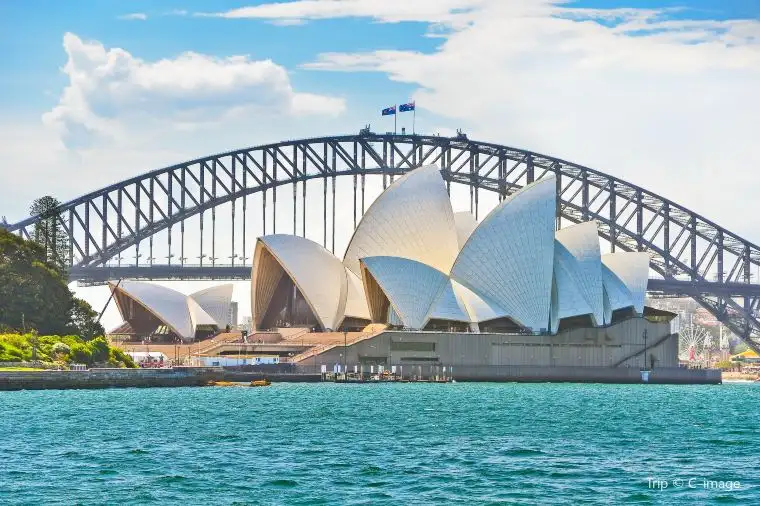
Sydney Attraction - Sydney Opera House / Source: Trip.com
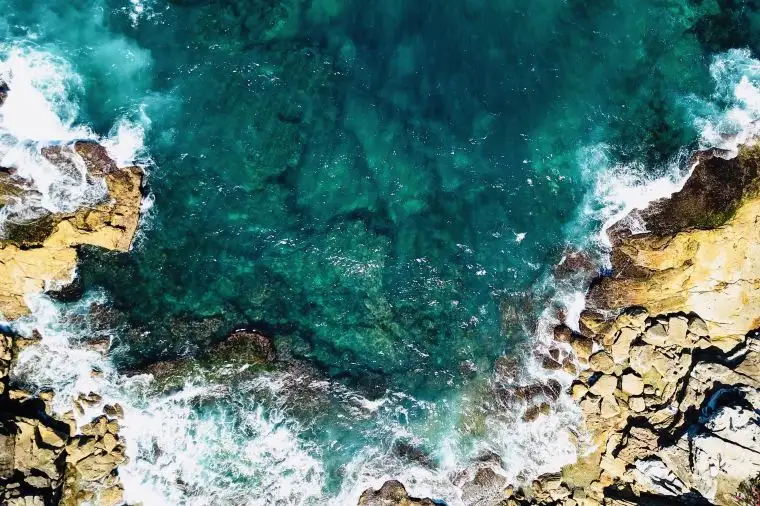
Sydney Attraction - Bondi Beach / Source: Trip.com
Australia Travel Cost Overview
Generally, you can expect to spend around AU$1,400 (USD $945) for a 7-day trip to Australia, including the cost of accommodation, transportation, food, sightseeing, and car rental.
** Note: Actual costs may vary depending on individual preferences and travel choices. **
- Flying from Nashville: tickets for around $2,383 one-way or $2,281 round-trip.
- Leaving from Boston: tickets for around $1,393 one-way or $2,497 round-trip.
- Flying out of Chicago: tickets for around $1,521 one-way or $2,629 round-trip.

Sydney Tower Eye / Source: Trip.com
👉 Of course, these prices are just estimates, so it's always a good idea to do your own research and shop around for the best deals. But hopefully, this gives you a rough idea of what to expect when it comes to the cost of flights to Australia.
Flights from New York to Sydney ✈️

- Sort by: Lowest Price
- Sort by: Earliest Flight

Crossed out prices are calculated based on the average price of the corresponding route on Trip.com.
Flights from Los Angeles to Sydney ✈️

Useful information about Flights to Australia ❗️❗️
- Los Angeles to Sydney takes 15 hours direct and just shy of 16 hours to Melbourne
- Dallas to Sydney takes 17 hours, while Houston to Melbourne is 20.5 hours
- Most international flights to Australia arrive at major airports in Sydney, Melbourne, or Brisbane.
- Australia's peak travel season is December to February, so expect higher ticket prices and more crowded airports during this time.
How to save money on flights?
- Compare flight times and airlines to find the cheapest overall option.
- Book your flight 12 weeks in advance to get the best deals.
- Join an airline loyalty program to earn rewards and discounts.
- Use airline miles or credit card points to travel at discounted prices .
- Take advantage of AARP membership to save up to $65 per person, per round-trip in economy
Accommodations
** Note: Prices may vary depending on location, season, and availability. **
Best Hotels in Sydney 🏨
Hilton sydney, meriton suites kent street, the fullerton hotel sydney, sofitel sydney darling harbour, radisson blu plaza hotel sydney, business travel, sofitel sydney wentworth, the tank stream sydney, an evt hotel, mercure sydney liverpool, rydges north sydney, mantra parramatta, family friendly, yehs hotel sydney qvb, amora hotel jamison sydney, meriton suites sussex street, nomads sydney, yehs hotel sydney harbour suites, best hotels in melbourne 🏨, stamford plaza melbourne, grand hyatt melbourne, next hotel melbourne, curio collection by hilton, w melbourne, hyatt centric melbourne, atlantis hotel melbourne, crowne plaza melbourne, an ihg hotel, brady hotels central melbourne, intercontinental hotels melbourne, an ihg hotel, hotel grand chancellor melbourne, ibis melbourne central, ibis styles kingsgate hotel, novotel melbourne on collins, doubletree by hilton melbourne, jasper boutique hotel, transportation, how to save money on transportation.
- Another way to save money is to book hotel rooms for peak season in advance. This can help to get rooms for AU$150 to AU$250 in posh hotels.
- Alternatively, you can seek other options such as camping or hostels for accommodation. This can help to save money.
- You can also get an Opal Card which is free and can be purchased at the airport, train stations or any newsagent shop.
Sightseeing and Attraction Ticket
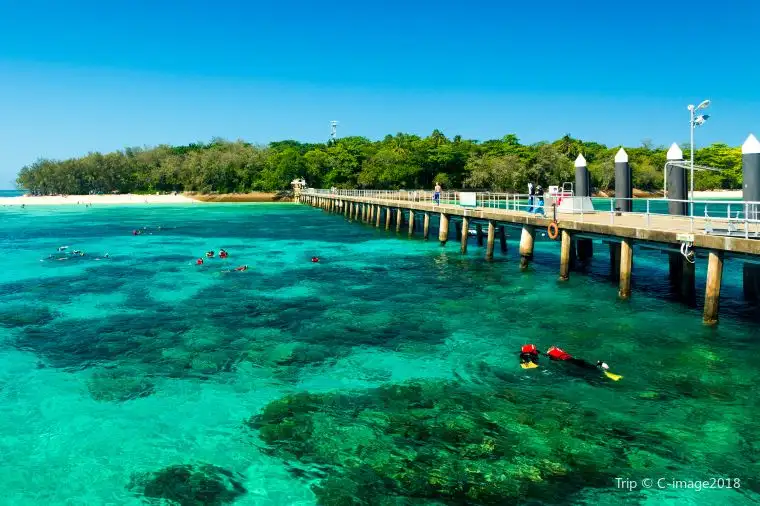
Cairns Attraction - Green Island / Source: Trip.com
Must-go Attractions in Australia 📍
>> SEA LIFE Sydney Aquarium Admission Ticket
>> Sydney Tower Eye Admission Ticket
>> 【Melbourne Attraction】Werribee Open Range Zoo Admission Ticket
How to save money on sightseeing in Australia 😳 ?

Sydney Attraction - Darling Harbour / Source: Trip.com
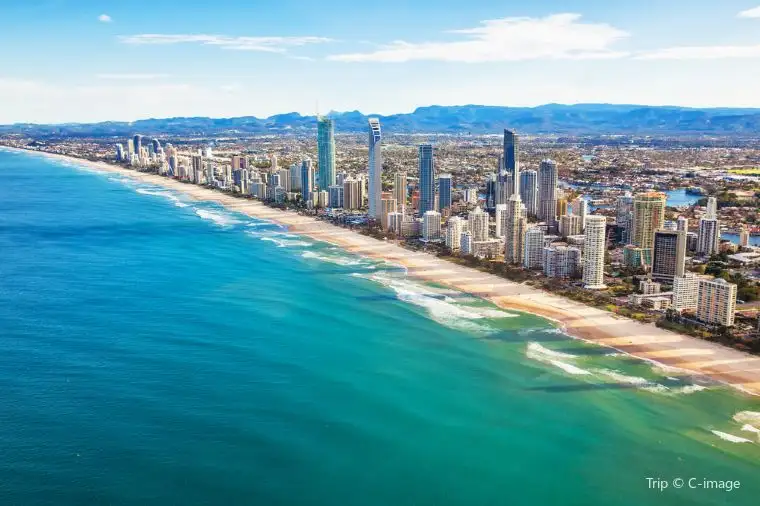
Gold Coast beach / Source: Trip.com
Wi-Fi and Communications
- Optus WiFi plans start as low as $45 per month
- Exetel's Everyday NBN Broadband Plan is $53.95 per month for the first 6 months and then $64.95 ongoing
- Aussie Broadband, Vodafone, iiNet, Kogan, iPrimus, and Telstra offer plans with higher speeds, such as NBN 250 or NBN 1000, for a higher cost
Trip.com SimCards

Prepaid Voice and Data simcards / Source: Trip.com
The best ways to buy cheaper souvenirs
- Australia's No. 1 Souvenirs & Gift Store
This store offers a variety of souvenirs at affordable prices, such as Kangaroo Clasp Pins for $12.99, Traditional Boomerangs for $24.99-$29.99, Cling Koalas With Vest 12 Pack for $9.99, Dot Kangaroo Black Folding Shopper Bag for $5.99, and Green & Gold Australia T-Shirt for $24.99.
- Shop at local markets
Local markets are a great place to find unique and affordable souvenirs. You can often find handmade items like jewelry, art, and crafts that are not available in tourist shops. Markets like the Queen Victoria Market in Melbourne and the Rocks Market in Sydney are great places to start.
- Buy from discount stores
Discount stores like Kmart, Target, and Big W offer a range of souvenirs at affordable prices. You can find items like t-shirts, keychains, and magnets with Australian designs at a fraction of the cost of souvenir shops. Look for stores near popular tourist areas.
Travel Insurance
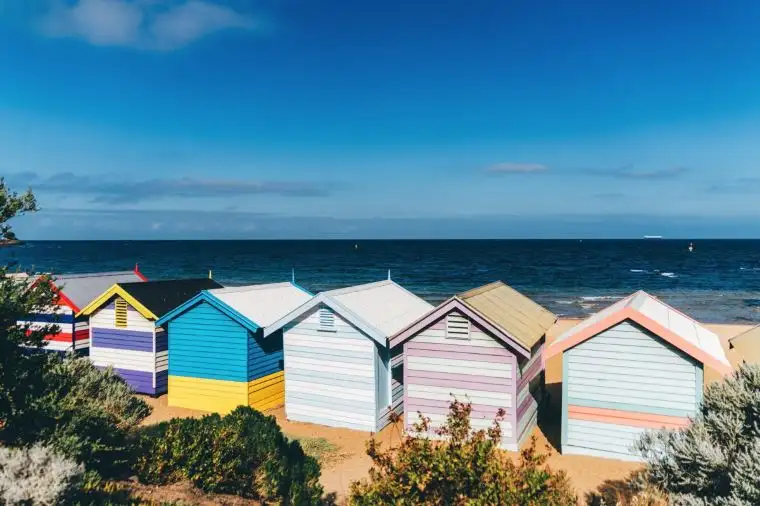
Brighton beach / Source: Trip.com
Why do you need travel insurance when traveling to Australia?
- Medical Emergencies
- Trip Cancellation
- Baggage Loss

Travel insurance / Source: Anete Lusina @ unsplash
How much does travel insurance cost when traveling to Australia?
- Factors that affect travel insurance cost
- Sample costs for travel insurance to Australia
Here are some sample costs for travel insurance to Australia:
- A 30-year-old traveler taking a two-week trip to Australia with basic coverage can expect to pay around $50-$80.
- A 50-year-old traveler taking a four-week trip to Australia with comprehensive coverage can expect to pay around $200-$300.
Travel Tips
Plan your itinerary
- Australia is a large country with many destinations to explore, so it's important to plan your itinerary in advance. Research the places you want to visit and the activities you want to do, and allow plenty of time to get around.
Prepare for the climate
- Australia has a diverse climate, with hot summers and mild winters in the north, and cooler temperatures in the south. Be sure to pack appropriate clothing for the climate, including a hat and sunscreen to protect yourself from the strong Australian sun.
Take out travel insurance
- As mentioned earlier, it's important to take out travel insurance to protect yourself from unexpected events such as medical emergencies, trip cancellations, and baggage loss. Compare policies and choose one that suits your needs and budget.
Respect the culture
- Australia has a rich and diverse Indigenous culture that should be respected. Learn about the local customs and traditions, and be mindful of cultural sensitivities.
Be aware of wildlife
- Australia is home to a range of unique and often dangerous wildlife, such as snakes, spiders, and crocodiles. Be aware of your surroundings and follow any warning signs or advice from locals.
Get a local SIM card
- If you plan on using your mobile phone while in Australia, consider getting a local SIM card. This can save you money on roaming charges and allow you to stay connected with friends and family back home.
Use public transport
- Australia has a good public transport system, including buses, trains, and trams. Using public transport can be a cost-effective way to get around, and it can also help you avoid the stress of driving in unfamiliar places.
Try the local cuisine
- Australia is known for its diverse cuisine, from fresh seafood to hearty pub grub. Be sure to try some of the local specialties, such as meat pies, fish and chips, and kangaroo meat.
Enjoy the great outdoors
- Australia has some of the most beautiful natural scenery in the world, including stunning beaches, rugged mountains, and ancient rainforests. Be sure to spend some time exploring the great outdoors and taking in the natural beauty.
Be prepared for emergencies
- Finally, it's important to be prepared for emergencies while traveling in Australia. Have a plan in place for what to do in case of an emergency, and make sure you have the necessary contact information for local authorities and emergency services.
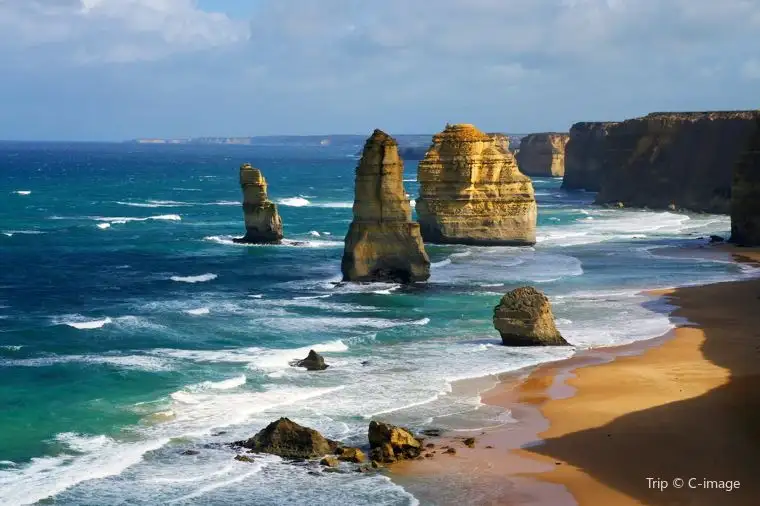
Twelve Apotles / Source: Trip.com
Looking to get the best deal on your next travel booking? Look no further than Trip . com ! With a wide range of flights, hotels, and vacation packages to choose from, you're sure to find the perfect option to suit your budget and preferences. Plus, with their user-friendly website and mobile app, booking your next adventure has never been easier. So what are you waiting for? Visit Trip.com today to start planning your next getaway!
How much does it cost to travel to Australia?
The cost of traveling to Australia varies depending on factors like the time of year, type of accommodation, and activities. Generally, a basic daily budget for backpackers is $70-$100 AUD, mid-range travelers should budget $150-$250 AUD per day, and luxury travelers should expect to spend over $400 AUD per day.
What is the cheapest time to travel to Australia?
The cheapest time to travel to Australia is typically during the low season, which runs from May to August. During this time, flights and accommodation tend to be cheaper, and crowds are smaller.
How much should I budget for flights to Australia?
The cost of flights to Australia varies depending on your departure location and the time of year you plan to travel. On average, travelers from the United States should expect to pay $800-$1,500 USD for a round-trip ticket.
How much does accommodation cost in Australia?
The cost of accommodation in Australia depends on the type of accommodation and its location. Budget hostels typically cost $20-$40 AUD per night, while mid-range hotels cost $100-$200 AUD per night. Luxury hotels can cost over $400 AUD per night.
What are some ways to save money while traveling in Australia?
To save money while traveling in Australia, consider using public transportation, cooking meals instead of eating out, and staying in budget-friendly accommodations like hostels or camping grounds.
Australia Travel Cost
- 2. Accommodations
- 3. Transportation
- 4. Sightseeing and Attraction Ticket
- 5. Wi-Fi and Communications
- 6. Souvenir
- 7. Travel Insurance
- 8. Travel Tips
- 9. Conclusion
<h3>Trending Searches</h3>
Popular Content
- Black Myth Wukong Actual China Locations
- trip to Antarctica cost
- weekend getaways in tennessee
- trip to Goa cost
- weather in Japan in April
- Trip to Romania cost
- things to do in chicago
- Climate in South Korea
- amsterdam trip cost
- Trip to Madagascar cost
- trip to Jerusalem cost
- weekend getaways from nyc
Popular Attractions
- Gardens by the Bay Tickets
- tokyo disneysea tickets
- Universal Studios Hollywood Tickets
- Gardens by the Bay
- Hangzhou Wave Water Park
- Okashigoten Onna Branch
- Chengdu Research Base of Giant Panda Breeding
- Aquaria KLCC
- hong kong ocean park tickets
- universal studios japan tickets
- Ngong Ping 360 Tickets
- Van Gogh Museum Tickets
- Universal Studios Beijing Tickets
Connectivity
- eSIM Vietnam
- Pakistan esim
- Greece eSim
- New Zealand SIM Card
- eSIM Thailand
- China eSIM 2 Days
- eSIM Hong Kong
- Hong Kong eSIM 1 Day
Getting Around
- Don Mueang Airport to Bangkok
- narita express
- Incheon International Airport to Seoul
- Keisei Skyliner
- Haneda Airport to Tokyo
- Shanghai Airport Transfer
- Gimpo Airport to Seoul
- Customer Support
- Service Guarantee
- More Service Info
- About Trip.com
- Terms & Conditions
- Privacy Statement
- About Trip.com Group
Other Services
- Investor Relations
- Affiliate Program
- List Your Property
- Become a Supplier
- Destinations
- Travel Guides

How much does a trip to Australia cost?
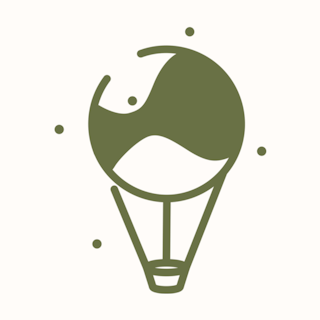
Faraway Worlds
- Australia travel budget
If you’re planning on travelling to Australia, you’re probably wondering how much you need to budget for your trip. While your travel costs will depend on your travel style, generally speaking Australia is best for travellers with some spending money.
Accommodation costs are generally on the high side and food and drinks are relatively expensive. Many of Australia’s best attractions are very affordable or even free and, while some activities could set you back a fair amount, there’s plenty to do at lower price points too.
How much should I budget for a trip to Australia?
A reasonable budget for two for a week in Australia is around A$2,589 .
The above cost is based on staying in good, mid-range accommodation and having a few meals out per week, while preparing some yourself . It makes allowances for a couple of sightseeing activities, but doesn’t take into account expensive activities like adventure sports or private tours.
Generally speaking, the longer you travel, the cheaper it costs per day, while fly-in, fly-out trips can be more expensive.
How much does accommodation cost?
You can expect to spend between A$160-A$250 a night, per couple, on accommodation in Australia. This will get you a private room with your own bathroom in a 3-4-star hotel or apartment rental.
Hostels are, of course, cheaper, but a private room with a shared bathroom will still cost around A$90 per night. A bed in a dorm room also averages around A$30 per night, per person, although there are definitely cheaper options out there.
How much should I budget for food and drinks in Australia?
Budget to spend around A$750 for two for a week in Australia. This assumes you’re cooking some of the time and drinking some alcohol.
If you enjoy eating out, you can expect to pay around A$93 for a nice dinner for two, including an alcoholic drink. A meal at a pub is likely to be around A$57 for two, with cheaper meals available (especially for lunch) for around A$18 each.
Assuming that you’ll be eating out some of the time, budget at least A$85 a week for groceries. If you enjoy a few drinks, you’ll need to increase this amount – beer costs around A$6 for a 500ml bottle and good bottle of wine is around A$17 , from a shop, although there are cheaper options available. Milk typically costs around A$2 for a two-litre bottle and you can expect to pay around A$5 for a cappuccino from a local café.
How much does it cost to get around Australia?
Getting around Australia is easiest with a car. Transport costs fluctuate depending how much you travel, but budgeting around A$330 for two per week is a good starting point. This should allow you to hire a cheaper rental car. If you’re planning on doing any tours or using hop-on hop-off buses, you’ll need to up your budget a bit.
While you need a car to explore the country, the major cities have very good public transport networks. If you'll be in a city for more than a day or two, it's worth picking up the local public transport card to help make travelling around more affordble.
What should I expect to spend on activities?
A lot of the best things to do in Australia are free. However, there definitely are some attractions that cost money – entry fees to a museum or an art gallery are usually around A$20 - A$40 per person. If you want to do organised day trips or join smaller tour groups to learn more about some of the sites, budget around A$160 per activity per person.
Australia is a beautiful destination to visit and although it’s not cheap, it’s definitely possible to travel there for less. Cooking your own meals, carefully selecting accommodation or limiting meals out will definitely help you to reduce your travel costs. Slow travel is another great way to help your budget to stretch further, while exploring a place in more depth.
Travelling through Australia is definitely possible on a budget – just pick your priorities and compromise on the rest or consider travelling in the off-season and avoiding school holidays to cut down on costs. And, if you’re on the luxury end of the scale or wanting to treat yourself, the sky’s the limit.
Share this article
Last Updated 16 December 2021


Australia Travel Guide
Last Updated: August 27, 2024

Australia is one of the most popular travel destinations in the world. It’s known as a major backpacking, camping, road tripping, and diving destination.
Backpacking Australia is considered a “must do” for backpackers. It’s a central highlight on the round-the-world trail. I started coming to Australia in 2008 as a backpacker. It hooked me and, since then, I’ve visited over five times and have crisscrossed the country three times. Every single trip I discover something new about this country to love.
But this isn’t just a country for backpackers. Its huge diversity means every traveler can find something they love here.
Australia is filled with incredible natural beauty: Uluru and the Outback, rainforests and pristine white sand beaches, and of course, the Great Barrier Reef. Sydney’s Harbor Bridge and Opera House are iconic man-made wonders, and Melbourne’s café culture will make you feel like you’re relaxing in Europe . You have surfing, hiking, camping, boating, and a ton of other activities available to you. It makes some of the best wine in the world. Australia has it all.
However, the country’s size and limited transportation options, makes it hard to get around. And it’s not the cheapest place to visit, even if the currency is a tad weak right now.
Fortunately, this extensive Australia travel guide will show you how to save money, plan your trip, and make the most of your time Down Under. Because this country is worth taking the time to explore – and doesn’t need to cost a fortune!
Table of Contents
- Things to See and Do
- How to Stay Safe
- Where to Stay
- Typical Costs
- Suggested Budget
- Money-Saving Tips
- How to Get Around
- Best Places to Book Your Trip
- Related Blogs on Australia
Click Here for City Guides
Top 5 things to see and do in australia.
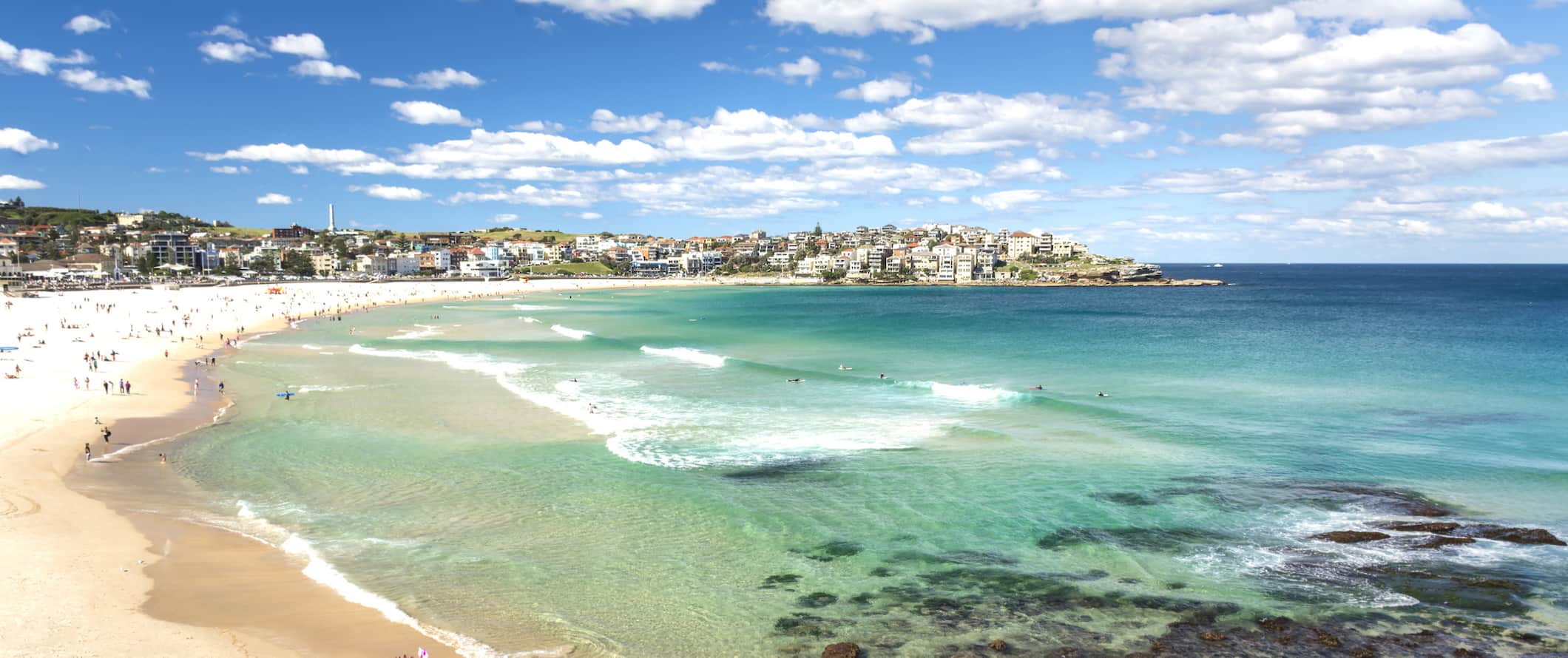
1. See Sydney
Australia’s largest city has a range of activities to keep you busy. Climb the Sydney Harbour Bridge, surf at Bondi Beach, party in King’s Cross, sail across the harbor, visit the Opera House, and take in world-class innovation in Darling Harbor. There’s a ton to see and do here and it’s worth spending a few days here to soak it all in. Other popular beaches nearby include Manly (wide and beautiful), Bronte (small and quiet), Coogee (fun), Palm (chill), and Dee Why (surfing). And, if you’re feeling adventurous, tours that climb the iconic (and massive) harbor bridge cost 250 AUD.
2. Visit Uluru
This beautiful red rock formed over 550 million years ago. Tourists have been visiting the rock since the 1930s and it’s of great spiritual importance to the local Aboriginal peoples. Formerly known as Ayers Rock, the best way to visit is by going as part of a multi-day tour of the area or driving on your own. You’ll be able to walk around the rock, learn about its cultural importance, and watch the rising/setting sun splash against it. Admission is 38 AUD per person and is valid for three days. Note: Climbing on the rock is prohibited.
3. Dive the Great Barrier Reef
Don’t miss diving or snorkeling the Great Barrier Reef. It’s the largest living organism on Earth, spanning some 344,000 square kilometers (133,000 square miles). The reef is brimming with wildlife, including giant clams, manta rays, sharks, turtles, clown fish, and more! Cairns is the most popular jumping-off point for dive trips to the reef. I was blown away by the abundant wildlife and coral. It did not disappoint! Dive trips start around 230 AUD.

4. Explore Melbourne
Melbourne is much more relaxed than Sydney (and, personally, I like it more). This is the place to relax by the river, walk through the city gardens, eat amazing food, enjoy the art, and party in St. Kilda. It’s a fun, chill city with a youthful vibe and a ton of backpackers.
5. Sail the Whitsundays
The Whitsunday Islands are a collection of 74 islands off the central coast of Queensland. They’re one of the most popular destinations in the country. It’s a popular region for sailing trips and since the vast majority of these islands are designated national parks, you’ll find numerous pristine beaches and dive sites here. It’s a postcard-perfect region. Expect to pay between 399-499 AUD per person for a three-day/two-night sailing trip. While expensive, it’s worth doing (I loved my trip).
Other Things to See and Do in Australia
1. explore fraser island.
The world’s largest sand island is a popular spot for camping, swim, hike, and seeing dingoes. You can hire your own 4WD car or take an overnight tour through the island that’s famous for its freshwater lake (and dingoes). The island is beautiful and filled with lakes, hiking paths, and sweeping vistas. Sadly, you can’t go in the water nearby as it’s rough and full of sharks, but there’s plenty of fishing, cool sand dunes, the stunning 75 Mile Beach, and a cool shipwreck for snapping photos. Camping on the island is super cheap too (less than 10 AUD per night!).
2. Visit Cairns
Cairns is Australia’s gateway to northern Queensland. From here you can visit the Great Barrier Reef, the Daintree rainforest, the Atherton Tablelands, Cape Tribulation, and much more. Cairns is a pretty typical tropical city and life here focuses on taking the time to smell the roses. With so much to see, the city deserves a very long stay. Plan to visit for a week, which should give you enough time to explore the area and allows some downtime by the city’s awesome pool.
3. Wander Brisbane’s South Bank
Brisbane is a “business city.” Unlike Sydney or Melbourne, there isn’t a lot of “culture” here. But it’s a popular stop on the backpacker trail due to its location. Be sure to explore South Bank, which has some nice restaurants and decent pubs. There’s also an educational koala sanctuary here as well as a relaxing botanical gardens.
4. Hike the Daintree
The world’s oldest rainforest (yes, it’s older than the Amazon) offers hikes that range from easy to challenging, with dense jungles, beautiful mountains, waterfalls, and lots of wildlife. Spend a few days hiking around and getting out of touristy Cairns. If you really want to get off the beaten path, head up to Cape Tribulation and enjoy some real peace and quiet (just watch out for jellyfish when you go swimming). There are all kinds of day and multi-day trips available here with two-day guided trips costing around 350 AUD per person.
5. See Perth
Perth is Australia’s west coast capital and is often overlooked by most travelers. It’s expensive to get out there from the east coast (it’s a 5-hour flight from Sydney) so most travelers avoid it. But I love it. In fact, it’s probably my favorite city in all of Australia. Perth feels more like a large town than a city and is the best place to have a “Sunday Session” (an Aussie tradition of drinking on Sunday afternoons). From the beaches, food, and beer (be sure to take a day trip to Freemantle), Perth is just awesome.
6. Explore the Outback
No trip to Australia is complete without a trip to the Outback to see crocodiles, valleys, lakes, and the red desert. Find your own Crocodile Dundee as you explore the Red Center and Western Australia. And be sure to visit some of the places I love: Karijini National Park, the Kimberleys, Kakadu, and Litchfield National Park. The landscapes are stunning and there are all kinds of epic hikes to enjoy.
7. Surf on the Gold Coast
Australia is famous for its surfing, and one of the best places to learn is on the Gold Coast near Brisbane. You’ll find world-class waves, a wide beach, and lots of available lessons. If you don’t like the Gold Coast , there is always Noosa, Byron Bay, Bondi Beach, Perth, and, well, you get the idea. There’s a lot of surfing in Australia! A two-hour group lesson costs around 75 AUD. If you don’t need lessons and just want to surf, you can rent a board for around 60 AUD per day.
8. Take a wine tour
Whether you go down to Margret River, Hunter Valley, or the Barossa Valley, you will have many chances to taste Aussie wine right from the source. Visiting the wine country should be on your list of things to do. If you rent a car, you can stay longer or you can do guided tours from major cities. I think it’s best to base yourself in the area and spend about 3-5 days in each area tasting as much wine as possible. Day tours with Colorful Trips that visit three wineries in the Hunter Valley cost 199 AUD.
9. Admire the Ningaloo Reef
The Great Barrier Reef gets all the hype, but the Ningaloo Reef on the west coast is a far better reef system. Because it’s less developed and attracts fewer tourists, there are actually more fish and wildlife here — you can even swim with whale sharks . Plus, at some points (like at Coral Bay), the reef comes so close to the shore that you can swim right up to it on your own. Half-day trips start around 120-225 AUD per person.
10. Visit Western Australia
The most overlooked area in the country is the west coast. Here you can escape the crowds of the east coast, explore the Outback, see the Ningaloo Reef, Coral Bay (one of my favorite spots in the world), Broome, Perth, and the Margaret River. It’s much less developed than the east coast but if you take one piece of advice away from this guide, it should be to visit this part of Australia. It’s the version of the country you picture in your head and is an amazing region for road trips, camping, hiking, and enjoying nature.
11. Tour Tasmania
Despite everyone knowing its name, hardly anyone ever makes it down here. (It’s far from the main tourist trail.) Tasmania has amazing hikes, beautiful bays (Wineglass Bay being the most famous), small towns, and excellent people. It’s just a ferry away from Melbourne too. The island is about the size of Ireland (or West Virginia in the USA) yet it’s home to just under 545,000 people. If you have the time, explore this terribly under-visited part of the country. It’s amazing. The ferry from the mainland costs around 100 AUD each way and takes 9-11 hours.
12. Hike the Blue Mountains
Right outside of Sydney , the Blue Mountains are an awesome place to explore. Over millennia, the ancient sandstone of this national park has been weathered into gorges lined by steep cliffs and separated by narrow ridges. The area is free to visit and you can get there by train, which takes around two hours. Spend the day admiring the magnificent rock formation of the Three Sisters (particularly stunning at sunset and under evening floodlights) and hiking along the paths that offer excellent views of the valley, sheer rock walls, tumbling waterfalls, and magnificent forests. For a guided tour, Get Your Guide offers full-day wildlife-spotting tours for 155 AUD.
13. Learn about pearling in Broome
Broome used to be the largest pearling port in the world. Founded around 1880, pearls were an important commodity used for making cutlery, buttons, and jewelry. By 1900, there were 300 ships here, though the industry fell into decline during World War II (and then, after the war, plastic was invented, which diminished the need for pearls). You can learn all about the region’s rich history at the Pearl Lugger Museum (tours for 30 AUD). If you want a more hands-on experience, Willie Creek Pearls also offers a two-hour boat tour for 129 AUD. You’ll learn about the risks and challenges of the industry while also getting to hold and touch all kinds of valuable pearls.
14. Visit the Kimberley
This area is known for its wilderness, so if you love the outdoors and don’t mind things getting rugged, add this to your itinerary. Located near Broome, this outback region is three times bigger than England that’s filled with stunning gorges, beautiful waterfalls, and a vast desert landscape. It was one of the first areas settled in Australia some 65,000 years ago (Europeans didn’t arrive here in the 1830s). There are all kinds of day trips and hikes here that you can do solo, as well as multi-day guided tours. Expect to pay around 1,200 AUD for a three-day guided excursion. If you’re going solo, popular overnight hikes include Piccaninny Gorge and Lurujarri Dreaming Trail.
15. Explore Kakadu National Park
The enormous Kakadu National Park is a biodiverse nature reserve in Australia’s Northern Territory. It encompasses wetlands and rivers and is home to saltwater crocodiles and flatback turtles, as well as many different bird species. Rock paintings (dating back to prehistory) can be viewed at Nourlangie, Nanguluwur, and Ubirr. You can find a lot of tours departing from Darwin. Be sure to spend at least a night in the park! Three-day tours cost around 735 AUD.
For more information on specific cities in Australia, check out these guides:
- Alice Springs Travel Guide
- Brisbane Travel Guide
- Broome Travel Guide
- Cairns Travel Guide
- Fraser Island Travel Guide
- Gold Coast Travel Guide
- Melbourne Travel Guide
- Perth Travel Guide
- Sydney Travel Guide
- Whitsunday Islands Travel Guide
How to Stay Safe in Australia
Australia is an incredibly safe place to backpack and travel around. Violent attacks and petty theft are rare here so you’re unlikely to get into trouble.
Most incidents in Australia tend to occur because visitors are not used to the country’s unique climate and wilderness. Be sure you have plenty of sunscreen and stay as hydrated as possible. This is especially true if you’re driving through the Outback. There are long, long distances without any towns in sight, so if you break down, you’ll want to be prepared. Always make sure you have enough gas in your vehicle for long drives.
If you’re hiking, make sure you know what to expect ahead of time. Be on the lookout for snakes and spiders. If you’re bitten, seek immediate care.
If you’re swimming, heed the red and yellow flags. Yellow flags indicate swimming conditions may be dangerous; red flags mean the beach is closed.
Mother Nature in Australia is NOT a force to be reckoned with in this country. Don’t be a hero.
Solo female travelers are generally safe here, however, the standard precautions apply (never leave your drink unattended at the bar, never walk home alone at night intoxicated, etc.). Consult other solo female travel blogs for specific advice.
If you’re worried about travel scams, you can read about common travel scams to avoid here . There aren’t many in Australia though so I wouldn’t worry too much here.
If you experience an emergency, dial 000 for assistance.
The most important piece of advice I can offer is to purchase good travel insurance. Travel insurance will protect you against illness, injury, theft, and cancellations. It’s comprehensive protection in case anything goes wrong. I never go on a trip without it as I’ve had to use it many times in the past. You can use the widget below to find the policy right for you:
Where to Stay in Australia
I’ve been a backpacker here for ages and have accumulated a long list of places to stay. Here are my suggested places to stay in Australia if you’re looking for a hostel:
- Base St. Kilda (Melbourne)
- Space Hotel (Melbourne)
- Wake Up! (Sydney)
- YHA Rocks (Sydney)
- Mad Monkey (Sydney)
- Bunk Brisbane (Brisbane)
- City Backpackers HQ (Brisbane)
- Kimberley Travellers Lodge (Broome)
- The Shiralee Hostel (Perth)
- Aquarius Backpackers (Byron Bay)
- Gilligan’s Backpacker Hotel & Resort Cairns (Cairns)
- Nomads Noosa (Noosa)
- Alice Lodge Backpackers (Alice Springs)
Australia Travel Costs
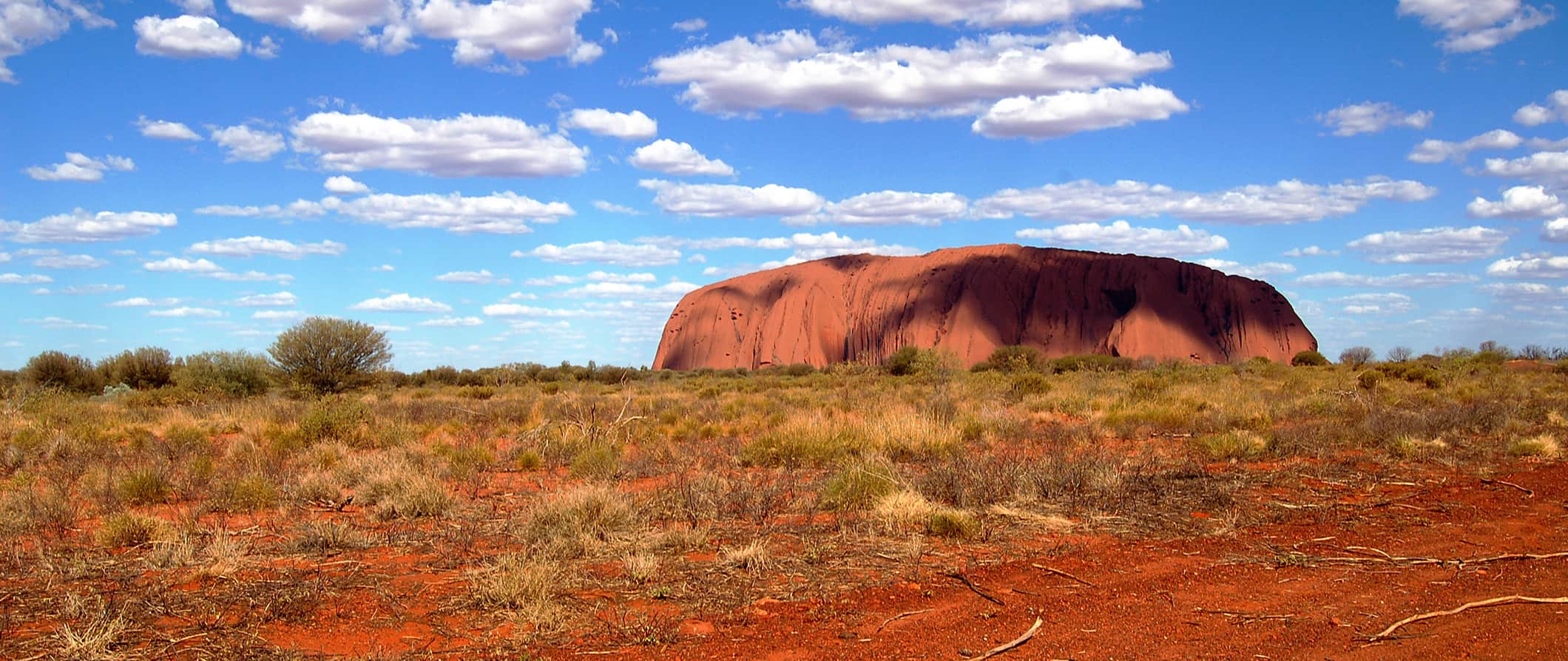
Accommodation
- Hostel Dorms – 30-40 AUD per night. In major cities, expect 55 AUD
- Hostel private rooms – 110-150 AUD
- Budget hotels – 150 AUD
- Airbnb private rooms – 50-75 AUD
- Airbnb apartments – 110 AUD
- Campsite – 10-25 AUD
- Pre-made sandwiches – 8-15 AUD
- Pub food/Takeaway – 15-25 AUD
- Casual restaurants – 25-55 AUD
- Midrange restaurant – 55-75 AUD
- Fast food (think McDonald’s) – 15 AUD
- Beer – 11 AUD
- Cappuccino/latte- 5-6 AUD
- Bottled water – 2-3 AUD
- Groceries for a week – 90-150 AUD
Australia Suggested Budgets
Backpacker – 90 aud per day.
This is a tight budget that requires couchsurfing or house-sitting, cooking just about all your meals, limiting your partying, and spending most of your money on transportation and just a few activities.
While not impossible, it would require you to constantly watch your pennies. But some travelers do it and you could probably do it too.
Midrange – 260 AUD Per Day
On this budget, you can stay in budget hotels or private hostel rooms, eat out for a few meals, enjoy the occasional drink, rent a car or get a bus pass, and do more paid activities like museum tours or water sports.
You won’t be living large, but you won’t have to watch your spending too much either.
Upscale – 400 AUD Per Day
On this budget, you can stay in a hotel, eat out for all your meals, drink more, rent a car or camper van to explore, and do whatever tours and activities you want.
This is just the ground floor for luxury though. The sky is the limit!
Australia Travel Guide: Money-Saving Tips
Australia can be a very expensive country to visit. If you aren’t careful, you’ll blow through your entire budget in no time as activities, food, and transportation all adds up fast here. Fortunately, there are lots of ways to save too. Here are some ways to save money when you visit Australia:
- Drink goon (box wine) – Goon is infamous on the Australian backpacker hostel trail. This cheap box of wine is the best way to drink, get a buzz, and save a lot of money at the same time. Drink this before you go out and save on spending money at the bar.
- Cook your own meals – The best way to reduce your costs is to cook as many meals as possible. Hostels and Airbnbs usually have kitchens and, while it’s not glamorous, it will save you a ton of money!
- Car share – Australia is a big country that can be expensive to get around. If you are traveling with friends, it’s smart to buy a used car or campervan (or rent a new one from one of the many rental companies in the country) and split the costs of gas. You can also hitch a ride with other travelers using sites like Gumtree, Jayride, or hostel message boards.
- Book tours as a package – This country has a lot of exciting activities and tours that eat into any budget. Booking activities together through a hostel or tour agency can get you a discount and save you hundreds of dollars.
- Work for your room – Many hostels offer travelers the opportunity to work for their accommodation. In exchange for a few hours a day of cleaning, you get a free bed to sleep in. Commitments vary but most hostels ask that you stay for at least a week. Check with the staff when you arrive to see if there are any opportunities available.
- WWOOF – WWOOFing is a program that allows you to work on organic farms in exchange for free room and board. Everyone I’ve met who stays in the country long-term does it for at least one month. It’s a great way to reduce your expenses and can a deeper look into local life.
- Stay with a local – Accommodation in Australia is pricey. If you plan ahead, you can usually find a Couchsurfing host that will host you for free. It’s the best way to connect with a local and get insider tips and advice.
- Camp – Camping is very affordable here, with basic tent plots costing as little as 7 AUD per night!
- Bring a reusable water bottle – The tap water in Australia is safe to drink so bring a reusable water bottle with you to save money and lower your plastic use. LifeStraw makes a bottle with a built-in filter to ensure your water is always clean and safe.
How to Get Around in Australia
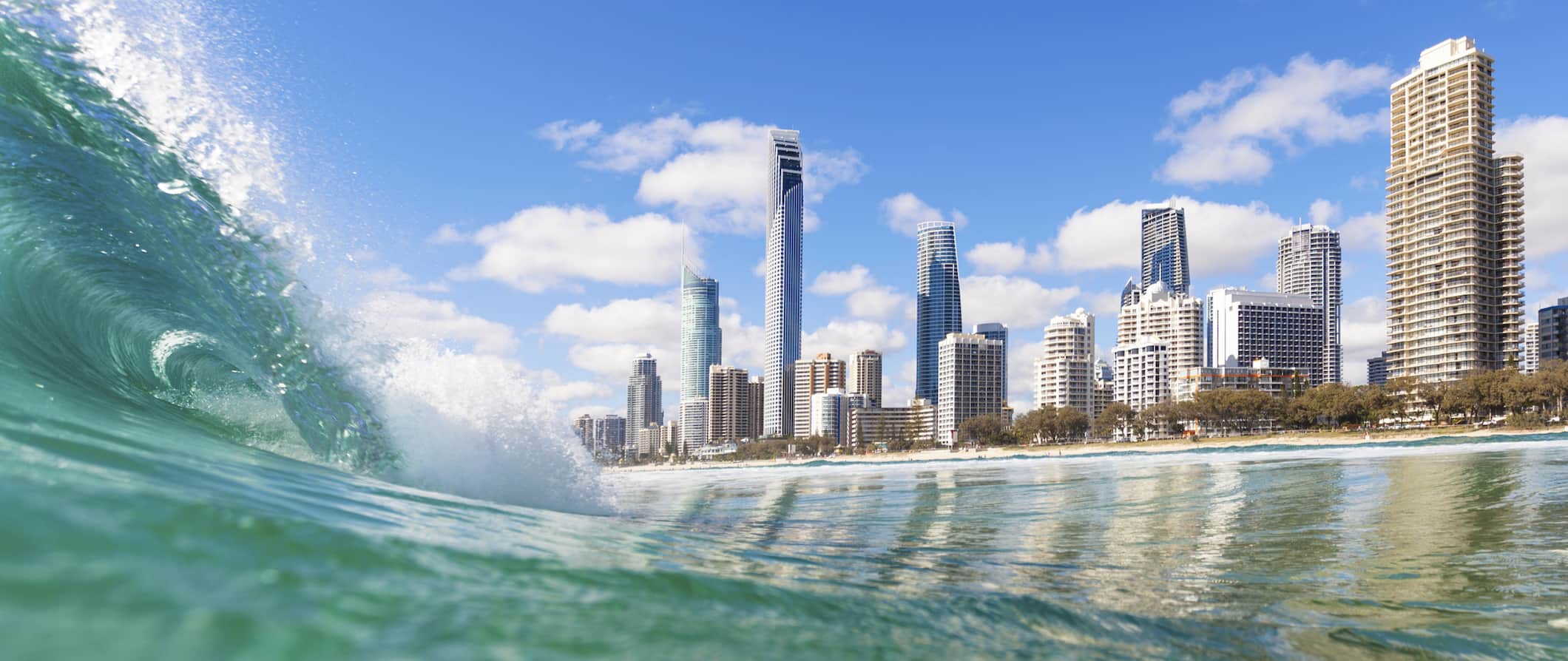
Public transportation – All of Australia’s cities have reliable, affordable public bus systems. In the bigger, cities such as Sydney, Melbourne, Brisbane, Adelaide, and Perth, you’ll even find subways and tram systems. This is the cheapest way to travel the cities. Fares cost between 2.75-4 AUD.
Many cities offer day passes that include unlimited public transportation for under 10 AUD.
Bus – After driving, this is my favorite transportation option in Australia. On the east coast, this will be your cheapest option too. On the west coast, buses are surprisingly expensive as there are not many people moving up and down that coast and there’s limited competition. However, on the east coast, you can find really cheap bus tickets, especially if you book in advance.
The two main bus companies in Australia are:
- Greyhound Australia
Greyhound also offers several bus passes. Their Whimit Passes range from 15-120 days of unlimited travel and are perfect for traveling around on a whim (hence the name). They come in 15, 30, 60, 90, and 120-day passes costing 400-860 AUD.
To find bus routes and prices, use BusBud .
Backpacker Bus – If you want to party with other backpackers as you travel, book a seat on the Magic Bus . This backpacker bus departs with 25 backpackers aged 18-35 for 3-4 weeks of exploring the country’s national parks, camping, bonfires, and non-stop parties and shenanigans.
Trips go from Perth north to Broome or east to Melbourne each month, so you have to time your trip accordingly to line up with the set departure. The itineraries are always flexible so every trip is unique. They try to keep a balance of 50% men and 50% women, as well as a balance of different nationalities, so there is always a diverse group. Prices vary so contact them for departure dates and ticket prices.
Train – Between city trams, commuter trains, and long-distance and trans-continental trains, Australia can be seen extensively by rail. Train lines exist mostly on the east coast with only two other major lines in the country: one goes north/south from Melbourne to Darwin and another east/east from Sydney to Perth.
For reference, Sydney to Canberra takes 5 hours and is 40-50 AUD while the 11-hour trip from Sydney to Melbourne costs over 200 AUD. Sydney to Brisbane takes 14 hours and costs 100-140 AUD.
Beyond the east coast, trains aren’t as plentiful and long-distance trains can be very expensive.
Flying – With Australia spanning over 7,000,000 square kilometers, it takes a long time to get around the country. Flying is one of the most efficient ways to city hop, but it’s not the cheapest. Australia’s major airlines include:
When booked in advance, flights can be very affordable here. Sydney to Melbourne is just 55 AUD and takes 90 minutes while Sydney to Cairns takes 3 hours and costs around 100 AUD each way. To cross the country, flights last around 5 hours. Sydney to Perth, when booked in advance, can cost as little as 150 AUD each way.
When not booked early, however, flights can easily double or triple these prices.
Rideshares – Every hostel has a bulletin board where travelers post rides and websites like Gumtree have active ridesharing sections where people look for cars or riders. I HIGHLY recommend this way of traveling when in the country. CoSeats is another good resource for finding rides.
Car rental – Car rentals start around 50 AUD per day. You don’t need one to explore any of the cities but if you want to travel the country then a car is best. Just remember that they drive on the left here.
For the best rental car deals, use Discover Cars . You can get a free quote using this widget:
Additionally, you can also purchase a car from backpackers leaving the country or locals selling used cars. You can usually find a used car for around 4,000 AUD. It might seem a lot, but there are always backpackers looking to share rides, which can cut down on our expenses.
Hitchhiking – Hitchhiking is safe and common in Australia. Just make sure you have a flexible schedule and dress respectably (and for the weather) as rides are infrequent. Hitchwiki is the best resource for additional tips and information.
When to Go to Australia
Temperatures vary across the country (it’s a huge landmass after all), but generally speaking, average summer temperatures range from 20-37°C (68-99°F). Remember that summer is from December-February here in the southern hemisphere. This is the most popular time to visit so expect big crowds and higher prices.
June-August (winter) is the low season. Prices are lower and there are fewer crowds. The temperature dips as well, hovering around 1°C (52°F) in the south while going as high as 30°C (86°F) in the north.
Spring and fall (March-May and September-October) are the shoulder season and the best time to visit. Crowds aren’t as big and prices aren’t as high and the weather is still enjoyable too, rarely dipping below 17°C (63°F).
Note that October to April is also “jellyfish season,” making waters unsafe for swimming or any other water sport. If you’re planning on enjoying Australia’s coast, this probably isn’t the best time to come. The season lasts from October to April in Northern Australia, and then from November to March elsewhere.
Australia Travel Guide: The Best Booking Resources
These are my favorite companies to use when I travel. They consistently have the best deals, offer world-class customer service and great value, and overall, are better than their competitors. They are the companies I use the most and are always the starting point in my search for travel deals.
- Skyscanner – Skyscanner is my favorite flight search engine. They search small websites and budget airlines that larger search sites tend to miss. They are hands down the number one place to start.
- Hostelworld – This is the best hostel accommodation site out there with the largest inventory, best search interface, and widest availability.
- Booking.com – The best all around booking site that constantly provides the cheapest and lowest rates. They have the widest selection of budget accommodation. In all my tests, they’ve always had the cheapest rates out of all the booking websites.
- Get Your Guide – Get Your Guide is a huge online marketplace for tours and excursions. They have tons of tour options available in cities all around the world, including everything from cooking classes, walking tours, street art lessons, and more!
- Rome2Rio – This website allows you to see how to get from point A to point B the best and cheapest way possible. Just enter your departure and arrival destinations and it will give you all the bus, train, plane, or boat routes that can get you there as well as how much they cost. It’s one of the best transportation websites out there!
- SafetyWing – Safety Wing offers convenient and affordable plans tailored to digital nomads and long-term travelers. They have cheap monthly plans, great customer service, and an easy-to-use claims process that makes it perfect for those on the road.
- LifeStraw – My go-to company for reusable water bottles with built-in filters so you can ensure your drinking water is always clean and safe.
- Unbound Merino – They make lightweight, durable, easy-to-clean travel clothing.
- Top Travel Credit Cards – Points are the best way to cut down travel expenses. Here’s my favorite point earning credit cards so you can get free travel!
Australia Travel Guide: Related Articles
Want more tips for your trip? Check out all the articles I’ve written on Australia travel and continue planning your trip:
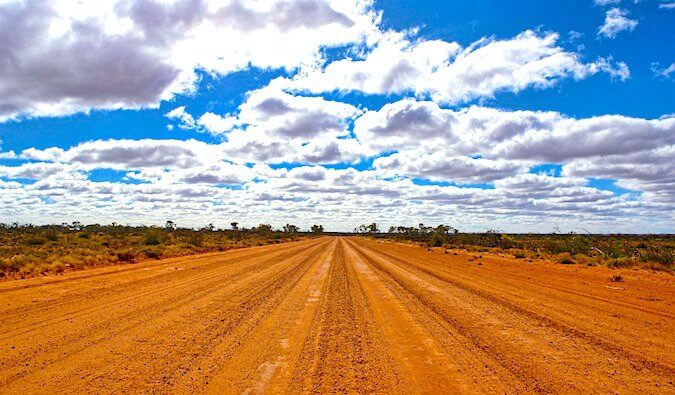
How to Get Around Australia on the Cheap

The 7 Best Hostels in Australia
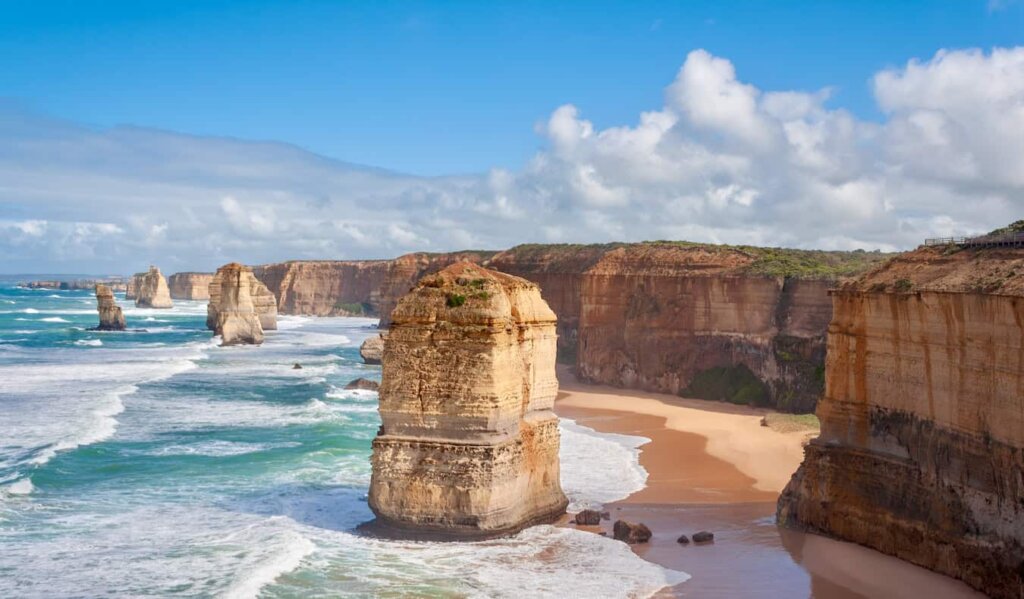
10 Reasons to Visit Australia
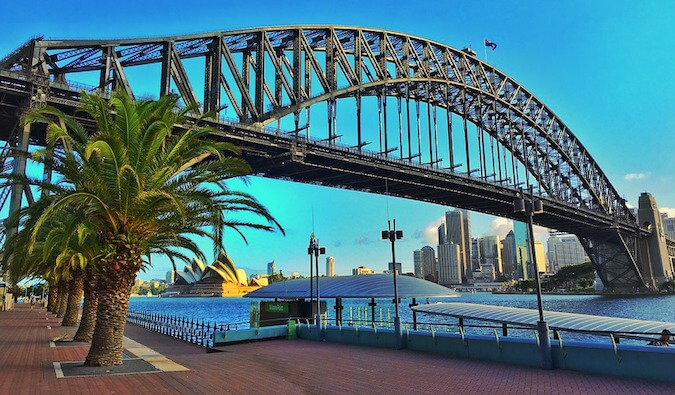
How Much Does a Trip to Australia Cost?
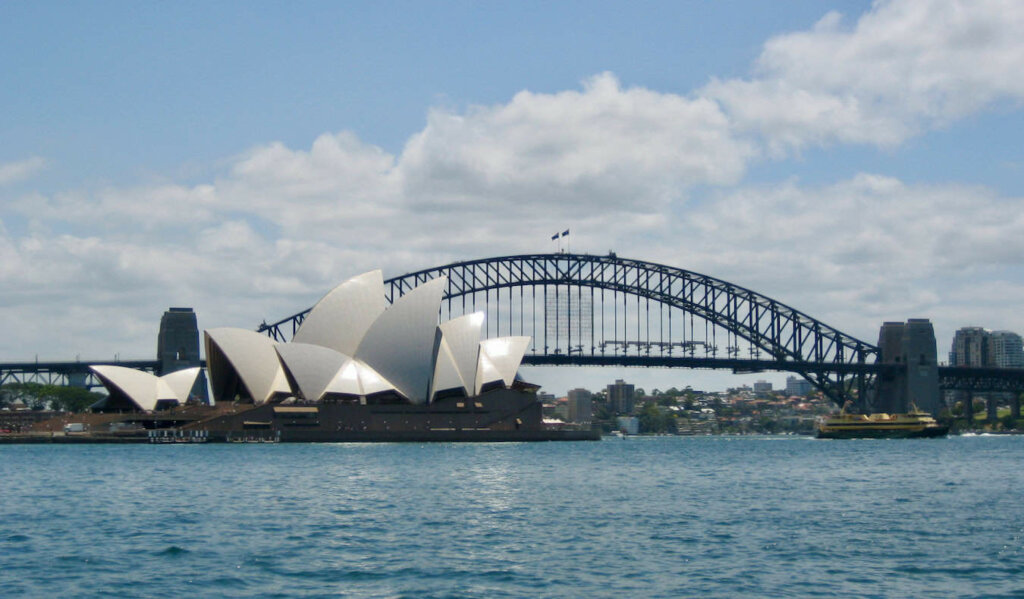
The 9 Best Hostels in Sydney
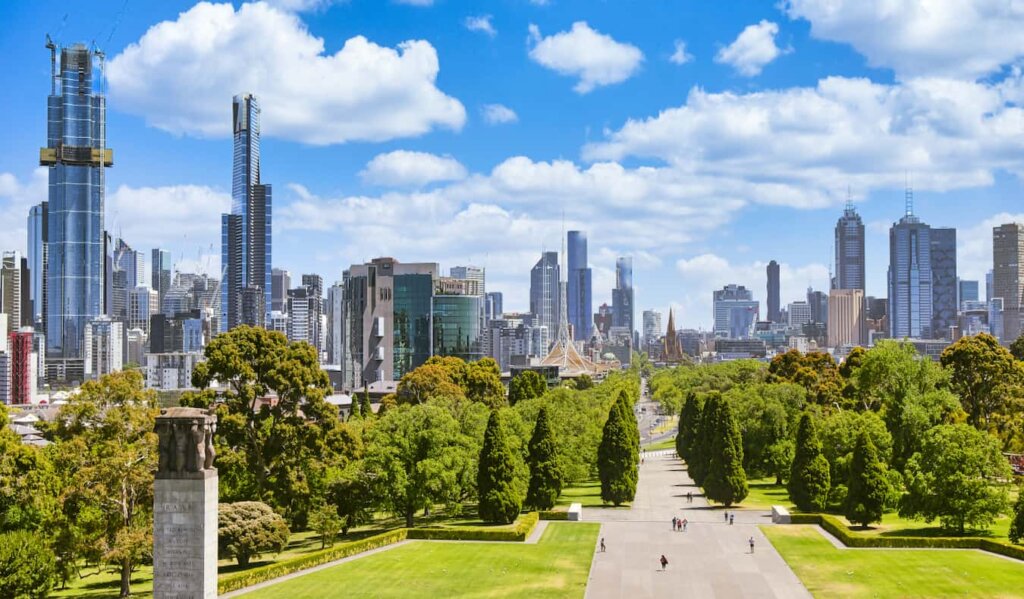
The Best Walking Tours in Melbourne
Get your free travel starter kit.
Enter your email and get planning cheatsheets including a step by step checklist, packing list, tips cheat sheet, and more so you can plan like a pro!

- Where To Stay
- Transportation
- Booking Resources
- Related Blogs

💵 How Much Does it Cost to Travel Around for 12 Months?
How much does it really cost to travel around Australia full-time for 12 months? This is one of the most asked questions for those wanting to tackle the Big Lap or road trip Australia.
While some people make it all the way around in one year, others wander and take many years to complete a lap. A 12-month travelling Australia budget can vary depending on how fast you travel and what you experience along the way.
We were a family of four, living on the road, just meandering around Australia, exploring and living slow. We officially survived one whole year of travelling in a caravan. Well, if you want to get really specific, we haven’t actually left our home State yet. In our defence, Queensland is one BIG State!
While this is nowhere near a ‘Big Lap’ Budget, it does accurately reflect a snapshot of our caravan lifestyle expenses. For a look at other associated costs, heres the Full Breakdown of Caravanning Costs .
Read on to find out the costs!
We are a participant in affiliate advertising programs designed to provide a means for us to earn fees by linking to ebay.com and other affiliated sites. We may earn a commission from your purchases at no extra cost to you. For more information, see our disclosures here .
How Much Money Did We Start With for Travelling Australia?
If you think that the cost to travel Australia full-time needs to be expensive or requires a large sum of savings, let’s just squash that preconceived notion right now.
Do you want to take a guess at what our start-up figure was when we embarked on this adventure? $30,000? $20,000? Nope, we didn’t even have $10,000. We hit the road with just $2,500 in our back pocket!

To be fair, we always planned to have much more savings than that.
In the end, we were just so tired of looking at the ‘To Do’ lists. We basically put them aside and figured we’d get to them later (we never even looked at them after that and survived just fine). I guess that’s just a testament to thinking you need more than you actually do.

How Did We Fund 12 Months Travelling Australia?
So, if we only started with $2,500, how did we fund our travel around Australia for the first 12 months?
Well, we survived in a variety of different ways, but mostly from our few stints of stopping for work. My partner at the time was a Truck Driver and found it pretty easy to pick up work. We were also lucky to have a decent tax return last year, which gave our budget a nice little injection.
I kept myself busy building up the website and creating a range of Travel Planning Resources to help people like yourself, which also helped. Head on over and check out the OZ BIG LAP series!
Without further ado, let’s crunch some numbers!

12 Month Costs For Travelling Australia
Travel budget break-down, accommodation.
As you can see our weekly accommodation outlay was a mere $34.40 per week towards the cost to travel Australia full-time. That’s definitely loads cheaper than what we were forking out each week on our mortgage before we sold the house! Our favourite way to keep that figure down was with Free Camping as much as we could.
Free & Low Cost Camping
I really enjoy the freedom of being self-sufficient and have found that Free Camps are more readily available (and you can stay for longer) once you get away from the coast. Being able to carry up to 300 litres of water also gave us an extra few days off-grid.
Before heading off, we spent the money on a great solar set-up. That effectively meant that we didn’t need to do the old chase-the-sun-with-the-portable-panel dance. We honestly never had to stress about our usage, so it was worth it.
Of course, having an onboard ensuite was also a must for us. We stayed at plenty of Free Camps where there were no porcelain thrones available, let alone showers. You can see our caravan and tow vehicle for more of the ins and outs.
We were pretty lucky to have had enough friends and family spotted around with offers of grass patches. That was amazingly helpful (especially when stopped for work and caravan repairs).
RELATED POSTS: ◆ WikiCamps Tutorial → ◆ Free Camping Guide →
Caravan Parks
You may note that our Caravan Park cost per night ($12.56) was rather low. One main factor being that we had a voucher for one park, which we’d won through a competition. That meant that our stay didn’t cost us much out of our hip pocket.
The other factor was a due to a personal incident, which had us prearrange a very good deal with another park along the way. Both of those factors together kept our Caravan Park expenses really low. Without those opportunities we would have sought out alternative accommodation to help keep our cost of full-time travel in Australia as low as possible.

I’m pretty happy with our weekly grocery cost for full-time travel around Australia ($166.26 per week). This is also taking into account that we spent five months in Central and Outback Queensland, where the big chain grocery stores where few and far between.
Just to give you an idea, we went 5 weeks without seeing a Coles or Woolworths. Let me tell you, feeding a family from those tiny Outback Food Stores is EXPENSIVE! The range of food is tiny (especially with gluten intolerance in the van).
Check out these frugal living hacks to give you some ideas that’ll get you through those rainy days. But, being a budget shopper from way back (in fact this is more than I used to spend!) we survived. Let me share some of my tips and tricks with you.

TIPS TO REDUCE GROCERY COSTS:
Use What You’ve Got
Before buying more stuff, use up what you’ve already got first. This doesn’t just apply to food, but toiletries and cleaning items too. Dig deep into the back of the pantry and use up those items that keep getting shoved to the side. This is also a great way to avoid adding unnecessarily to your payload.
Keep a Running Shopping List
Stick a piece of paper onto the fridge/ whiteboard titled ‘Shopping.’ Whenever you notice an item has run out or needs to be replaced, add it to the list. Come shopping day, all you need to do is add anything extra that you know you need and you’re good to go. This curbs excessive unnecessary buying because you know exactly what you do and don’t need.
Meal Planning
Creating a meal plan doesn’t need to comprise fancy gourmet meals. It’s simply the deliberate act of seeing what ingredients you’ve already got and filling in the blanks to create 7 meals for the week. Add in lunches, snacks and breakfast as well.
Cooking in Bulk
When cooking, it doesn’t hurt to make the meal big enough to stretch out for another night or two. For example, when I make a stir-fry, I use two jars of sauce with the usual veggies, 2 pieces of chicken breast and boiled rice. That way, we end up getting an easy two to three nights out of the one meal. It really helps to keep the cost per meal lower.
Utilise Leftovers
Even if you don’t bulk cook, leftovers are still a thing. It’s much easier to reheat food the next night than it is to cook another meal from scratch, so why not use them up? If we don’t feel like the same meal by night two or three, I just freeze the leftovers. They’re great to have on hand for those busy travel days or if you’re wanting to stretch the budget out and cut the grocery bill down a bit.
Mix it Up with Cheap Meals
Yes, we consider baked beans on toast topped with grated cheese and pepper to be a meal sometimes! Another cheap meal is putting some of those leftovers into toasted sandwiches or adding them into a stew. A bit of leftover meat can be thrown in with rice and whatever veggies are left with some soy sauce and an egg for a basic Fried Rice.
Ditch Disposables
Not only is the elimination of disposables great for the world around us, but it saves quite a bit of money as well. I haven’t bought Glad Wrap or Alfoil in years – I just use containers, jars and beeswax wraps instead. The only cleaners I buy now are detergent and laundry liquid. The rest of the cleaning is done with reusable Norwex cloths. Get a good water filter on your tap and invest in a stainless steel drink bottle to replace bottled water. There is a solution for every disposable item once you start looking.
Another little grocery bill saver is with a little DIY. Making things from scratch will save you money if you’re that way inclined. For me, I like to make my own deodorant, rather than buying it. I also opt for straight out coconut oil as a moisturiser, which saves having to buy expensive creams.

Camping Food Checklist + Menu Planner
- 12 food item categories
- Checklists pre-filled with 100+ items
- Menus pre-filled with 21 meals, 14 snacks & 3 desserts
- PRINTABLE & DIGITAL
- Download once, use over-and-over again
I wouldn’t say that our weekly fuel costs were neither low nor high, but somewhere in between. What I can tell you is that travelling slower is the key to keeping that cost down. It’s simple mathematics that the further you are travelling each week, the more fuel you’ll be going through.
Not everyone is in a situation where travelling slow is an option. I know many people are on a year-long quest to do the Big Lap, in which case, travelling slow just isn’t going to work. The cost of fuel is without a doubt one of the biggest additions to your travel Australia budget costs!

We had chosen to run a Petrol car for a variety of different reasons. Mainly because my partner could easily service, maintain and fix a petrol vehicle (diesels are more technical and specific). Plus, the parts are generally cheaper if things go wrong. Before we made our vehicle choice, we put hours of thought and research into what was the best financial choice for us overall.

Jerry Cans (eBay) →
When we weren’t plugged into power, we went through about one gas bottle per fortnight. That powered our hot water, BBQ, stove top burners and fridge. If we ever found ourselves needing to replace the fridge though, I’d definitely opt for a Compressor Fridge, which would run off the solar.

One tip that reduces gas consumption is to keep the hot water turned off at the switch and only turn it on 10 minutes before showers. This stops the hot water system from continuously heating up all day and night.
If I needed a bit of hot water to wash the dishes, I’d just boil a cup or two in the kettle as it was much quicker than heating up the 30 litres in the hot water system.
ALCOHOL & EATING OUT
We weren’t massive drinkers but certainly couldn’t resist a good Happy Hour here and there. We met some amazing travellers while sharing a yarn and partaking in a cold beverage, which is something we really enjoyed.

Evidently it seems we’re quite the sucker for the old Bakery and Pub Schnitty though. Who knew?!
Maybe I’m just justifying it to myself… or maybe I’m on to something, but we love being able to support those two local businesses. Eating out would certainly not have been something we could have done as often if we weren’t free and low cost camping as much.
Here’s cheers to all the Pub and Bakery owners out there, keeping all of us hungry and thirsty travellers well fed!

Insulated Mugs & Tumblers →
EXPERIENCES
The main experiences that we enjoyed were in Outback Queensland. I ticked off one bucket list item – The Dinosaur Trail . Plus, we also did the QANTAS Founders Museum in Longreach, which was brilliant.
While we were in The Gemfields in Central Queensland, we did a lot of Sapphire Fossicking . We also ferried over to Magnetic Island off the coast of Townsville, while in North Queensland.

Besides those big things, we frequented many other local museums and attractions along the way. We always made the most of free activities when they popped up, particularly council run Water Parks.
MAINTENANCE
The ‘Maintenance’ category covers not only servicing, but also tools, parts and other things that needed to be done to both the Patrol and the caravan during the year.

Here’s a look at what maintenance tasks popped up for us:
- Two car services (DIY labour, so we only need to pay for parts)
- New Tie Rod ends
- Wheel rotation & alignment
- Indoor/ outdoor car thermometer
- Airbag sleeves
- Car battery
- Water filter & hose fittings
- TV aerial cord
- General tools, parts & supplies
- Car wash costs

Caravan Maintenance & Service Log
Log and track all of your caravan maintenance and servicing requirements.
- 7-page Planner (digital & printable)
- Caravan Service History Log
- TICK OFF checklists
- COMPLETE maintenance tasks
- ADD in extra tasks
- RECORD maintenance & service dates
Our only real medical cost while travelling around Australia for the year, was an impromptu visit to a Rockhampton Dentist. A sore tooth resulted in a tooth being pulled out.

Indii also had a hospital visit after getting mild concussion while wrestling with her brother in Townsville. Thankfully hospital visits are free in this country!
RELATED POSTS: ◆ Travelling First Aid Kit → ◆ Travelling Ambulance Cover →
Dominic and Indii were Home Educated, which didn’t cost anything as such. We still had some workbooks to get through from the year before, so we only needed a couple of extra ones to kick start the year.

When due to get some more, I hit up Officeworks, Kmart, Big W and the like for relevant Maths and English books. We picked up reading books and educational games from Op Shops along the way, the rest was learnt through hands-on experience.
ON-ROAD BILLS
The ‘Bills’ category was the second biggest expense, coming in just behind ‘Groceries.’ Insurances were one of the mains costs, but making sure we were properly insured was not something worth skimping on.
Below is a list of all bills that we had, keeping in mind, we sold the house and did’t have anything in storage, so it’s just what we needed to live on the road.
- Car Insurance
- Caravan Insurance
- Car Registration
- Caravan Registration
- Phone #1 ($69/ month postpaid | Telstra | Unlimited calls, sms & data)
- Phone #2 ($35/ month prepaid | Aldi | 26 gb data + unlimited calls, sms)
- We put money aside to cover all servicing & maintenance
- Website costs
MISCELLANEOUS
The ‘Miscellaneous’ category was kinda like that third drawer that collects all of the bits and pieces without a home. Our figure for that year was particularly high ($3,496) because of a last minute trip, where we flew back home to see family and friends.
The other things that fell into the Miscellaneous this category:
- Op Shopping
- Gifts & souvenirs
- Post office
- Fishing bait
- Replacing the flogged out camp chair – $99 for the cheapest one in the Outback!
- Laptop charger
- Uber and any other random thing that pops up

Keeping Track of Travel Expenses
To keep up with all of our associated fuel and kilometre figures, we used the Fuel Map App .
Every time we put fuel in the car, we logged how many litres of fuel and how much it cost. In turn, the app automatically kept track of how many km’s we’d travelled, how many litres per 100km we were using and how many fuel top-ups we’d had.
It was brilliant, I totally recommend using it!
WALLET APPS/ PEN & PAPER
I knew before we’d even hit the road that I wanted to be tracking our total cost to travel Australia full-time in a caravan. After all, facts and figures can be highly motivating.
I began by trying a few different Wallet Apps, but they all failed to do what I needed. Some linked to my bank account (which I’m highly uncomfortable with) and weren’t categorising the info correctly. For example, it would log Woolworths fuel under ‘Groceries,’ instead of ‘Petrol.’ Too much time ended up being spent editing it all, just to keep on top of the true running costs.
I soon ditched the idea and went back to good ol’ pen and paper. This worked fine for a while, but I knew the notes would be stacking up too quickly before long.
EXPENSE TRACKER SPREADSHEET

Since I couldn’t find what I needed elsewhere, I created an Excel spreadsheet to track my cost of travel around Australia full-time. I included all of the categories relevant to travelling Oz across a 12-month time frame. I spent hours inputted all of the formulas so that everything would automatically tally up as I logged it. Now the numbers-nerd in me was happy.
Then I figured, well if I’m finding this rather useful, surely others could get a lot out of it too. So, I made the spreadsheet available for download and hence, the Expense Tracker was born!
In just 10 months it had easily become our Best Seller . That definitely shows that there are others out there who love to keep track of their own stats!
Here’s where you can download the Travel Expense Tracker Spreadsheet for your own trip.
Planning Your Big Lap Budget
If you’re in the planning stages and want to nut out how much a Big Lap or Road Trip around Australia is going to cost you, download our Big Lap Budget Spreadsheet.
It’s the perfect tool to work you through all expected costs, savings/ income, at home expenses, plus all of your set-up costs.

Final Thoughts
As with every budget write up, there is no one size fits all. Please bear in mind, this is just one family’s cost for one year of full-time travel in Australia. No doubt yours will look different.
Even our own numbers looked vastly different after a second year on the road. There are just so many variables at play.
To be honest, I could have easily cut a few things out if I wanted to (which I didn’t). We could even have lived a bit more luxuriously if we wanted to as well, but we were working to live, not living to work.
This budget layout is merely a snapshot to be used as a helpful tool. It’s an opportunity to see some real costs to help plan your own budget.
What does your travel budget look like? How do you keep track of your own costs and figures? Let us know below in the comments.

Packing Up to Travel Australia
The ultimate pre-travel planner for anyone hitting the road for a big trip!
- 41-page Planner
- Decision-making prompts
- Travel set-up planning
- Budget estimates & more
- DIGITAL & PRINTABLE
Travel Planning Tools

32 thoughts on “💵 How Much Does it Cost to Travel Around for 12 Months?”
What an amazing account of your planning and annual expenses. This is such a great inspiration to those who love this type of travel. You have really put it into perspective that this is feasible for anyone if they really want it. I applaud you for following your passion. You are providing yourselves with such an enriching experience. And, such a great experience for your children- priceless!
Thank you. I really believe that it can be achievable for most people if they really want to travel Australia for an extended length of time. With the right planning it can be done.
I love your detailed breakdown – thanks for sharing all the numbers. It strikes me that managing and categorising expenses is a big part of cheap/frugal travel living. I find it funny that you never left your home state – but I guess that just says that there’s lots and lots to do in Queensland!
It sure is a part of frugal living, I learnt those skills from when I was a poor student in my early twenties. Queensland is HUGE! We covered over 16,000 km’s and only really looped around half of the state.
We just got back from a one month loop around outback QLD (around 3,500kms) from Townsville, up to Kurumba in the gulf and back through different towns including Longreach and the gemfields ( I’m still sifting my bag of gems lol. I got a handful but small ones). It was amazing. I’d love to have done what you are doing and doing it much slower. We will one day and it was amazing bumping into people you met before hundreds or thousands of kilometres away in another town all doing a similar trip. Thanks for all your advice.
Hi Sue, sounds like an amazing trip! How cool that you’ve still got some gems to go through – we loved sapphire fossicking. I have some small ones that I’ve put into a locket pendant and wear all the time as a keepsake. Meeting like-minded people and bumping into familiar faces along the way is the best. Thanks for checking out our blog and safe travels in the future.
Well, you turned the myth that ‘travelling is expensive’ on its head. Impressive figures here, showing that one can save in so many different ways. Not that I would mind the extra frill 🙂
Haha I don’t mind a bit of extra frill here and there too 😉
That’s a brilliant and detailed insight into life on the road. Aus can be expensive for things like food (my mum was an ex-pat in Addie) but you’ve stretched your grocery budget until it squeaked. And with someone gluten-free too! As a coeliac, I know that can be expensive.
I love how you got to the point where you decided it was time to go. We can all wait for the perfect time, and sometimes that time is now. And what an adventure it must have been and will continue to be. Wishing you lots more happy miles!
Australia can definitely be an expensive country to live in. It’s kinda like we have no choice being all the way over here on our own. There were some really tough moments being GF on the road where I just wasn’t organised enough, so I’ve had a few lessons there along the way.
We could have been prepping forever, but got so over it. It was time to just bite the bullet.
So awesome that you traveled around Australia for a year in a caravan. This detailed budget report was so interesting. I always wondered what the costs would be like to live on the road. I actually was surprised at the total as I actually thought it would have been cheaper. I also am impressed that you kept track of all your expenses for an entire year.
Haha yeah tracking it all for a year takes commitment. There are definitely people doing it cheaper and some spending much more. As with everything in life, the variables are far and wide.
Such an awesome and very detailed post chock full of useful information and insight. You have fully embraced the travel nomadic lifestyle, good for you. But even better for your family. I know one family that picked up, sold their house, bought a sailboat (hey, a caravan is a land yacht) and headed off to see the world. It was a life-altering experience for them and for their children. The sort of education and upbringing you simply cannot get in a school house immersed in only books and theory.
Man, I couldn’t even imagine doing it in a yacht. But I am more of a land-dweller. I can see how it would be have been such a fantastic experience for that family. You certainly do learn so much more through life than you possibly can do through books within four walls.
Congratulations on completing a year out on the road, that is something we are looking forward to be doing later on. The pie chart was a touch of genius and gave a very quick understanding of how the money flows. Also thank you for all the individual tips you included under the different sections, ready pointers like these help future travelers and gives them a lot of confidence 🙂
Thanks so much for having a read of our budget break-down Mohana. It really does become useful data and seeing where the money flows I think is extremely important when understanding your own financials. Knowledge is power 🙂
That’s a great breakdown on costs. Aus is expensive especially on fuel and food in the outback but there are ways to keep costs down. We lived in Aus for a year but we worked and did shorter trips but still quite long with one from Melbourne to Darwin and Brisbane to Cairns!
It sure can be an expensive country to travel! But there are definitely ways to save a bit of money and keep the dream alive a bit longer. Melbourne to Darwin and Brissy to Cairns are huge trips! It’s a big country.
Good for you for embarking on your journey, even though you didn’t have the funds you were aiming for. It seems you’ve found ways to be very resourceful and budget carefully – – good tips for keeping food costs down. I could do a much better job of tracking travel expenses, so I’ll take a look at the Expense Tracker.
Hi Cindy. Yes being resourceful is such a great skill to have and luckily I learnt a lot about that in my younger years!
I just loved reading this as I love life in a camper! (Dream!) The map shows just how huge Australia is! The details around the budgeting are super interesting to read. How great that there is free camping to reduce the overall daily budget from time to time. Love how you have developed an app to suit your needs and those of others. Happy Travels.
Thanks Alison. Free Camping in Australia is just amazing. Really, pulling up on a piece of dirt or grass should be free anywhere in the world in my opinion. After all, it’s everyone’s planet. The Expense Tracker is not quite an App, but rather a spreadsheet ;).
I absolutely love how thorough a post this was. My goodness! I’m absolutely impressed that you left with $2500 in-hand! That’s so brave! I don’t have the skill to pick up the same sort of work as your husband, but I am able to pick up freelance writing work and the like. I’ve often extended vacations that way!
What a lucky life for your girls too! My goodness! If I could go back in time, I’d raise my children much the same way! As for the compressor stove, have you considered seeing if you could get sponsorship? Maybe write some sellers of the product, or the product manufacturer and show them this amazing post, then sell the older stove so that it’s not wasted?
Lastly, are you ever in one place long enough to get Amazon deliverys? If you are, I usually get my beeswax sheets for free. If you look up Amazon Deal and Code sites on Facebook, that’s one of the items that sellers are often looking to give away to get their position up further in search results.
Anyway, I’ll be bookmarking this. I’m in the US, but still, there’s so much useful information in this post… SOO Much!
Hey Cathy, I’m so grateful that Allan is able to pick up work along the way, I don’t think we’d be able to live this way if he couldn’t. Freelance writing is definitely a great way to help fund the travels, I’ve done a bit of that myself.
It’s actually the fridge that we’d get compressor-style if we could. It’s definitely possible to look into sponsorship to get it changed, we might possibly look into that in the future.
We can easily get mail delivered. I didn’t know about the free beeswax wraps. Thank you, I’ll definitely have to look into that! At the moment I’ve got a nice stash of some that Mum bought for me for my birthday. They are great, love them!
Thanks so much for taking the time to read this post!
Hi there, great information for those of us planning to do a loop in the not too distant future. How many people are you feeding?
Hi Anna, we’re feeding 4 (2 adults and 2 primary aged kids).
A very good read, we aren’t proposing to do a big lap but travel to Darwin via Uluru. We will get the Fuel Map App and Expense Tracker, I’m a figures person also, thank you and safe travels to you.
Hi Margaret, thanks so much for having a read. That sounds like a really Aussie trip to take, it’ll be loads of fun. We definitely recommend the Fuel Map App and Expense Tracker if you’re a numbers person, they both make life much easier when it comes to recording and tallying up figures.
What caravan did u buy and why
Hi Jason, after many months of research we ended up deciding on the Jayco Starcraft Outback bunk van (23 ft). We love and haven’t had any problems with it, besides the usual wear and tear type stuff. You can see the full run down if you click on ‘OUR SET-UP’ at the top of the page.
How many kilometres did you do in the 12 months
Hi Jenny, our total distance travelled is 16,204 km’s.
Leave a Comment Cancel Reply
Your email address will not be published. Required fields are marked *

Australia Road Trip Budget: A Detailed Cost Breakdown
By: Author Lotte
Posted on Last updated: December 16, 2022
Categories Australia

In this post you can read about our Australia road trip budget, I hope this will give you an idea about the cost to travel to Australia.
Australia is the 6th biggest country in the world, so big in fact that it counts as a continental landmass!
With more than 823,000 kilometers of road available to be explored, it is an amazing road trip destination ( read more Australia Trivia here ).
We love love love love road trips, in fact, it's our favorite way to travel. We've gone on lots of road trips in countries such as New Zealand , Japan , Portugal , Oman , Canada , and the U.S.A.
I can say from experience that road-tripping is one of the best and cheapest options to travel!
Australia road trip budget: how much does it cost to travel to Australia?

Disclosure: Some links in this post are affiliate links. If you make a purchase through one of these links, we may earn a small commission (at no extra cost to you!). We're very grateful when you use our links to make a purchase:-).
How much does it cost to go to Australia?
Have you always dreamed about a Working Holiday in Australia? Check out Global Work & Travel and get a €100 discount with the coupon code PHENOMENALGLOBE .

Australia is infamous for being a rather expensive destination, however, we managed to travel Australia on a very reasonable budget.
For everyone wondering: Is Australia expensive to visit? It doesn't have to be! We spent less than €100 a day (for us as a couple) during our 6-week road trip from Cairns to Melbourne.
Check the infographic below for our Australian budget breakdown and read along for tips to save money in Australia.

Australia travel budget: important facts and figures
- I traveled around Australia with my husband , and all expenses mentioned are for the two of us together.
- I quote prices in € and Australian Dollar (AUD) . The exchange rate usually is around €1 = 1,50 AUD. Of course, the exchange rate varies, check the most recent rates here .
- We spent 6 weeks in Australia, on an average day we spent €98 / 146 AUD .
- Our average daily travel budget includes all our travel costs in Australia, it does not include the costs for our tickets to Australia. Also, as a travel blogger, I was fortunate enough to work with Travellers Autobarn campervan rental and several tour companies which decreased our expenses.
- My trip started in Cairns and ended in Melbourne. You can find our East Coast road trip itinerary here .
Cost to travel Australia: our average daily expenses
- Campervan: 65% of daily costs
- Accommodation: 4% of daily costs
- Food and drinks: 19% of daily costs
- Activities and miscellaneous expenses: 12% of daily costs

1. Renting a campervan in Australia: how much does it cost?
I'm 100% convinced the cheapest way to travel to Australia is with a camper van (or a car and a tent).
We rented a Kuga campervan from Travellers Autobarn and drove from Cairns to Melbourne in a little less than 6 weeks.
The Kuga van was great and very comfortable! The kitchen had a sink, a m icrowave, and a small fridge. The 35-liter water tank usually lasted us around 3 days.
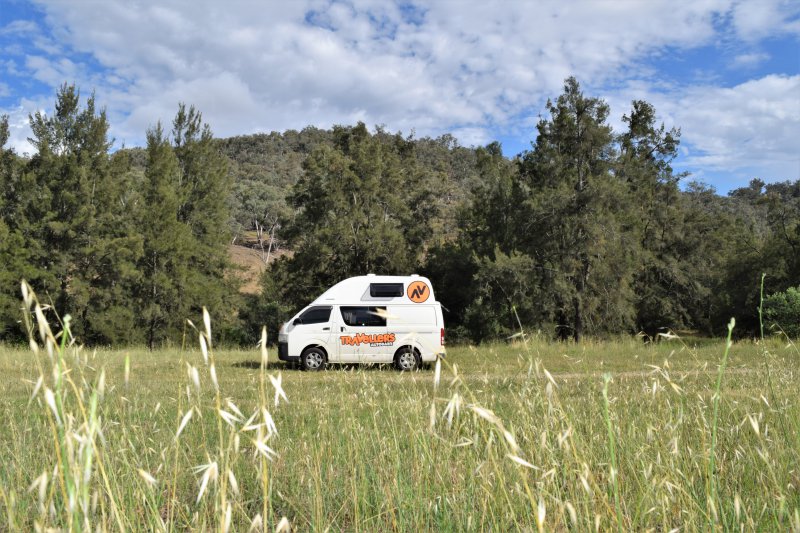
The large bed could easily be converted to a seating area, but since we traveled in November and December we spent most of our time outside.
The curtains let in very little light, which was nice because the sun came up quite early in the South. During our trip we never had any issues with the car, it was well-maintained and clean.
In the infographic, you can see that the daily rental costs for the campervan were €63 / 93 AUD . These costs are divided into 2 categories:
Rent of the campervan
Costs for petrol.

Daily rental costs
I was fortunate to work with Travellers Autobarn and received a discount on the daily rental price of our Kuga. With this discount, the costs per day for the camper van were €47 / 70 AUD .
The only insurance we added was a 75 AUD payment to insure any damage to the windshield.
We didn't take out any additional insurance to reduce our bond liability (in case of an accident we would have had to pay up to 2500 AUD).
It's always a gamble whether or not insurance will be worth it or not. During our New Zealand road trip I bumped into another car and I was very happy we had taken out additional insurance.
During our Portugal road trip we paid for extra insurance as well but didn't need it, so we kind of wasted that money.
In the end you won't know what's smart until you hand the vehicle back in, damaged or not. It's up to you if you want to risk it;-).
Check prices online
Depending on the season, the type of campervan you want to rent and the additional items you choose you can pay as little as 35 AUD per day .
You can see the different types of vans and get a quote on the Travellers Autobarn website .
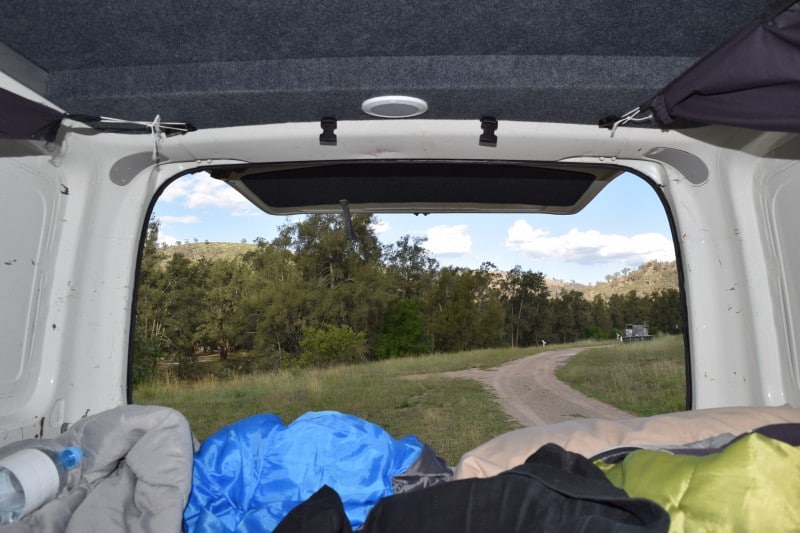
Fuel isn't cheap in Australia and distances are big, so fuel made up a significant portion of our daily expenses (17%) .
On average we paid €16 / 23 AUD per day. We fueled up on either Unleaded 91 or Unleaded 95. Not all gas stations sell 91, but at the ones that do this is usually the most economical option.
What really helped us to find the cheapest fuel option available was the Motormouth website (also available as an app).
The website shows the current price level of petrol stations all around Australia, there can be quite a big difference between them.
Checking the Motormouth website or app before fueling up can definitely help to save some money!

2. How to find budget accommodation and free campsites in Australia
In the infographic, you can see that the total daily costs for accommodation were €4 / 6 AUD . These costs are divided into 2 categories:
Paid campsites
- Airbnb accommodation
We slept in our campervan pretty much all the time and were pleasantly surprised by how many free campsites we found during our road trip.
We found these campsites via Campermate , a great free app where you can find information about the site and read comments from recent visitors.
Some of these free campsites even had free hot showers! During our six-week road trip we only paid for 2 campsites, the rest of the sites were free.
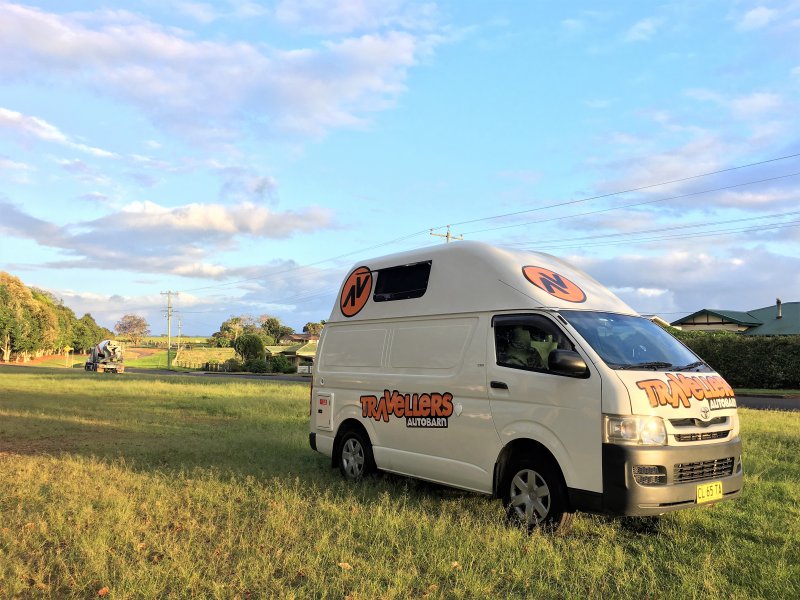
We stayed at an Airbnb in Brisbane (2 nights) and Melbourne (1 night). In Yamba and Sydney, we stayed with friends (3 nights), which was great and also saved us a lot of money.
3. Cost of food in Australia
The easiest and most effective way to save money in Australia is by cooking your own food. A cheap dinner will set you back at least €10/ 15 AUD per person.
Cooking your own meal will only cost about €10/ 15 AUD for a couple , so you'll already save 50% each day by making your own dinner!
We paid € 1 9 / 28 AUD for food and drinks on an average day. We made our own breakfast, coffee, lunch and dinner on 95% of the days. Every once in a while we bought a fresh fruit juice, pizza or steaming bowl of ramen.
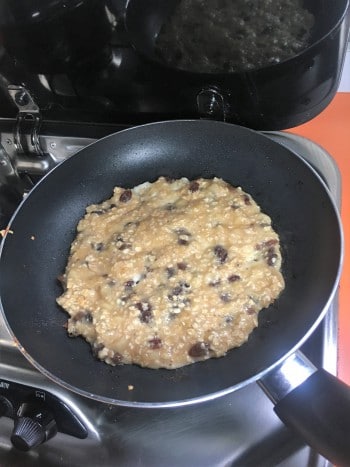
4. Activities and miscellaneous Australia vacation cost
The average daily costs in this category were €12/ 19 AUD . These costs can be split between:
Miscellaneous costs

Most days we went bush-walking, explored a beautiful beach or did some sightseeing in a village or city, these activities were free. However, we also did some pretty cool excursions in Australia.
We went scuba diving at the Great Barrier Reef, flew over the treetops with the Skyrail Rainforest Cableway and sailed around the marvelous Whitsunday Islands.
I worked with these companies and received a discount or complimentary trip, which saved us a lot of money.
This category is a little bit of everything, ranging from public transport in Brisbane, Sydney and Canberra to costs for laundry, a local SIM, postcards home, etc.
Plan your trip like a pro with these tools: ✈️ Find the best flight deals on Kiwi.com . ? Get the best car rental deal for your road trip on Rentalcars.com . ?️ Find your dream accommodation on Booking.com or Agoda . ? Book the best tours via Get Your Guide , Viator or Klook . ? Plan your journey with the Lonely Planet . ?️ Travel safely and get reliable travel insurance from Safety Wing .
Australia trip budget: in conclusion
That's all our Australia expenses! I hope this post has shown it's possible to travel to Australia on a budget and has inspired you to visit this beautiful continent!
Feel free to ask any questions you may have and enjoy planning your trip to Australia !
Also check this post about work and travel in Australia in case you're interested in getting an Australian work and holiday visa.
Also read about the best things to do in Sydney with kids and about places to visit in Daylesford .

This post was updated in October 2020.
Wednesday 4th of March 2020
Thanks a lot for this information. I wanted to know, we are doing a road trip from Cairns to Sydney on a campervan. The payment for the campervan has already been made so that’s counted. My question is, if we want to go diving on the Great Barrier Reef and to Whitsundays (basically that’s all we want to do as “paid” activities), do you think we, as a couple, can manage to spend an average of 60 eur per day? (This would be excluding the campervan as I mentioned above).
Do you have any details of your trips to Whitsunday and the great barrier?
Thanks so much!
Monday 16th of March 2020
Hi Beatriz,
That sounds like a wonderful trip! Regarding your question, well, it will be a bit of a tight budget as these two activities unfortunately don't come cheap... Sailing the Whitsundays is around 200AUD per person and diving is 300AUD for 2 dives and 320AUD for 3 dives. Without these activities, 60euro for a couple is definitely possible but if you really want to do these two activities I'd try and save another 1000AUD for your road trip (if possible).
You can find more information here: https://cruisewhitsundays.com/experiences/camira-sailing-adventure/ http://www.tusadive.com/prices/
Have a great trip! Lotte
Veronica Ricalde
Sunday 21st of October 2018
How safe is to stay in free Camping sites? we would like to go with two small Kids (6 months and 6 years) and my husband Freak out when i said that we can camp for free. do they have toiletts and showers? thank u and lovely regards
Thursday 25th of October 2018
Hi Veronica,
We never had any issues at the free campsites and I always felt safe. Free campsites usually do have toilets but no showers (though some do, but you may have to pay for the shower). In the Campermate app (https://www.campermate.com.au/welcome/index) you can find information about free (and paid) campsites. Keep in mind that some free sites are located along busy roads, which may not be ideal for you and your family. Enjoy your road trip!
Sunday 1st of April 2018
Hi Lotte! We are planning an East coast Australia road trip (4-5 weeks) in October and then on to New Zealand for 2 months. We will be using a campervan in both countries. How long in advance do we need to book the campervan to get the best deals? Can you still get a good deal a few weeks in advance or do they become really expensive by then? Thanks for your interesting blog!!
Monday 2nd of April 2018
Hi Charlotte,
Wow, your trip sounds awesome! Regarding your question, for Australia you'll be a bit ahead of the high season so I reckon you could get good deals there even if you don't book very early. For New Zealand however, you'll be traveling in peak season and I recommend to book as early as possible. While November may be easy to book, December is summer holiday for the Kiwis as well. Hope this helps! Have a wonderful time in Aussie and New Zealand!
Katie Farrant
Wednesday 17th of January 2018
Hey, I'm just wondering whether you will be uploading your Australia itinerary soon?! My partner and I are off there on the 31st Jan starting in Adelaide and going up to Cairns (by tours and greyhound) for 7 weeks. Would be great to read any recommendations you have for free/cheap activities. We have booked up a few tours- but the cost is adding up! We are off to NZ after Aus for 5 weeks and your blog made me decide to book a camper with car rental village! I can't wait!
Thanks for your comment and your trip(s) sounds great! Which tours will you be doing along the way? Yes, costs definitely add up but luckily many hikes and sightseeing in cities/villages is free. I'm working on the itinerary post, it's going to be very long (5000+ words;-). My goal is to publish the post this week because I start a new job on Monday. Perhaps you can subscribe via RSS feed so you'll receive an update when the article goes life?
So cool you'll be going to NZ as well, it's still my favorite country in the world... Have a great trip and let me know if you have questions about the itinerary once it's published.

All Destinations , Australasia , Australia
This is what it costs to travel australia.
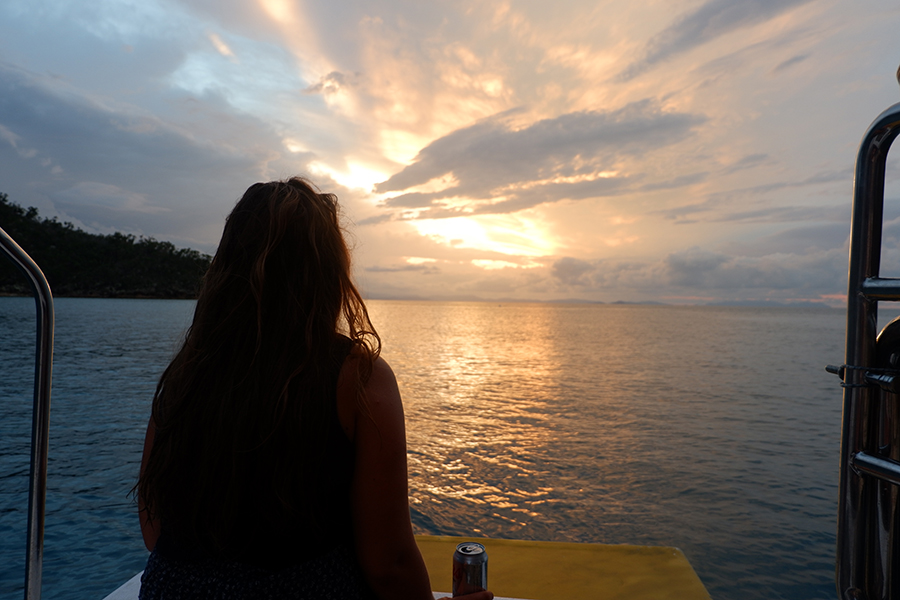
Australia: it’s an adventure, but it’s expensive . Especially if you’re not planning on working in Australia, travel there can put your bank account under a lot of strain. But there are plenty of different ways to enjoy Australia, for all budgets; whether you’re backpacking Australia on a shoestring or have a little bit more money to enjoy the luxuries. Here, I look at the cost of travel in Australia and how you can tailor make an Australia travel budget so you can enjoy the very best of the country while not bankrupting yourself in the process. Sound enticing?
It’s hard to make a one size fits all travel budget for Australia because there are so many different ways to explore the country. Some people want to stick to the hotspots of the east coast, others are keen to free camp their way up the west. Some may favour a whistle-stop tour to Uluru, the Top End, the Great Barrier Reef and the southern cities of Sydney and Melbourne, while others prefer to slow travel around the continent.
I’m going to explore some different trips and different budgets, so you can select the best fit for your desires and requirements. Also note that I have itineraries on every route (and more!) specified. You’ll find the links below!
Getting There Costs

As you may know, Australia is a long way from everywhere. It is fairly expensive to reach from anywhere other than Asia, but you should be able to find some fairly cheap deals if you’re flexible with dates, airports and airlines. It might also be a good idea to spend some time in Asia before flying over as it both breaks up the journey and often works out cheaper.
The first time I entered Australia, I flew from Hong Kong to Sydney with a 2 day stopover in Singapore. It cost me £180/ $312 AUD/ $231 USD. The second time, I flew from Bali to Darwin – probably the shortest international plane journey from Australia. This was cheap as chips, costing me around $40 AUD/ £23/ $29 USD. On my way home from Australia, I flew from Melbourne to Chongqing, had 3 days in Chongqing and then flew to London Gatwick from there. The total cost was around £400.
There are so many different routes through Asia, so there will most likely be one that isn’t too bank-breaking.
Unless you’re from New Zealand, every nationality needs a visa for Australia. Luckily, it can easily be obtained online and the tourist 3 month visa is free.
If you want to work, you’ll need to apply for a working holiday visa. The type that you’ll need depends on where you’re from, and it also determines what kind of work you can do to extend your visa. People from the states used to get a bad deal, as they couldn’t extend their visas – but now their options for regional work are waaaay better than those on the other visas!
The working holiday visa costs $450 AUD. You can also use this visa even if you don’t have an intention of working and just want to holiday in Australia for a year (although you’ll have needed to save up a lot for this!!).
You can apply for the visa on the Australian government website or on a site like e-visums.co.uk .
Working in Australia
If you’re planning on a working holiday visa in Australia, you may need to provide evidence of having at least $5000 on arrival. This money will likely go on accommodation and living expenses before you find a job; although if you’re savvy and get a job quickly you could obviously save a big chunk of this – I didn’t get a job for 6 weeks after I arrived in Australia and I only spent $1500.
Working in Australia is a great way to save money, because they pay a mint. I’m talking $20-$30 an hour for restaurant and bar work, and $40+ an hour for labouring. Some of the best places to earn money are Sydney, Melbourne and Perth – although they are also expensive to live in.
I worked in Byron Bay, which may well be the worst place in Australia to work, but the best to live :). It’s difficult to find jobs in Byron Bay because everyone wants to live there, and any job offers only pay minimum wage! The place changed my life though , so I’m happy to be skint for it.
A lot of backpackers aged 18-30 tend to work when they get to Australia and use that money to travel. Not a bad way to do it…
Travelling in Australia – The Routes
East coast – cairns to melbourne.
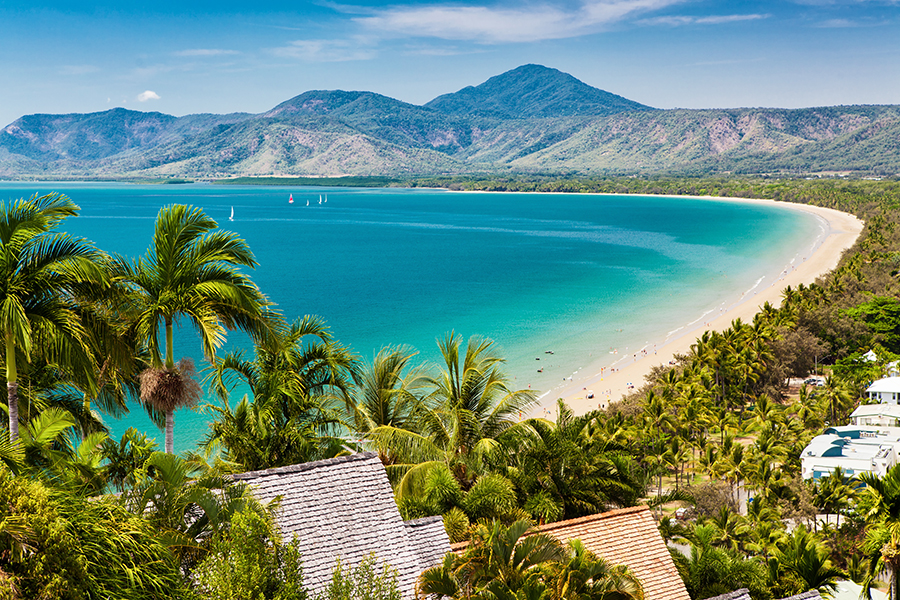
The east coast – from Cairns to Brisbane, Sydney or Melbourne, is the most popular backpacker odyssey in Australia. Pricey hostel rooms and eating out can make it expensive, but there are lots of ways to save money as you go.
Splurge and do it all – 6-8 weeks from Cairns to Melbourne
Accommodation: This budget includes 42-56 nights in hostels. At an average of $30 per night, this would result in $1260-$1680 on accommodation.
Transport: A hop on, hop off Greyhound bus from Cairns to Melbourne pass costs $549. Note that it is cheaper if you just do the Cairns to Sydney or Cairns to Brisbane portion of the road trip. Campervan hire starts at around $1,130.04 and petrol costs about $1200. This would be split by whoever is in the car, of course.
Note: if this isn’t your only Australia road trip I strongly recommend you buy a car or campervan rather than hiring one. It works out a lot cheaper in the long run and you have more freedom.
Activities: Here is a list of all the activities that you would want to include on your ultimate east coast adventure and the average costs:
- Daintree Tour – $150
- Great Barrier Reef Dive – $150
- Skydive – check out Byron Bay skydiving here .
- Whitsunday Cruise – $350 – see tour options here .
- Magnetic Island Package – $118
- Scooteroo tour of 1770/ Agnes Water – $85
- Surf Lesson in 1770 – $25
- Fraser Island – $494 – click through for tour options .
- Noosa Everglades Tour – $115
- Blue Mountains Tour – $119
- Wilson’s Promontory Tour – $135
- The Grampians Tour – $124
- Great Ocean Road Tour – $114
Food: For food, budgeting around $30 per day allows for two purchased smaller meals and one larger meal out. If you’re travelling for 8 weeks, that’s $1680.
Alcohol: drinking around 20 beers or glasses of wine out per week will cost $100-$160 – so anywhere between $600 – $1280 for the entire trip. If you get through a box of goon or ten beers per week bought from the bottle’o as well, you’ll be looking at another $100ish+ for the entire trip.
Save a little – 6 weeks from Cairns to Melbourne
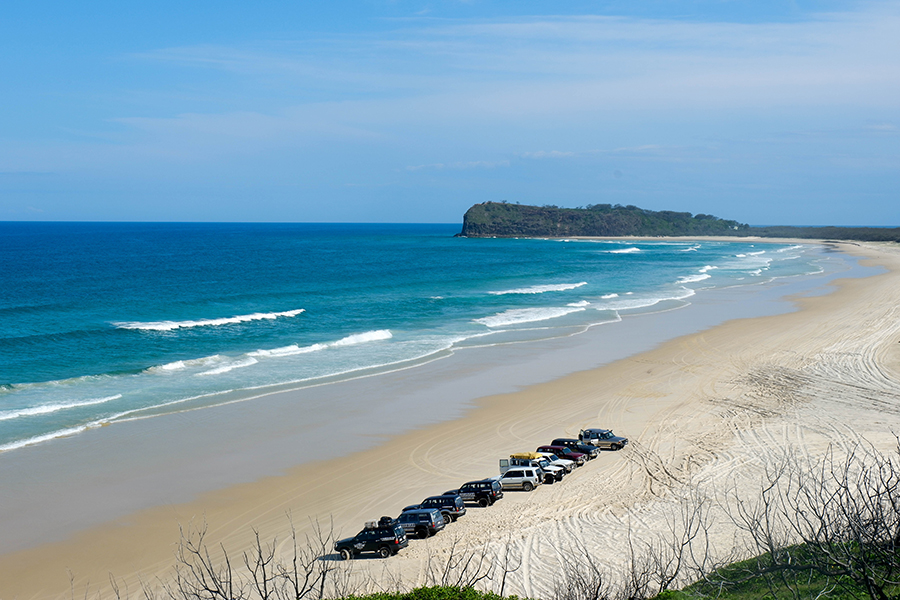
When I backpacked the east coast, I fitted into this category. A budget for 6 weeks in Australia includes all of the best tours, a mix of hostel stays and nights in free camp sites, some beer and goon and both cheap meals (and far too many subway sandwiches) out and self-cooked meals.
Accommodation: staying in hostels on the east coast enables you to meet other travellers and be in a great location for the activities; so you will want to stay in them at some points. If you were to stay in hostels half the time and free camp the rest of the time, you’ll spend around $620. This can obviously be cut down depending on how often you’re willing to free camp. Some hostels, like Nomads in Airlie Beach and Southern Cross Backpackers 1770, have camp spots/ places you can sleep in your car for less.
Transport: the most budget-friendly way to see the east coast is to find a ride share, which means that you’ll just be paying for your share of petrol. Depending on how many of you there are sharing the petrol, you’ll be paying $300 to $600 for the whole journey. Of course, you might want to buy your own car and see the coast this way; this is a financial commitment, but you’ll be able to get some money back when you sell it. Fuel costs around $1200 to travel from Cairns to Melbourne.
Or you could look at renting a car; which is not too expensive when split with friends. The greyhound pass is another option, costing $549, but it’s unlikely you’ll be able to stay at free campsites doing so. If you don’t have another option, you’ll be able to save on your trip in other ways.
Activities : There are a few tours that you really have to do to get the essential east coast experience. My must-dos were:
- The Great Barrier Reef – $150
- Whitsundays – $350
- Fraser Island – $449
Some self-drive trips can all be done in a tour too, but if there’s more than one of you it’s nearly always cheaper to drive – even when factoring in car rental costs. These excursions include:
- Daintree Rainforest National Park
- Atherton Tablelands
- Magnetic Island (not strictly self-drive, but the ferry over costs $33 reutrn)
- Byron Bay’s hinterland
- Coffs Harbour’s hinterland
- Blue Mountains
- Wilson’s Promontory
- Great Ocean Road
- The Grampians National Park
Food: You can get by on the east coast on a budget of $15 – $20 per day, which includes a mix of eating out and cooking for yourself. That’s around $735 for yer whole trip.
Alcohol: Limiting yourself to 10 $5-$8 drinks per week means that you’ll spend around $80 on drinks out every week – $480 for your entire trip. Add in a box of $12 goon each week and a $20 box of beer and you’re looking at $672 on alcohol for your six weeks on the east coast.
Scrimp and save – 4 weeks from Cairns to Melbourne
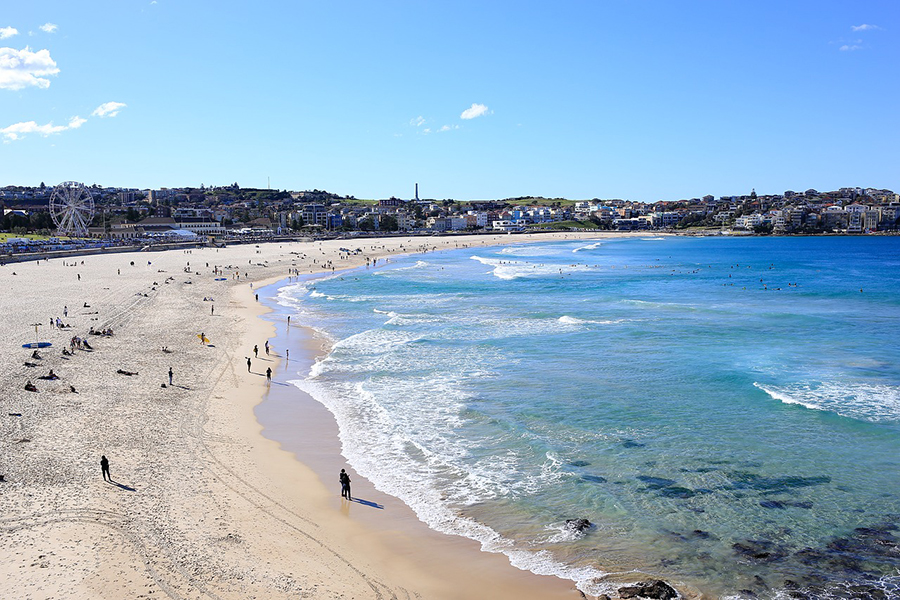
Accommodation: free camping up the coast will leave your wallet happy by costing you absolutely nothing! Check out my post for free camping tips .
Transport: A Greyhound Pass won’t cut it for this one – you’ll need to find your own (or someone else’s wheels) to really budget on the east coast. Making a mate who has their own car means that you’ll save a ton by just chipping in for petrol – you’ll pay between $600 – $300. Alternatively, buy or rent your own whip – rental can be pricey but can be split with friends, but if you buy a car and sell it at the end of your trip you’ll make a lot of the money back.
Activities: depending on your budget, you could just commit to the free things on the east coast, which includes national parks like Noosa national park, exploring towns like quirky Byron Bay and the cities of Brisbane , Sydney and Melbourne , and enjoying the thousands of kilometres of beautiful beaches. I do recommend the Great Barrier Reef, the Whitsundays and Fraser Island trips highly; but pick and choose which you can afford and which interest you the most.
Food: If you’re organized and don’t impulse buy food, it’s easy to get by on $5 a day for cheap supermarket bought ingredients. This will cost you a total of $140 for the whole trip.
Alcohol: of course, you could not drink at all on the east coast, slashing your alcohol expenditure. If you can’t face that, a box of goon a week will cost you $12 per week or $48 for the entire trip.
The Tour Option
While the east coast is very easy to travel solo, there are also lots of pre organised tours that plough the route. This is a great idea if it’s your first time travelling, if you’re on your own or are short on time.
West Coast – Perth to Broome

Splurge – a guided tour
There are lots of ways to save money on the west coast, but a guided tour isn’t one of them. However, if you don’t have access to a car, this is the only way to see the west – and it’s not to be missed.
Mid-range – 3 weeks from Perth to Broome
Accommodation: if you favour a roof over your head, you can stay in hostels when available. This isn’t possible everywhere on the west coast but can be found in some towns. Alternatively, opting for paid-for campsites means you’re guaranteed a shower and a camp kitchen. If you’re avoiding free campsites where possible, you’re looking at spending around $450 on accommodation for 3 weeks.
Transport: if you have your own car, or can share a ride, then you’ll just be paying for petrol on the west coast. It comes to about $1200 for the whole distance from Perth to Broome (with some side stops). If you need to hire a car, rates start from $2000 – $3000 for 3 weeks.
Activities: you’ll save money on activities on the west coast – there are nowhere near as many paid-for as the east. Some highlights include:
- National Park Entry – $40 for every Western Australia national park for 6 weeks
- Whale Shark Tour from Exmouth – $400 – book a whale shark tour in advance here or learn more about a tour swimming with humpback whales .
- Diving at the Navy Pier (for certified divers only) – $140
Other amazing parts of the west coast, like beautiful beaches and national parks, are completely free.
Food: spending $15-$20 per day on food will enable you to eat quite well, eating out where possible. That’s $315 – $420 for the whole trip.
Alcohol: you won’t be hitting up many bars on the west coast, but if you’re buying a couple of boxes of beer each week you’ll be looking at around $40 per week, or $120 for the entire trip.
Save – 2 weeks from Perth to Broome

It’s possible to do the west coast road trip very cheaply, paying for only petrol and food. Here’s how much it can cost if you’re really looking to save.
Transport: if you have a vehicle sorted, just paying for petrol will cost around $1200 – split between however many people there are in the car.
Accommodation: you can free camp the whole way up the west coast, with the only exception being in Karijini National Park. You’ll want to spend at least 2 nights there and there are no free campsites within the park. Dales Campsite costs $10 per night, so $20 in total.
Food: if you’re very organized (there aren’t many Woolies or Coles along the west coast!) and are prepared to eat mainly tinned food, you can still get by on $5 per day for food. That’s $70 for two weeks.
Alcohol: if you’re really budgeting, alcohol should be omitted from your west coast expenditure.
Activities: the whale shark tour is one of the best things I’ve ever done, but it is expensive. If you don’t have the dollar, stick to a national parks pass, which is $40 for a vehicle and can be split with your travel mates.
The Centre – Darwin to Adelaide
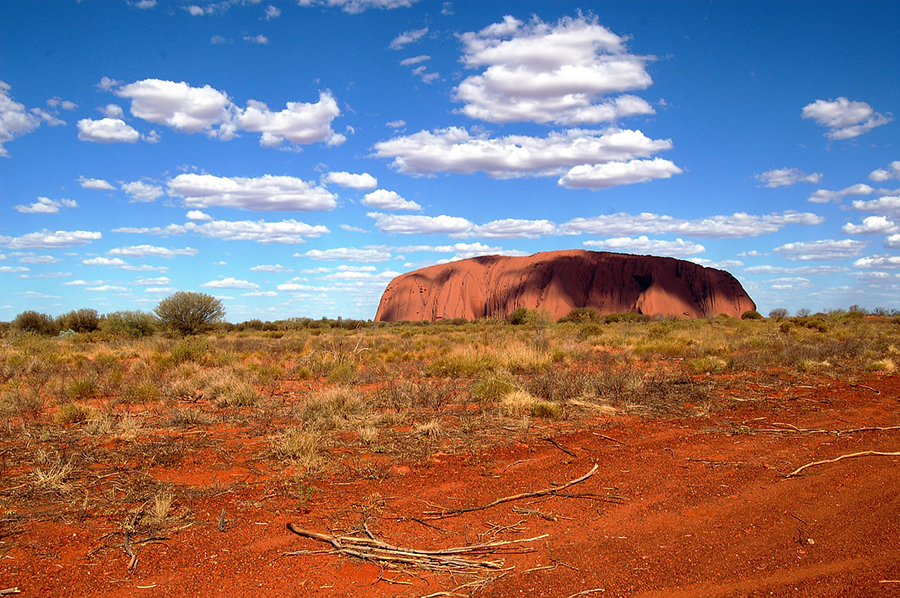
The Red Centre is one hell of a road trip. Spanning from the tropical top end, through some of the world’s most inhospitable desert and ending in temperate Adelaide , it’s a wonder why more people don’t do this voyage.
The Darwin to Adelaide road trip can be done cheaply or expensively, depending on how you want to travel.
Splurge: Guided Tour
Taking a guided tour is the most expensive option, but is essential if you don’t want to drive or rent a campervan.
Mid-Range: 3 week road trip
Accommodation: staying in proper campsites and hostels will set you back between $10-$30 per night. Campsites normally cost around $15-20, with hostels coming in at $25-$30. Because of the remoteness of a lot of places on the Darwin to Adelaide road trip, hostels are not available everywhere. If you’re paying for accommodation every night, factor in around $400.
Transport: around $1000 for petrol will get you through Kakadu and down the red centre to Adelaide. Factor in more if you want to take the Oodnadatta Track or the Red Centre Way. If you need to hire a vehicle, you’re looking at at least $2000, which can be split between you and your travelmates of course.
Activities: Kakadu National Park costs $40, which goes into preserving the park. The Uluru-Kata Tjuta National Park costs $25 to enter. Don’t climb Uluru , by the way. All other national parks, and most other attractions are free. You might want to spend a bit of money seeing some attractions in Alice Springs (the desert park for example is $20). Budget around $100 to see all the attractions.
Food: food can be purchased in roadhouses and in towns or cities with restaurants, but often you’ll be cooking your own meals as well. If you want to eat out where possible, factor in $10 – $15 per day on food – so $210 to $317 for your whole trip.
Alcohol: prices at campsites and remote pubs and bars can be high. If you’re buying a couple of drinks every night, you could easily be spending $25 per night, so $525 for your whole trip.
Budget: 2 weeks
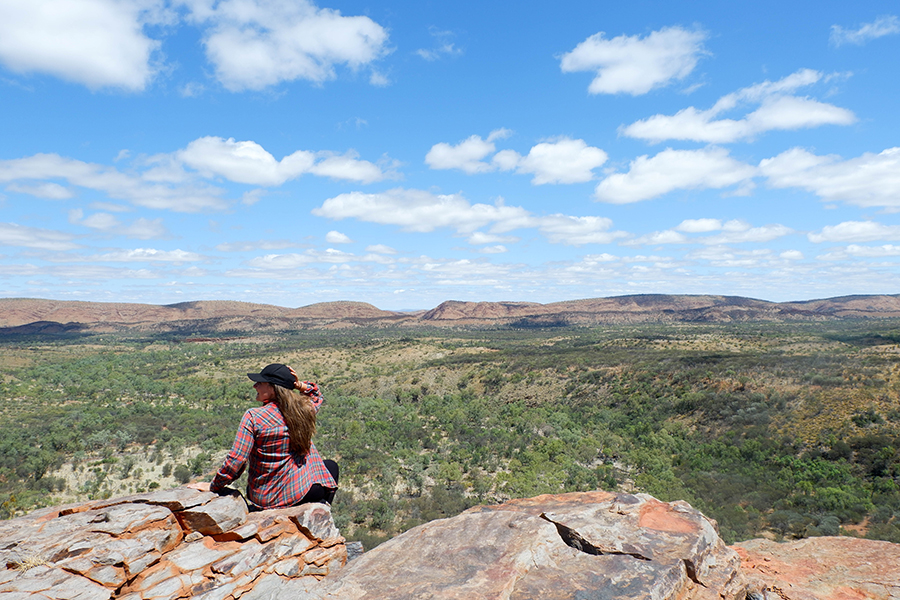
Accommodation: you could free camp pretty much the whole way (maybe paying for accommodation in Alice Springs as there are not any free campsites in the city that I am aware of) for $0. If you stay a night in Alice, you’ll end up spending just $30 for your whole trip.
Petrol: Petrol will be as before – around $1000. If you’re really stuck for cash, try and find someone with a car rather than renting one.
Activities: Unless you really have no money, Kakadu is an absolute essential. It’ll be like nowhere you’ve ever been – so do try to find the $40 from somewhere, even if it means selling your soul… Uluru as well, is obviously pretty essential for anyone travelling in the red centre. When you see the incredible amount of work that goes into protecting the nature, you won’t mind spending the money. This means you’ll be spending a minimum of $25, but probably $65 on attractions.
Food: If you’re on a super budget, food can easily be had for $5 per day. This comes in at the princely sum of $70 for food for two weeks.
Alcohol: just like elsewhere in Australia, a couple of boxes of beer a week will set you back $40 – so $80 for the whole trip.
The North West – Broome to Darwin

The north west road trip is one of the most spectacular experiences in Australia. The Kimberley region is home to beautiful waterfalls, red outback roads and gorgeous gorges (pun intended). It’s not too expensive, as it’s one of the shorter road trips on this page, and there’s no hotel or hostel accommodation for the bulk of this route. That’s right, camping is necessary.
Accommodation: On the Gibb River Road , there aren’t many free campsites. So budget around $70 for the whole trip to stay on campsites en-route.
Transport: prices are high on the Gibb River Road – if you can take a few tanks and fill up in Broome it is recommended. I’d say you’re looking at paying between $500 and $700 for the whole road trip – obviously if this is split between a few of you prices go down.
Attractions: The delightful bit about the Gibb River Road is that pretty much everything that you need to do is completely free! Windjana Gorge has an entrance fee of around $14, but all other gorges, waterfalls and parks are totally free. If you do have some spare cash, you might want to do some tours on Lake Argyle. You can do sunset cruises or lunch cruises on the river, which are absolutely spectacular. I’d also recommend staying at the Lake Argyle Campground when you get there – the infinity pool is a great respite after the madness of the Gibb River Road!
Food: You won’t be able to spend much on food – for the same reason – there isn’t much available! Make sure to pack lots of tins and not too many perishables unless you have a coolbox – the car gets hot during the days. Budget around $10 per day per person – this includes a meal at El Questro when you reach it, and one in Kunannurra as well.
Alcohol: Like with restaurants, there aren’t that many places to buy booze on the Broome to Darwin road trip. I’d recommend spending the time disconnecting and enjoying nature, but if you do want some beers, grab a 10 pack for around $20.
Please note, that the Gibb River Road is a very unsealed and bumpy road. Please get your car serviced, at least before you leave Perth, to check that there is nothing that would cause it to break down in the middle of the road. Make sure you have a spare tyre – or two if you can accommodate them. I burst a tyre on the road, it is very easily done. If I’d burst another one, I would have had to be towed off the road and fork out an extortionate bill.
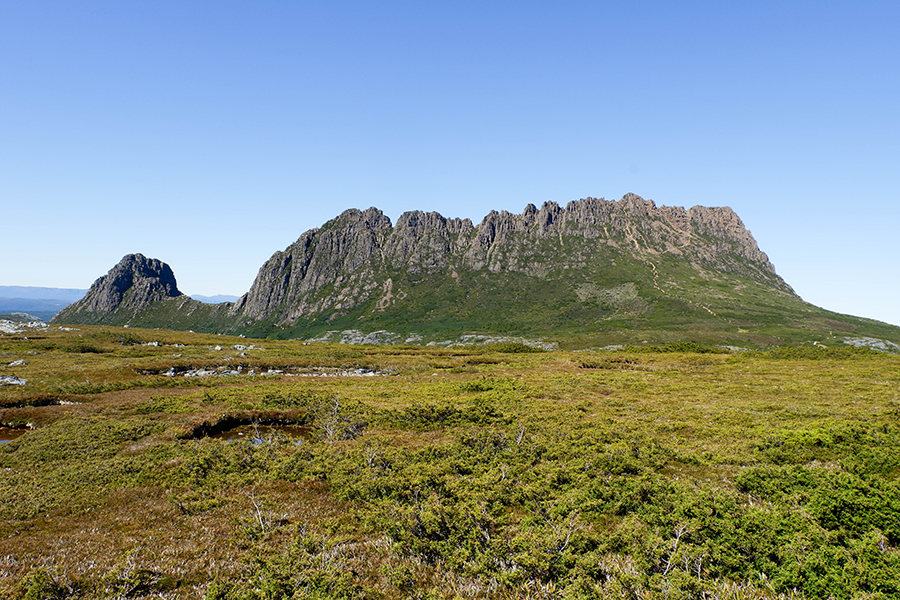
Tasmania, the island state to the south of Victoria, is somewhere that’s beauty is still not widely known about by backpackers. Sometimes known as the love child of Australia and New Zealand, there’s so much to explore on a Tasmania road trip that will leave you awe-struck. And best of all, it’s pretty cheap!
Accommodation: it’s entirely possible to free camp all the way around Tasmania; and actually, there aren’t that many hostels. You might want to stay in a hostel in Hobart to freshen up, so factor in around $30 for this. If you want to stay in Hobart for a few days, budget around $90 for accommodation. If you’d rather stay in paid-for campsites, factor in around $15 per night.
Transport: budget around $500 petrol for your Tasmania road trip. This can of course be split between however many of you are in the car. If you need to rent a car, factor in these costs as well.
Activities: You’ll need to pay $60 per car for a parks pass. This can obviously be split between whoever’s in the car. MONA is an essential museum to visit – it’s an art gallery with a big difference. Tickets cost $28. The other activity worth seeing is the Port Arthur convict site which costs $39. You can, of course, take boat trips and do other activities in Tasmania, but you’ll be able to see the highlights without. If you’re visiting Tasmania on a budget, just factor the $60 (split between you and your travel mates) for activities – if you want to see all the highlights, they’ll cost $127.
Food: you can obviously do a big shop and cook for yourself, in which case I’d say around $30 – $40 a week is enough. If you want to eat at a restaurant, budget between $10 and $20. Based on eating out twice a week and doing a food shop, food should set you back around $315 for three weeks.
Alcohol: Tasmania is another place that is best enjoyed sober, but if you do want to drink, the best/ cheapest bet is to buy whatever you want from the bottle’o. You know the drill. If you’re road tripping for 3 weeks and want to get two boxes of beer a week, that will work out to be $120.
Cost for 7 Day Trip to Australia
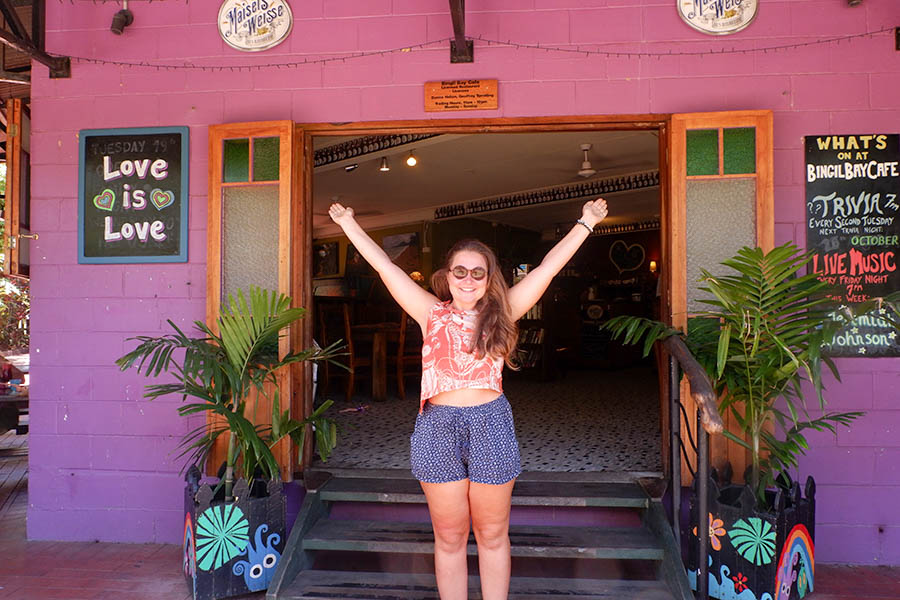
Australia is a huge country, and unless you’re travelling from New Zealand, Papua New Guinea or Indonesia, it will take a while to get there. Becaues of this, I really wouldn’t recommend just spending 7 days in Australia – but if you do, it’s best to stick to one state, city or territory or take a couple of internal flights.
As this is primarily an overland travel blog – and I never took an internal flight in Australia – I can’t recommend internal flights too much, but Jetstar, Virgin Australia and Qantas all offer internal flights to the major cities for fairly reasonable prices.
If you’re spending 7 days in Melbourne , expect to spend $40-$200 per night on accommodation. Budget $30 per day if you’re eating 2 meals out, or $10 per day if you’re cooking at your accommodation – check out this review of lentils as anything for a great sustainable budget-friendly restaurant. Essential paid-for activities in Melbourne include the Melbourne museum and the Immigration museum – other attractions like the AMCI and Hoiser Lane are free.
From Melbourne, you can day trip to some of Victoria’s best national parks and towns. Budget around $114 for a Great Ocean Road tour , $130 to visit the Grampians National Park and $80 for a trip to Ballarat (taking the train), a historic goldrush city. Check out this guide to visiting Melbourne on a budget for more information.
Sydney has a similar budget, with hostel dorms costing a minimum of $35 and some being more like $50, and hotel rooms costing $100-$200 + per night. Budget a similar amount for eating – $10-$30 per day will enable you to eat fairly decent food. A lot of attractions in Sydney are free – but the Australian Museum costs $10 to enter. Tours from Sydney include the Hunter Valley Wine Region and the Blue Mountains .
If you want to see some of Australia’s northern highlights, you could see Darwin and Kakadu, and then fly to Alice Springs to see Uluru. This is a pretty costly option; accommodation in Darwin costs $30-$200 per night, a Kakadu tour will cost $540, flights from Darwin to Alice Springs cost at least $200, accommodation in both Darwin and Alice Springs costs anywhere from $30 – $200 per night and an Uluru tour from Alice costs $395.
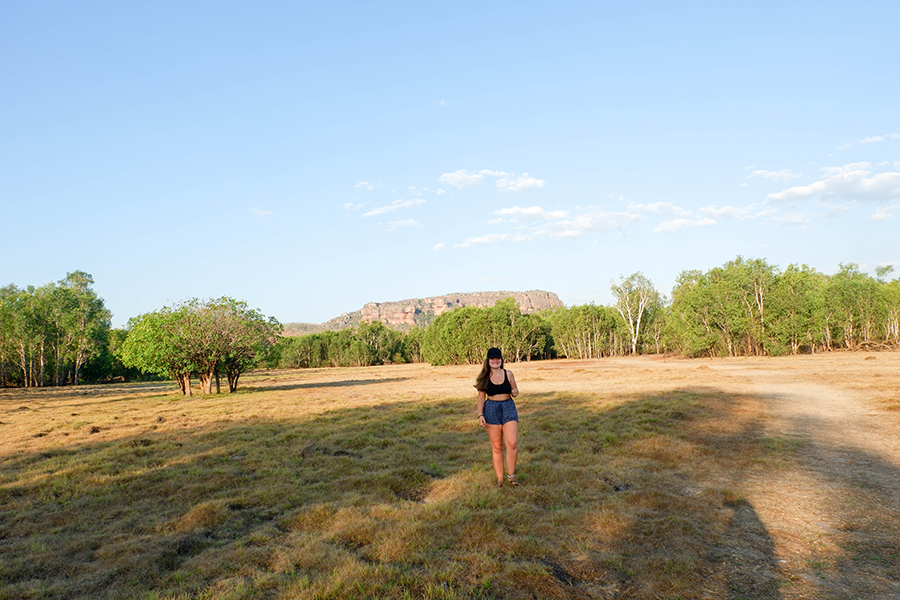
Or you could explore the Cairns area, doing a Daintree rainforest tour (expect to pay around $150), dive the Great Barrier Reef for $150+ and take a Greyhound bus to Mission Beach (prices start at $25) and then to Townsville (for around $44) and then the ferry ($33) to Magnetic Island. Expect to pay between $20-$120 per night for accommodation in Far North Queensland, with meals out costing betwen $20 – $30 and beers being around $8.
If you only have 7 days in Australia, consider spending them in Tasmania. Basing yourself in Hobart will enable you to see the best parts of the island state. You can take tours to Mount Field , Cradle Mountain and Wineglass Bay and pay between $20 – $120 per night for accommodation. Meals in the city cost around $20 and beers are around $9.
Australia Spending Money Per Day

As you can see by the huge, huge disparity of prices on this cost of travel in Australia guide, the spending money per day in Australia ranges hugely. Here’s what I reckon to be an average, based on my experience and my cool algorithm I’ve made up.
Note that all costs do not factor in vehicle hire costs and fuel is based on 2 people sharing. If you are taking the Greyhound buses, you may have to save some money on eating out and alcohol to reach this target:
- East Coast Australia: $84 per day (based on 6 week road trip)
- West Coast Australia: $70 per day (based on a 3 week road trip)
- The Kimberleys: $42 per day (based on 2 week road trip)
- Darwin to Adelaide: $64 per day (based on a 2 week road trip)
- Tasmania: $23 per day (based on a 3 week road trip)
Of course, these can be made drastically cheaper or more expensive, depending which way you want to swing it.
If you’re in Australia on a 7 day trip, and are using organized tours, expect to pay at least between $100 and $200 per day. If you’re sticking to cities and staying in hostels, this can be lowered, but trust me the best part of Australia is its nature.
Average Cost of Trip to Australia
So, after all of these numbers, I guess you’re wanting to know what the coast of an average trip to Australia is? I’m gonna be honest.. I have no idea. It depends on how long your trip is (my 1.5 year trip was obviously a lot more than a 7 day trip!), your travel style and where you go. I could pluck a random number from thin air, but it probably won’t help much.
Did you like this post? Follow me on Facebook to stay updated – there’s still lots of Australia posts in the pipeline!
Some of these links are affiliate links. If you make a purchase using them, I may make a small commission at no extra cost for you . This is just one of the ways I can keep producing content like this for free!

- New Zealand
- The Philippines
- The Netherlands
- United Kingdom
- Inspiration
- Overland Itineraries
- Packing Lists
- Travel Tips
- Working Abroad
- Accomodation Guides
- Overland Travel
- Preserving Cultures
- Protecting Animals
- Living Abroad
- Work With Us
CURRENTLY IN: Canada

Trip To Australia Cost: Budget & Tips to Save Money
We’ve heard it over and over again. “ Australia is so beautiful! I’d love to travel there, but it’s just so expensive; there is no way I could afford it”. And we get it. The cost of living in Australia was exorbitant.
*This post may contain affiliate links, as a result, we may receive a small commission (at no extra cost to you) on any bookings/purchases you make through the links in this post. As an Amazon Associate, we earn from qualifying purchases. Read our full disclosure
A study by the World Bank in 2014 showed that based on the costs of goods and services in Australia, it is now the most expensive G20 economy in the world. Yikes!
How Much Does A Trip To Australia Cost?
But despite all of that, it is still possible to travel to Australia on a budget
You just have to know how.
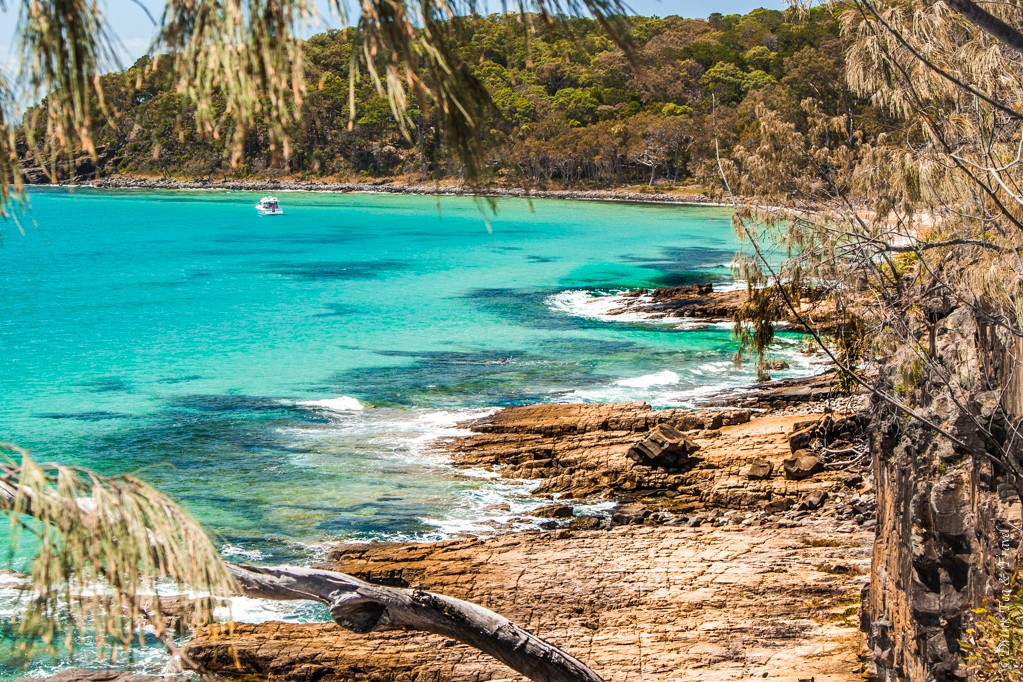
Traveling Soon? Here is a list of our favourite travel providers and accessories to help get you ready for your upcoming trip! Book Your Accommodation HERE Search for Great Tours HERE Get a Car Rental HERE Buy Travel Insurance HERE See our Favourite Camera Bag HERE Grab a Reusable Water Bottle HERE or a Filtration Straw HERE Order an eSim HERE
How Much Does It Cost to Go to Australia
If you are travelling to Australia on a budget from Europe or North America, your flight will make up a good chunk of your total travel costs. Unfortunately, there’s no getting around this cost when it comes to a trip down under.
No matter what tips or tricks you use for travelling to Australia on a budget, a return flight to Australia costs you no less than AUD $1,400 and upwards of AUD $2,000+.
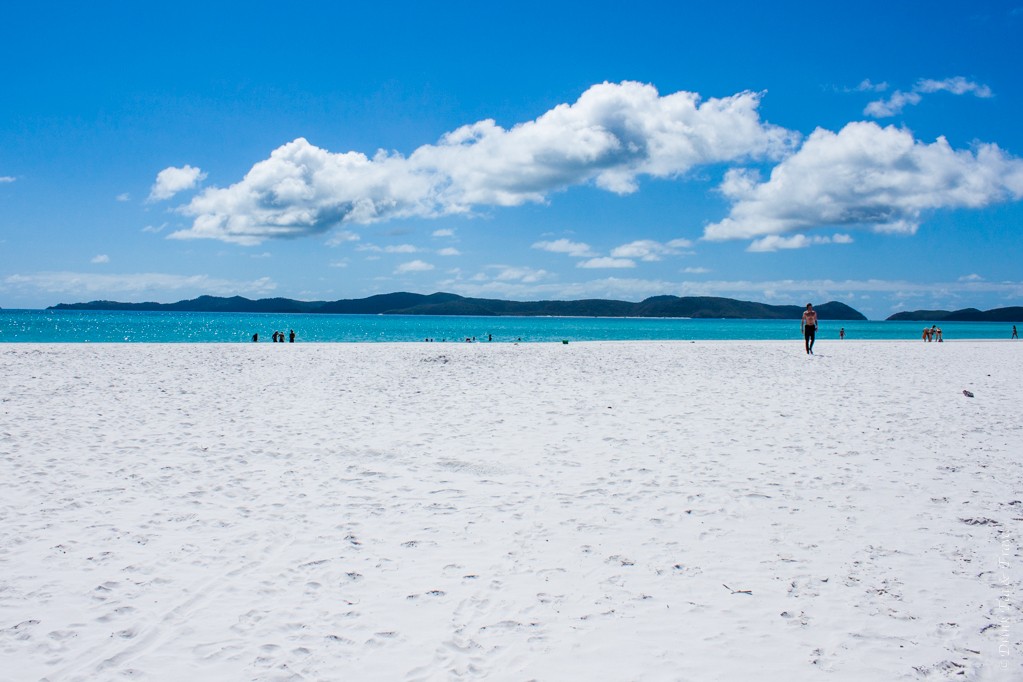
How to Save on Flights
Book your flights to Australia as far in advance as possible, no less than 6-8 months prior to your trip . Airlines often release early-bird prices as early as 12 months in advance, so keeping an eye out for specials may help you score a great deal on a flight.
Fly Into Main Cities
Sydney and Melbourne will have the most flight options and, thus, the best deals for flying into Australia from North America or Europe. But don’t discount Brisbane and Perth as the entry points, especially if you plan on staying in Australia for a while and can start/finish your trip in one of those Australian cities.
And keep in mind that (when possible) direct flights – or itineraries with only one layover – dramatically decrease carbon emissions, meaning your trip to Australia doesn’t have to cost the earth too!
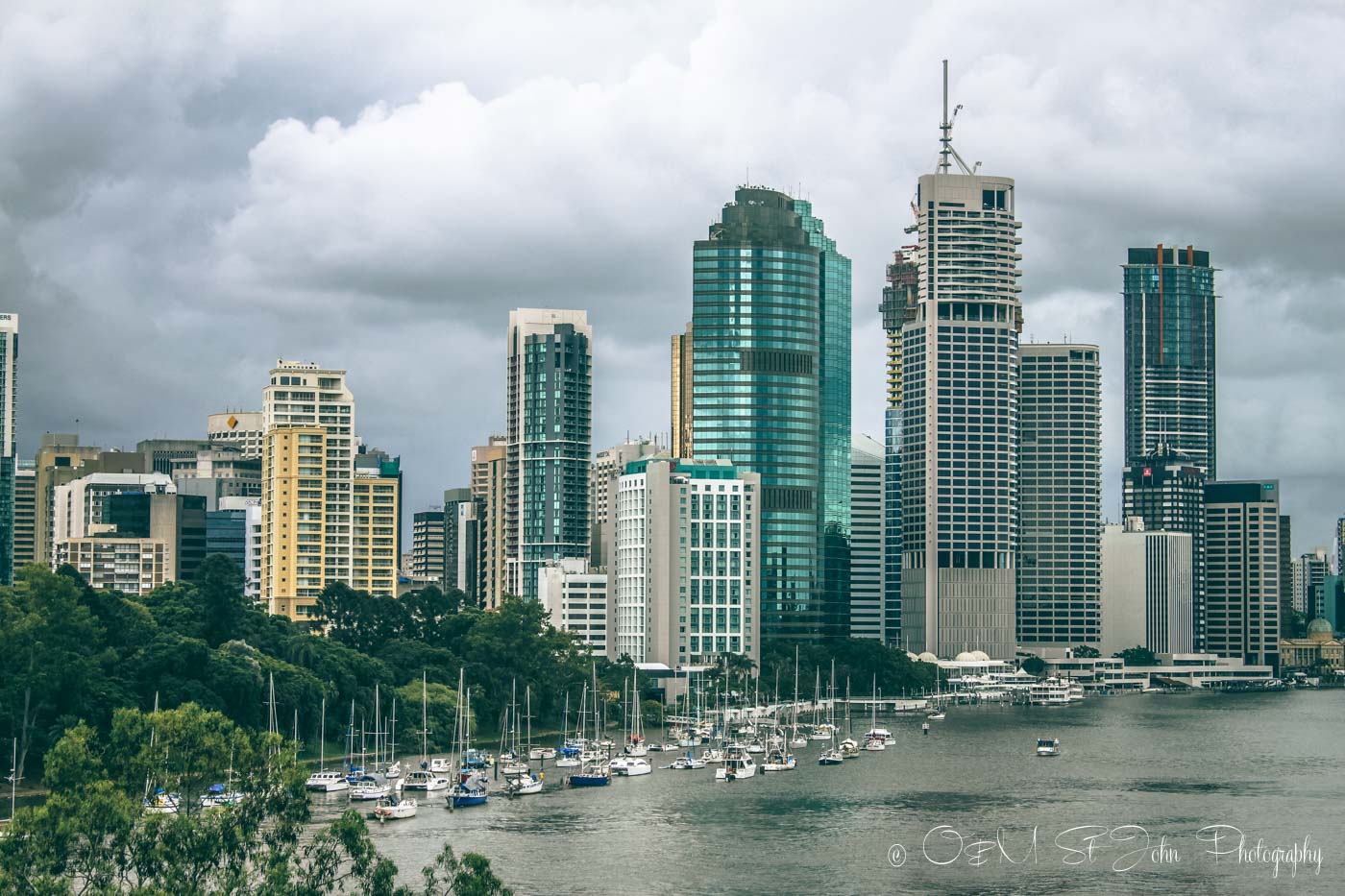
Do Your Own Research
Don’t rely on a travel agent to give you an amazing deal on a flight. Doing your own research and booking online might take time and effort, but it could easily save you a couple of hundred dollars (this goes for cheap car hire in Australia as well).
Google Flights is our go-to for finding the cheapest flights. It shows prices for different dates and flights precisely tailored to our needs, and the prices are spot-on. If you’re not looking to book right away, you can make use of the track prices feature. Plus, you can search for flights from multiple airports. You can also join the mailing list for cheap flights and deals.
If you are flying into Australia from Asia, use low-cost airlines like Air Asia or Scoot to grab dirt-cheap direct flights (as little as AUD$119-199) into Sydney, Melbourne, Perth, Adelaide, and Gold Coast.
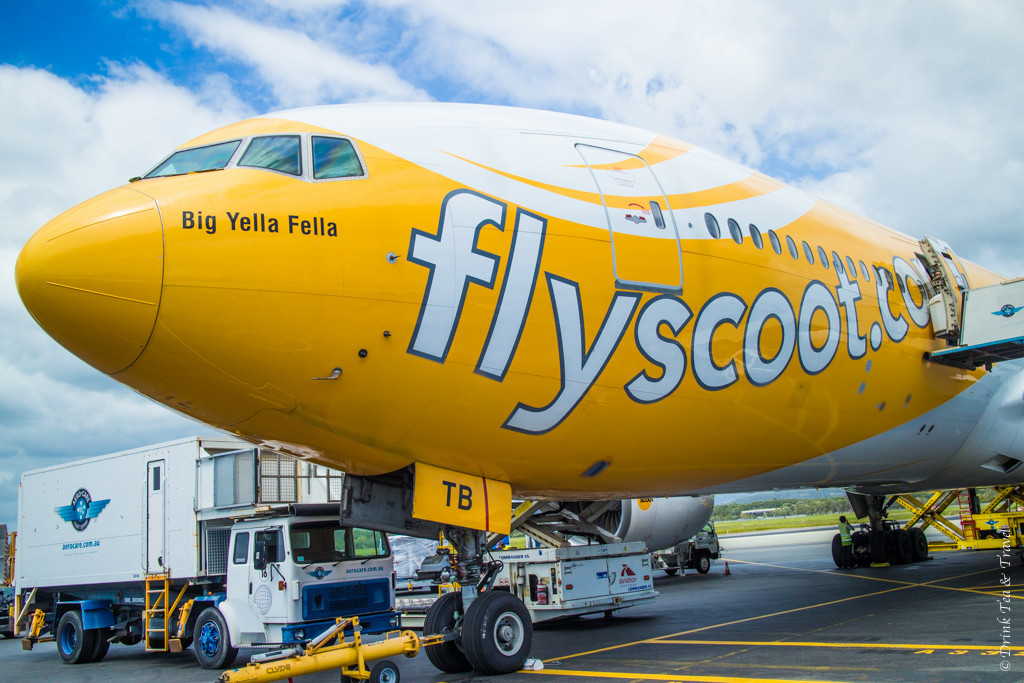
READ NEXT: How To Find Cheap Flights
How to Get Around Australia on A Budget
Once in Australia, your options for cheap ways to get around the country are plentiful. The biggest mistake travellers make when planning their trip around Australia is booking their domestic travel with Qantas and Virgin .
Don’t get me wrong, they are great airlines, and due to their worldwide recognition are often the ones recommended by travel agents and major booking sites. But they are not the best options for travelling to Australia on a budget.
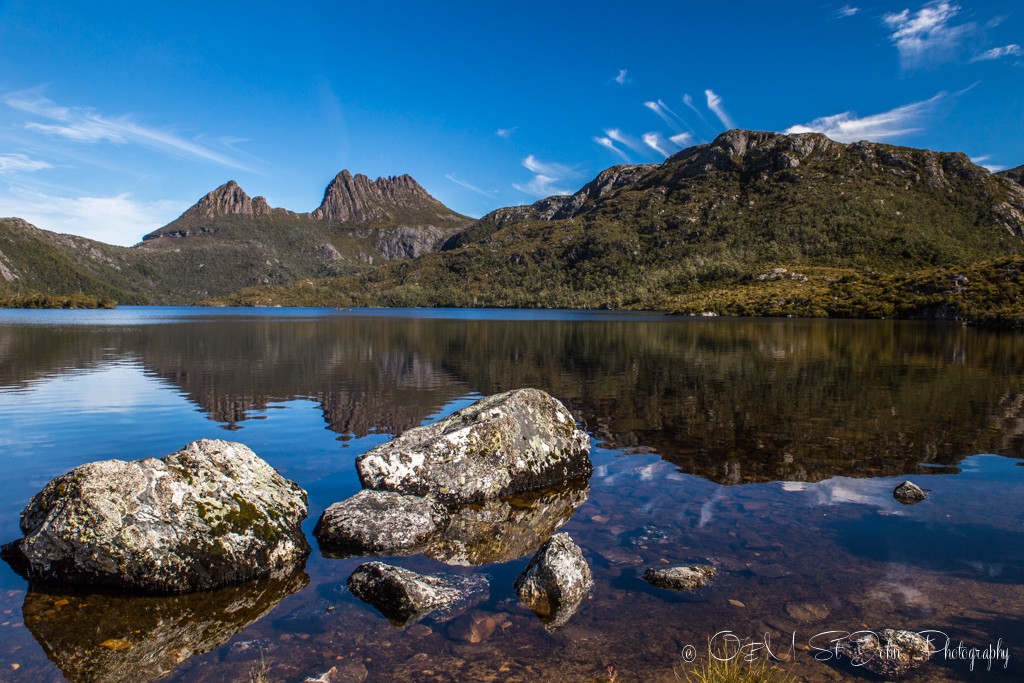
Use Low-Cost Airlines
Australia is a massive country, so if you only have a few weeks to spend here, travelling by air might be your best bet. It’s quick, easy, and doesn’t have to be expensive.
If your eco-conscience is feeling weary about multiple flights in one trip, it’s fast and easy to buy carbon offsets to counteract the emissions from your flights!
Jetstar , Rex , and Bonza (The latest entrant among Australia’s cheapest airlines) are 2 good low-cost carriers offering affordable flights with dozens of routes across Australia.
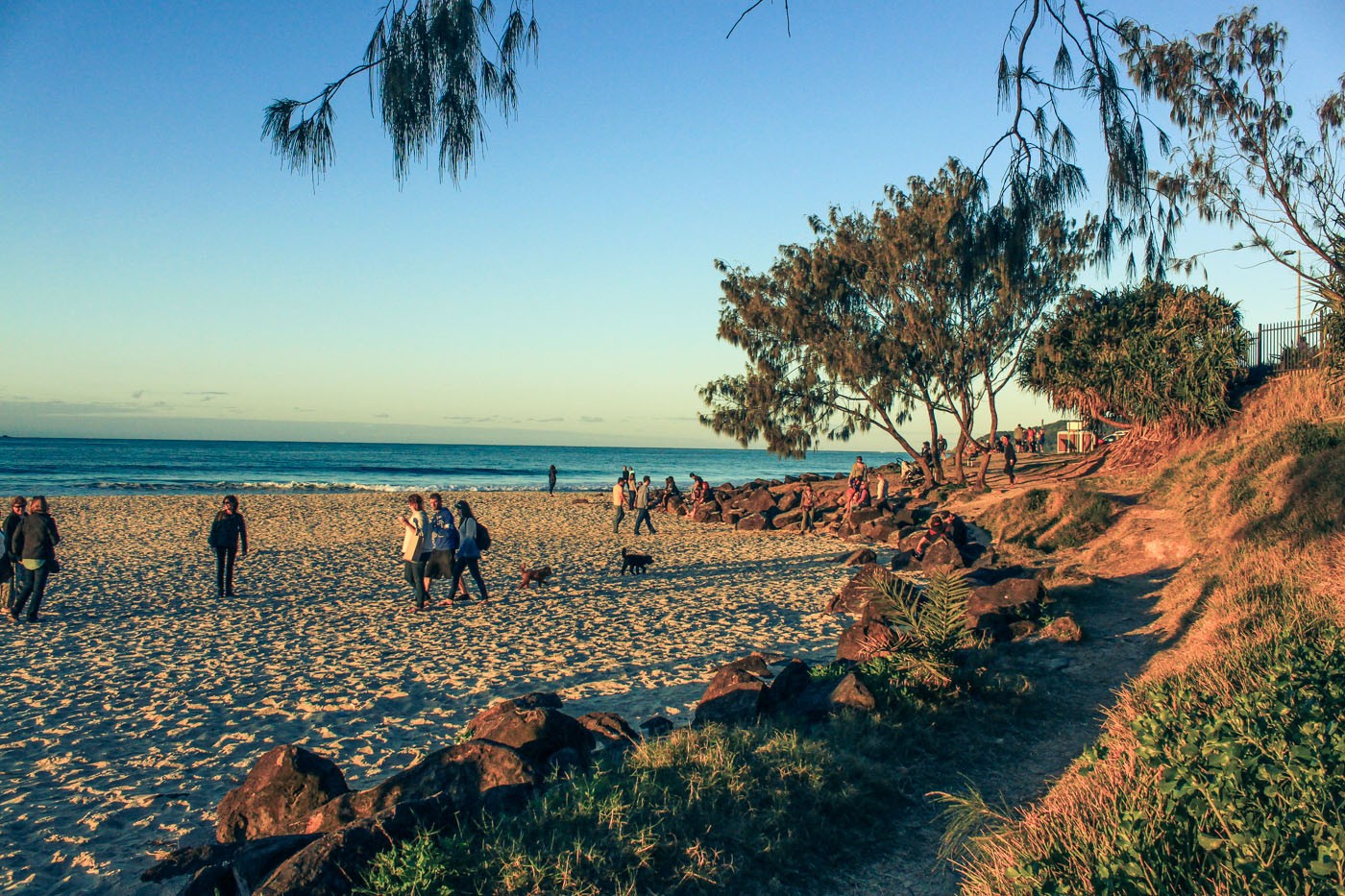
To help you save on domestic flights even further, consider the following tips:
Fly without checked baggage
Low-cost carriers will always charge you extra for checked luggage (as well as for meals and entertainment), so if you have an option of travelling light, do it! It will definitely help with travelling to Australia on a budget.
Plus, it’s better for the environment when the flight isn’t bogged down with the extra luggage weight. The aeroplane has better fuel economy.

Book red-eye or early morning flights
Since not many people want to fly those routes, they are often $20-40 cheaper than domestic flights throughout the day.
Sign up for airline email notifications
Both Jetstar and Scoot Airways are known for their amazing flight specials, like 2-for-1 deals, pay one-way get a free return, 50% off discounts and more.
Don’t wait till the last minute
Just like international flights, domestic flights get more expensive closer to their departure date. Sometimes, as much as x10, the original cost within the last few days leading up to it.
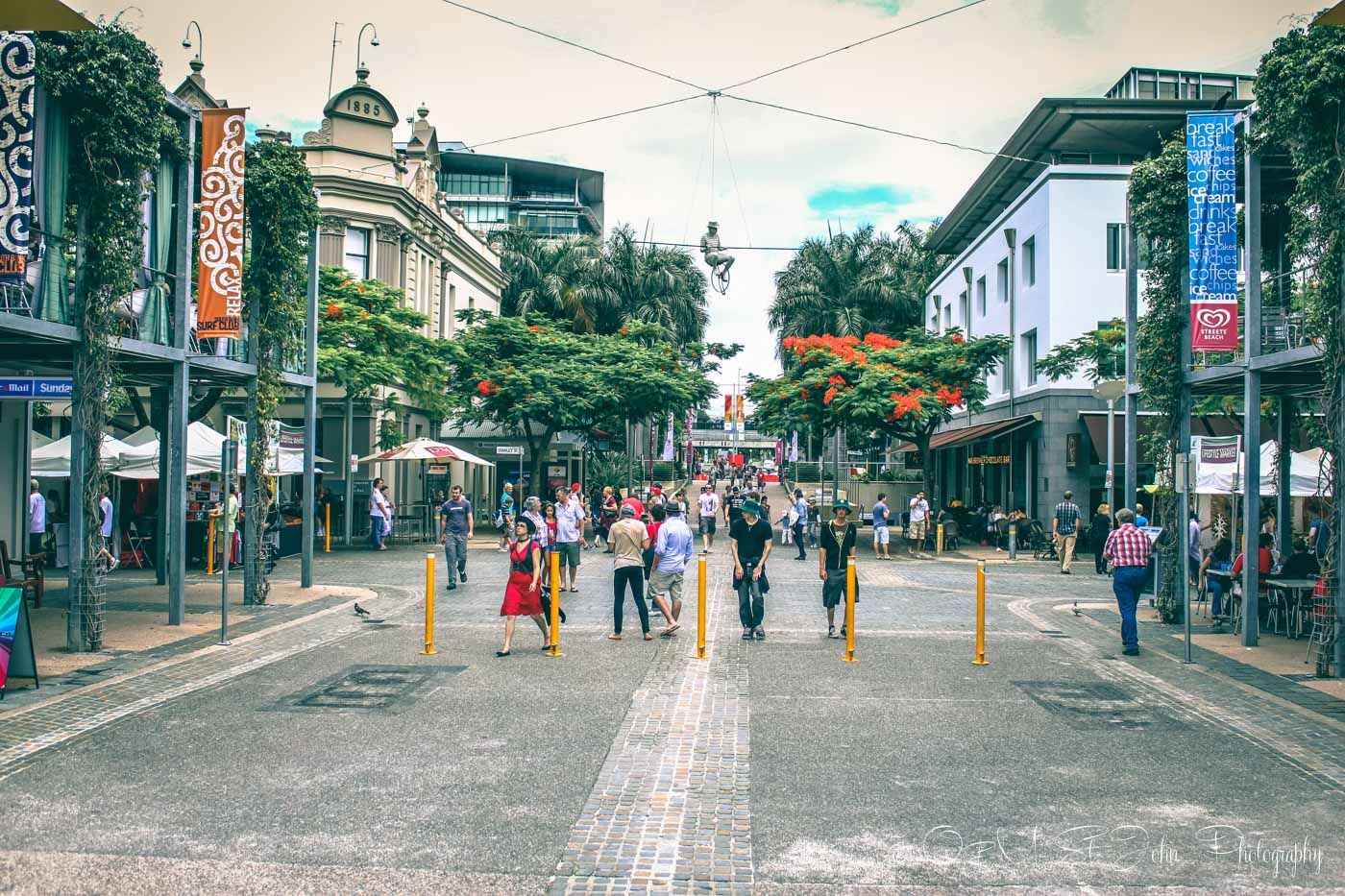
Share A Car Or Travel By Campervan
If you have a bit more time in the country, getting around by car might be an even cheaper alternative. The best part about renting a car is, of course, the flexibility that comes with it.
You can come and go whenever you please , stop along the way and experience some amazing off-the-beaten-track destinations en route from one major city to the other.
Opt for an electric or hybrid car if you do decide to rent. You can travel more responsibly while still having the freedom to move around.
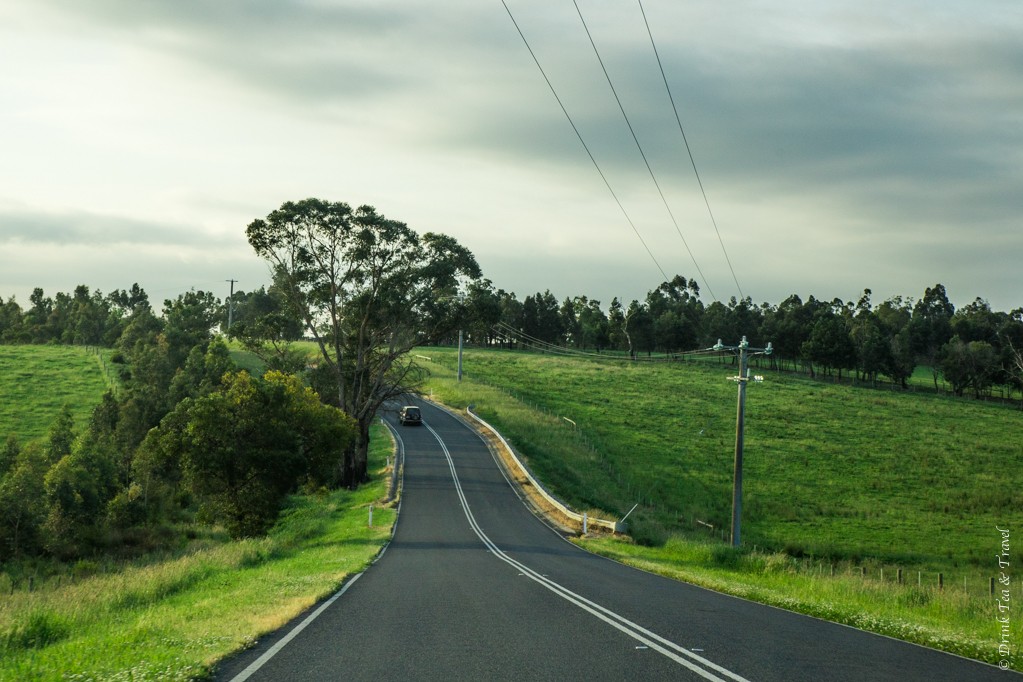
Major Cities Only?
If you are planning to visit only the major cities in Australia, flying is probably still the cheapest method of transportation for you. The big cities have numerous tourist attractions with beautiful sightseeing locations. But if you want to see more than just the capital cities, consider the following “car” options.
Bonus: if there are two or more of you travelling by car, getting a cheap car hire Australia will be more environmentally responsible than flying or taking public transportation!
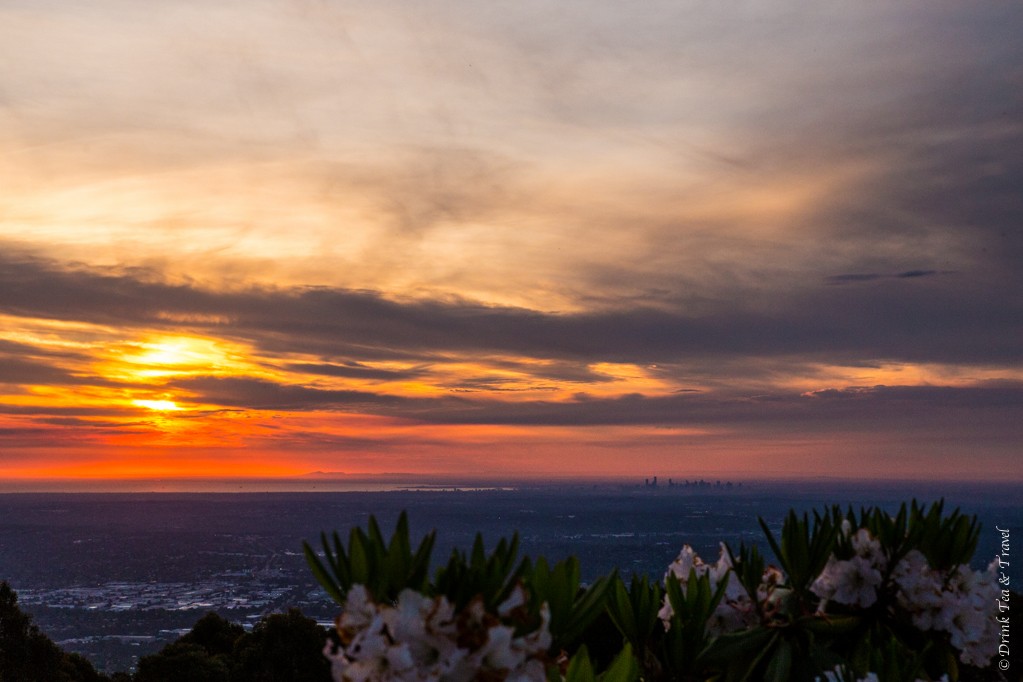
Cheap Car Hire In Australia
But only if you are travelling with more than 2 people. Car rental in Australia is not cheap ($50 a day and more) plus fuel is pricey. So unless you are travelling in a group and are able to split the transportation costs, renting a car often isn’t really an option.
An electric or hybrid car will save costs on fuel. And for even better fuel economy and a more environmentally friendly way of travelling Australia on a budget, consider packing light and opening the windows rather than flicking on the air conditioning when possible.
WANT TO EXPLORE AUSTRALIA BY CAR? Get the best car rental rates by booking ahead! Discover Cars compares prices across all major car rental companies, so you are guaranteed to get the best deal.
Share A Car
Backpackers are always looking for people to share a ride with. While not the most thrilling part of trip planning, renting a car can be a must. If you’ve noticed that car rental prices have gone up since pre-Covid times, the best way to save some bucks is by carpooling! For city stays where you only need a car for a few hours a day or every other day, sharing a car might be more cost-effective.
You might want to consider Uber Carshare, a peer-to-peer car-sharing service that lets you borrow a car directly from the owner. It’s available in many cities like Sydney, Melbourne, Brisbane, Gold Coast, Canberra, Perth, Adelaide, Hobart, and Cairns. No joining fee, and once approved, you can book a car by the hour, day, week, or longer.
Alternatively, you can share a car with GoGet, Australia’s top car-sharing network, covering 20+ areas across New South Wales, Queensland, South Australia, and Victoria. Their yearly memberships are affordable, including 120 free kilometres. Frequent users can enjoy reduced rates. The best part is, cars come with a free fuel card, saving you from worrying about petrol costs! If you are flexible enough and have time to spare, you might find not only a cheap ride but also a new travel buddy.
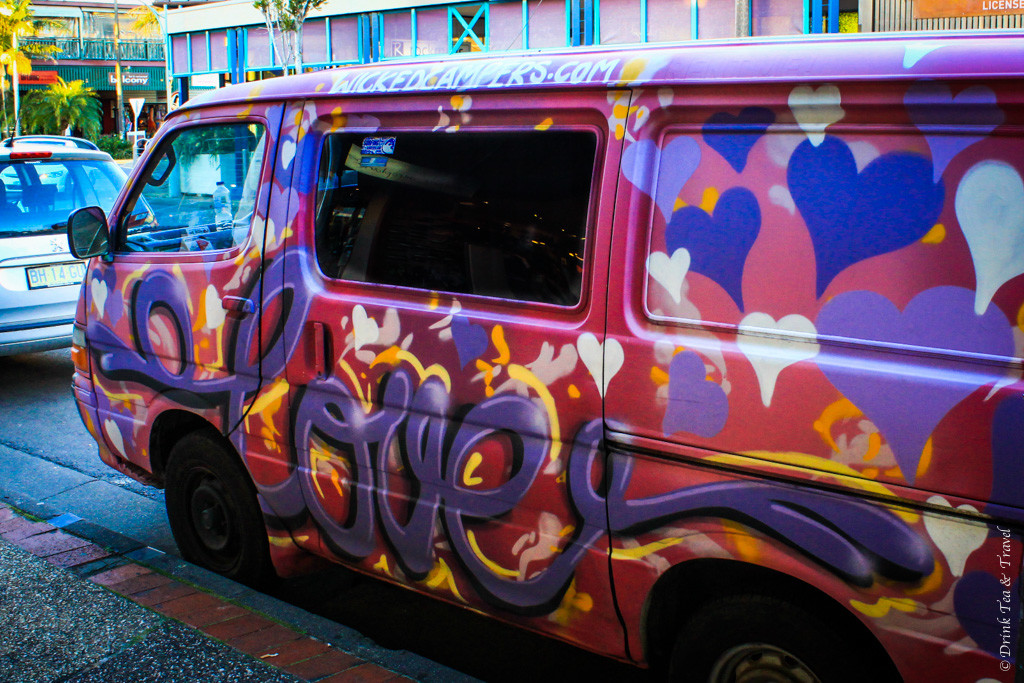
Campervan Relocations
This is by far the best and the cheapest way to get around Australia on a budget! Due to the popularity of campervan rentals in Australia, campervan companies are always looking for someone to relocate their cars from one destination to another and are willing to offer incredible deals for someone to do it!
With a bit of flexibility on your end, you can score a 4-6 berth campervan for $1 a day ! In our opinion, it is definitely something to consider when you’re wondering how much does it cost to go to Australia.
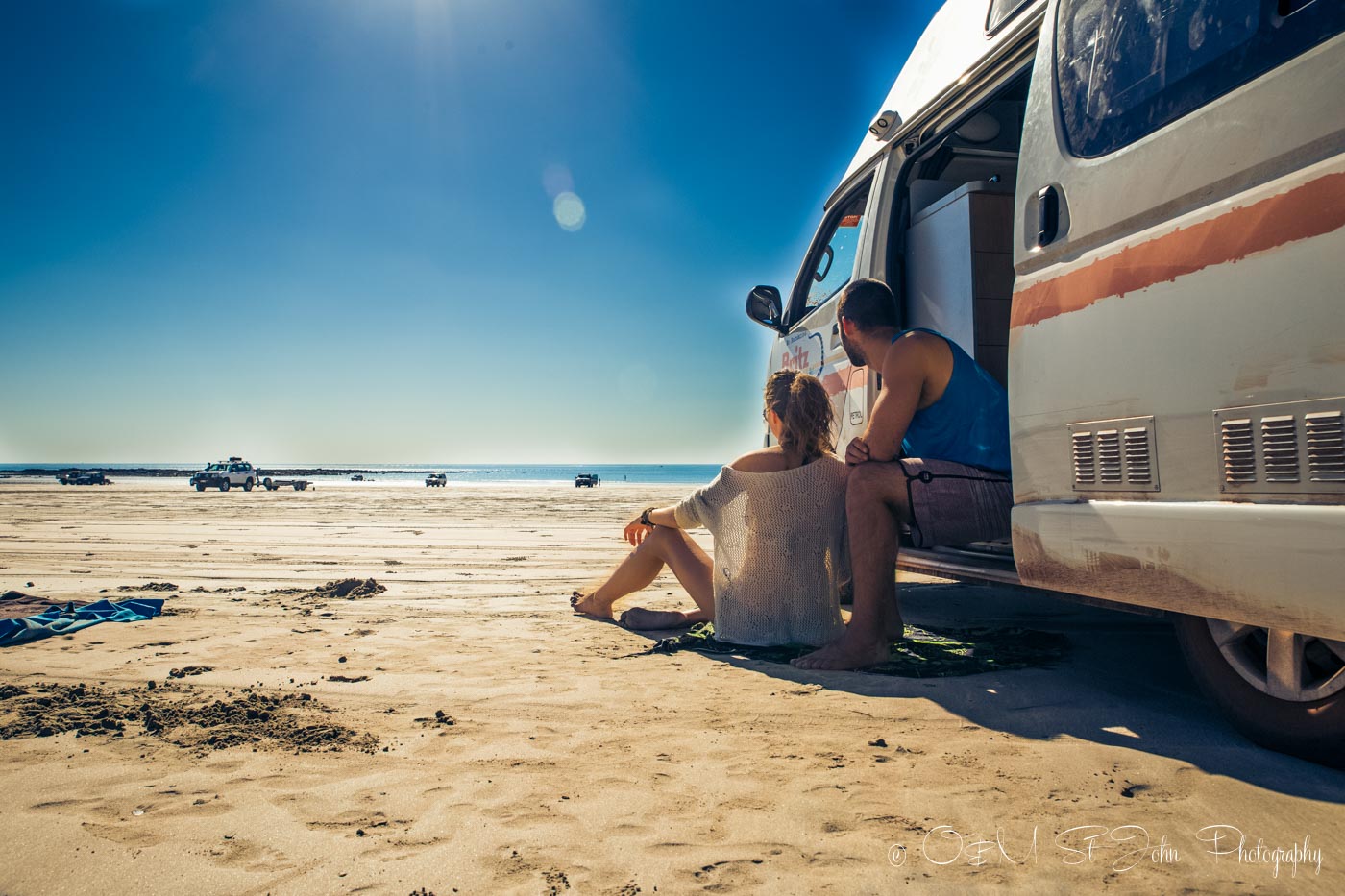
Save On Petrol
According to the Savings Guide, Australia Tuesday and Wednesday are the most affordable days to fill up on gas. So hit the gas station mid-week, and try to avoid filling up on Sunday and Monday when gas average price tends to peak.
It also never hurts to save receipts from some of Australia’s biggest brand-name stores like Big W, Woolworths, and Aldi, which sometimes have gas-saving coupons on their receipts.
Get Around By Bus
The other affordable way to get around Australia is by bus . There are two major bus companies offering routes all across Australia: Greyhound Australia and Oz Experience.
Both offer a variety of hop-on/hop-off bus pass packages starting from just $149. Their buses are air-conditioned, clean, and comfortable enough for overnight travel.
To sweeten the deal, Greyhound Australia‘s brand new coaches also offer free WiFi, USB charges, leather reclining seats, and panoramic windows; talk about getting around in comfort. Greyhound is the go-to transportation network, widely popular for covering the East Coast, Red Center, Northern Territory, and parts of the West Coast. This company has recently been acquired by New Zealand’s Entrada Travel Group in a significant consolidation of the national coach services. While the Greyhound Australia name and existing services will stay unchanged, the ownership transition period is expected in 2023 and 2024. Stay updated on service changes here .
Busses are also a perfect place to meet other backpackers and make friends along the way. But again, these are only worth the money if you want to take advantage of hopping off and on the bus to make stops in towns along the way.
Plus, this option is very environmentally friendly! Imagine all the cars bus passengers are keeping off the road by taking advantage of these major bus routes.
Use Public Transportation
The best way to get around the major cities is to use public transport. Public transportation also helps reduce the number of vehicles on the road, which cuts carbon emissions significantly!
Sydney, Melbourne, Adelaide, Perth, and Brisbane have well-developed train/bus/tram transportation systems that will allow you to get to practically anywhere you need to go for as little as just $5 each way.
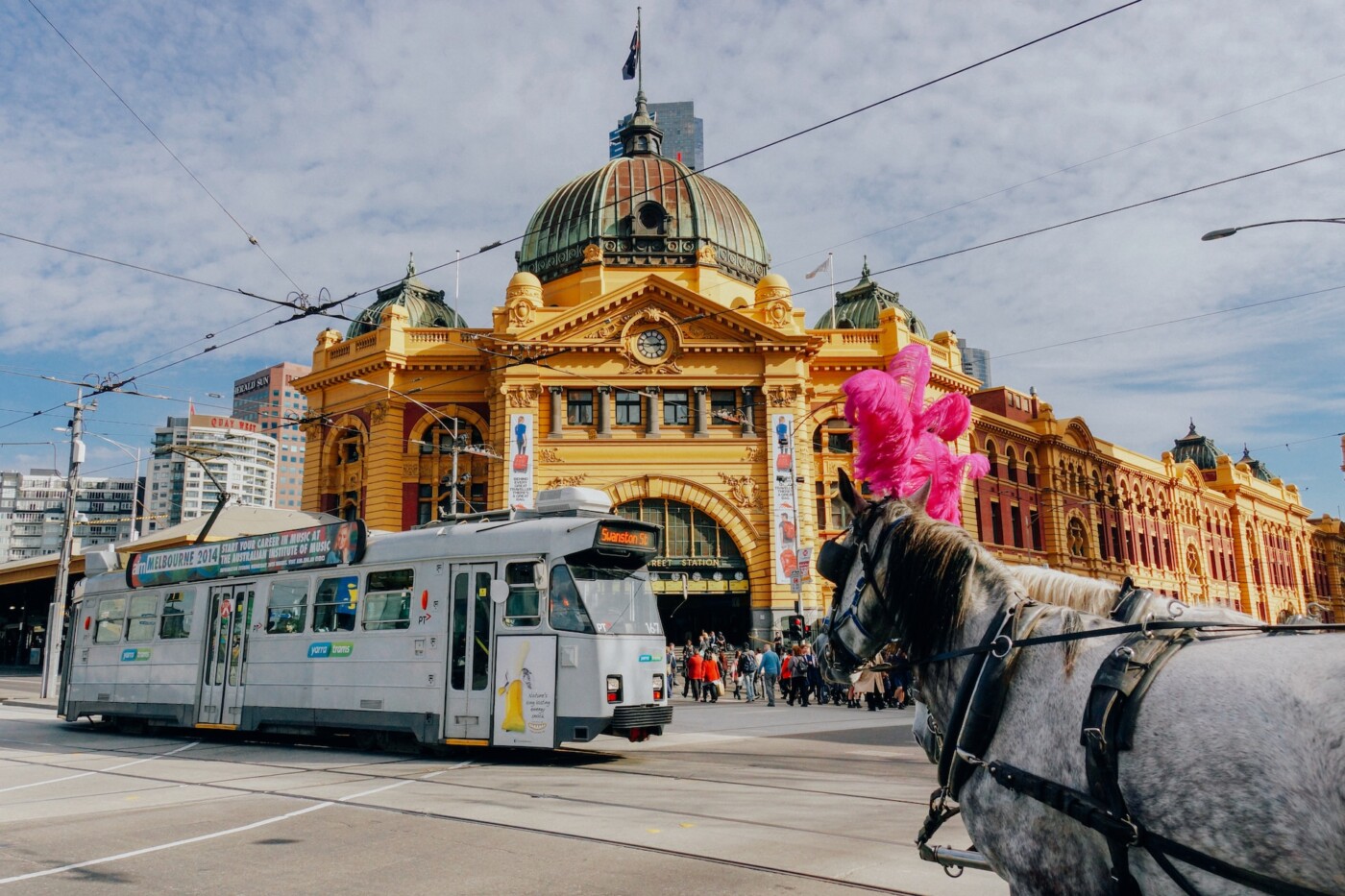
If you are trying to get somewhere outside of public transport hours, your best bet is to use ride-hailing apps. Uber has become quite popular in Australia, but the fees are on the rise. Consider trying other ride-hailing apps like Ola, Didi, Shebah, or GoCatch instead of Uber to stretch your budget while travelling down under. They’re equally safe, reliable, and widely available in most major cities.
How to Find Accommodation When You Are Travelling Australia on A Budget
Standard hotel accommodation in Australia is not cheap. You will struggle to find a basic hotel for less than $100 a night, even in smaller cities, and large, well-known hotel chains like Radisson, Intercontinental, and Marriott will often charge you upwards of $300-$400 per night.
So, if you want to find accommodation in Australia that doesn’t break the bank, you have to look for alternative options.
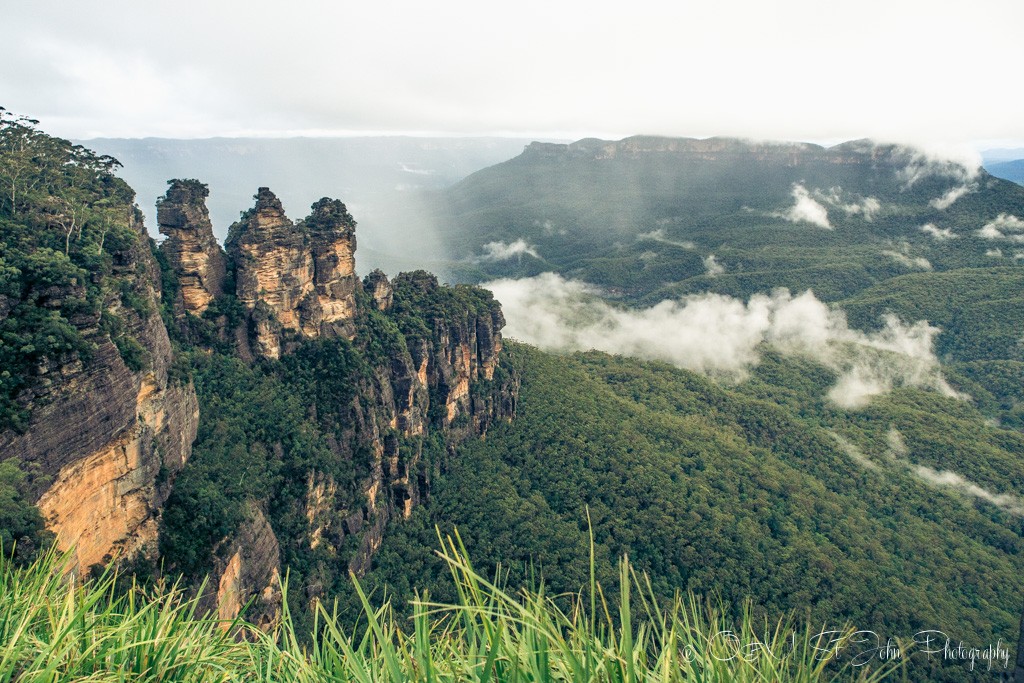
Stay In Hostels
There is an abundance of hostel options in Australia, and even though staying in a hostel is significantly cheaper than staying in a hotel, it’s still pricey. A basic dorm room will run you anywhere between $27-$40 per night, with prices in main cities (Sydney, Melbourne, Brisbane) getting up to $60-80 per night.
There are plenty of sustainable hostel options all over the country – from the Sydney Harbour The Rocks YHA to the Grampians Eco Hostel in Halls Gap, to Habitat HQ in Melbourne.
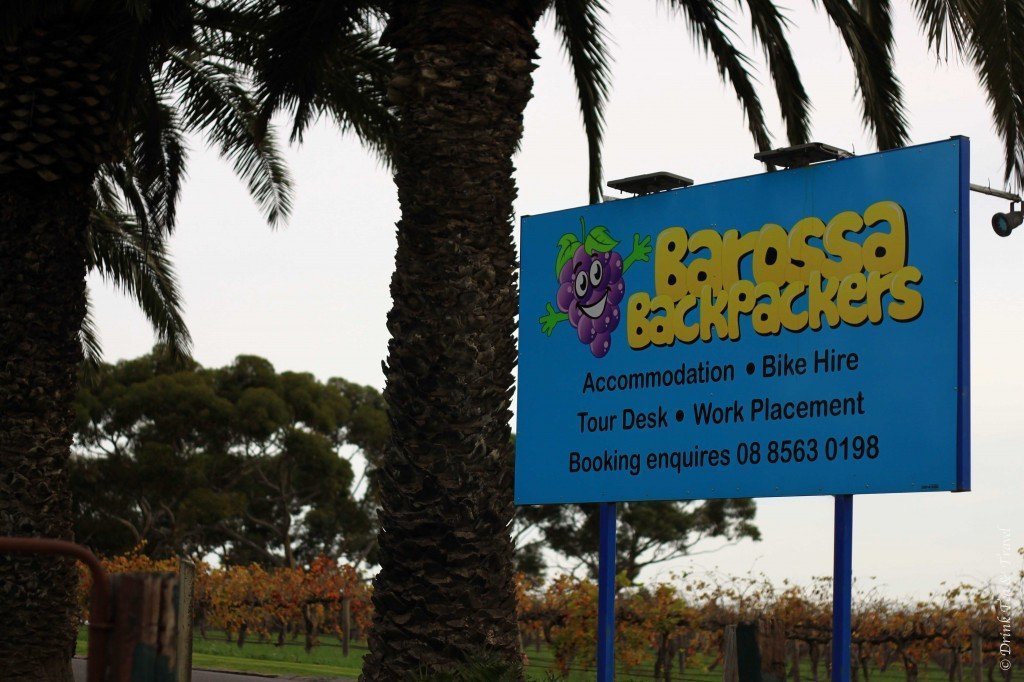
Stay In An Apartment or Independently Owned Accommodation
If the idea of sharing a hostel room with 20 other 20-something backpackers makes you cringe, look for options on Airbnb and other sharing economy apps like Stayz and Vrbo. These are widely recognised in Australia, known for the quality of their properties and have good reputations. These accommodations often cost the same or slightly higher than hostel or cheap hotel rooms, but in our opinion, is a much better experience, especially if you are travelling as a couple or a group of friends.
There are always eco-friendly options on these apps – especially if you plan far enough in advance. You can find the best and most affordable eco-friendly houses for rent in Australia in our Australia guide !
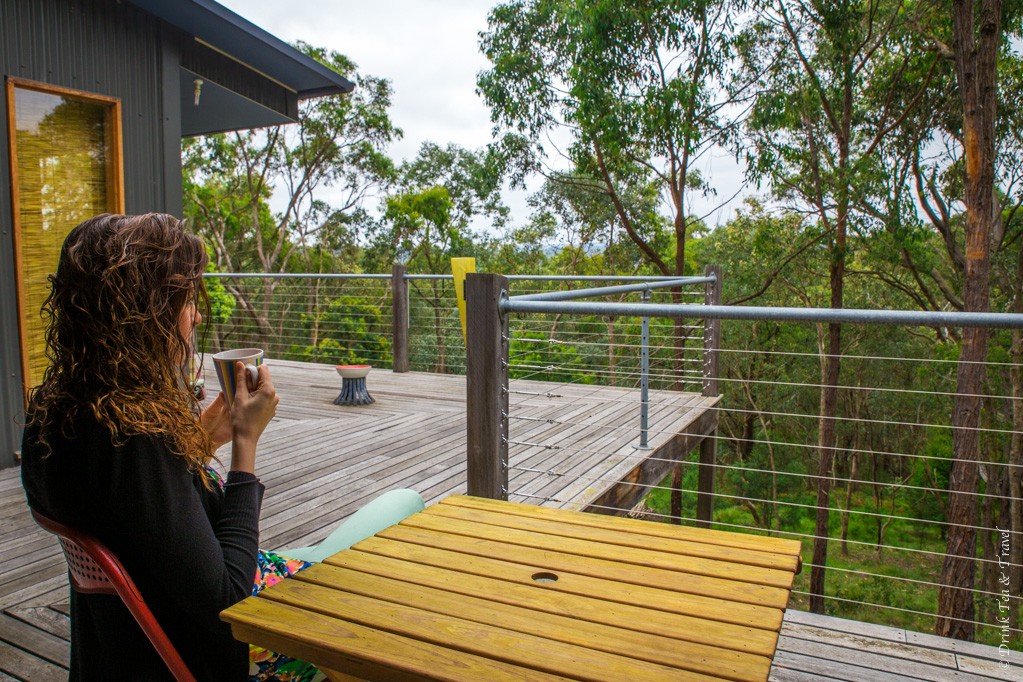
CouchSurfing is an online community site that allows you to find people willing to offer up their spare bed/couch to travellers. And the best part about it is that it’s completely free! You get the benefit of meeting a local host who’s well-versed in activities in the area and a budget accommodation option for those travelling to Australia on a budget that can’t be beaten!
Stay In A Campervan
Campervans are a great option for not just transportation but also accommodation in Australia. More on that in my post: Getting Around Australia on $1/day .
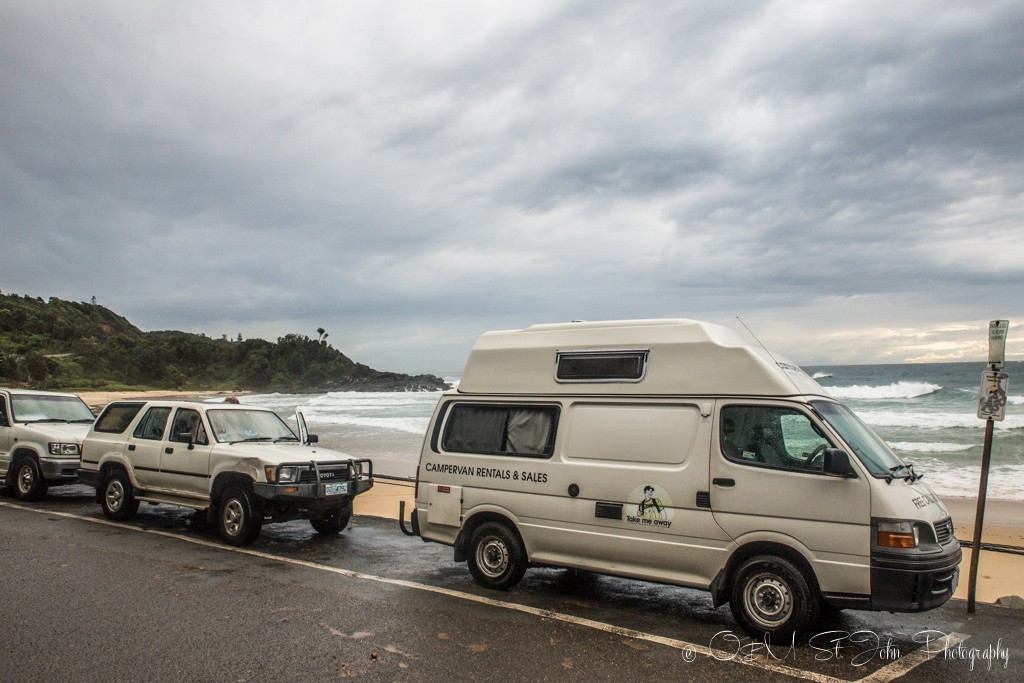
Stay At A Campsite
Camping is not a glamorous option, but it is definitely a cheap one and has the lowest environmental impact of any of the mentioned options ! You can buy cheap camping gear when you arrive in Australia and use it for the duration of your stay.
It might make your backpack heavier, but it will certainly save you a lot in accommodation. There are numerous campgrounds all over Australia, and camping is often permitted in many National Parks for as little as $5 a night. Most campsites are well maintained and have great facilities : BBQs (hello, budget meals Australia), hot water showers, fire pits, etc. Campsites can be found through the official government National Park websites and can be pre-booked online.
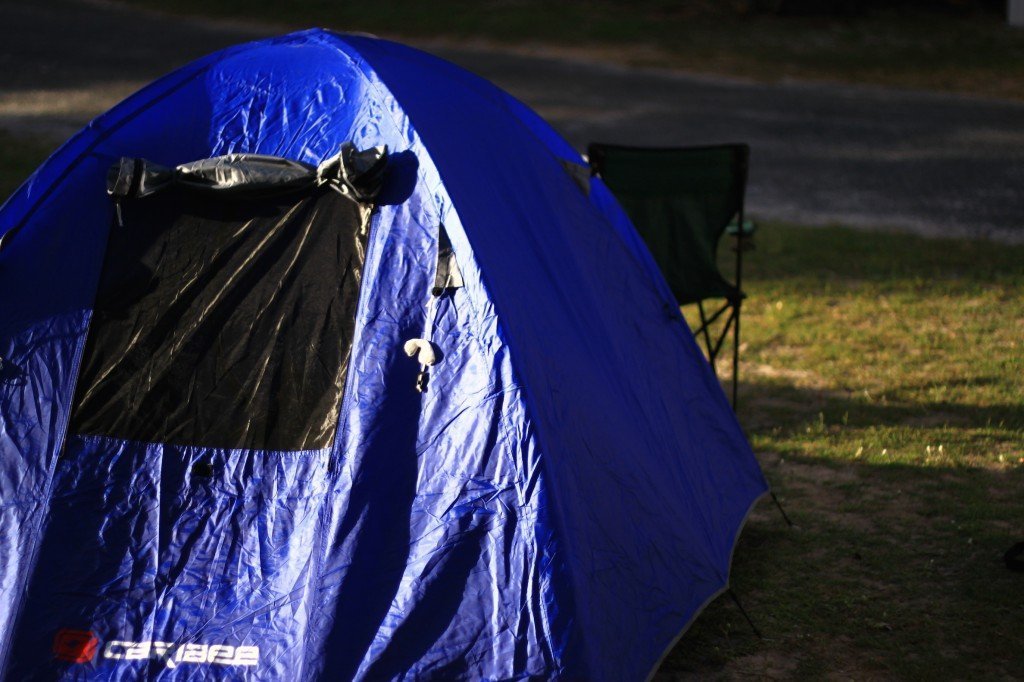
If you’re looking for a more comfortable option for accommodation in Australia but don’t want your stay to negatively impact the environment, consider an eco-hotel !
They’re not going to be the cheapest option at your disposal, but the extra money is well spent on preserving their surrounding community and natural environment! Here are a couple of great options:
Daintree Rainforest Eco Lodge : Located in the oldest rainforest in the world, just two hours south of Cairns , this eco-resort gives you the experience of a lifetime! They’ve got self-sufficient water systems, run almost exclusively on solar power, and all products in the hotel are fair trade and recyclable. This is a great place to stay if you’re looking to explore the Great Barrier Reef.
Old Leura Dairy : Just outside of Sydney, this eco-accommodation is a quaint, quiet place to relax after the hustle and bustle of visiting the city.
If you’re looking to splurge – we recommend Lady Elliot Island Eco Resort just outside of Brisbane. It is located within a strictly enforced ‘Green Zone’ – meaning the marine and wildlife within the area are protected, as is the portion of the Great Barrier Reef located within the zone. The resort itself has been certified as a Climate Action Leader – fully committed to environmental sustainability and protection.
Alto Hotel : Located in Melbourne’s city center, this comfortable and stylish hotel was Australia’s first carbon-neutral hotel.
Travel In The Off-Season
Depending on where you are travelling to, sometimes tour operators and accommodation will offer off-season deals to entice potential clients.
This doesn’t always mean monetary discounts but, more often than not, upgrades. Since accommodation tends to be at lower capacity, hotel operators are usually happy to upgrade private rooms or throw in some extras during your stay. It never hurts to ask.
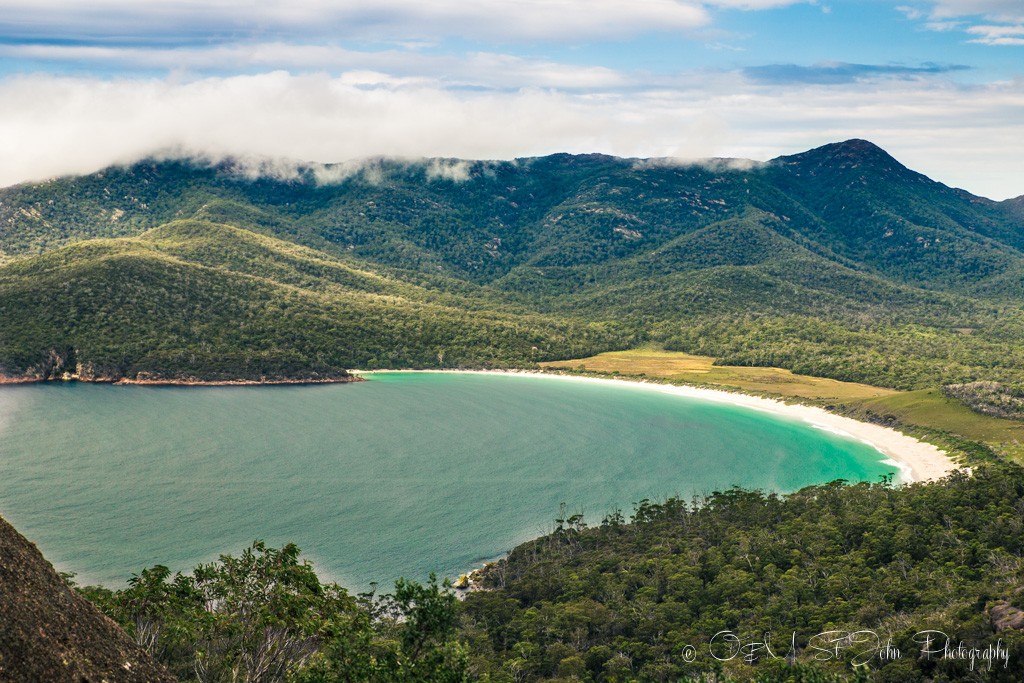
How to Save on Food and Drinks in Australia
The best budget meals in australia.
Eating out in Australia is expensive and unsustainable for someone travelling on a budget. However, there are a few money-saving options to help your budget go further.
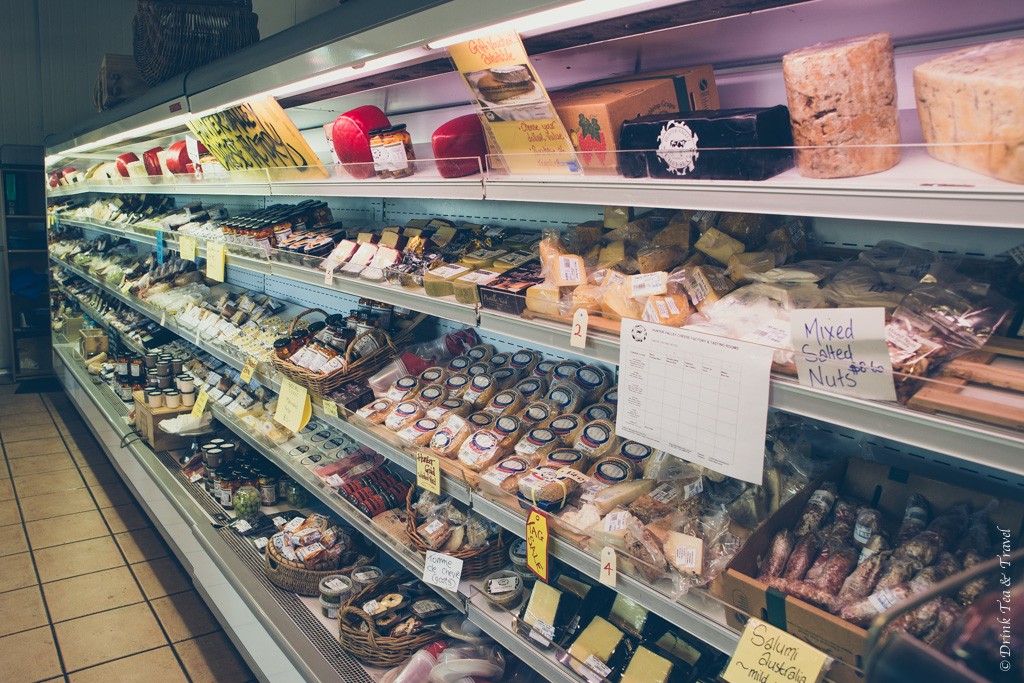
Cook Your Own Meals
Utilise cooking facilities in hostels, the kitchen in your Airbnb apartment, or the portable stove that comes with your campervan to cook your own meals where possible.
Coles , Woolworths , and Aldi are the 3 main supermarkets in Australia, with locations all over the country. Aldi may not have the best selection, but offers good quality products at prices that are often 20-30% cheaper than Woolworths and Coles.
Aldi also does not sell any products with synthetic colours, hydrogenated oils or MSG in their stores nationwide.

Have A Picnic
Having a picnic is just as cheap as eating in, but better! Buy your groceries and head to the nearest park/beach for a picnic. You’ll notice heaps of free public BBQs in almost every town, so you are never too far away from free cooking facilities. Plus, it’s such a local thing to do that you’ll feel like a real Aussie having a sausage sizzle in a park. Cheap eats and culture all in one – score!
We are strong believers that trying local produce and cuisine are a huge part of any travel experience, and even though Australia isn’t the be-all and end-all of the amazing food, it’s still worth combining cooking your own meals with eating out. So here are a few ways you can eat out for less.
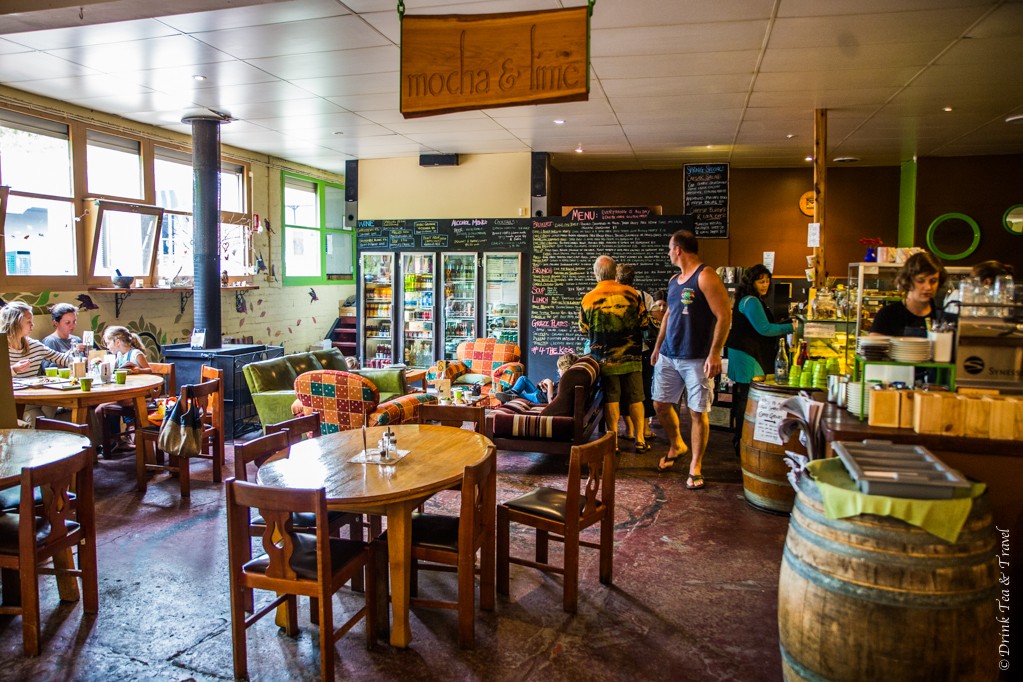
Visit Local Markets
Australians love pop-up farmers and produce markets! They are not just a great place to stock up on cheap fresh veggies and other produce but are also a great place to grab ready-to-eat food and support local businesses.
Here, you’ll find food stalls offering everything from fish and chips to international street food and desserts. Markets like the Wednesday night Queen Victoria Market in Melbourne, the Adelaide Central Market , Eat Street Markets in Brisbane and Salamanca Markets in Hobart are especially well known for their variety of amazing street food. Most dishes will cost between $7-10 – a bargain compared to the $20 restaurant bill.

Eat In Chinatown
Check out Chinatowns in Sydney, Melbourne, Adelaide and Brisbane for cheap $10-15 Vietnamese, Chinese, Malaysian and other Asian restaurants. Keep your eyes peeled for local restaurants with vegan and vegetarian options, too!
Use UrbanSpoon, Yelp, And Trusty Google
Go online to find other cheap eats and meal deals in each city. Many restaurants in Australia offer weekly specials like 2-for-1 Wednesday meals, or $10 Tuesday , and so on to attract customers to their restaurants on quiet days.
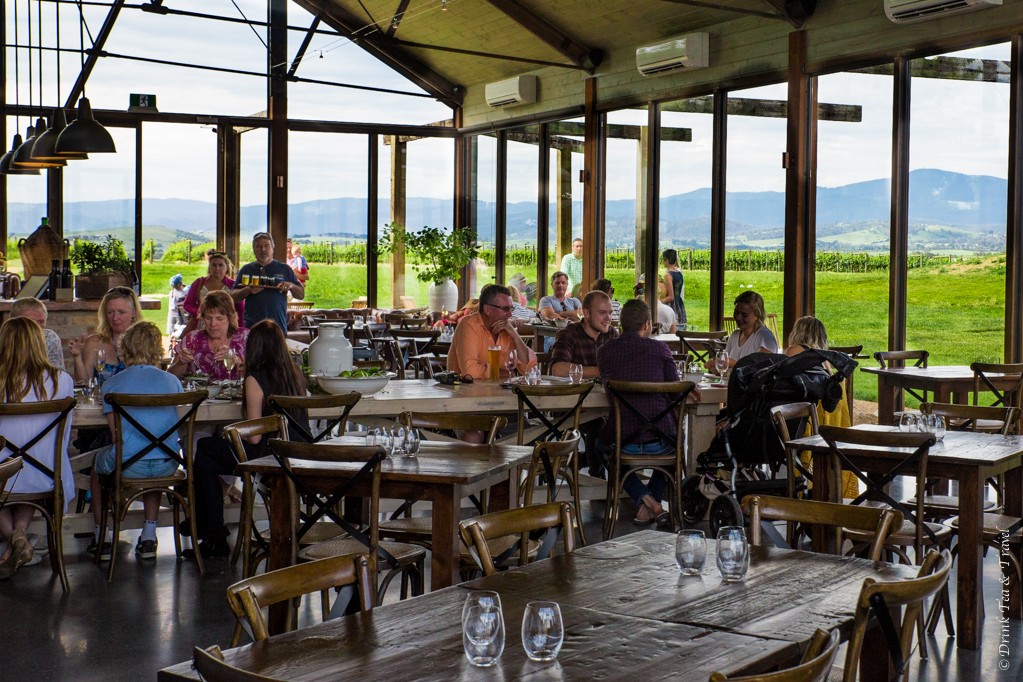
Save On Drinks
Drink less or be smart about not letting drinking drastically increase the cost of your trip to Australia. If you are going out on the town, pre-drink! Booze at bars and clubs in Australia is ridiculously expensive.
Beers can often start at $11, a glass of wine is often $8-10+, and a cocktail will often cost more than $17. Buying alcohol from the liquor store is, of course, a much cheaper option. You can find a bottle of wine for under $18 and a carton of domestic beer (24 bottles) for about $40.
If you want the cheapest stuff, cask wine (goon) is your best option. It’s incredibly cheap, 4 litres for under $20 and gives you really bad hangovers, but it’s the most popular choice for backpackers travelling to Australia on a budget.
Pop into Dan Murphy’s , BWS, or LiquorLand to have a few drinks at home before the bar, or find a restaurant that allows you to bring your own (BYO) alcohol to enjoy with their meals. These are quite popular in Australia and are easy to find in any town.
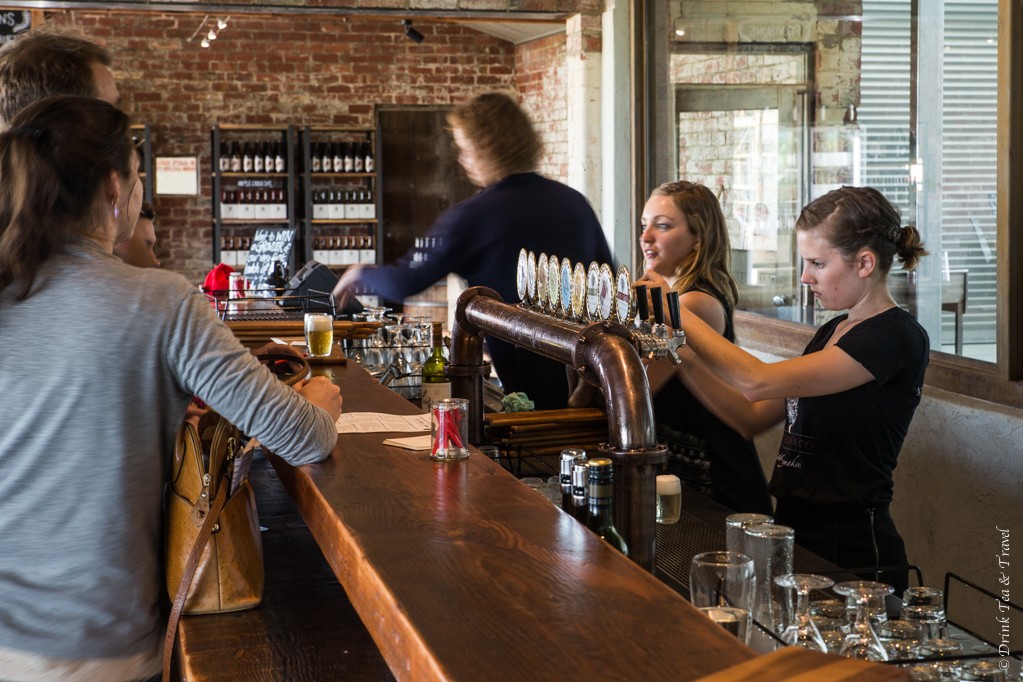
Save On Coffee
If you still need your caffeine fix but don’t want to foot the $4+ bill. Consider visiting your local gas station or convenience stores like 7-11 . They tend to offer low-cost coffee options.
In the case of 7-11, all coffee is just one dollar. The main difference is that their lattes, flat whites, and long blacks won’t be handmade. Rather, they will be sprouting from a machine… but real coffee nonetheless.
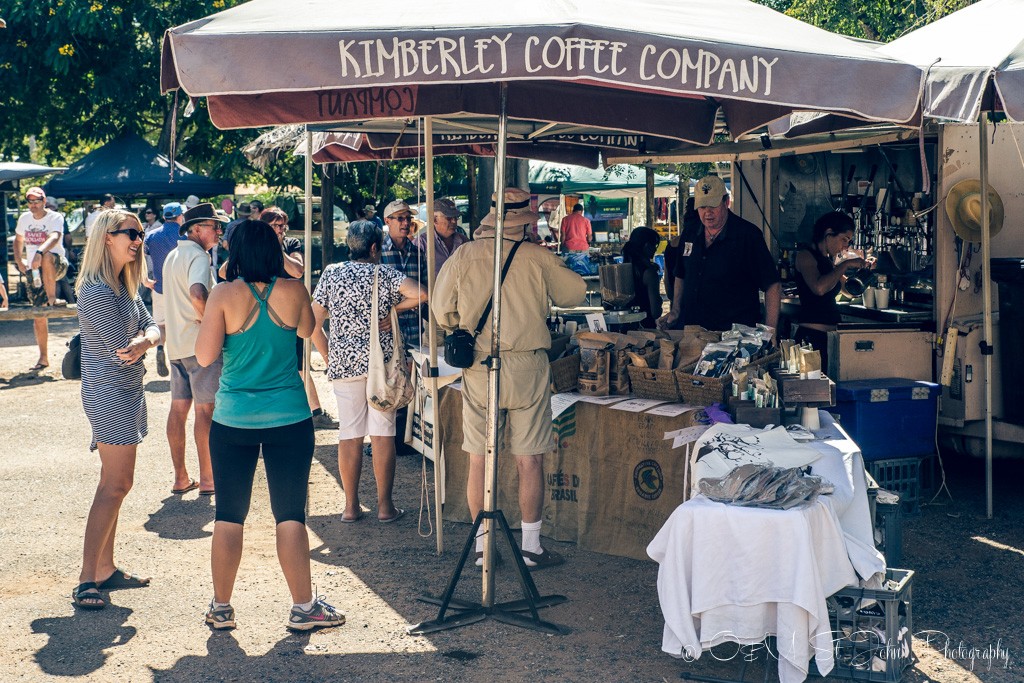
Use Reusable Dishes
Skip buying water, and instead, bring with your own reusable water bottle like LARQ . All water is potable in Australia, and water fountains are plentiful in most parks and service stations.
Plus lots of cafes will offer discounted drinks when you bring your own mug. Bonus points: you’ll be travelling Australia on a budget AND sustainably.
How to Save on Activities in Australia
Activities in Australia are pricey and should be considered in your trip to Australia cost. It’s easy to find yourself spending hundreds of dollars a day on tours and experiences.
Pick and choose the ones that are really worth it for you, and choose to entertain yourself for free for the rest of your time in Australia. After all, the best things to see in Australia ARE FREE!
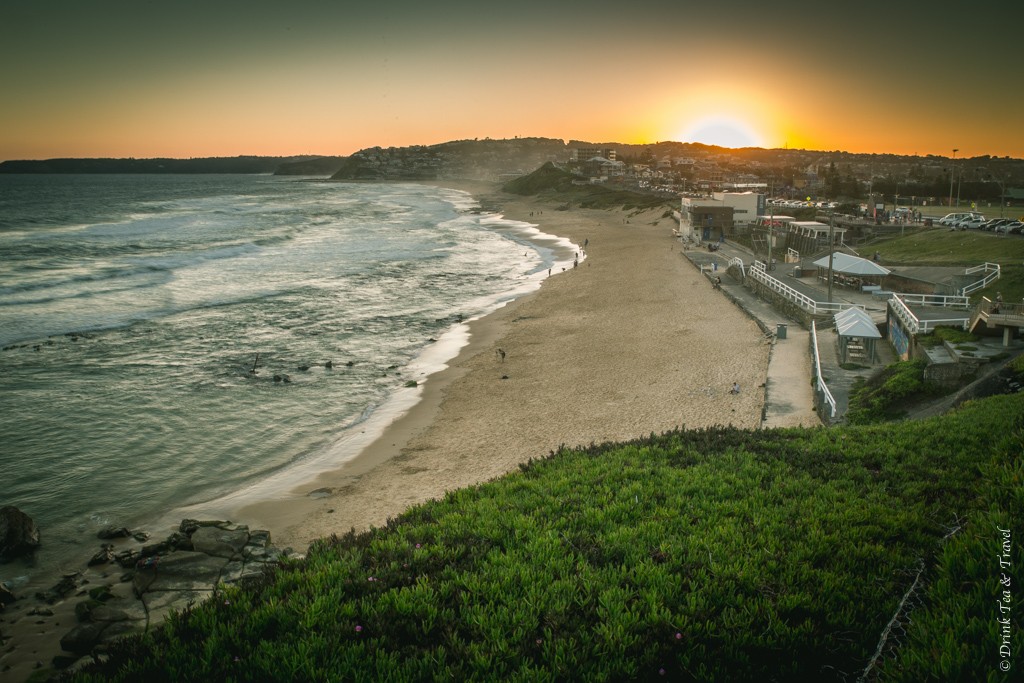
Visit National Parks
There are hundreds of National Parks to explore in every state, with each one offering hiking trails, beautiful lookouts, and unique experiences .
You can visit a national park for a day or stay and explore for a few days, all for absolutely free. (Unless you want to camp there, which in most cases will cost you about $5-10/night). Here are a few of our favourites:
- Daintree National Park, Where the Rainforest Meets the Reef
- Exploring Noosa National Park (and its sneaky little secret)
- Day Trip to the Springbrook National Park
- Visiting Uluru-Kata Tjuta National Park
- Guide To Visiting Kakadu National Park
- Guide To Visiting The Bungle Bungles Purnululu National Park
- Guide To Visiting Litchfield National Park In Top End
- Guide To Visiting The Ikara Flinders Ranges National Park In South Australia
- Guide To Visiting Coffin Bay National Park, South Australia
- Guide To Visiting Port Lincoln National Park, South Australia
- Guide To Visiting Kalbarri National Park In Western Australia
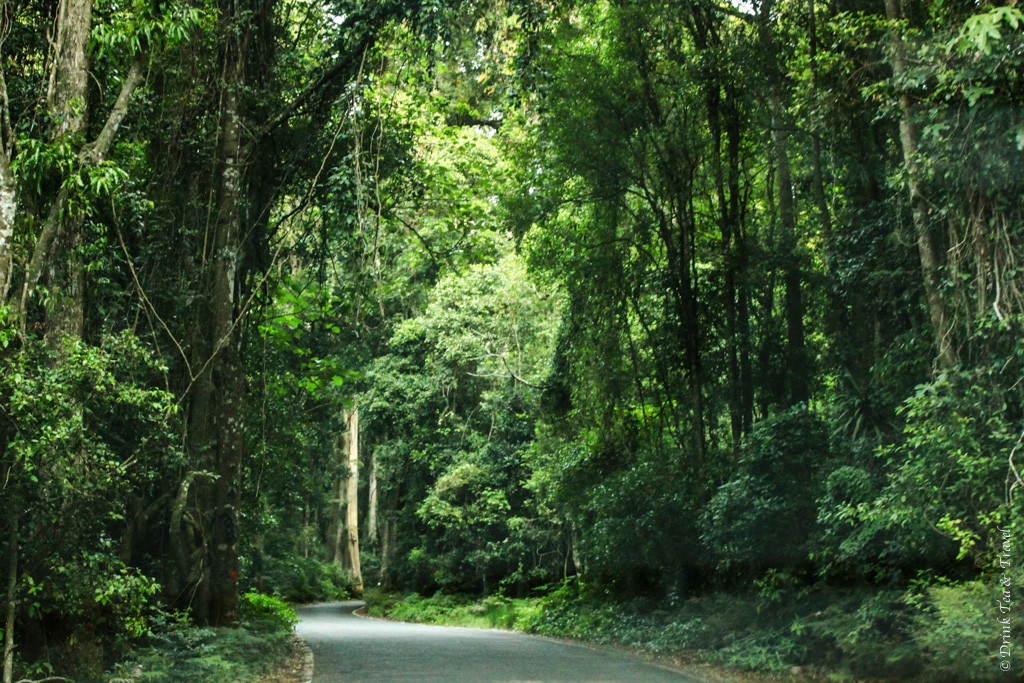
Take Advantage of Free Activities
Save by exploring one city at a time. Enjoy free activities such as visiting the beach, the Sydney Opera House, the Botanical Gardens, and other sightseeing activities.
Hang Out On The Beach
Australia is renowned for its beaches and with over 11,000 of them along the coastline, there is plenty to explore. Here is a list of the best of the best (in our opinion anyway): Best Beaches in Australia .

Check Out Museums
There are heaps of free museums to get lost in every city . Check out Art Gallery of NSW in Sydney, National Gallery of Victoria in Melbourne, the Queensland Museum in Brisbane and many others that offer free admission
Visit Australia Wine Regions
Australia is renowned for its wine regions. Our favourite was the Hunter Valley wine region near Brisbane, but the Yarra Valley , and Barossa Valley are also popular stops.
Most wineries offer a wide range of free tastings when you visit . Buying wine thereafter is not compulsory. However, it is appreciated.
Micro-breweries are beginning to pop up all over Australia, and just like most wineries, they offer a wide range of beer tastings. Plus, buying in bulk at these micro-retailers tends to be more affordable than buying their equals at a local liquor store.

Take Advantage Of Free Walking Tours
I’m Free is a company that runs free daily walking tours in Sydney and Melbourne. They vary in duration from 1.5 to 2.5 hours and offer a great alternative to paid tours in those cities.
You’ll get a chance to explore the city’s main sights, learn about their history, and maybe even meet a few new travel buddies along the way. Bonus: Walking tours are an extremely eco-friendly option for acquainting yourself with a new city!

Follow The Festivals
Australia is all about its festivals. Whether it be a surf, food, or a cultural festival. Each festival typically offers its own list of complementary activities or events that won’t hurt your trip to Australia.
Rent Gear Rather Than Booking A Tour
Rather than booking a tour, why don’t you chat up the locals, rent your own gear, and follow your own DIY tour.
There are lots of gear rental shops all over the country . From scuba to surfboard to mountain bike rentals they have you covered. Simply ask your rental attendant where the best spots are for your chosen activity, and they will be happy to help.
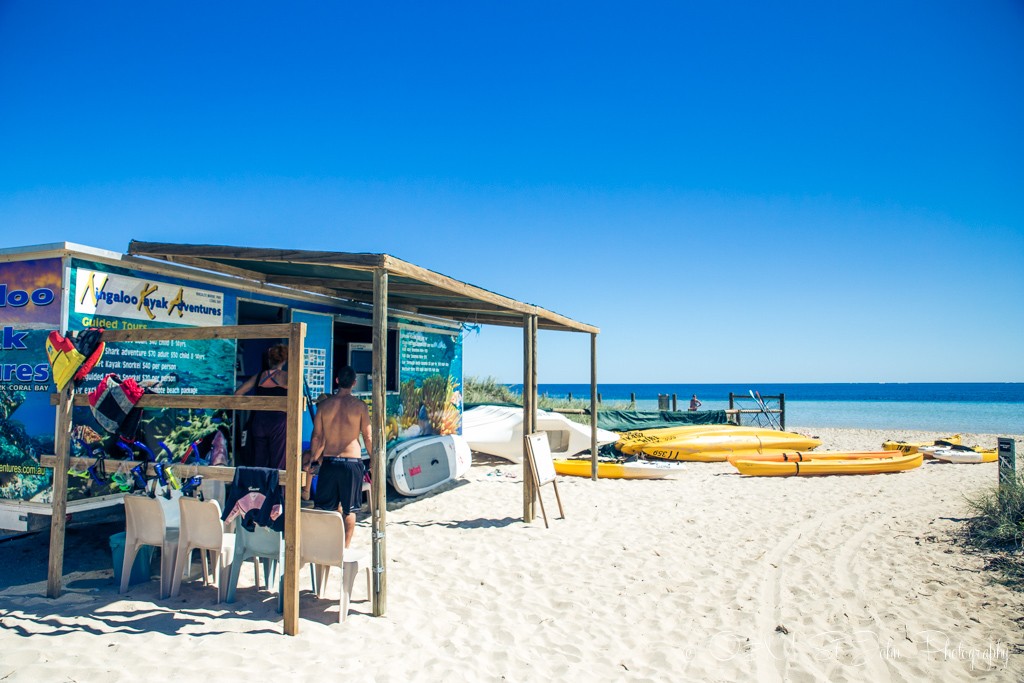
Escape The Big Cities
Food, accommodation, and even activities tend to be cheaper outside of the major cities and in off-the-beaten-track destinations.
Consider visiting rural farming towns north of Melbourne like Echuca or coastal towns like Port Fairy in Vic or Yamb in NSW. You’ll find truly unique experiences outside of the hustle and bustle of Australia’s big cities.
Keep in mind this rule doesn’t apply to places like Fraser Island or Alice Springs, where food and drink have to travel long distances, and tourism is the town’s main source of income.
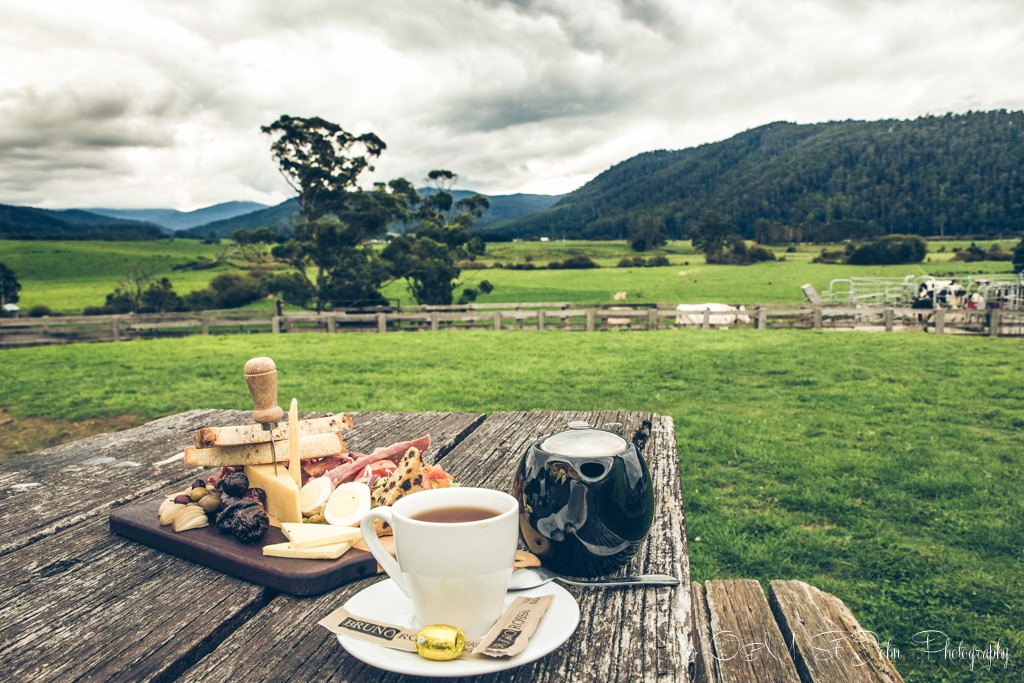
Save on Staying Connected
Get a local sim.
Do not use your home mobile phone when in Australia if you do not want to pay the exorbitant roaming charges when you get home. Instead, unlock your phone before you go and buy an e-SIM card before your departure.
You can save on roaming charges by ordering an e-SIM card for Australia online and getting connected in minutes. For a budget-friendly option, we recommend Truphone e-SIM cards from Nomad, operating on Vodafone’s network for just A$0.76 per Gigabyte. Another good choice is the Three Hong Kong e-SIM card via SimOptions, valid in 6 countries. It’s a bit pricier but handy if you’re visiting New Zealand too, or if Australia is part of a larger trip, the world traveller e-SIM cards covering multiple countries. Just make sure your phone is unlocked.
Alternatively, if you have not unlocked your phone, there are plenty of pay-as-you-go options available to travellers. You can top up a certain amount or buy a monthly plan that will give you a local phone number, a few GB of data and unlimited local texts/calls.
While you may not have the need to call while you are in Australia, the benefits of having data on your phone are enormous. If you don’t mind spending a bit more, get a Telstra SIM card to guarantee the best coverage and good reception, even in remote areas in Australia. Their pre-paid plans start at $35 for 35GB of data and unlimited local call and text.
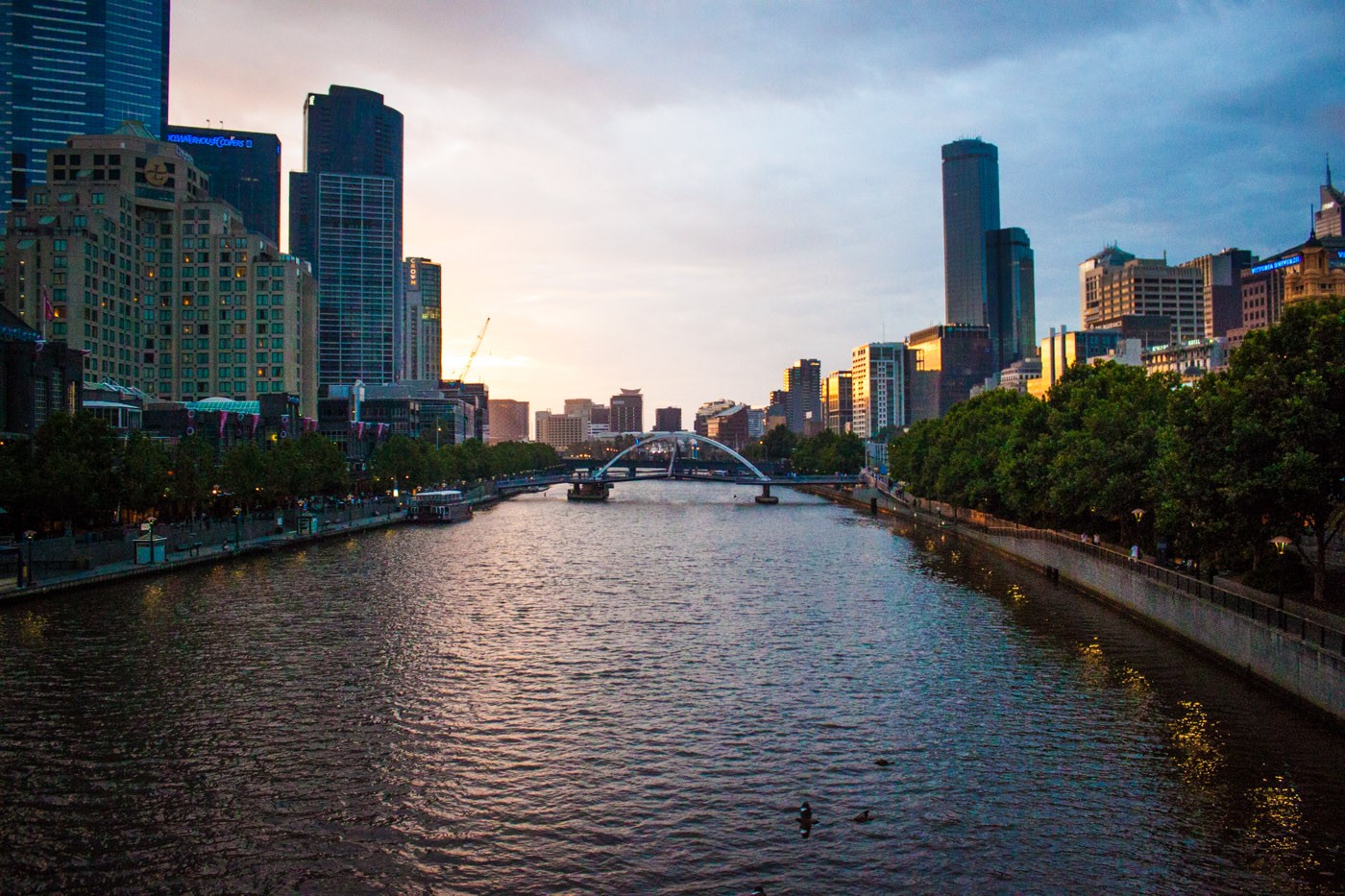
Find Free Wifi
If your budget is really bare-bones, check that your accommodation offers free Wi-Fi, or you can find free Wi-Fi at McDonald’s all over the country. Unfortunately, free wifi is not as plentiful in cafes as it is in North America.
Otherwise, search for free wifi at your destination with this map.
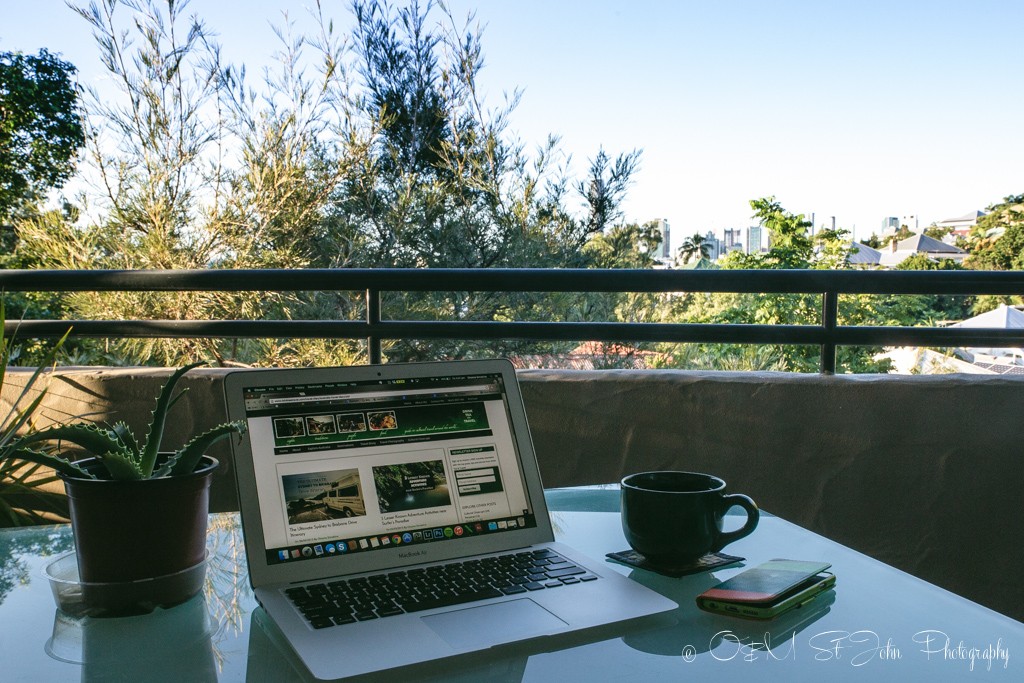
Consider A Working Holiday Visa
If you have the time, one of the most cost-effective ways of seeing Australia is with a working holiday visa. The temporary visa allows eligible applicants to work and live in Australia for up to a year , with the option to extend.
You can work for one employer for up to 6 months at a time. Then, if you would like to get another year’s visa, you are required to work for 88 days or three consecutive months on a farm.
Sounds good? Follow our top tips for moving abroad .

Get A Travel Insurance
Don’t overlook travel insurance while abroad . It’s your safety net against unexpected costs and ensures a worry-free journey and protection against illness, injury, theft, and cancellations. For us it’s a must for added security, we never go on a trip without it and have relied on it multiple times in the past. Travel insurance shields you from the actual costs of unexpected mishaps during your trip, because nobody wants surprise bills ruining their travels!
Get A Budgeting App
Getting a travel budget app on your phone and keeping it up to date will give you greater control over your funds. We use TravelSpend during our travels.
TravelSpend allows you to set a budget and track where you are spending the most and on what. It definitely beats the Excel Spreadsheet approach we had before and is, in our minds, absolutely worth it. You can easily input your expenses online or offline in the currency you used and swiftly convert them to AUD. Capture memories by adding photos; you can also use it on multiple devices, categorize each expense for a clear trip budget overview, and split costs effortlessly. Plus, you can convert your travel data into a CSV file compatible with other data apps, so no more spreadsheets on the go!
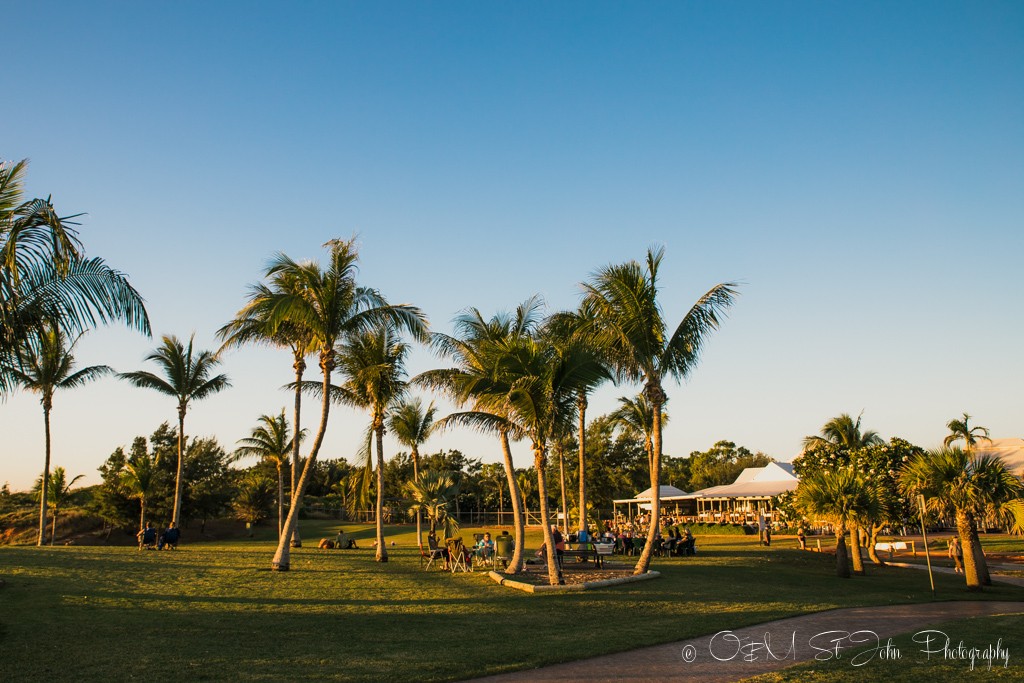
How Much Does It Cost to Go to Australia? The Bottom Line
If you add up flights, hotels, meals out, and a heap of activities, your trip to Australia cost is definitely going to be pricey. But follow our tips, be smart with your spending, and you can easily stay and play in Australia for as little as $100 a day . It’s not quite as cheap as Asia or South America , but it’s a hell of a lot cheaper than you once thought, right?
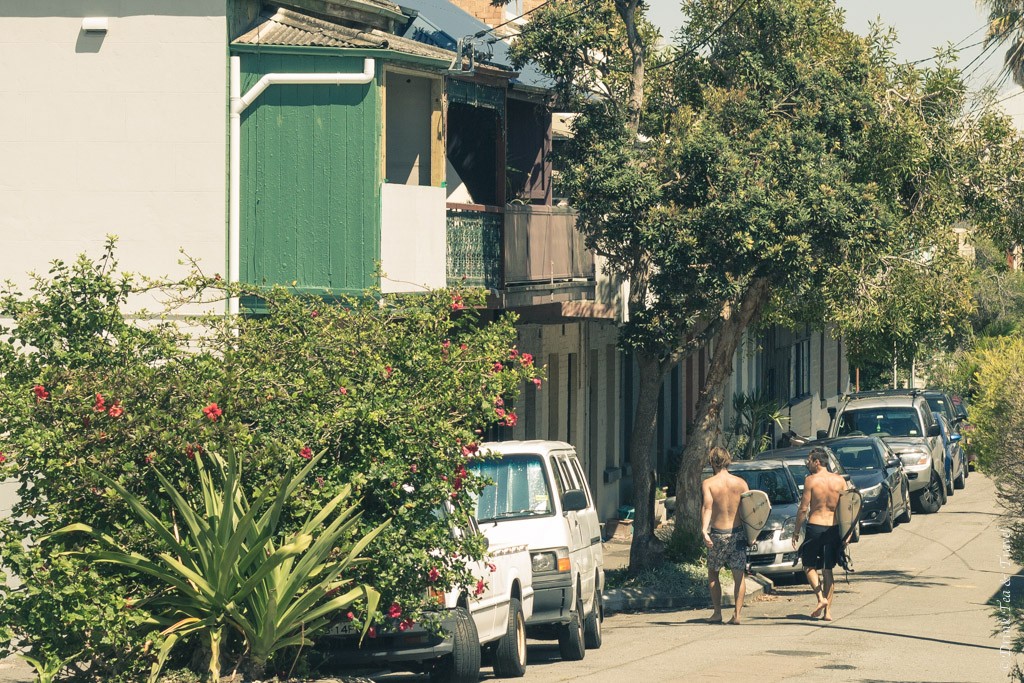
Can You Add Any Other Money Saving Tips For Australia And Beyond?
About the author.
Oksana & Max St John
6 thoughts on “trip to australia cost: budget & tips to save money”.
Australia has heaps of food courts that offer half price meals after a certain time to avoid waste so get in there early evening for a cheap bite to eat! I was lucky enough to find one.
Excellent budget travel tip! Thanks for sharing, Cassandra!
Great post. Australia is expensive but if you follow tips like this it can make such a big difference. I’ve been travelling Australia for the last 3 months and it is well worth the expense! Such a beautiful country and great people!
Hi Cassandra, Thanks for sharing this tips, it is very useful! I’ve been in Melbourne a few years ago and the experience is awesome and yes being in Australia is very expensive yet worth all the expense. I enjoyed my entire stay here. Melbourne is such a great place! I love it and I appreciate all the people especially all the people where I stay, low cost and such a quality service must recommend http://www.servicedhouses.com.au/
If you travel just knowing where you want to go and what you want to do, it’s certainly gonna be expensive. Australia isn’t exactly an affordable place to visit, but a little research would go a long way, especially most part of the expense would go to accommodation, transportation, and food. Great job sharing these tips! This is very informative and will surely help a lot of people traveling on a budget!
It’s so true: a little research does go a long way in Australia. You have to be thrifty! Glad you found our tips helpful, Agness! Cheers!
Leave a Comment Cancel Reply
Your email address will not be published. Required fields are marked *
This site uses Akismet to reduce spam. Learn how your comment data is processed .
Tanzania Trip Details
Enter your name and email to get our Tanzania Safari Trip brochure with more details about this trip in your inbox.
Join our 2025 Group Trips Pre-sale List
Be the first to know about NEW Trips and SPECIAL Offers!
Have 5 minutes to share more info? Fill out the Pre-Sale trip survey HERE
Reignite the Feminine Retreat
Love the idea of a women-only retreat in September 2024?
Help me decide where we should go!
Our women-only gatherings will be limited to 8-10 people, so leave your details below to add yourself to the waitlist.
We'll email you first to share all the details of the trip.

A Complete Guide: Travelling the East Coast of Australia
The East Coast of Australia is up there with the most popular backpacking trails in the world. The Great Barrier Reef, the Whitsunday Islands, Fraser Island, the Great Ocean Road, Sydney’s Opera House… the entire coastline has many ‘must sees’ that continue to attract travellers from across the globe. Here at Nomads, we have traveled the East Coast numerous times and we can tell you now – it never gets old! So here it is… our complete guide to travelling the East Coast of Australia.
Where is the East Coast of Australia?

The ‘East Coast Trail’ refers to the long stretch of road that follows the eastern coastline between Cairns and Melbourne. Traditionally, the East Coast began in Sydney, however as Melbourne’s alternative and cultural persona has attracted much international acclaim over the years, the southern city has now become a popular starting or ending point for many East Coast voyagers. For those short on time, the majority of the East Coast can be explored between Brisbane and Cairns.
Quick Facts:
- The total distance along the coastline between Melbourne and Cairns is around 4000km
- It would take about 50 hours of non stop driving to travel along the coastline between Melbourne and Cairns
- The major highway connecting Brisbane and Cairns is called the “Bruce Highway” – can’t get more Aussie than that!
- The East Coast is nothing like the Outback of Australia (or Wolf Creek). Although there will at times be long drives between each major tourist destination, you will find petrol stations and little towns at least every 30 mins apart
- Aussie locals are very laid back and friendly. You will be including Aussie Lingo such as No Worries Mate, No Dramas, Heaps Good, Thongs and Barbie in no time! Check out our guide to Aussie Slang
- Australia is an Eftpos nation – you will be able to pay by credit or eftpos card in most cafes, service stations, hostels, bars and supermarkets. However it is handy to have a little bit of cash when passing through smaller towns
Australian Weather:
- Many backpackers assume that Australia is warm and sunny all year round! Because of the country’s size, it could be snowing in one state and 35 Degrees in the next!
- Melbourne and Sydney can be quite cool during Winter (June to August) so make sure you pack a warm jacket, pants and closed shoe
- Byron Bay to Bundaberg attracts mostly sunny weather all year round. As you head north of Bundaberg and into Tropical North Queensland you may need to prepare for wet season. Wet Season is within Australia’s summer season and usually hits the tropics between November and March. Expect tropical rain, high humidity and A LOT of sweat! We suggest packing a very light, waterproof jacket with a hood
How much time will you need to travel the East Coast?
- Like every country, it depends on how you like to travel. If you have just 2 to 3 weeks, the major sites between Sydney and Cairns can ‘be done.’ However you will spend a lot of time getting to and from each destination and little time to relax and really explore what each destination has to offer. If you have 3 weeks or more, then you will be able to travel the coast between Melbourne and Cairns more comfortably. We usually suggest 4 to 6 weeks!
Cost (AUD):
- A dorm room in a hostel will range between $25 – $40 per night
- Coffee is around $3.50
- Breakfast – most hostels offer all you can eat brekkies for around $5 per day. Eggs on Toast or Cereal will cost around $7 from a cafe.
- Lunch & Dinner – Most major cities will have many restaurants and cafes available. Aussies love their international cuisine so you can usually find anything from Cheap Pizza places, Kebabs, Fish & Chips, Indian, Thai, etc. Main Meals will usually cost you around $10 – $20
- Use the hostel kitchen and buy cheap food from supermarkets or the many great markets around Australia
- Pint of Beer $7 – $10
Getting Around Australia’s East Coast:
- Campervan Hire can be a great way of exploring the East Coast of Australia if you have more than 3 – 4 weeks of travel. Most campervan companies in Australia offer one way rentals between Melbourne, Sydney or Brisbane and Cairns. There are many hostels along the coast north of Brisbane that allow you to park up for the night at a small cost and use the hostel facilities. You will also find many free camping zones outside of the major cities.
- Greyhound and Premier are both public bus lines that tend to be the most popular form of travel for backpackers. Although these bus lines are open to the public, due to the popularity all services are usually jam packed with travellers. Both Greyhound and Premier offer flexible hop on and hop off passes between Melbourne, Sydney, Byron Bay, Brisbane and Cairns and they stop at all tourist destinations along the coast!
- Hop on Hop Off Busses. The busses mentioned above both have hop on hop off options but you can also travel with Oz Experience, Stray Travel or Loka where you get a tour guide and are taken to some key locations asa well as being able to hop off and explore somewhere in a little more depth.
- Fully Guided Tours are a great means of exploring the East Coast if you are a little nervous about travelling on your own, or only have a short amount of time. Tour companies such as Wayoutback and Topdeck offer fully inclusive tours along the coast
Accommodation on the East Coast
- There are many budget accommodation options available along the East Coast of Australia. Nomads Hostels have properties in Sydney , Brisbane , Byron Bay , Noosa and Airlie Beach .
- To save $$ or keep your travels completely flexible, we suggest buying a multi-night accommodation pass that allows you to book as you venture along the coast. Most hostels along the East Coast are located in central areas and close to public transport
The Must Sees on Australia’s East Coast
Whether you are travelling along the coast by Bus, Campervan or Tour, here is our guide on where to go and what to see.
Melbourne is Australia’s cultural and artistic city with loads going on from film festivals, markets, live music, live theatre and rooftop bars. We suggest exploring Melbourne’s graffiti and coffee lined laneways (you can view our Top 5 laneways here) and taking a trip up to the top of Eureka Skydeck for 360 degree views of the city. A great way to explore the city for free is by hopping on the red city circle tram which provides commentary as you pass by the city’s iconic and historic landmarks.
St Kilda Beach is also well worth a day trip. The colourful beach side suburb is just a 15 minute tram ride from the city centre and is oozing with cafes, cake shops, bars and of course, the iconic Luna Park! If you have a few days in Melbourne, taking a tour along the Great Ocean Road and to the Twelve Apostles is also a must!
- Read our tips on the Best Things to do in Melbourne
- On a budget? Check out some Free or Cheap Things To Do in Melbourne
- Visit the excellent Queen Victoria Market
- Stay at Base Melbourne , in the stunning suburb of St Kilda

There’s no doubt that Sydney is one of the most photogenic cities in the world! You will need at least 3 to 4 days to explore the city and its surrounds. One of our favourite ways to get some great photo opportunities of the Harbour Bridge and Opera House is by purchasing a Ferry Ticket (around $5 – $10 for the day) and cruising around the CBD. The ferry also runs return transfers to Manly Beach – a great day out!
A day tour (or overnight for the hiking enthusiasts) to the beautiful Blue Mountains National Park is also a must! And of course – the Coastal Walk between Bondi and Coogee Beaches should also be on the top of your Sydney Bucket List. Public buses operate from the CBD to Bondi Beach and Coogee Beach all day. A walk down to Darling Harbour is also worth your while, as well as checking out Chinatown for a cheap bite to eat and Paddy’s Markets for a spot of souvenir shopping.
- Read our tips for Top 10 things to do in Sydney
- On a budget? Check out some Free or Cheap Things To Do in Sydney
- Visit some Sydney Markets
- Stay at Nomads Sydney

If learning to Surf (or if you consider yourself a pro), a stop by Mojosurf’s Spot X Surf Camp on your way to Byron Bay is a must. Located on a private beach front property 3 hours south of Byron Bay, both Greyhound and Premier Bus companies stop here. You can book everything from an overnight, 2 night or week long stay here. Packages include accommodation overlooking the coast, surf lessons, board and kayak hire, a bonfire and the ultimate chilled out atmosphere. Alternatively, Mojosurf also offer day lessons from Byron Bay.
- Mojo Surf Packages at Spot X.
- Stay at Spot X Surf Camp .

The most easterly point in Australia never fails to capture the hearts of travellers passing through. The vibe is chilled, the people are relaxed and the beaches and surrounding waterfalls and rainforest of the Byron Hinterland is amazing. If travelling to Byron Bay from Sydney (or in the other direction), we suggest getting an overnight Greyhound or Premier bus.
When in Byron Bay, a day trip to the historical and colourful hippie village of Nimbin should also be on your Byron Bucket List. The day trip is by far one of the weirdest and wackiest experiences we have ever had in Australia, rolling through the hinterland in a rainbow bus with the Bob Marley tunes a-blaring! Walking to Byron Bay Lighthouse for sunrise is an unforgettable experience and don’t forget to check out the markets.
- Read our tips on the best Things to do in Byron Bay
- Check out some Fun and Free things to do in Byron Bay
- Visit the Byron Bay Markets
- Stay at the famous Arts Factory Lodge in Byron Bay

Travelling 1 hour north from Byron Bay, you will arrive in Surfer’s Paradise (in the Gold Coast). Surfer’s Paradise is commonly compared to England’s Blackpool – and we love it! The nightlife is great, the beaches are amazing and there are 4 of Australia’s biggest theme parks all within a short drive away. We suggest 2 or 3 nights here, but if on a short time frame, you could probably scoot right through to Brisbane. If you are planning on heading to the theme parks you will need to allocate an entire day!
If you have a car, be sure to check out the UNESCO World Heritage Listed Gold Coast hinterland – there are loads of natural waterholes, walking trails, waterfalls and amazing lookouts to explore. Jupiter’s Casino is worth a cheeky visit and a spot of shopping at Pacific Fair never goes astray.
- Read our tips on the best Things To Do in Surfers Paradise

A 1 hour bus journey north of Surfer’s Paradise will land you in Brisbane. Don’t be fooled – Brisbane has a lot to offer. One of our favourite (and FREE) things to do in Brisbane is jumping on the Red City Hopper Ferry from Southbank and cruising along Brisbane River. You will get some great sights of the city, Storey Bridge and the Botanic Gardens. Jump off in Eagle Farm and head to Fortitude Valley for a few cheeky beers and a spot of shopping.
Brisbane’s night market scene is definitely on point (maybe because of the fantastic year round weather) and Westend is an alternative suburb with loads of cool bars and cafes worth visiting. XXXX Brewery offer tours for the beer enthusiasts and a trip to Lone Pine Koala Sanctuary will have you getting up close and personal with the furry mammals. If you are looking for a little bit of island love, a day trip to Moreton Island is a must – a great place for snorkeling, spotting for dolphins and sand boarding!
- Read about the Best Things to Do in Brisbane .
- Check out our Top Ten Reasons to Visit Brisbane .
- On a budget? Check out some Free Things To Do in Brisbane
- Stay at Nomads Brisbane Hostel

Mmm… Noosa. Noosa is located in Australia’s Sunshine Coast and is just a short 2 hour bus journey north of Brisbane. Not only is it a popular gateway to Fraser Island, but it’s also the ultimate place to check out Australia Zoo. Make sure you explore the secluded beaches through Noosa National Park and see what wildlife you can spot. Not to be missed are the fantastic Eumundi Markets . We highly recommend trying surfing in Noosa or going on a kayak tour through the Everglades . We suggest a minimum of 2 to 3 days in Noosa to RELAX!
- Read our Top 9 Awesome things to do in Noosa .
- On a Budget? Check out 20 Things to Do for under $20 in Noosa
- Stay at Nomads Noosa Youth Resort

Fraser Island
Ok EVERYBODY who visits Australia wants to visits the world’s largest sand island! And there’s no surprises why. Fraser Island is home to some of the most stunning white sandy lakes and Eucalyptus Rainforests in the entire country. The island is BIG and the only way to get around is by a 4X4 vehicle. There are a number of tour options available including Tag Along and Guided options departing from Brisbane, Noosa, Rainbow Beach and Hervey Bay.
Most budget travellers will opt for the Tag Along option as it is a lot more affordable. If you have a license, you can actually drive the 4WD on the Fraser Coast ‘highway.’ Most Tag Along tours will have you joining a convoy with other travellers led by a professional driver in a lead car. You can camp or stay in a hostel on the island – and don’t forget to spot for Dingoes! Nomads Fraser Island offer 3 and 2 day Tag Along tours from Noosa.
- 2 day 1 night Fraser Island tour from Noosa
- 3 day 2 night Fraser Island tour from Noosa
- 3 day 2 night Fraser Island Camping Tour from Noosa

Town of 1770 / Agnes Water
From Noosa or Rainbow Beach you will have a 15 hour, overnight bus journey to Airlie Beach – Whitsundays. Yep – we weren’t joking when we said Australia is HUGE! To break up the journey, many travellers tend to stop by a little, coastal town by the name of 1770 . Located 6 hours north of Rainbow Beach, this is the place on the East Coast where the Great Barrier Reef meets the surf coast. It’s really chilled with a small town feel and the infamous Scooteroo Tour (where you drive around in a leather jacket on a Harley Davidson spotting for Kangaroos) tends to attract many backpackers to the region.
- Stay at 1770 Southern Cross Backpackers

Airlie Beach – the Whitsundays
As you arrive into Airlie Beach you will really begin to feel the sense of being in the Tropics! As you cruise along the old Bruce Highway you will begin to notice Sugar Cane and Banana Plantations, towering green mountains and rainforest. To put it simply – you can get by day by day in flip flops, tees and shorts. As you arrive into the tiny yet bustling town of Airlie Beach, prepare to be blown away by the views!
Airlie Beach is the gateway to the 74 islands that make up the Whitsundays. There are loads of different tours and activities available – from fast paced day trips, overnight sailing tours, relaxed catamaran cruises and party tours on ‘Pirates of the Caribbean’ style schooners! Most travellers will opt for a 2 day / 2 night sailing trip, but if you are short on time, we recommend a day tour with Ocean Rafting or a 2 day / 1 night trip on a maxi racing yacht.
The 3 day / 2 night sailing trips include onboard accommodation, food, most are BYO alcohol and snorkelling on the Great Barrier Reef. All tours will guide you to Whitehaven Beach – where the sand is so white and pure that you can actually clean your jewellery with it! If you have some more time in Airlie Beach, be sure to check out the surrounding walking trails. Or if you prefer to relax then chill by Airlie Lagoon and bask away your hangover at Airlie Beach’s man made beach. Or take a short drive to Cedar Creek Falls , a stunning ‘secret’ location.
- Read our tips on what to do if you have 7 Days in Airlie Beach
- Stay at Nomads Airlie Beach Hostel

Magnetic Island
Magnetic Island is becoming more and more popular over the years as word of this tropical island paradise continues to spread. Greyhound and Premier bus offer pick ups and drop offs at the Magnetic Island ferry terminal in Townsville (located 4 hours north of Airlie Beach). Overnight island packages at Base Magnetic Island are available and include beach front accommodation, ferry transfers and a few extra goodies. It is the ultimate place to chill by the beach front pool, snorkel, check out the surrounding look outs and party the night away. Also – don’t forget to plan your trip around the Island Life Beach Party – it is EPIC!
- Read 10 Reasons Why Magnetic Island should be on your bucket list
- Stay at Base Backpackers Magnetic island

Travelling a further 4 – 6 hours north of Townsville – Magnetic Island you will reach the end of the East Coast Backpacker trail. Cairns is the adventure capital of Australia and there is pretty much any adrenaline activity on offer here – Bungy Jumping, Skydiving, Cable Ski, White Water Rafting, Jungle Surfing – you name it!
A trip to Atherton Tablelands is a must if swimming in natural waterholes, beautiful lakes and visiting the famous waterfalls as featured in Peter Andre’s “Mysterious Girl” is up your alley. Taking the scenic railway and cable car to the hidden rainforest village of Kuranda should be on your to do list. As well as a visit to nearby Fitzroy and Green Islands. The Great Barrier Reef is an absolute must do in Cairns. There is everything from day tours to 5 Day Open Water PADI Courses on offer. Have a chat to one of our MAD Travel staff to choose your best option.
You will be surprised by the vast differences between the small and humid town of Cairns vs the bustling streets of Sydney’s CBD. ‘Queenslanders’ are a lot more relaxed than their southern neighbours!
- Read our tips on the Best Things to Do in Cairns
- On a Budget? Check out some Free or Cheap Things to Do in Cairns
- Visit the Cairns Markets

For those with enough time, we suggest a little stop by Mission Beach, a stunning rainforest town located just one hour south of Cairns. It is the best location to try White Water Rafting through Tully River and a popular spot to Skydive (imagine views of the Great Barrier Reef and a beach landing).
We also highly recommend an overnight tour to Cape Tribulation (with a one night stop over in Port Douglas). It’s located 2 hours north of Cairns and is where the Rainforest meets the Great Barrier Reef.

Travelling the West Coast as well? Check out our Guide to Western Australia
On a tight budget? Read these Tips to Help You Travel Australia on a Budget or this for more budget Australia travel ideas

How to Plan the Perfect East Coast Australia Itinerary on a Budget
By: Author Taylor Lorenz
Posted on Last updated: 10/25/2023
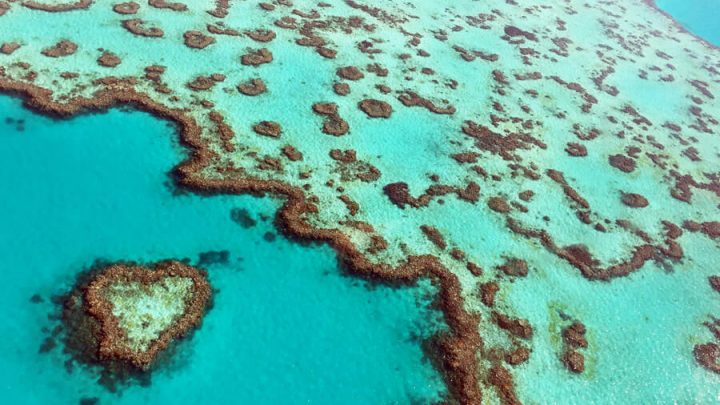
The East Coast of Australia is a must-do for every backpacker in the country. It is the most popular route for travellers and easily has the most things to see in Australia. There is a very beaten backpacker trail as you as either go north or south so you’ll most likely run into people along your trip.
The East Coast is a very long route as you will be travelling most of the country. The first mistake people make is thinking it can be done quickly. Australia is about the size of the USA so driving the entire strech of the East Coast will take days. So even through there are so many things to do in Australia along this trip they will still take time to get to so be prepared to buckle up and plan to spend some time in Australia to really see it all.
The best part of an East Coast trip is that most places to visit in Australia are natural. From stunning beaches to gorgeous islands and even the oldest rainforest in the world, you’ll find them all and what to do in Australia in this sample itinerary.
Table of Contents
East Coast Australia Itinerary
Recommended australia tours.
- Most of the Coast: Sydney to Cairns
- Australian Highlights
- Uluru & Kings Canyon Adventures (I personally did this tour and highly recommend it!)
Daily Breakdown of My Australia Trip Itinerary
How this itinerary works: In order to accommodate itineraries varying from 2-6 weeks I list the minimum amount of days to the maximum amount of days to spend in each spot to give you a rough idea of how much there is to do in each stop along the coast. I list typical activities to do in each stop, day trips and then link to further resources to help you create the perfect itinerary for each destination.
This East Coast Australia guide is made specifically for backpacking Australia but it can also be used for anyone travelling the East Coast as it covers what to see in Australia and the best places to visit in Australia.
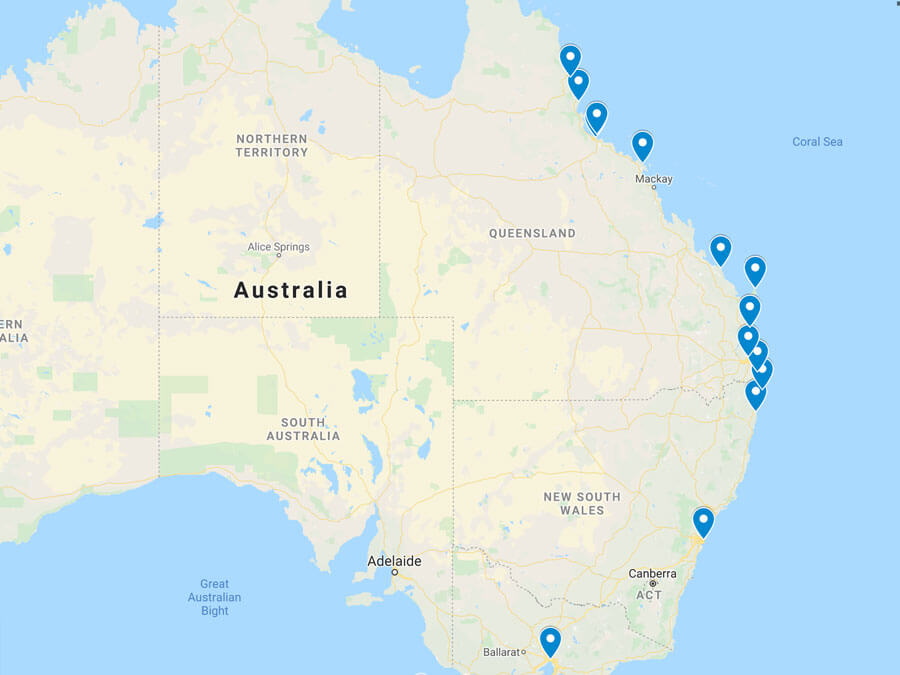
Suggested Time: 2-5 days
There are so many things to do in Melbourne that you could easily spend a week here. Spend a day roaming around the CBD (central business district), exploring the hidden bars and street art in the alleyways. Grab a bite to eat at one of the fabulous restaurants along the Yarra River and find a rooftop bar to hangout for the evening.
Hit up St Kilda beach for an afternoon, wander through the Botanical Gardens and don’t miss out on trying a freakshake! Melbourne is a foodies paradise so the chances are that there will be some kind of food festival going on while you’re visiting. Most of the museums are also free and you can find out tourist info in Fed Square.
There are also a number of days trips from Melbourne that are totally worth it:
- Great Ocean Road : A stunning 2-day road trip or day tour, if you do any day trips from Melbourne make it this one
- Philip Island : See the fairy penguins, famous because they’re so small and adorable
- Yarra Valley : Wine lovers head here to one of Australia’s biggest and best wine regions for a day of tastings
- Peninsula Hot Springs : Take a day to relax in the cave pool, hot springs, sauna and bath house
READ MORE: 51 Things to do in Melbourne (21 of Them are Free!)
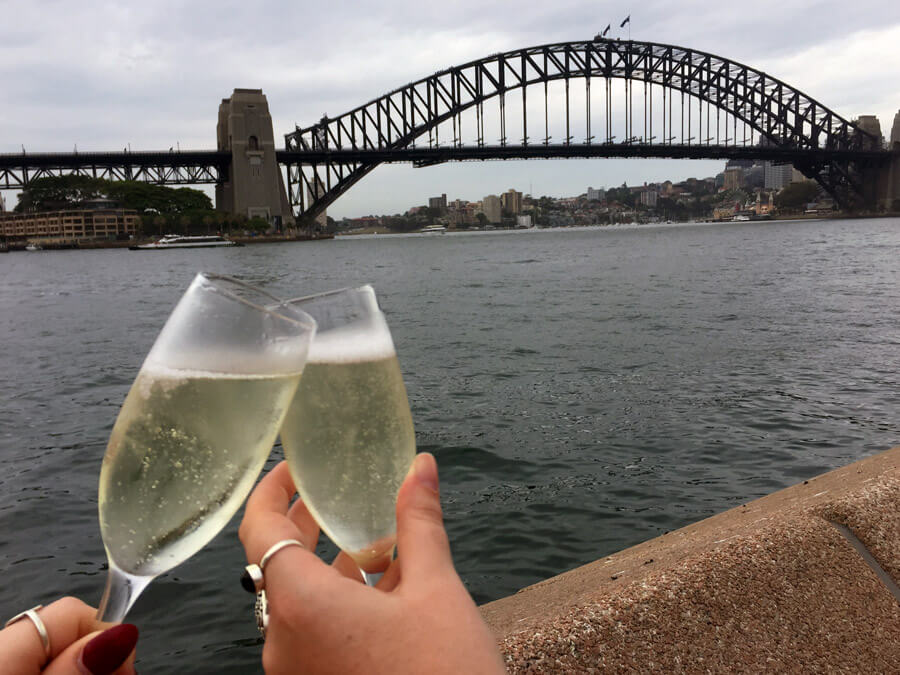
Suggested Time: 3-4 days
A stop in Sydney is a no-brainer. You simply must day a take to wander through the CBD, making your way over to the Sydney Opera House where you can stop for a drink and take in views of the Sydney Harbour Bridge. From there walk through the Royal Botanic Gardens for even better views. Roam around The Rocks and find yourself at Darling Harbour for the evening for dinner and drinks.
A second day should be spent at one of the many beaches such as Bondi Beach, the most famous. Don’t skip the Bondi to Coogee coastal walk for breathtaking views of the water and beaches. And if you’re feeling adventurous try climbing the Harbour Bridge for an epic photo opp.
A third day can be spent on another beach, Manly Beach, cruising around the water or visiting the zoo .
Sydney also has a number of really great day trips:
- Blue Mountains : This national park is famous for the Three Sisters. You can get here by public transport, hike around the stunning area and be back in Sydney for dinner
- Hunter Valley : Another treat for wine lovers, Hunter Valley is another one of Australia’s best wine regions
- Royal National Park : If want Insta pictures in those cool figure eight pools, this is where you find them
- READ MORE: 5 Easy Trips from Sydney
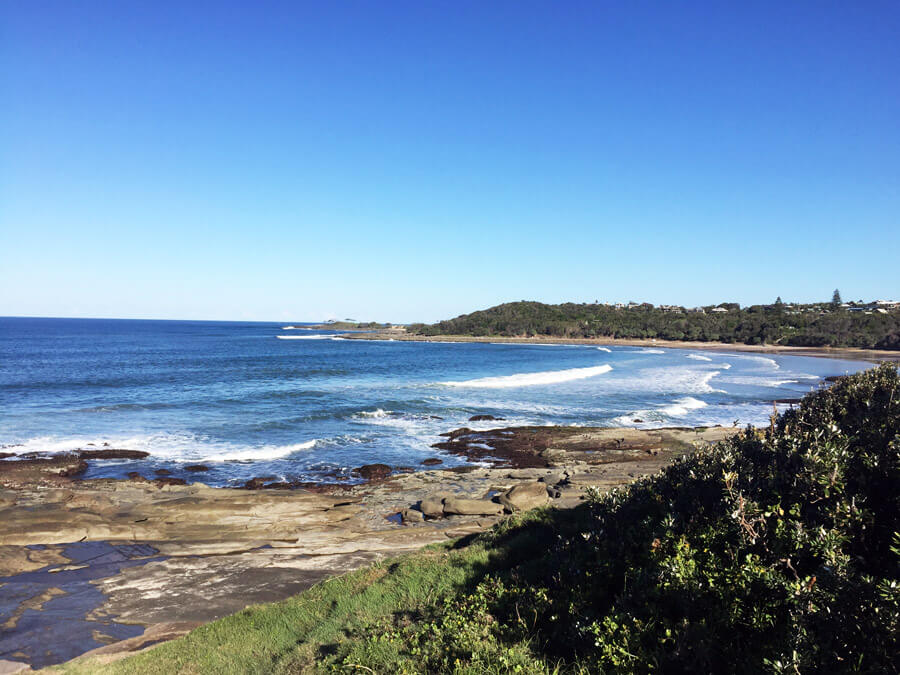
Suggested Time: 2-3 days
With so many places to go in Australia the smaller spots are often overlooked or unherd of. Yamba is a small town that is off the beaten track but it is quickly becoming popular. It’s the perfect place to chill out for a few days on one of the 12 beaches with its laid back vibe. And if you’re Canadian you’ll find the most folks from home in Australia in this spot!
Surfers must stop here as it is home to the best surfing in Australia, is where a number of pro surfers live and the creator of Billabong. Surf lessons here are extremely cheap, I’m talking under $20 so if you want to give it a go you won’t find any cheaper.
There’s only one hostel where you can sign up for surf lessons and you must do Shane’s Yamba tour, for $15 it’s probably the cheapest tour in Australia.
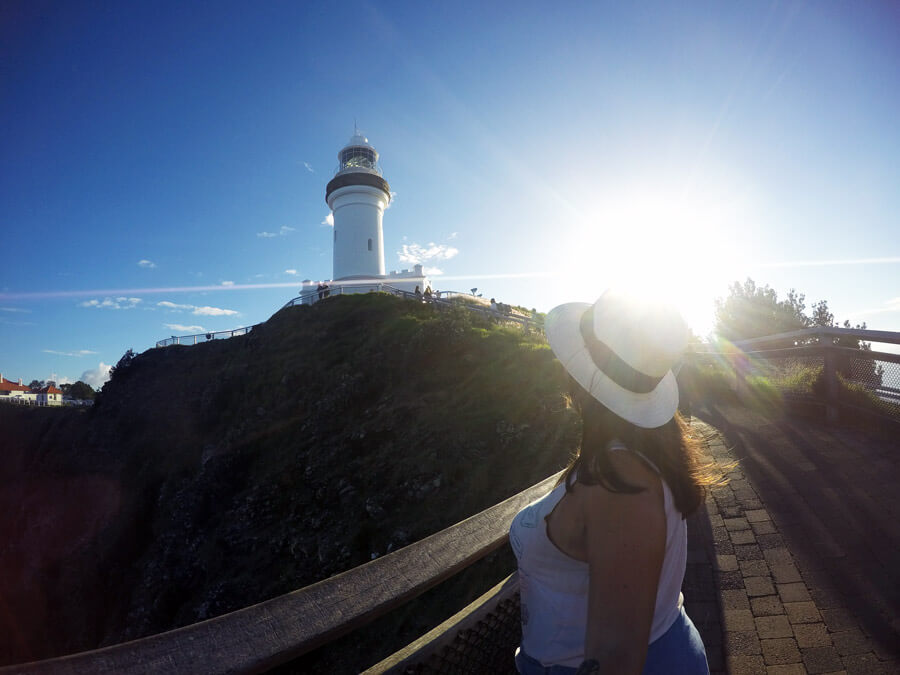
Suggested Time: 2-4 days
So many people fall in love with Byron Bay and end up staying here longer than planned. I don’t blame them and you’ll see why too. This is another top spot for surfers but has more action for those who don’t like spending so much time in the water.
Here you can still get outdoors by hiking up to the Cape Byron lighthouse and visiting the most easternly point in Australia close by. Or spend your days chilling out on one of the many beaches such as Main Beach, Clarks Beach, The Pass and more. Byron Bay is also known for its dolphins which you have a very high chance of spotting. So jump in a kayak and have a leader take you to the best lookout spots.
Byron Bay is a popular hangout for backpackers, it is also quite touristy but still has a very laid back vibe. So shop your heart out at the chain and local stores or at some of the top markets such as the Byron Bay Artisan Market (Saturday nights, October-March) and Byron Bay Markets (first Sunday of every month). And spend your evenings partying at the local bars.
There is one popular day tour from Byron Bay:
- Nimbin : This small hippie town is completely stuck in the 60s and is known for its “special” treats. Many tours include waterfalls and cliff jumping too
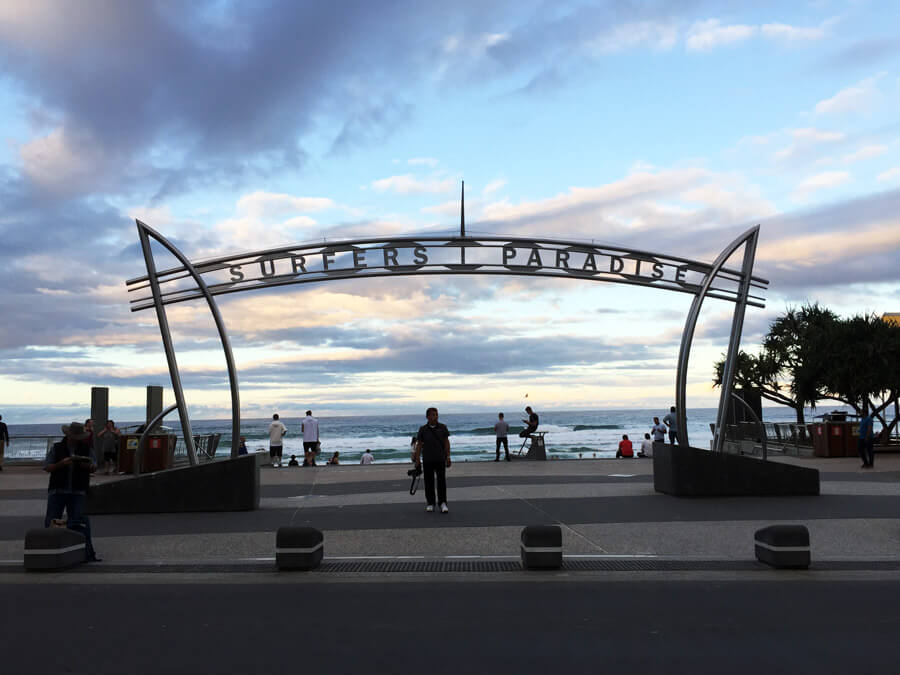
If you love to party you’ll love Gold Coast. Gold Coast is not actually an area like the Sunshine Coast is but a city in itself. It is the most touristy city in Australia. Despite its most popular area’s name, Surfers Paradie, the surfing is only okay. The beach itself is fine but my best advice is to only spend a few days as there are much better beaches along the coast.
You can spend a lot of time shopping and partying here. All the main tourist attractions are here and day trips can be taken to amusement parks such as Sea World, Dreamworld and many more. Plus there’s spectaular natural scenery on the city’s doorstep like these waterfalls .
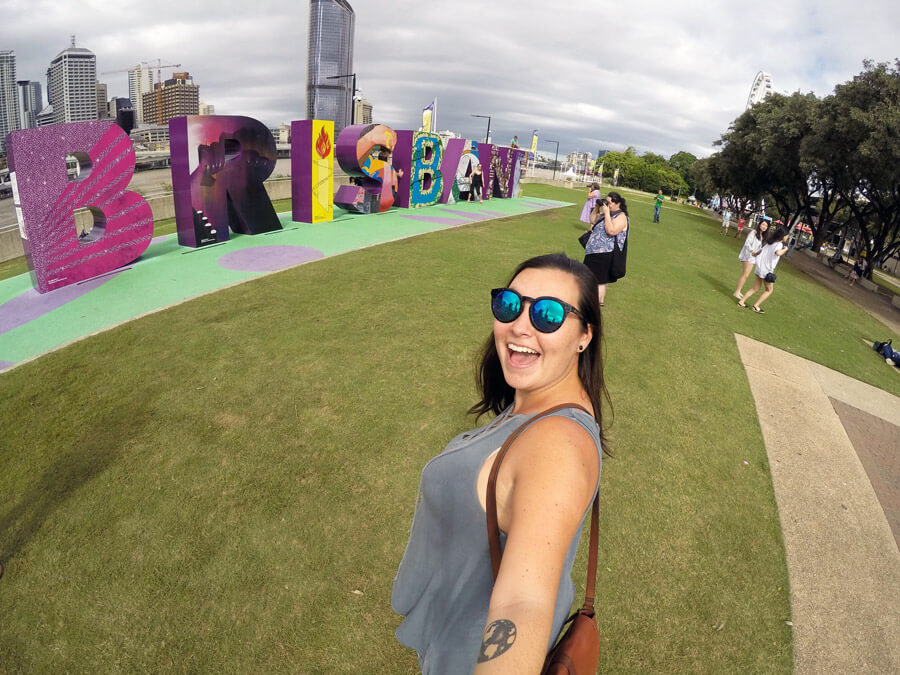
In all honesty I found Brisbane to be the most boring city in Australia. However a stop here will break up your trip between Gold Coast and Noosa and it will be the last city you see until the end of the this trip!
Spend a day roaming around the CBD where there are lots of shops and make your way over to Southbank. It’s here that you’ll find the famous Brisbane sign along the river. Walk a little further and there are a ton of restaurants, a pool and a manmade beach in the middle of the city.
A trip to the city’s West End will show you the quirkier side of Brisbane with some of the city’s best restaurants and bars. The city’s best collection of art can be found at GOMA. And don’t miss the chance to hop on the free ferry for a ride down the river where you can jump off to explore more of the city. As for nightlife the trendy hot spot is Fortitude Valley.
The most popular day trip from Brisbane is:
- Australia Zoo : Made famous by Steve Irwin himself, this is the biggest zoo in Australia
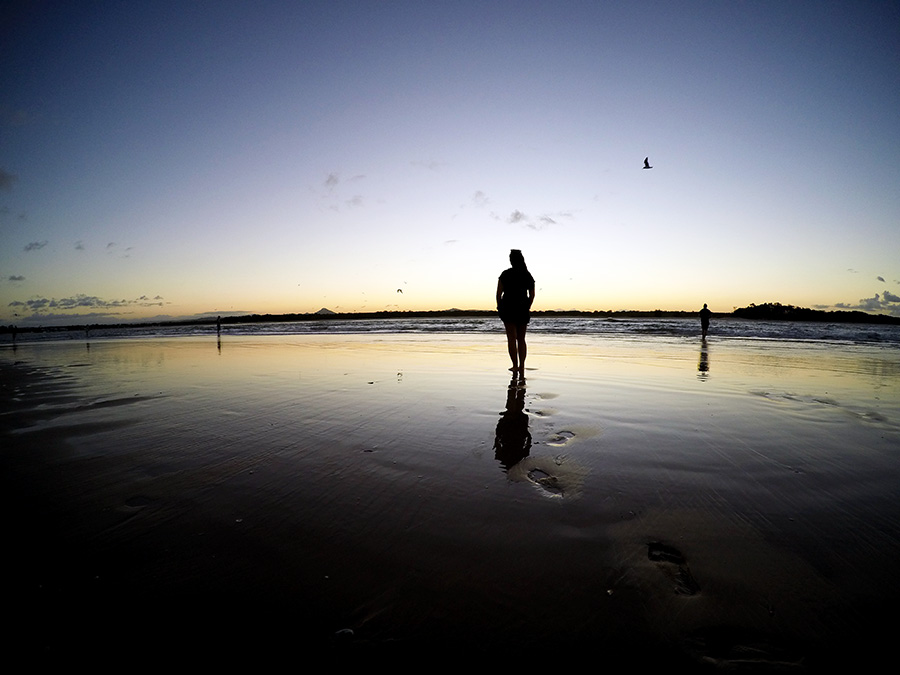
I’m a little obsessed with Noosa. It is hands down my favourite place in Australia, but I won’t hype it up too much. People always prefer one or the other: Noosa or Byron Bay. Noosa has an even more chill vibe, there is less partying and more beach time with sunsets.
Spend some time on the Main Beach, watch sunset from that beach or walk along it to where the river meets the ocean for even better views. Surfing here is also quite good.
But the best part about Noosa is the national park that has an amazing coastal walk. Get up early and watch the sunrise from Hell’s Gate or walk it during the day, seriously it could be a daily activity. Stop by the fairy pools for a dip in the natural pools in the rocks during low tide. Stop and just take in the stunning views and watch the surfers along the way.
Shop along the main street, Hastings Street, but bring your credit card. Window browsing is all you’ll be able to do if you’re on a budget. Though you can find cheaper places for coffee and gelato here too. Lastly take a 30 minute bus ride to the Emundi Markers which are every Wednesday and Saturday until about 1PM. There is everything here from local crafts, food, jewelry, photography and so much more.
Noosa also has popular day trips:
- Noosa Everglades : There’s only two in the world, so if you love nature jump in a boat and tour to see the River of Mirrors where you can canoe or kayak, a self-guided tour is always a cheaper option
- Australia Zoo : You can also do a day trip to the Australia Zoo from here as it’s about half way between Brisbane and Noosa
READ MORE: 14 Things to do in Noosa
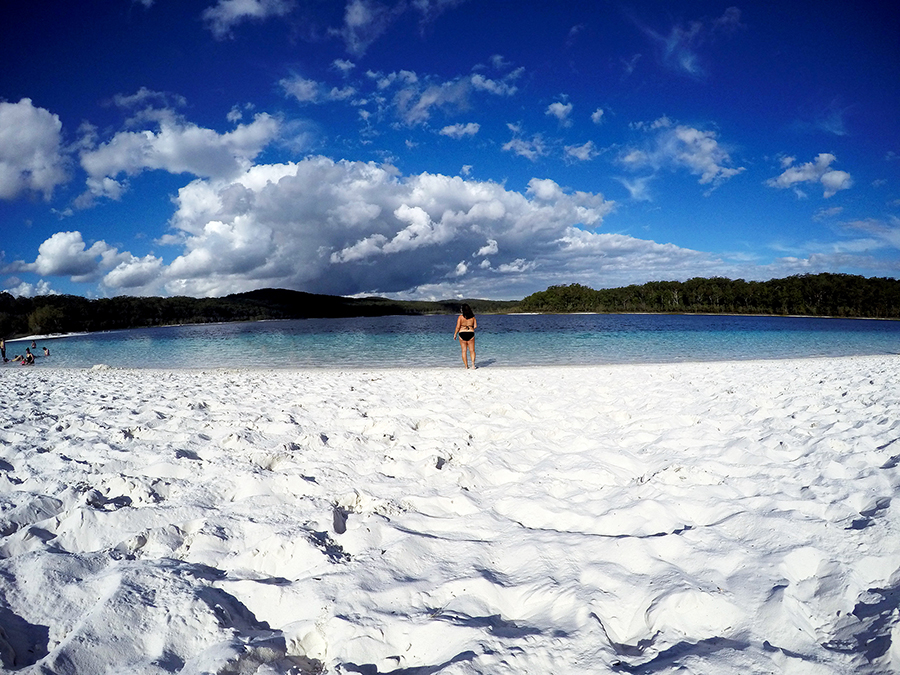
Fraser Island
Fraser Island is the largest sand island in the world. It is a must-do trip so you can drive along the beach, star gaze, learn about the history and culture of the island and see local wildlife such as dingoes. You can do a trip to Fraser Island from one of 3 jumping off points: Noosa, Rainbow Beach or Hervey Bay. There are also options to start in Noosa and then finish in Rainbow Beach which is more north so you can continue your East Coast trip up.
I will warn you that a Fraser Island tour is not cheap but it is well worth the splurge to see this incredible place. A 2-3 day tour is recommended, but one-day tours are available if you’re limited on time.
READ MORE: The Australian Island You Can’t Miss: Fraser Island Tours with Drop Bear Adventures
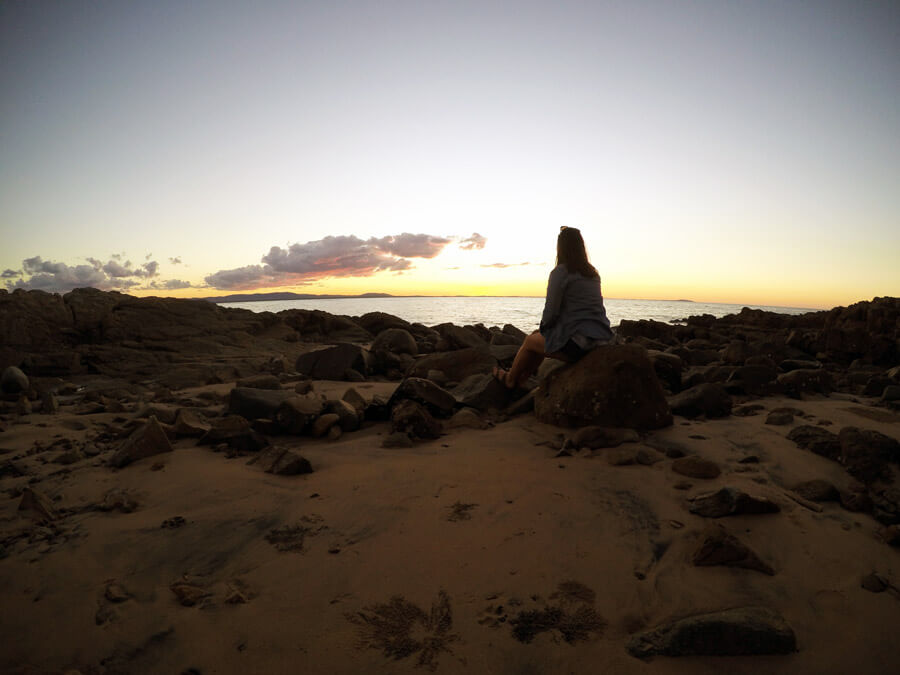
Agnes Water and Town of 1770
Suggested Time: 1-2 days
A stop here breaks up the long trip between Noosa or Rainbow Beach and Airlie Beach as bus journeys are about 9 hours between Noosa and Agnes Water and Agnes Water and Airlie Beach (be sure to get night buses!).
Agnes Water is really just a small tourist town so you don’t need long here. Stop by for some surfing (lessons here are also very cheap) or hire a bike to get to some areas for hiking such as the scenic trail to the Captain Cook monument. You could also do a Larc tour, a boat that drives on land as well as in the water.
What you absolutely can not miss is the Scooteroo tour. They’ll be given a leather jacket and will drive around Agnes Water and 1770 in a group to see the area and then watch sunset. Even if you don’t do Scooteroo a sunset is in order as the Town of 1770 is one of the best spots along the East Coast to watch.
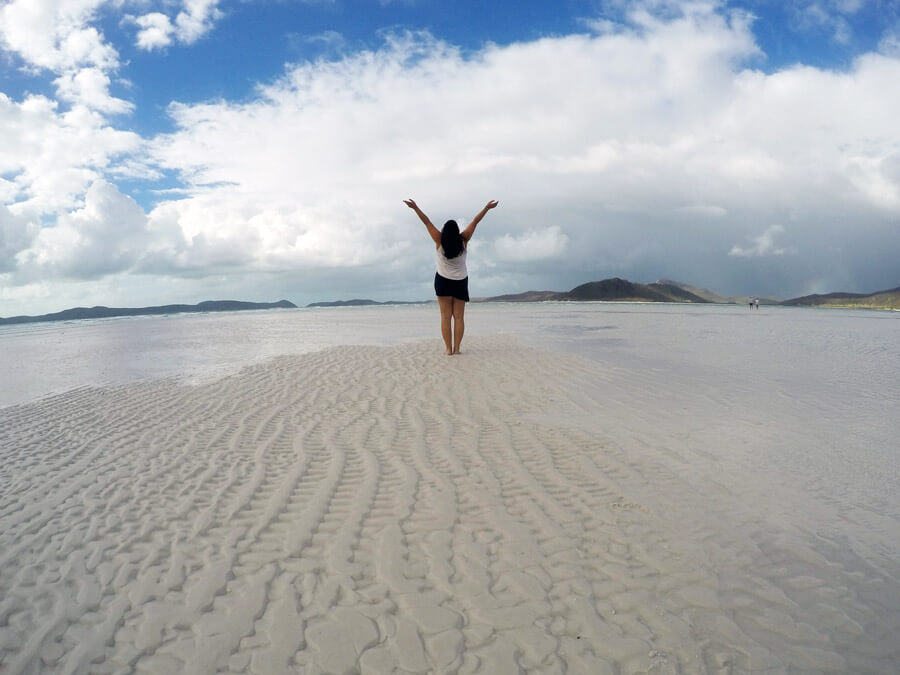
Airlie Beach and Whitsunday Islands
In Airlie Beach itself there is not a whole lot to do. It mainly acts as a jumping-off point for the Whitsunday Islands. However you will most likely have some time to kill before of after your tour so you can chill out at the Airlie Beach lagoon, visit the beaches such as Boathaven Beach or do the coastal walk to Cannonvale Beach.
This is most certainly not a budget option but I highly recommend it. I swear a scenic flight over the Whitsunday Islands and the outer Great Barrier Reef was the best splurge I had on my trip along the coast. I paid $179 but I’ve heard you can find them for as cheap as $99! This is where you can see the famous Heart Reef.
And while you’re here don’t miss a sailing trip around the Whitsunday Islands. This is what everyone comes here to do! Spend 2-3 days on a sailboat where you can visit one of the world’s most beautiful beaches, Whitehaven Beach, snorkel the Great Barrier Reef and soak up the sun on the deck. Prices range significantly on tours and some boats are known to be party boats. I recommend using BookMe where you can find tours with big discounts or Get Your Guide because they have an awesome selection that shows you majority of the tours available.
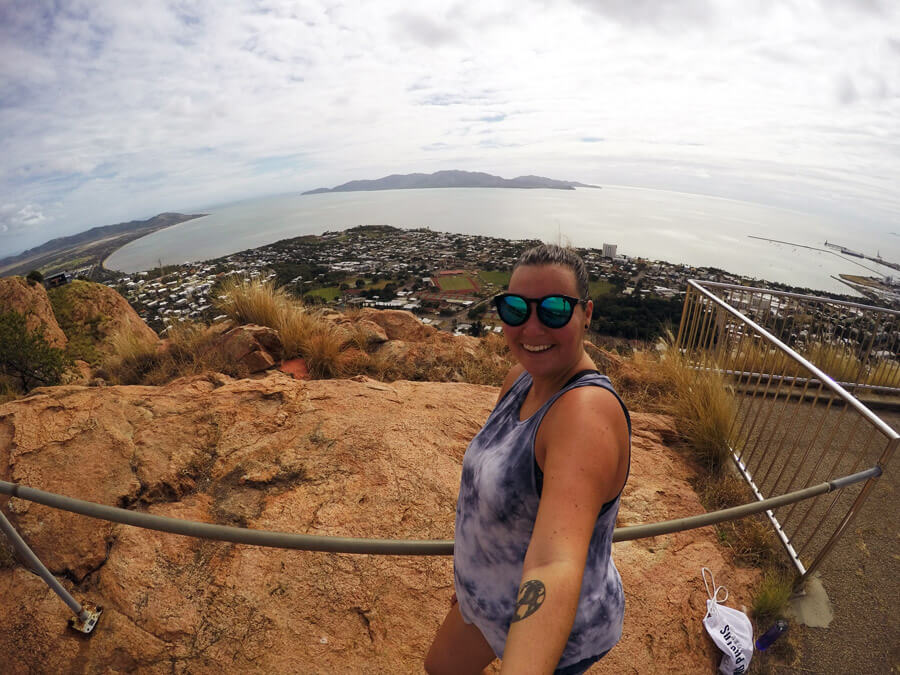
Townsville is another stop to help break up long trips and is also the jumping-off point for Magnetic Island. There’s no need to spend long here, you can explore the entire coastal city in just 2 days. One of the most popular things to do in Townsville is a hike to the top of Castle Hill for views of the city and Magnetic Island.
Spend some time along The Strand where you’ll find beaches, restaurants and parks. The Reef HQ is awesome for those who don’t like diving or snorkelling as you can see a ton of underwater life as it’s the largest living coral reef aquarium. Then there’s the Billabong Sanctuary where you can experience Australian wildlife and interact with the animals.
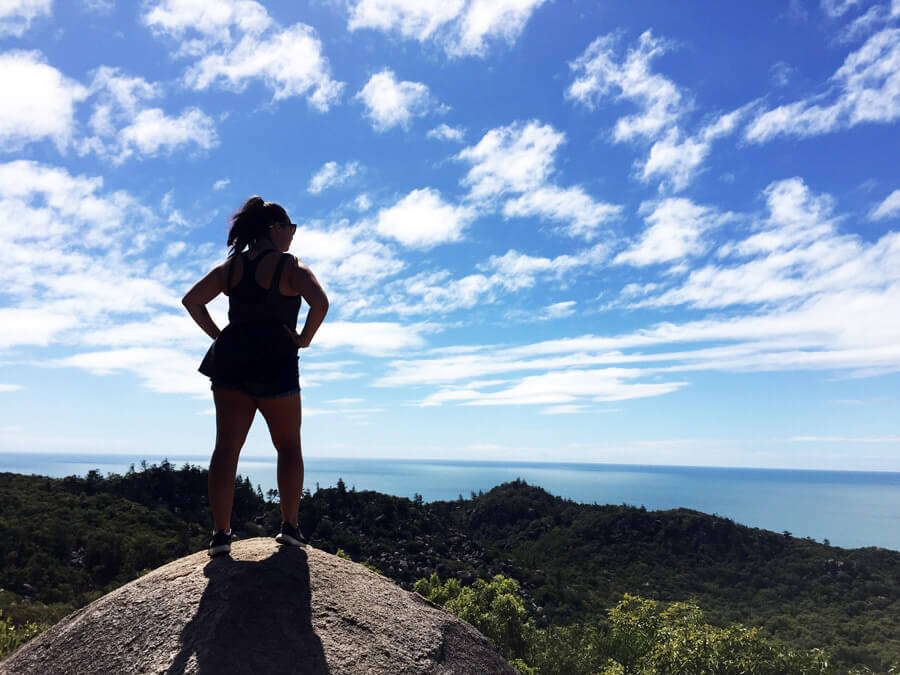
Magnetic Island
Magnetic Island is a quick half an hour ferry ride from Townsvile and one of my favourite places in Australia. The locals often refer to it as Maggie, since Australian’s shorten everything. What’s so special about this island is its unique formation of rocks that jut out to create a different landscape.
Activities on the island include lots of hiking. Some of the best trails are The Forts Walk where you can spot wild koalas and the hike to Radical Bay from Horseshoe Bay. Be sure to time getting back to Horseshoe Bay for sunset as it’s stunning with islands in the background.
If you haven’t already you can get your picture with a koala or have breakfast with koalas at Bungalow Bay which is also the hostel I recommend staying at. By far the coolest thing to do is rent one of the famous Barbie cars to cruise around to different hiking spots. It isn’t cheap but if split 4 ways it is affordable. And you must visit the rock wallabies, they are tiny wallabies that live in the rocks that are just too cute!
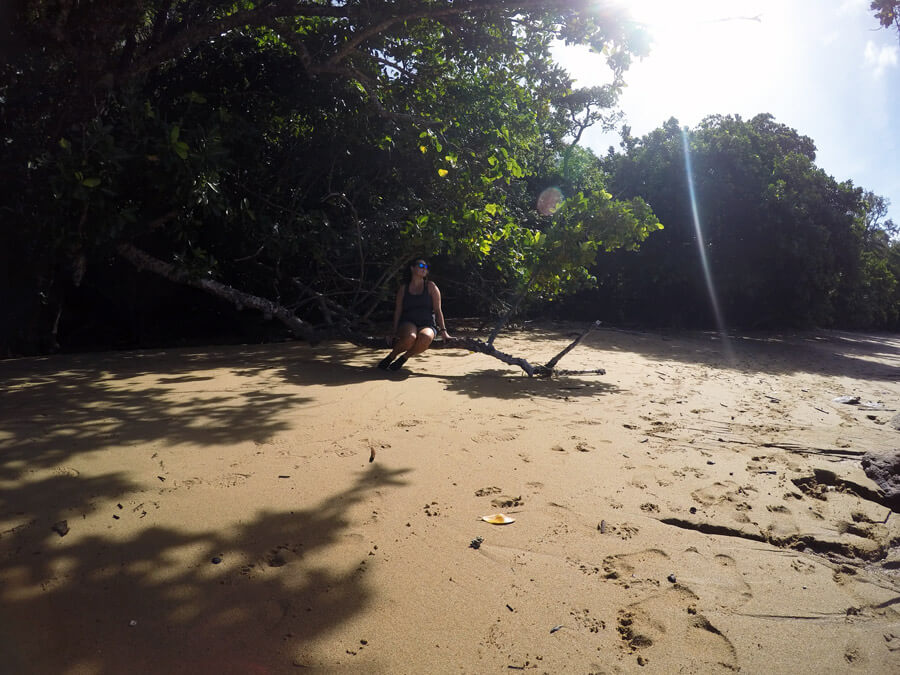
Mission Beach
Mission Beach is Queensland’s little secret. This small town of only 3000 people is most known for being the best spot to sky dive in Australia . My best advice is to wait until you get here to do it as you’ll fall through the sky over the Great Barrier Reef and it is the only spot in Australia to guarantee a beach landing.
If sky diving isn’t for you then you can walk along the beach, it’s perfect to because of its packed sand. Or try a day trip of white water rafting in nearby Tully. There are also hikes throughout the area in the tropical rainforest. However if you don’t have a car exploring Mission Beach is a challenge.

Suggested Time: 3-5 days
Cairns is the most popular for one of the top Australia attractions: diving and snorkelling the Great Barrier Reef. There are so many options available from multi-day dives to half day snorkelling tours . The city itself is a bit of a party town as it’s the biggest city since Brisbane and people tend to get a little wild.
But being back in a city means art galleries are around but luckily it still have a small-town feel. You can explore the markets such as the Cairns Night Market and The Esplanade Market. And during the day you can hangout at The Lagoon, a manmade spot by the water with a swimming pool and beach that’s a favourite among locals and tourists.
There are also the Botanical Gardens which has a few hikes. But what Cairns has the most of is days trips.
- Snorkelling and Diving Tours : The most popular islands to visit off the coast are Fitzroy Island and Green Island
- Cape Tribulation : An area known for its ecotourism in the Daintree Rainforest, people visit here for the wildlife and jungle surfing (zipling through the trees)
- Atherton Tablelands : A part of the UNESCO World Heritage site that also inclues the Daintree Rainforest, the Atherton Tablelands are an area with ancient rainforest and contain the popular waterfall route that will take you to stunning waterfalls in the region
When you visit Australia you’ll quickly notice how expensive things are but if you’re smart, plan ahead and know what to look out for you will be able to do all of the pricey activities and not miss any of the best sights in Australia.
Best Time to Travel East Coast Australia
If you plan on spending a lot of time on the beach or in the water the best time to visit Australia’s East Coast is during the summer (December-February) however it will be wildly hot and rainy season in tropical Northern Queensland. This is also peak tourist season. My recommendation is to travel in the off seasons, spring (September-November) or fall (March-May) when prices are lower, there are less crowds and the weather is decent on all parts of the coast.
That being said, there really is no bad time to travel Australia’s East Coast as it will be warm throughout the year in Queensland but prepare for the cool weather in New South Wales and Victoria! By cool I mean it can snow in Melbourne in the winter (December-February).
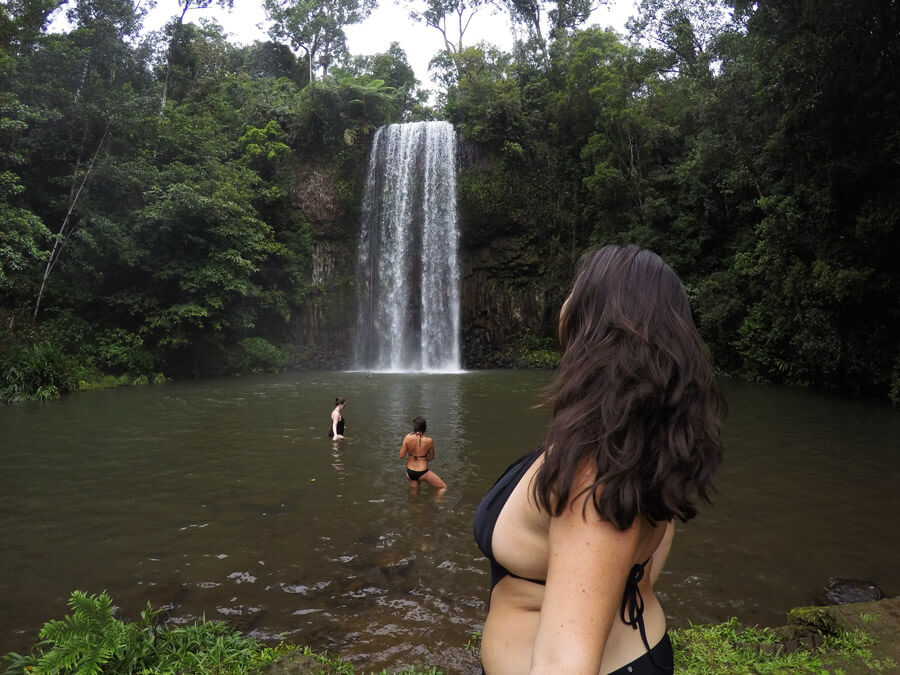
How Long Does it Take to Travel East Coast Australia?
If you don’t have a lot of time it can be done it two weeks. This just covers the highlights. If you want the full East Coast experience plan to spend 4-6 weeks. With this timeframe you will be able to see and do everything plus have time to relax.
Backpacking Australia on a Budget
A budget in Australia is like splurging in places like Southeast Asia, but a budget trip can be done if you’re smart, know what to budget for and plan.
Food and Drinks
The easiest way to save money is on food and drinks. It can be difficult because drinking is a huge part of travel down the East Coast but save your money for some of the more expensive experiences instead.
Eating about can cost you anywhere from $5 at fast food restaurants to $15 at sit down restaurants with a lunch special to $20+ for dinner. When buying your food from grocery stores and cooking you can spend as little as $6 a day! I’m proof, I did this while living in Melbourne.
For drinks pre-drink before going out by picking up booze at bottleshops such as Dan Murphy’s where you can stock up on Goon, boxed wine for around $15. But expect a hangover and I can’t claim that it tastes delicious. When going out use an app like Happiest Hour to help you find the closest drink deals around.
READ MORE: Australian Cuisine
Travelling Around Australia
Australia road trip.
The most budget-friendly option is to road trip Australia and it is also a very popular option. Some people even buy a car at the start and then sell it at the end. Finding used cars is very easy and common in Australia. But as a solo traveller (like me) you may not want to drive alone, you may not want to drive or camping isn’t your thing.
Travel in Australia is the easiest with the next best option, getting a bus pass. The most popular companies are Greyhound and Premier that travel not just along the East Coast but across the entire country. There are passes available based on kilometres travelled and hop on hop off passes. The main difference is that with a kilometres pass you can back track, with a hop on hop off pass you can’t. I personally recommend the hop on hop off as it works out cheaper and gives you 90 days of use between point A to B. A Sydney to Cairns pass will start at $410 with Greyhound but that is all of your travel covered!
You can also book buses pretty last minute as well so you can be flexible with your travel and change bookings for each stretch of your journey.
If you are short on time flying is the best option for you as it will be the quickest. Australia is huge and you don’t want to waste precious time spending days (yes driving can take that long!) getting between destinations. Luckily Australia has budget airlines and if you book in advance you can score awesome prices. You can also watch out for sales by signing up for budget airlines newsletters such as Tigerair and Jetstar.
Australia Accommodation
Camping on the Australia East Coast is the cheapest option. Some campsites will be free, others can be pricey. You can use books like Camps Australia Wide to find free campsites along the coast. If you have a campervan you can also pay to park in some hostels parking lots and use the bathroom and kitchen facilities.
Hostels in Australia
Personally I stayed in hostels because camping is not my thing and they’re a great place to meet people as a solo traveller. Hostels cost anywhere from $20-50 a night in a dorm room. Prices vary depending on where you are. Sydney is the most expensive so expect to pay $50 a night when there. Breakfast is often included and is typically cereal, toast and condiments, coffee and tea. Sometimes you’ll get pancakes! Be sure to check out Booking.com for an excellent selection of hostels with reviews from previous travellers and great deals.
Travel Insurance Australia
Disclaimer: This post may contain affiliate links which I earn a small commission from and are at no additional cost to you. See my disclosure policy for details. Thank you for supporting my small business!
Disclaimer: Taylor’s Tracks is a participant in the Amazon Services LLC Associates Program, an affiliate advertising program designed to provide a means for us to earn fees by linking to Amazon.Com and affiliated sites.

IMAGES
VIDEO
COMMENTS
Award-winning service rated 4.9/5 by 70k+ travelers worldwide. Pick your next trip now! Browse award-winning tours and pick your next journey-of-a-lifetime!
Australia Ticket Price. Cheap Travel Deals. Search Cheapest, Quickest & Best Flights. Find Cheap Flights from 1000s of Airlines and Travel Agents. Cheap flights. Made simple.
Australia Travel Cost - Average Price of a Vacation to ...
Average Trip to Australia Islands Cost in 2024. A week in Australia costs around $5,500 for two people: Average Accommodation Cost: $150 per night. Average Flight Cost: $1,500 per person. Food, Drink & Activities: $100 per person, per day. Transportation: $50 per person, per week. Total Cost: $5,500.
How Much Does it Cost to Travel Australia in 2024?
I generally pay around $50 for a 30 minute drive. Needless to say, there's lots of ways to get around if you won't have a car. To give some examples of prices: In Sydney, you'll pay (depending on time of day and distance travelled) $4-6 for a bus, $2-11 for a train, $7-10 for a ferry, or $4-5 for a light-rail journey.
The average cost for 4 people to visit Australia for a week is $4,483-$10,863 ($640-$1,552 per day) Food, Travel, and Sightseeing: $168 to $345 per day for four people's daily expenses. Flights: $2,485 to $7,266 for economy. Lodging: $137 to $175 per night for two 2 or 3-star hotel rooms. or $162 to $197 per night for a 2-bed vacation rental.
2 Weeks in Australia Travel Costs. To help you out with an outline of the prices, you'll find a summary of the average costs of a two-week trip to Australia below. Is Australia Expensive; Expenses Estimated Daily Cost Estimated Total Cost; Average Airfare: $146: $1,199: Accommodation: $18-$200: $252-$2,800: Transportation: $0-$40: $0-$560: Food:
Pacific / Australia /. Visitors to Australia usually spend between $64 and $448 per day on average for one person and $128 to $896 for two people. While this is a wide range, the average daily cost averages $166 (AU$250) per person. This average includes sightseeing, hotel, food, and local transportation expenses from other travelers.
The cost of campervanning Australia varies heaps depending on your route, time frame, campervan model and of course the season - so the further in advance you book it the better. Expect to pay from $60AUD per day though, with rates much higher in the peak, summer season, around $110+ per day. For an epic Campervan deal in Australia click here.
Budget for holidaying in Australia. For the lucky ones who are travelling in Australia for 3 weeks just to enjoy the country, here is an idea of the budget to plan: Vehicle rental: $100/day. Fuel: $120/week (depending on kms) Tourist visa: $0. Travel Insurance: $200.
Australian budget guide - Tourism Australia
The average cost of a round trip to Australia is $1200. However, this cost increases to $2100-$2900 from late December to January and decreases to $1100-$1200 from late August to early September. Collected data shows that Tuesdays are the cheapest days to fly to your destination and back.
Australia Travel Cost: How Much to Budget for an ...
A generous budget for four weeks of travel along the west coast would be around AU $4,000. Organized tours will be expensive, costing around AU $3,000 for a 10-day trip from Perth to Broome. The Pinnacles, north of Perth, Western Australia. Photo credit: Getty Images/John Crux Photography.
Flights. Flying in Australia is pricey, especially on routes which aren't serviced by the budget airlines. Flights to places such as Darwin, Alice Springs, Uluru, Hamilton Island, Sydney - Melbourne, Kangaroo Island and really rural areas can cost between $150-300 AUD each way.
You can expect to spend between A$160-A$250 a night, per couple, on accommodation in Australia. This will get you a private room with your own bathroom in a 3-4-star hotel or apartment rental. See latest hotel deals in Australia. Hostels are, of course, cheaper, but a private room with a shared bathroom will still cost around A$90 per night.
73 cents a kilometre in the Dmax 3 month trip. 57 cents a kilometre in the Dmax 6 weeks up north trip. 100 days on the road on our lap of Australia trip costs post, where we average $800 per week to travel Australia. 200 days on the road on our lap of Australia trip costs post, where we continue to average around $800 a week to travel Australia ...
Greyhound Australia. Premier. Greyhound also offers several bus passes. Their Whimit Passes range from 15-120 days of unlimited travel and are perfect for traveling around on a whim (hence the name). They come in 15, 30, 60, 90, and 120-day passes costing 400-860 AUD. To find bus routes and prices, use BusBud.
A 12-month travelling Australia budget can vary depending on how fast you travel and what you experience along the way. We were a family of four, living on the road, just meandering around Australia, exploring and living slow. We officially survived one whole year of travelling in a caravan.
Most hotel rooms were not built for families with young kids. We enjoy having more space, a kitchen, a washing machine, and separate bedrooms. You can expect the average cost of a vacation rental in Australia to cost you around $250 AUS per night. You can find some as low as $40 AUS, and as high as $400 AUS.
How to travel Australia on a budget! A trip to Australia doesn't have to be expensive, we spent less than €100/150 AUD per day during our 6-week road trip along the East Coast. Detailed budget breakdown and information about the costs of renting a camper van, campsites, petrol, food & activities. #australia #roadtrip
East Coast Australia: $84 per day (based on 6 week road trip) West Coast Australia: $70 per day (based on a 3 week road trip) The Kimberleys: $42 per day (based on 2 week road trip) Darwin to Adelaide: $64 per day (based on a 2 week road trip) Tasmania: $23 per day (based on a 3 week road trip)
Unfortunately, there's no getting around this cost when it comes to a trip down under. No matter what tips or tricks you use for travelling to Australia on a budget, a return flight to Australia costs you no less than AUD $1,400 and upwards of AUD $2,000+. Whitehaven Beach, The Whitsundays, Australia.
If you have 3 weeks or more, then you will be able to travel the coast between Melbourne and Cairns more comfortably. We usually suggest 4 to 6 weeks! Cost (AUD): A dorm room in a hostel will range between $25 - $40 per night. Coffee is around $3.50.
This East Coast Australia travel guide has all the information for your dream trip! Discover the best of East Coast Australia with this incredible East Coast Australia itinerary that is sure to impress you. ... Hostels cost anywhere from $20-50 a night in a dorm room. Prices vary depending on where you are. Sydney is the most expensive so ...